The Dutch tobacco box
Author:
Don Duco
Original Title:
De Hollandse tabaksdoos
Publication Year:
2012
Publisher:
Pijpenkabinet Foundation
Description:
Thorough introduction to the Dutch tobacco box of brass or copper explaining shapes and subjects of decoration, with a final word about tobacco boxes of alternative materials.
This article outlines the development of the Dutch tobacco box of brass or copper from the beginning until the disappearance. The main text serves as a general introduction to this specific tobacco box. In addition to the history and the manufacturing method, it deals with the different box shapes to clarify the typology of the box and to indicate the chronology. Naturally, the decorations will also be discussed, including the method of implementation. The penultimate section places the Dutch brass tobacco box next to tobacco boxes of alternative materials in order to better understand the importance of both types. A number of specific characteristics of the boxes from the Pijpenkabinet collection are discussed in more detail in the appendix.
In writing this I used the available literature. This appears to be extremely limited. The first study appeared in 1912 as a catalogue at an exhibition in The Hague [1]. There are also a few more thorough articles, for example about the Holm boxes [2]. In addition, two monographs are devoted to and products from Iserlohn [3]. With this article the general characteristics of the Dutch tobacco box are presented according to the latest insights and this specific box is placed in a broader context. With this, this epistle leaves behind some general but incorrect thoughts and draws a new trail. For anyone who wants to deepen in the Dutch tobacco box, this article can be the starting point. It is certain that this subject leaves much to be discovered for the serious researcher.
General
For the smoker, the tobacco box has been a practical but especially popular commodity for centuries. The tobacco box served to keep the tobacco fresh, to store it in a dust-free manner, and it mainly prevented it from being crushed. A variety of materials can be used for the tobacco box. Brass also referred to as brass is the most common. In addition, copper has been used as a variant and in many cases both metals were combined. Other metals have also been used in addition to organic materials, usually mounted in metal. The size of the tobacco box corresponded to the price and the consumption pattern of the tobacco. The box shape kept a close relationship with the fashion of that moment and was often even related to the clothes on which it was worn or in which it was stored. Although born as a utensil, the tobacco box soon plays a role as a status article. The decoration is in line with the experience of the user and therefore conveys his personal identity.
It is unclear what the first tobacco boxes looked like and there is certainly no such thing as an original tobacco box. It is clear that it must initially have been small boxes, in the end the tobacco was in the beginning extremely expensive so good storage was a first necessity. The oldest mention of a tobacco box dates from 1607 and speaks of a small ivory box [4]. In addition to this material, you can also use turtle, horn or metal. Brass or copper is the most obvious choice for large-scale production. Such boxes can be hammered or soldered from brass plate by a copper bearing, in limited cases they are cast by a yellow cast. Combined techniques are often applied. Boxes of other materials remain in use as a variant.
It is certain that the tobacco box will become a common item in the 1630s, because smoking is then established. Gradually the tobacco box is going to be the standard set-up of the smoker. Almost every Dutchman smoked pipe and used a tobacco box for storing his tobacco. That habit must have been noticed by foreigners, especially because the use of tobacco elsewhere was significantly less common. Not surprising, therefore, that the Dutch were called Dosentrager (box carriers) by the Germans [5]. From 1650 onwards, the development of the tobacco box is easy to follow and can be indicated per period.
In the antique trade many early Dutch tobacco boxes are advertised as a snuff box because of their small size with a capacity of less than a deciliter, which is incorrect.[6] A characteristic of these early boxes is a pipe stopper on the inside of the box. This pipe stopper is of no use to a user of snuff. In addition, the snuff box is usually made of more expensive materials and, due to the great exclusivity, it has its own development. Finally, the use of snuff was only common at the end of the seventeenth century. The main characteristic of the snuff box is of course a modest content, carved tobacco takes much more space than powdered perfumed tobacco. Tobacco boxes of some eighteenth-century miniature size are the speculation whether they contained snuff tobacco, but it is also true that cut tobacco is more accurate.
In the first quarter of the eighteenth century the tobacco box gets a stronger standard size and a fixed appearance. The production is serialized and is done by specialists in numerous places. In addition to the highly standardized tobacco box, there is the exceptional miniature and the large size that mainly served as showpiece. These atypical boxes have been largely retained relative to the normal user boxes.
Techniques
Copper or brass was the most common material for the tobacco box. For a correct understanding it is good to know that the natural colour of the copper is reddish. We refer to products made with red copper. The addition of nickel gives the alloy a yellowish tint, which is called brass, also referred to as yellow copper. Both materials are used for some luxury boxes. This choice not only provided for a pleasant change, but also broke the serial aspect in which the tobacco boxes were made.
Three techniques are possible to make a tobacco box: the cutting and hammering is the most original, the punching and rolling is a more serial method. In both cases use is made of machine crushed sheet material. Thirdly, the casting of a tobacco box is also possible. Finally, each box can be finished by engraving it. In many cases there is a combination of techniques performed by different professionals.
The hinge of the box has its own development. It starts with a simple single-pivot hinge and that stays until 1680 [7]. We refer to such small hinges with cam hinge and are sometimes cast with the box, in most cases however soldered in the form of plates. In the eighteenth century, the shape of the box changes and the length increases so that a two or three-piece hinge becomes customary. The connection between box and lid thus becomes more stable. Initially, the hinge consists of soldered plates, both attached to the box and the lid. When the production of tobacco boxes grows, the technique is perfected. Then the hinge is bent from the box wall and the lid. An iron pin holds the hinge jaws together. The bending of the hinge sleeve was a meticulous job for which special skill was required.
The closure of the box can be done in two ways. The most common is the overhanging lid edge that clamps on the box and guarantees good closing. Such edges were made mechanically with the help of a flange (Cat. 6). The box maker saw to it that the lid always closed tightly. In the early boxes there is a completely flat lid and then often a single-pivot hinge was used which, incidentally, is not very stable, so that a hook on the reverse side of the lid was not a superfluous luxury (Cat. 5).
The majority of the Dutch tobacco boxes are engraved, because there is little interest in smooth boxes. The images are stabbed with burins. With the more expensive tobacco boxes from the eighteenth century, we also see a special decoration technique with the unfortunate term Damascene work [8]. In this process, copper and brass are alternated as a kind of inlay (Cat.14). Often these bets follow the show on the box. It is still unclear whether two boxes were combined as is the case with Boulle work, or that the bets were made when the decoration pattern was known. In any case, this technique assumes a close cooperation between the box maker and the engraver.
When assessing tobacco boxes, it is important to note that making tobacco boxes was a specialized profession, and that there were all kinds of specializations within that professional group. The box maker was usually the man who cut, moulded and brazed the copper plate. When starting from sheet metal, the professional name of the coppersmith applies. In other cases the box is poured and then the yellow worker is the maker. The engraver concentrated on engraving the outside. Here, rest is a condition and that was difficult to combine with the force needed when cutting the sheet material, flangeing copper sheet or soldering and polishing the boxes. It is as yet unclear whether these people had a workshop together or whether the engraver bought smooth boxes and then decorated them on the request of the box maker engraved products.
The box shapes
An important factor in the determination of tobacco boxes is the shape of the box. This shows clear main forms that fit with the fashion and status, the technique used, the consumption of the tobacco and the manner of use of the box. At the earliest boxes we see two functions next to each other. They were used at home on the table, are usually slightly heavier and can be stable. Other examples were worn on the clothes where they hung with a chain with a belt hook. Those boxes have a carrier eye and are usually lighter. For the latter purpose, the convex oval shape is initially preferred. Towards the end of the seventeenth century, the tobacco box became more of an article to take in the pocket of a jacket or trousers. The shape changes and it becomes flatter while the size increases due to increased tobacco consumption. In rare cases, the box is still worn as a showpiece on the belt.
Based on the technique, we can distinguish two main types in the Dutch tobacco boxes. Usually the dating is the cast box that was made in a mould with the aid of liquid brass (Cat. 3-5). The second type is the sheet-metal box, which is significantly lighter and gains a great popularity (Cat. 10 a.f.). This is the box that is best known for its engraving work. The derived type is the die-cut box, also made of sheet copper, but embossed in a table roll. The cast and the sheet metal boxes each have their own design, where the cast box is usually compact while the sheet copper box has the greatest variation.
In the box shape, we distinguish between different phases in terms of periodization, which partly overlap and the latter is of course related to the traditional use value of the article. After a period of singles or copies made in small series, we see a first standardization in the oval shapes and the octagonal boxes. In terms of dating, they continue until 1680. They are followed by the lenticular boxes, which have been less common. Finally, around 1700, the flatter oval specimens that were produced in series were created. The flowering of the Dutch tobacco box, the period in which it is made en masse, is mainly worn out on the elongated box, typical of the eighteenth century. The era of decay is characterized by pointed oval boxes and especially rectangular flat ones. In the second quarter of the nineteenth century, production has declined sharply, although it continues incidentally until the beginning of the twentieth century.
In terms of shape format we can distinguish the following main types.
|
description |
cat. Nos. | period | |
| 1. | Individuals and early forms | 1-2 | 1600-1630 |
| polygonal | 3-5 | 1640-1670 | |
| egg shape or oval shape | 6-7 | 1640-1710 | |
| 2. | Lenticular and flat oval shape | 8-9 | 1660-1730 [9] |
| 3. | Printed bottom and cover edges | ||
| oval shape with printed edges | 10-12 | 1710-1760 [10] | |
| printed lid with brace-shaped ends [11] | 13 | 1730-1760 [12] | |
| elongated with printed edges | 14-15 | 1740-1760 [13] | |
| 4. | Oblong boxes | ||
| with round ends | 16-18 | 1710-1840 | |
| with bevelled corners | 19 | 1770-1790 [14] | |
| elongated with pointed ends | 28 | 1780-1820 | |
| 5. | Rectangular and flat | ||
| with flanged edges | 29 | 1780-1820 | |
| with smooth edges | 1800-1830 |
1. Unique and early shapes
In the first period of the tobacco box, up to 1640, standardization and large-scale production are not yet available. It is not surprising that the shape and technique varies greatly. We see that in the beautiful box (Cat. 1) depicted here, which is considered the earliest tobacco box. This special box has an oblong ground surface with bevelled corners on which there are eight rising sides, closed by a slightly curved facetted cover with a simple single-pivot hinge. On the inside of the box there is a stopper on the hinge for easy filling of the pipe bowl. These stoppers or pestles are a characteristic of the early tobacco boxes. The outside of this tobacco box is made of recessed fields in a geometric pattern filled with four colours of enamel. Although it is very likely that this box was made in plural, the present one is the only one that is known. The date must be around 1620.
A second example of an early box (Cat. 2) more closely resembles the Dutch copper box. Here the bottom and the upright wall are made of plate brass, the standing side is even embossed with a printed motif with a winding branch at both ends closed with an animal head. The lid is also embossed with a representation, but this is not forced but cast so that stronger height differences can occur. The subject of Abraham's sacrifice is illustrated as a theme, including an inscription. The early date is confirmed not only by the small size but also by the well-known pipe stopper on the inside of the box, attached to the location of the hinge. Given the punched outer edge, this is certainly serial production.
Polygonal
The first series-produced Dutch tobacco boxes have been casted. In contrast to most other boxes, they are not hammered out of sheet metal, but are cast in moulds with liquid brass and therefore belong to a specific category (Cat. 3-5). Thanks to casting, this box could be given a refined shape that often underlies an octagonal. The closing of the lid was done in that period with a locking hook that slid into an eye for locking. Given the thickness of the brass of the box, this seems more likely to be an object for use at home, though wear marks indicate wear in a trouser or jacket pocket. The regular occurrence of owner initials also indicates use elsewhere, for example in the tabagie, the tobacco inn
The fact that these tobacco boxes were then a luxury item is proven by the rather elitist subjects that have been depicted on this, often with a political commitment. For example, a box with the year 1631 was dedicated to the Swedish king Gustav Adolf II (Cat 3). Despite this early date, it is more likely that the production of such boxes started around 1650. This is based on the fairly general occurrence of the bust of the Orange stadtholder Prince Willem III as a five-year-old boy, borrowed from a plaque medallion produced by Pieter van Abeele in 1654 (Cat. 4). This polygonal box circulated between 1655 and 1670. A crowned left-wing lion is depicted on the bottom with sword and arrows, placed against a ground with acanthus leaves. Other examples show the Prince of Orange on horseback on the lid and may be slightly later. What is remarkable about the cast boxes is that the so-called print boxes for printing the mould have remained in use for a long time, even up to a moment when the relief work had already been weakened to an inadmissible level. A tobacco box originating from a ship that had sunk in 1667 and was unused being transported as a cargo proves not only the long production period but also the wear and tear of the mould (Cat. 5).
In addition to the relatively general polygonal box, there are similar cast boxes with a more simple shape, in which the upright walls were not facetted but made oval-shaped [15]. This type has a great resemblance to the later-used ovoid tobacco box. A general problem with the production of moulded boxes was that when pouring an excess of casting holes, air bubbles in the brass could easily arise. Numerous copies will immediately have returned to the melting pot, with other specimens these air bubbles were closed with bar brass. In addition to the relief boxes, smooth specimens were also made that were sometimes engraved. A smooth box had a more upscale appearance than the specimens with the sometimes crumbly moulded images. It is very likely that the cast boxes with reliefs were made in Amsterdam and have been available for at least twenty years.
Egg shape or oval shape
A common tobacco box with a completely logical shape is the oval box with round lid and usually convex bottom. Collectors use the somewhat inelegant name egg. The specimens in brass are characteristic for the brass worker, who could make a tobacco box in a quick and easy way (Cat. 6). Incidentally, the manufacture involves various operations: the sheet metal that is hammered in addition to the soldering of the parts. The casting for the massive pipe stopper was undoubtedly carried out by a yellow worker. Finally there was the engraving of the outside. It remains unclear whether the man who struck the brass was also the one who applied the engravings. The mostly primitive, little detailed performances sometimes do. After 1680, the decoration will be more detailed and much more precise in execution and will certainly involve two different craftsmen.
The lock system is ingenious to these boxes. With a single hinge, the curved cover closed over the oval box and caught itself thanks to the wide closing edge. The hinge is usually on the short side, later sometimes on the long side. The pipe stopper was also placed on this hinge plate, where the hinge plate offered extra strength. In a rare case this pipe stopper is attached to the box edge elsewhere. Numerous such boxes have at the hinge on the outside a ring or eye with which the box could be hung on the belt. This mainly concerns the nicer boxes that, besides a purpose, also had a show function. The convex shape makes these boxes more suitable for hanging on the clothing than putting them in the clothes.
The egg-shaped box type is best known in tortoises where the back shields of these animals form the bottom and the lid, held in a silver or brass mount (Figs. 1-3) [16]. The shape is identical, but the elaboration in exclusive materials makes these boxes more special and certainly more expensive in terms of purchase price. Given the material they do not belong to the traditional Dutch tobacco boxes, although ironically enough the form has a close relationship. They are discussed in the section on competing materials. Rare are the ovoid brass boxes that are fully hammered and therefore do not have an upright side with soldering edge.
A variant of the oval shape has an angled floor plan because straight edges with bevelled corners have been used (Cat. 7). Such boxes are more difficult to make and have therefore only been in production for a short period. In the North Netherlands provinces these are produced with the finery of sawn motifs and small rings. Hearts on the box edge give the impression that it is a wedding gift. A good example of two identical boxes in different materials shows the same appearance, although in one case the box is completely made of metal while in the other case the bottom and the lid are filled with printed whale baleen (Fig. 4). Coincidentally, these boxes have a strong relationship with the cast tobacco boxes from Amsterdam.
2. Lens-shaped and flat oval shape
Not so general and rather a transition type is the lens-shaped tobacco box with a round basic shape and slightly convex bottom and lid (Cat. 8). This box shape derives its name from this light bulging. They are hammered from rolled copperplate and we often see this method of manufacturing on the inside through the prints of the driving hammer. Sometimes the lid is turned on the inside to look nicer and flat, for the bottom and the sides that extra action was less necessary because the tobacco covered these parts.
For these boxes different locking systems were invented, which was necessary because the clamping edge was missing. Some boxes show a protrusion opposite the hinge that clamps the box edge, in other cases a button is attached to the lid. A number of these boxes belong to the so-called squeeze boxes: they pop open when you squeeze the sides together in the fist. The secret of this system is the use of a so-called living hinge, which holds tension on the lid by means of a spring and causes the lid to tear as soon as the locking pin is released by squeezing the box. A practical solution for closing tightly offered a secret lock, which closed with a latch (Cat. 8).
In terms of copper makers work, the lens-shaped box is a clever piece of craftsmanship. With its curved rising walls that originate seamlessly from the bottom, such an object is not easy to make and requires a lot of routine when striking the brass plate. The fact that this type of box does not remain in use for long is not surprising, because its manufacture was quite time-consuming.
From the lens-shaped box there are countless shape varieties that run from small and flattened to ball-bearing with a higher height and significantly more rounded. They are made between 1680 and 1710 and are the variant of the much more common egg shape, which is also still common. After the ovoid and lens-shaped boxes, boxes with a flat top and bottom have been produced for almost a century. A transitional form to this flat tobacco box is an oval-shaped tobacco box whose lens-shaped lids have been flattened (Cat. 9). Here again there is a simple box shape that closes with a lid with clamping edge. Of course, soldering a box of sheet material was much easier than hammering. The depicted copy is special and shows greater luxury through the relief work on the outside but mainly because of the occurrence of several lids with engravings on the inside. Incidentally, this is also a series product [17].
A modest box that still has a small volume but with a specific silhouette is oval in shape with a flat bottom and also flat lid (Cat 10). The earliest oval-shaped boxes are characterized by the low upright wall, so that the contents of the box are still the same as the lenticular predecessor. Gradually the height of the box increases to be able to contain more tobacco. The hinge is fitted on the long side and is at least two-ply. With the wider hinge and the overhanging lid edge, a lot of solidity is obtained. In addition, the manufacture is simple: the straight walls only need to be bent and soldered in the ground. The early dating of this box type is mainly proven by the texts in a manuscript that still has characteristics of the seventeenth century script with the so-called high letter E. This box type is followed by copies with printed borders.
3. Printed bottom and cover edges
Characteristic of this group of tobacco boxes is not so much a basic form as a technique in which the bottom and the lid are provided with printed profiled edges. In the previous box type, the edges of the bottom and lid were already mechanically flanged. By further elaborating this technique, cover edges are created that are no longer single-sided, but are printed using a special mould that creates an attractively profiled frame. Thanks to this profile edge, the box is extremely sturdy and also has a very specific silhouette. The rounded edges also make it easy to slip into the pocket of the clothes, although the earliest ones are often worn with a chain on the belt before the show. Usually the base and lid are pressed from one piece of sheet material, in rare cases the flat cover and bottom plate are soldered in the punched ring.
At the same time, the content of the tobacco box is drastically increased. On the one hand because the tobacco is loosened with a curl cut, on the other hand because the tobacco consumption increases sharply between 1720 and 1740. It is clear that the coppersmith with this type of box makes the mass production. In manufacturing, a standardized brass plate is used, which is cut, flanged and then soldered together. The labour-intensive act of hammering, which characterized earlier types of doings, finally disappears. Engraving follows when the box is complete and is performed by a specialist craftsman. Lid and bottom are ideal for a real show, whether or not narrative. The edges usually get a busy ornament with repetitive character.
Oval shape with printed edges
The best known box shape with the printed edges is the oval shape. It is a box with flat bottom and lid with an oval shape. The strength is derived from this box on the printed edges. This type of box has a long duration and the dating usually does not appear from the form that remains unchanged for generations but from the manner of engraving together with the subject of the performance. They have emerged as a luxurious over engraved box with narrative scenes on both plates and lowered into a folk article with a hastily arranged performance made in large series. Although this box is an important step in the development of the tobacco box, it hardly exists in any variation. The oval shape is characterized by immutability except by the reported gradual descending of the detailing in the decoration. This makes them a wonderful example of the generalization of a utensil that, after being sold among elite users, is quickly sold to a less-able target group.
A variant of a more luxurious nature is, for example, a box made of red copper with inlay in silver (Cat. 13). With this box, the over-decorated is exchanged for a distinguished simplicity with subtle but modest engravings. Another curiosity is the same box shape performed in miniature (Cat. 12). Such small boxes are often described as a snuff box but in reality it is a box for refined types of cuttings, smoked in small quantities in special pipes with the small bowl.
Printed lid with accolade shaped ends
This particular box shape is technically no change based on the previous type. However, this variant has a more upscale appearance. The basic shape of the tobacco box has now become elongated with an flat bottom and lid, although an unexpected double rounding has been provided at the end faces, indicated with ojief (Cat. 14) [18]. Especially attractive is the flanged profile edge that testifies to a clever piece of craftsmanship. The special version is confirmed here because this box is made more often than average in two colours copper, the red is interspersed with some inserts in brass. The laborious shape and luxury of two types of metal usually also result in a more labour-intensive engraving. Yet it often concerns work in large series, which always comes at the expense of refinement.
Long with printed edges
The least striking box in the series with printed edges is completely rectangular with upright sides and a profiled lid and bottom. Yet this box shape is a scarce variation on the two previous box types with flanged edges. This box is also very strong and wear resistent and therefore durable in use. The engraving is usually detailed and that is in line with the early date, but also underlines the exclusivity of this box type. Presumably this box shape never really became popular because of the right angles, it disappeared less fluently in the pocket. Unsurprisingly, many subjects are on the elitist side and a talk piece has been saved in the display cabinet rather than a consumer item. The example shown (Cat. 15) shows the coat of arms of the Seven Provinces and is a disguised symbol for the Orange supporter. The fact that the popular counterpart of this box is missing is proof of the limited popularity and relatively short period of production.
The larger luxury of the elongated box with angular profile edges is also evident from the special boxes with sliders that were made in the same period, the so-called Boîtes à Surprise [19]. Sometimes the lid and the bottom are doubled with a single slide behind which a show becomes visible, in other cases there are twice two sliders (Cat. 16). It is no surprise that there are often no visible scenes behind these covers. On the inside of the box, saw work is sometimes applied against a fabric background.
4. Oblong boxes
The most common brass tobacco box is the elongated box, usually quite narrow and certainly long with generally rounded ends. In the walk these are often referred to as flat boxes, although many items are not flat and can even have a considerable height (Cat. 17). Bottom and lid are completely flat but have flanged mechanical forced edges. Sometimes these edges are provided with concentric grooves or engraved lines along the outside. This has a technical reason: the flanged rim is often somewhat uneven in shape and the crushing and polishing requires more time than applying a single or double rim. More luxurious examples have a slightly bevelled cover and bottom (Cat. 20), which makes it easier to slide into the trouser pocket. Elongated tobacco boxes are the easiest to manufacture.
The shape variation of the elongated boxes is large despite the simple appearance. For example, the proportions change per period and vary widely. In general, the development of the form runs from the low elongated to the somewhat wider and higher boxes. Atypical are boxes that are low and wide but have little length. Unfortunately, it is not possible to work out the proportions to a date table. The fashion sense is not sufficiently demonstrable while the duration of most species is long. In terms of dating, the general rule here is that the smaller, flat boxes are on average earlier. In the course of the eighteenth century the box gets higher. The sturdy, larger specimens are therefore usually more recent than the smaller ones, although there are many exceptions. In addition to the round ends, which vary from bland to almost semi-circular, there are deviating shapes with bevelled and pointed as extremes.
The engraving of the elongated boxes also varies greatly, both in execution and in subject. Sometimes a handsome, skilled engraver has been at work and we see elitist subjects that have been worked out in great detail. Such engravers worked mainly in silver and examples of silver tobacco boxes in the same style are also known [20]. In other cases, simple engraving is an obvious concept. Although the elongated box is the most common form for the Dutch eighteenth century tobacco box, it is also characteristic of the German town of Iserlohn where mass production of tobacco boxes started shortly after the middle of the eighteenth century. However, scarce engraving has been applied, but the decoration is usually printed using steel moulds that produce relief.
With round ends
In terms of type, the elongated tobacco box with the round ends is the most common. Usually this is not a semi-circular shape, but the curves are lightly pressed, giving the box shape an optimal tension. Of course, the arch shape has a relation with the proportions of the box, both in terms of thickness and width. In the box shape with the round ends, we hardly see a development. They were made from the beginning of the eighteenth century and remain in circulation until the end of that century. However, there seems to be a flowering period between 1750 and 1770, when the box with the printed bottom and lid edges is on its return. After 1770 the interest goes out to other box shapes.
With bevelled corners
The brass tobacco box with the rounded ends creates a tight variant with bevelled corners, which fits well with the Louis XVI style. It comes into vogue around 1770 and disappears again in the 1790s. Usually these boxes are a bit scorching and that corresponds to the increased tobacco consumption in the same period. In terms of shape, the angled ends are more difficult to make than the more fluid round, while the fitting of the bottom and lid also require additional skill. It is also striking that the boxes with bevelled corners are usually engraved more intensively. The strongly geometric shape even comes back in the ornamentation of the engraving, in which often checkerboard motifs or hatched triangles are arranged on the sides. A special expression of luxury is that once a saw has been cut open, it is doubled with solid copper plate (Cat. 23). In this way the performance is more powerful and this also indicates a greater luxury with a correspondingly higher sales price. We can rightly characterize the boxes with the bevelled corners as an upscale.
Elongated with pointed ends
Characteristic of the last of the eighteenth century and the first twenty years of the nineteenth century is the elongated box with upright edges, the ends of which are not rounded or bevelled but end in a slight dot shape. The basic profile of the box has thus been changed into a pointed oval, which strongly weakens the originally elongated appearance of this box type. Sec is therefore no longer an elongated box but rather a return to the oval shape (Cat. 29). In silver, this box is a Louis XVI expression, the brass version becomes popular later on and falls mainly in empire time. The spiked lid shape is not very suitable for a main representation and therefore quarter quarts are often engraved on the narrow ends, which make the field more rectangular for the representation.
Characteristic of the late period of existence are engraved box lids while only a simple motif is applied to the bottom. This is often a city coat of arms, in other cases a short spell. This fashion is rooted in the Louis XVI ornamentation, but was graciously grasped by the engraver, who was quickly finished with the decoration and thus had a better profit margin. This method is also typical of the period of decline of the traditional Dutch tobacco box.
5. Rectangular and flat
The box shape with a rectangular floor plan arises in the fourth quarter of the eighteenth century and is not very remarkable. The rectangular tobacco box seems to have been copied from the more luxurious examples made of silver [21]. An important technical change that is inherent to silver is seen from 1780 when a doubling of the upright inner edge is applied. In this way the tobacco box closes better and this method is copied from the snuff box containing powder and absolutely not allowed to leak. An aesthetic advantage is that there are no further ridges along the sides of the box and these sides are completely smooth. At the front, the lid edge has a small handle for easy opening of the box [22]. This so-called duimstuk (thumb-part) is necessary because the protruding edge had fallen away as a grip.
Soon the rectangular tobacco box is also made of pressed tin with the German city Braunschweig as the main production centre (Fig. 10). The earliest specimens come on the market around 1790 [23]. These colourfully painted boxes quickly become popular and ensure a sustained demand from the brass counterpart. Incidentally, the rectangular brass tobacco box initially has a flanged lid and bottom through which the edges along the box still protrude. The characteristic engraving reflects the tradition. Variants are, however, taken from the painted tin box: a single theme determines the box lid, almost without frame or frame work. The influence of the tobacco boxes in silver and tin remains limited in the Dutch copper box.
The flowering of the rectangular tobacco box ends in the first quarter of the nineteenth century, although the silver and tin counterparts run longer. In brass, the rectangular tobacco boxes around 1840 transform into two new box shapes. The first is the tobacco box with an engraved lid and small embossed handle on the front edge. They stand out because of their modest size and are the product of a factory in copper ware somewhere in the Netherlands. Thanks to their historicising appearance with both traditional cityscapes and current motives, they find a deduction for the conservative consumer. Particularly noteworthy is the discrepancy between the standardized technical manufacturing method and the traditional engravings that make the object corny. The second variant is a box that, in addition to pipe tobacco, is mainly used for chewing tobacco and changes drastically in shape. The rectangular floor plan is retained, but the corners are bevelled, which changes the appearance. At the same time, the lid and the bottom are made slightly curved, so that a shape is created that can easily be put away between the clothes. In terms of prevention, this is almost a case of a new type of donation, while some of the changes also have a changed function. Decorations in the form of engraving have been used to a limited extent on this type of box, and when this is the case, simple linear representations such as a ship, horse or a twig with flower are involved.
The engraving
In the way in which the tobacco boxes are engraved, there is a great variety and these decorations are an important indication of the date, origin and target group. We see similarities per period in addition to unexpected differences. Broadly speaking, we observe an increase in detail and artistry over time, and the market also offers boxes engraved in a popular character and intended for a broad, less wealthy target group. The different quality in the tobacco boxes confirms the great demand that runs from extremely luxurious boxes to simple mass goods.
Engraving in metal is a two-dimensional technique that can be elaborated to great refinement by a well-informed engraver. With a simple burin or stitch chisel a beautiful shade can be achieved for which all sorts of tricks are applied. Light and dark, for example, can be indicated by heavier and rarer lines, while hatching can suggest a depth effect. The burrowing depth of the burin produces a striking result in a regular but varied pattern. Different thickness burins can make an important contribution to the charm and expressiveness of the performance. However, the engraving also has its limitations. Fine work cannot be too big because then the performance becomes unclear and diffuse. This problem also occurs with sketchy work. Fortunately, the size of the tobacco box is so limited that it is not too big just before the performance. The elaboration of the engraving gives the appearance of the box: it can descend from very refined to intrusive and coarse. The craftsmanship of the engraver and his style of working in combination with economic factors such as market price and market demand determine the end result.
The more artistic boxes are usually engraved on the basis of existing prints or drawings. A detailed print can be carefully engraved on a box, while preserving the details. The best engraved boxes clearly show the subject, the message in the presentation is clear and clearly legible, the details serve the artistic decoration. The engraver is expected to master his technique so that the realism of the engraving example in the copper is preserved. Of course, that quality was not given to every engraver. An important factor in the end result is determined by the time element. Quiet engraving is characterized by fine round lines but as soon as there is time pressure, the engraving mark becomes tighter and often deeper. With that the subtlety disappears in the performance.
With the bulk goods very different requirements are set. In that case, the reproduction of the subject and the manner of elaboration does not listen so closely, but it is more important that the box is provided with engraving work quickly and efficiently in order to satisfy a certain appearance. Strict working is paramount and that was no problem for people who did nothing else every day. The subjects of the popular boxes are general in nature and stylized by execution. Such representations can best be characterized as sketches in copper. The owner of the box did not judge them on pictorial quality. The engravers worked hard on decent boxes and that also caused most of the panache, although it is inevitable that the details will gradually deteriorate. They get an engraver-own look while the control of the performance is sometimes lost due to tightening. Strong styling gives typical smooth performances in which the performance is suggested in a simple but accurate way. Follow the lines of the reclining lions from a lid motif of a folk box (Cat. 11) and see how careless and especially unrealistic the drawing is in fact. Yet the pictorial effect is excellent, although there is no question of naturalism or artistry in any way.
In the early seventeenth century tobacco box we mainly see individuals in an ever-changing engraving style. Nevertheless, there must always have been a production in modest series. The engraving has no fixed concept. It is initially applied to the lid and the bottom, in other cases the raised edges are also incorporated. The main motif is always reserved for the lid, not surprising because when offering tobacco that was the part of the box that is seen first. The main production initially covers the entire lid shelf.
Around 1660, engraving work in series is common. From that moment on we see an increasingly broad spectrum. The simplest ones are sketchy and show tightened city profiles, a symbol such as heart or city arms or a simple linear representation. The personification of taste is a good example of this (Cat. 6). Much of this work comes from the same workplaces and these simple representations have probably been made by the coppersmith. The robust engraving lines correspond to the relatively thin, somewhat uneven sheet material of the box. Qualitatively, these boxes belong to the simplest type. The box with the city profile of Maastricht (Cat. 8) is better developed. The brass is thicker here, while the engraving is also made more careful and penetrating. Yet there is no question of realism: the work is sketchy to primitive and strongly stylized. Compared to the oval boxes, this lens-shaped box is qualitatively much higher although it remains popular.
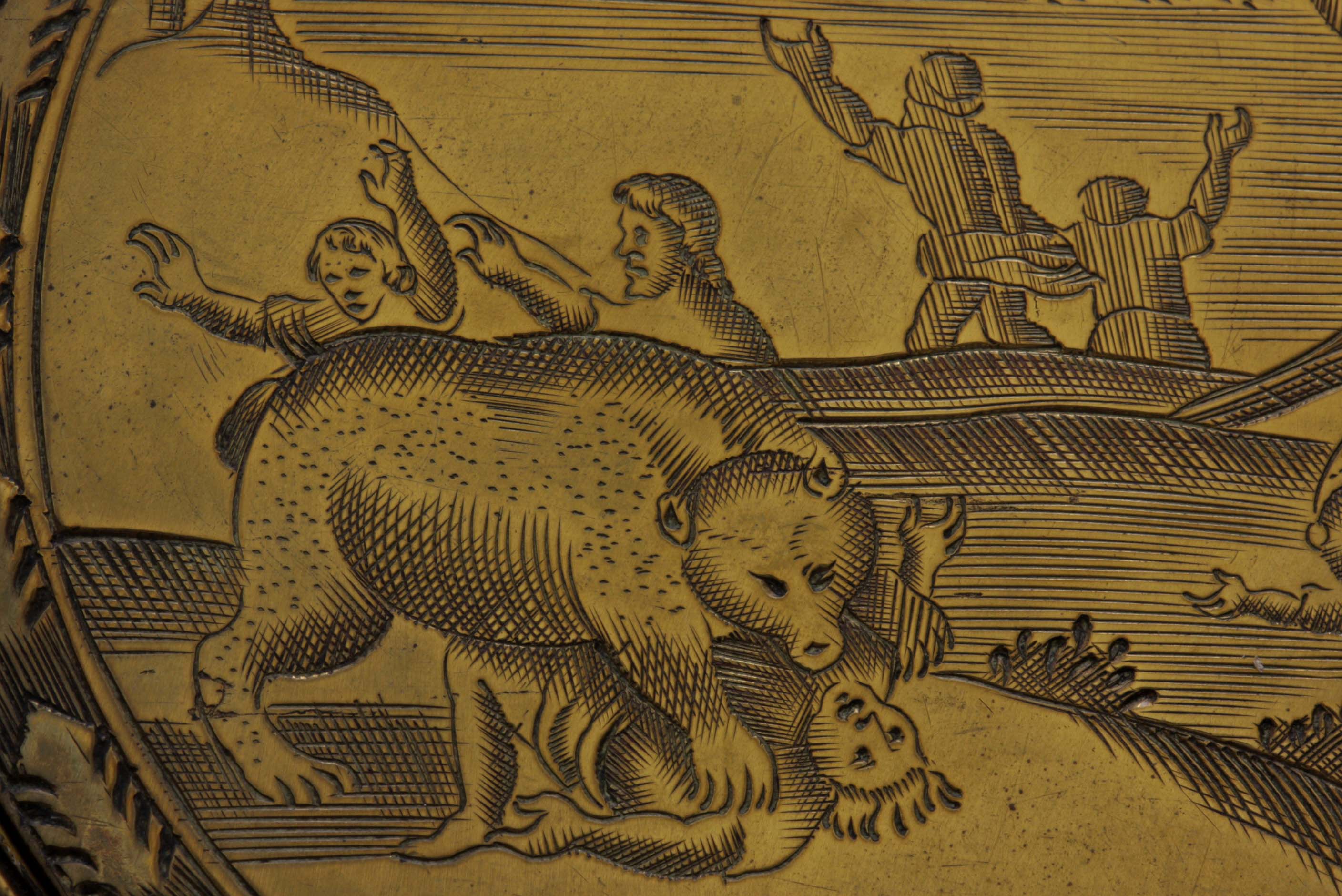
From 1680 the engraving work is brought to a new level. Then skilled engravers discover the tobacco box as a medium. The box with several lids (Cat. 9) is a sublime example of this and the visual effect is fully mature and technically perfect. Here is a class engraver who understood his profession and probably worked more often in silver than in brass. Incidentally, the artistic merit comes entirely at the expense of the visual artist who created the prints. The input of the engravers is purely reproductive and sometimes even a little bit slavish. Again there is serial work though the engraver did vary by turning the page of his print Bible or other source of inspiration.
A beautiful counterpart from the same period is formed by the Christ box (Cat. 10) which is proof of working in large series where simple iconographic emblems were set up quickly and accurately but with a minimum of lines. Look for this box on the powerful engraving sign that shows signs of a nearly cramped arm that did not do anything else for years. Incidentally, this is a style of work that we see on popular boxes until the beginning of the nineteenth century.
In the eighteenth century the tobacco boxes show a common engraving style in which a wide range of subjects is developed. In it we see clear fashion lines that seem to be separated from the artistry and the technical ability of the engravers and increasingly consumer-oriented series products. The tobacco box has become an established article, made in a certain competitive environment and the artistic quality of the engraver, together with the market demand, determined the appearance of the tobacco box. With many boxes there is a fixed division between the main performance and the ornamentation. When the boxes become larger, this main motif can be placed in medallions, ovals or a rectangle. In the frame we find additional motifs, taken from common ornament prints. Between both elements we often see small cartouches with text work. Through repeated repetition, these ornaments gradually became stylized to eventually end up as undefined motifs. Furthermore, the fascination with the textual in the boxes remains amazing, especially when we consider that not everyone could read for a long time. The engraving of texts was inconvenient but was part of the experience of the user.
In the first quarter of the eighteenth century the production of the brass tobacco box is still relatively modest and there is still a wide variation. In principle, this should be able to expose regional production. The box maker worked in a market-oriented way, resulting in whimsical lines per box type with local sales highlights. It seems that at that time there were no real workshops with a supra-regional production that worked over a longer period of time. This is underlined by a lack of unity in the preserved tobacco boxes. Nevertheless, there must already be a coppersmith next to an engraver, although we do not know how that relationship was.
In the second quarter of the eighteenth century we see an explosion in the production of tobacco boxes with extraordinary artistic examples as a result. The flowering is between 1730 and 1755. By box type it is possible to indicate rise, bloom and decay, although it is not always easy to give a sharp period dating. Highly sensitive engraved and very naturalistic boxes are among the top segment in the market. Soon this is supplemented with coarser work that is still professionally executed. As a second stream, besides this labour-intensive method, the en masse-engraved box is created, which is made as a market supplement for the ordinary smoker. It is a pity that we do not know the price difference between the two types.
The Elias box (Cat.14) is a fine example of a standard engraving concept characteristic of boxes with printed edge profiles. At the front, the edge is engraved that suggests sheet work, but due to the haste of the work, the curls of the main lines are too little specific, so that the performance disintegrates into separate lines. The sides and the back are engraved even more smoothly, here they are simple hatchings that hardly ever refer to the intended ornamentation. The relatively flat engraved ornaments form a strong contrast with the main performance in which main lines are combined with fine hatching that provides depth and shadow effect. This could involve pupil work in contrast to that of the master engraver, but that idea only applies when there really was production on a large scale within a system of more and less skilled workers. That is very much the question. However, the decoration still has its purpose because the ornament edges make the box more luxurious. At the time of sale the main motive is reason to purchase, only the critical viewer will only notice later that the other decoration is rather sloppy.
In the third quarter of the eighteenth century the production of tobacco boxes remained substantial, although the quality of the decoration was lower on average. That is related to the habit of snuff tobacco in the better layers of society, which greatly reduced the number of well-to-do customers. In addition, the range of boxes of alternative materials is larger. After 1770, the finely engraved box disappears and is finally replaced for boxes made from other materials. We see a specific approach in engraving for each type of mould. The elongated box follows the tradition that had already started at the beginning of that century and has become a conceptual article that shows little news. The square box that comes next is difficult with the large flat lid. When finally the point form is launched, the old-fashioned, established concept continues on a box with a moderate modern design.
An interesting aspect is the elaboration of the texts and the method of spelling on the tobacco boxes, which are often indicative of the date and sometimes even the origin. They run from simple letters of an engraver who was perhaps even illiterate to elegant engraved inscriptions, sometimes very regularly applied. During the engraving of these beautiful round texts the box had to be constantly rotated and that required extra effort and time. For that reason, the somewhat rough text dominated by speed, whereby not very well shaped letters in varying sizes are obtained. Unlike writing or calligraphy work, the texts with a burin engraved are always applied from bottom to top, so that the flexibility and thus readability are lacking while the individuality of the letters is violated. Only if an engraver worked very cautiously could this be prevented, although that was certainly reflected in the price of the box.
The prints are printed outside the scope of engraving but are part of the decorated boxes. Especially the boxes from the German town of Iserlohn are mechanically decorated in relief (Cat. 25, 26). Work has also been done in the Netherlands, such as a box with the Ascension of Christ (Cat. 27). Quite rare is the combination between printing and engraving that is known only from one workshop. An example of this is a box with an engraved moralizing representation (Cat. 24) between striking printed rosettes and a cartouche. All these relief boxes date from the second half of the eighteenth century.
Although numerous publications speak of engraved boxes next to smooth, undecorated ones (Fig. 7) I still have the impression that these undecorated ones have been an insignificant percentage. Apparently it was customary to engrave the brass tobacco box and sell it in that version. This is also evident from the countless specimens that have emerged from archaeological research and where there are only rarely any undecorated boxes.
The subjects
The engraved Dutch tobacco box displays a wide range of subjects, each intended for its own target group with its own period of popularity. The most extensive representations are narrative with a religious, historical or topical subject. They are in line with the experience of the user. Many engravings are repeated endlessly, although they often show differences in detail. The number of boxes with a unique image is small and what we now call unique, turns out to be series article tomorrow because a second copy is found. Among the most famous themes are history and especially the Biblical, more limited is the section topicality, some with a political undertone. In the cheaper boxes morality plays an important role, after all there are boxes with a specific theme such as the calendar boxes.
The category of Bible boxes with themes from the Old and sometimes also the New Testament is very large and that is not surprising in a religious nation such as the Seven Provinces. Common subjects are the Sacrifice of Abraham (Cat. 2), Elias and David (Cat. 14), scenes from the life of Christ (Cat. 9) and saints' images. Beautiful combinations are the Pope-devil performances and those of Luther and Calvin. Historical portrayals have been less popular and have therefore had a specific distribution. For both themes prints were used as an example because inventing the performance was beyond the reach of the engraver. For biblical boxes, the images from "De Kleine Print Bybel" (The small illustrated bible) from 1736 are the most used, the historical representations come from countless divergent publications. Sometimes loose prints also served as an engraving example. There is often a simplification of the representation.
More limited are the contemporary representations, scenes with a topicality that have now become history. An interesting example is the tobacco box dedicated to the cattle plague that ravaged our country three times in the eighteenth century (Cat. 17). Here a detail from an existing print has been engraved in a rather coarse way. It seems that the brass tobacco box with a political statement never really became popular and of course that had to do with the predominantly simple target group. Actually and to some extent politically engaged, the coaat of arms of the Seven Provinces (Cat. 15) are sometimes combined with pro-Orange performances such as the portrait of Stadholder William IV (Cat. 19). They date from the late 1740s and are a political statement for the unification of the Seven Provinces led by the Oranges. Representations of the seven provincial coat of arms with, for example, the allegory on trade and shipping are the more moderate variant (Cat. 15). A second rage of Orangist themes stems from the time of the contradictions between the Patriots and those who favour the Prince of Orange. In that period, boxes with the Oranges are re-created, often with the profile portraits of Prince William V and his consort Princess Willemijntje, well-known representations that have also been applied to many other articles of use.
Boxes with cityscapes exist in ample variety and were popular as well. They are often sold as a souvenir or commemorative piece. Cityscapes are usually portrayed as a panorama where the characteristic church towers and gates should indicate the city. Generally, to convince the consumer, the city name is placed on the cut above or below the show. Many cityscapes are less related to current events than you would hope, they were engraved from existing picture books and sometimes the prints were already a century old before they appeared on the box as an engraving. We do not see topographic accuracy, and that is reinforced by the stylization. Here, too, we see different periods of popularity. The city profiles start in a fairly simple manner in the 1670s (Cat. 8) and remain in use for about a generation. Strangely enough, they only once again became popular around 1780 (Cat. 28) to even get a short-lived boom in the first quarter of the nineteenth century (Cat. 29). On the later machine-made tobacco box, this theme even comes back and still shows the same sketchy representation.
Another topic is the town coat of arms that is often combined with additional motifs such as those of faith, hope and love. A tobacco box with the coat of arms of Batavia is a fine example of this (Cat. 21). This tobacco box is interesting in two respects. Firstly, the lid and bottom were honed and doubled so that a separate effect was obtained. Furthermore, the depiction reveals another fact, namely that the engraving example was literally taken over from a Gouda mark vignette for clay tobacco pipes where eagles act as shield holders [24]. That is an incorrect idea because in reality the Batavian city weapon is held by standing lions.
A special category are the more popular subjects devoted to domestic life, entertainment and morality. The surprise tobacco box is the most elitist example of this and shows gallant scenes with erotic variations behind them (Cat. 16). Another tobacco box is also better than average and has printed motifs on the lid and bottom while the engraving is dedicated to morality. The text reads "Liefde haar geruchte, ik moet vluchte" (Love hates rumour, I have to flee) (Cat 24). Boxes about love and loyalty are numerous. For example, we see images of popular morality between marriage moral and schlainsmarscheerders (Cat. 22). Often they have a humorous slant and the inscriptions are often simple and rectilinear, sometimes a little oblique. A counterpart shows a different face of the woman, namely as a qyuat wijf (angry woman) (Cat. 11). The category of morality also includes boxes with rhymes, rebuses and riddles. Such subjects were not conceived by the engravers, but were also engraved from puzzle books (Cat. 20).
Specifically, the tobacco boxes were sold in Amsterdam and according to reports made by the Pieter Holm school keeper and his successor [25]. Holm indeed founded a nautical school with the appropriate name "Het schip regt door zee” (the ship sails straight through the sea) and also drove a trade in sea maps and navigation instruments. According to his saying, he would have made tobacco boxes himself, which he supplied with a so-called zeemeter (sea measurer) (Cat. 18). This statement is, however, extremely doubtful, rather he ordered the boxes from an engraver and that is confirmed by the smooth engraving style of the numbers on these boxes. Holmdozen are the least attractive in artistic terms. They display a perpetual calendar and a calculation model on the lid and the bottom to determine the speed of a sailing vessel. Both tables are placed centrally on the shelf with modest portrait medallions at the ends. The engraving of these Holm boxes is strongly industrial: the lines seem to have been drawn along a ruler and the squares are then filled in volatility with the burin. This had to be done carefully, however, because these tables had a calculation function that would seriously affect the added value of the use of the box. It is clear that this hand engraving work has been done quickly with a minimal turning of the box. For example, we see that the numbers 6, 9 and 0 are made up of two smooth engraving marks, the hulls have become slightly pointed by this method. Most of the Holm boxes carry a date between 1729 and 1775. They also cover the heyday of the Dutch engraved tobacco box.
The sides of the Dutch tobacco boxes are less elaborately decorated. They often show a repetitive ornament or some stylized leaf work characterized by simplicity. We see a certain style unit for each period. For example, tightened book work is very popular between 1730 and 1750, while a spell or text dates from around 1750 (Cat. 21). Typically, the jumping animal figures such as dogs, hare or deer (Cat. 19, 20) are sometimes chased by a hunter (Cat. 24). Such circular representations are also shown on other consumer items and have had a long duration. Exuberant engraved boxes sometimes show beautiful leaf work of acanthuses against a shaded background (Cat. 16). In the 1770s, checkered motifs or hatched triangles appeared on certain edges (Cat. 23). After that the saying revives on the sides, often in a manuscript with small letter-hulls and long strokes (Cat. 28). Variants show a simple rebus. Often the circular decorations are more time-bound than the images on the lid and the bottom because the edges were filled in from the head, while the main representations of print work or another engraving example were taken over.
At the time a new tobacco box looked razor sharp and shiny yellowish, something that we can hardly imagine. Due to use, the box gradually wore and received a more rounded shape and smoother surface, all of which created a new charm. When the box gets older, the engraving lines fill with dirt and become oxidized, so that the appearance changes again. Eventually, the worn overshadows the original appearance until the box has completely ripped off and is discarded or returns to the crucible. All these use phases influence the appearance of the tobacco box.
Dating and maturity
Assigning a date to a brass or copper tobacco box is quite complicated. Tobacco boxes are traditional objects that have been made over a long period of time and are only going through a gradual development. This was already apparent from the development of the box shapes but also from the decorations and method of elaboration. The makers are craftsmen who have worked in different places and have strongly adhered to the tradition. They followed the existing work earlier than they were looking for something new to come up with. In addition, the customer base was conservative. For a date of a Dutch tobacco box, an exact year is therefore not a realistic starting point, but a well-founded period dating is.
When giving a date, the box shape is the starting point. A clear periodisation has already been given for this in the previous paragraph. Once divided by period, we can subdivide the boxes according to quality. Based on the fact that the market supply of tobacco boxes always showed a certain variation, it is possible to define certain styles and to arrive at a more precise date. It is wise to keep a broad vision, mindful of the long-running traditions. On average, there was always a choice of qualities for the smoker in various price ranges. The expensive beautifully engraved boxes made in a modest edition next to the series product. From a logical point of view, the preserved boxes should be distributed more or less evenly over time, naturally with a certain increase to the more recent period.
The seventeenth century tobacco box is characterized by short periods with specific box types. As an example, the moulded eight-sided boxes (Cat. 3-5) serve as a luxury item next to the tinny Amsterdam eggs (Cat. 6). The dating can be read from the way of engraving and the subject. A snag if a dated coin on the underside of one of the boxes (Cat. 3) suggests a longer running time, but that cannot be true. Both types of boxes were made in Amsterdam in the same period, each with a duration of approximately twenty years and intended for two different target groups.
The dating of tobacco boxes from the eighteenth century is more complicated because the fashion lines continue longer. Also during the flowering period of the brass tobacco box, the period between 1730 and 1775, we distinguish a market offering with different qualities sold at various prices and intended for different social layers. The quality of the box says something about the ability of the maker, although we have to take into account that it has always been market-oriented. The purchase by the consumer on the other hand does not always refer to his stand, but rather says something about his sense of fashion, status and of course his experience.
Boxes such as serial work made with smooth to sloppy engravings come on the market when the popularity of the tobacco box increases but the social appearance of the user drops. This movement applies in general, but we also see per box type and sometimes even per decoration. That pattern starts around 1730. In it, the tobacco boxes follow the course of most utensils: from the exclusive loner to the serial article made with increasing numbers. This often involves a broader market such as that for export. Also in the foreign country the Dutch tobacco box becomes a talk that is shown with pride. In the case of these boxes, possession is more important than the performance. Therefore, hardly any special topics have been carried out for export.
The engraved Dutch tobacco box gets strong competition from the mechanically printed box with relief decoration from Iserlohn after 1760. This production line is well documented and therefore sharp to date, although we have to take into account that the moulds sometimes have a second use. Then the printed box of can on the market appears, originated in Braunschweig. It quickly becomes a flourishing industrial product thanks to the attractive painting. These colourful boxes quickly displace the brass box. After the Napoleonic era the use of the tobacco box is drastically reduced. Numerous smokers switch to cigars and use a cigar case instead of a tobacco box. Nevertheless, production by the traditional coppersmith still lasts until the end of the nineteenth century, albeit in decreasing numbers. In that period we see a stronger change of engraving styles.
An added factor to the tobacco boxes is the ownership mark. Apparently, applying a personal sign was a necessary insurance not to dispute the ownership right of the box. That says something about the serial production and the general appearance of the tobacco box. The initials of the owner are placed on the outside of a cast box (Cat. 3), with other boxes the owner initials are placed in a less prominent place on the inside of the lid or bottom. Property brands from the eighteenth century are much scarcer and that is an indication that the market offered a wide range of images so that the chance of encountering the same box was low.
The date that we attribute to a tobacco box has a close relationship with the life of the box. Most of the items have been sold as a normal consumer item. Depending on the owner, they will be used daily. Because the pocket in the trouser or the pocket in general offered safe protection, the wear was limited. Nevertheless, we can assume that the majority of the boxes were simply worn. That wear process happened over countless years. Of course, it depends on the type of smoker whether it is carefree causing the box to wear quickly or whether the box was reserved for heyday and could go with it for generations. Of course, the latter examples are the well-preserved copies.
Finally, the identification must take account of counterfeit boxes and even counterfeit specimens. The craft of the copper worker was so traditional that methods remained in use for a long time. Both the box shapes and the subjects could be re-created a generation later and even get a broader sale. Such imitations sometimes betray minimal characteristics the later date, although it remains unknown how many boxes have not yet been exposed as such. In addition, there are counterfeit tobacco boxes that have entered the market in a wide variety from the first quarter of the nineteenth century. Except for the traditional smoker, they were intended as a curiosity for an emerging circle of collectors. Sometimes it can be difficult to recognize such older imitations.
Production sites and distribution
Centres for the production of engraved Dutch tobacco boxes are hardly known. The manufacture must have taken place throughout the Seven Provinces. Yet there is hardly any evidence of this in the form of attribution because of archaeological finds or the frequency of appearance in estates. Amsterdam seems to be the most important centre and that is not surprising given the size of this city. Rotterdam was probably a second production site. The role of the coppersmiths in villages or in rural areas is still completely unclear. Dutch tobacco boxes are seldom signed and can therefore only be attributed incidentally to a maker. In addition, the engraving of boxes is an activity that could be practiced everywhere. A lot of work is therefore endlessly imitated and is not tied to a place. The origin can only be determined in rare cases.
Yet there are sometimes small indications that may indicate a manufacturing location. A box with the Seven Provinces also bears the arms of Rotterdam (Cat.15), a sales argument valid for that city that certainly increased the market value. May we assume that that box was made there, especially since the silver tobacco box with the same shape was popular there. In most cases, however, we are not inclined to make an attribution based on a city image. We know the boxes with the city profiles from the 1800s, for example, with different city and village views. They were made on the basis of a picture book to then effect the sale to different places or to find the consumer who had affinity with that place. The workshop of these boxes can not be determined yet.
An important foreign centre for tobacco boxes is Iserlohn, a place in Sauerland in Germany. The relief boxes from this centre were already mentioned, not with an engraving but printed with a table press. In terms of shape, these boxes follow the Dutch tobacco box, but iconographic traps are entirely within their own choice of subject with the favourite of the Prince Frederick the Great and his battles (Cat. 25, 26). Nevertheless, boxes for other market segments have also been made in Iserlohn, such as the Dutch topography with cityscapes of Amsterdam and Rotterdam [26]. The technique of the Iserlohner boxes has also been followed in other unknown centres. An example of this are boxes with Bible representations (Cat. 27) characterized by thinner sheet material. Only the connoisseur can determine on the basis of slightly different details where a box probably came about. Even with this good, there is no indication for a production site.
Dutch tobacco boxes are soon exported as a popular item to England, Germany and Scandinavia and even further overseas to countless colonies. This export leads to a reaction to boxes made in the area of destination. A good example of this is copper boxes made in the Dutch style in Ceylon [27]. There is a big agreement in material and form. Such work can usually be recognized by change in technique and in their own decoration patterns with a slightly eastern undertone. Besides imitations that become embedded in foreign cultures, there are also imitated or false tobacco boxes, copies made at a later date in imitation of the original box that sometimes show a bizarre combination of details.
The appearance of the tobacco box had a close relationship with the user and reflected his sense of fashion, sense-awareness and status. This concerned the colour, the shape but often also the decoration. In addition, the phenomenon tobacco box existed as a gift to a loved one or as a reminder for proven services or years of employment. In those cases the appearance has no direct relationship with the user, with a gift item that is of course determined by the giver. The tobacco box was also popular as a prize item in the shooting society. An important sale was found in the annual markets where many occasional items were offered. Furthermore, the tobacco box was often an article that was sold by pedlars. Because the distribution at the time has been greater than we are inclined to think, the determination of the production site becomes increasingly diffuse. However, by being alert, much information will appear in the future.
Boxes of competitive materials
The fact that the Dutch brass or copper tobacco box did not have exclusive rights is proven by the numerous tobacco boxes made of alternative materials. This section deals with some material variants as an appendix. Among the most expensive tobacco boxes are those that are hammered from silver. Such boxes were mainly showpieces and were rarely meant for daily use. In terms of shape, the silver tobacco box is similar to the brass serial box, although more care has been taken in the implementation and they are entering fashion more strongly. In the best examples gearing has been applied, in other cases it involves meticulous engraving. Both decoration techniques fit better with the luxury of silver. We also see the elitist aspect on the hinge that is sometimes recessed and so less noticeable. The showcase function of these exclusive tobacco boxes is also underlined because the well-known moulded pipe stopper on the inside of the silver box is often missing.
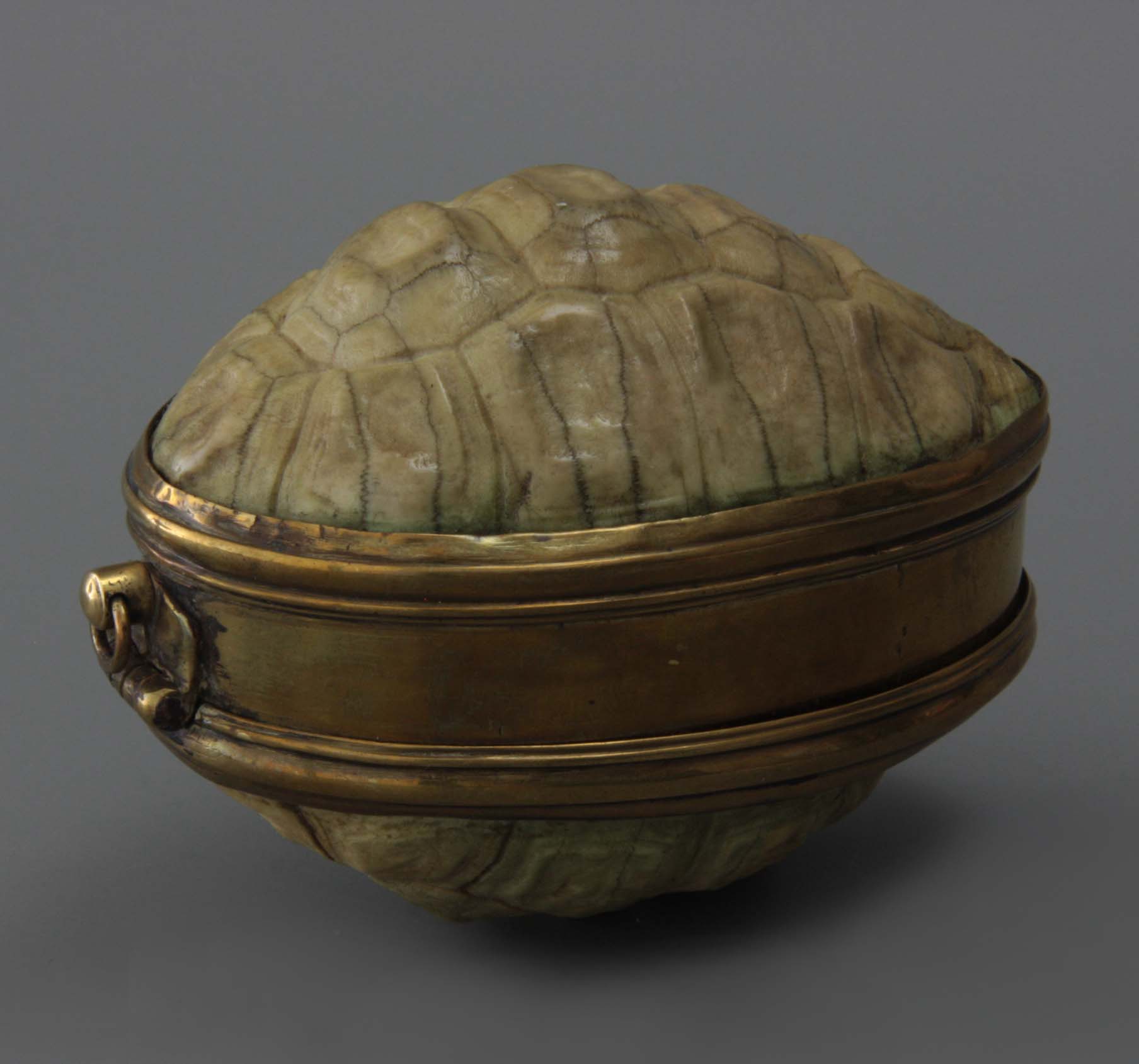
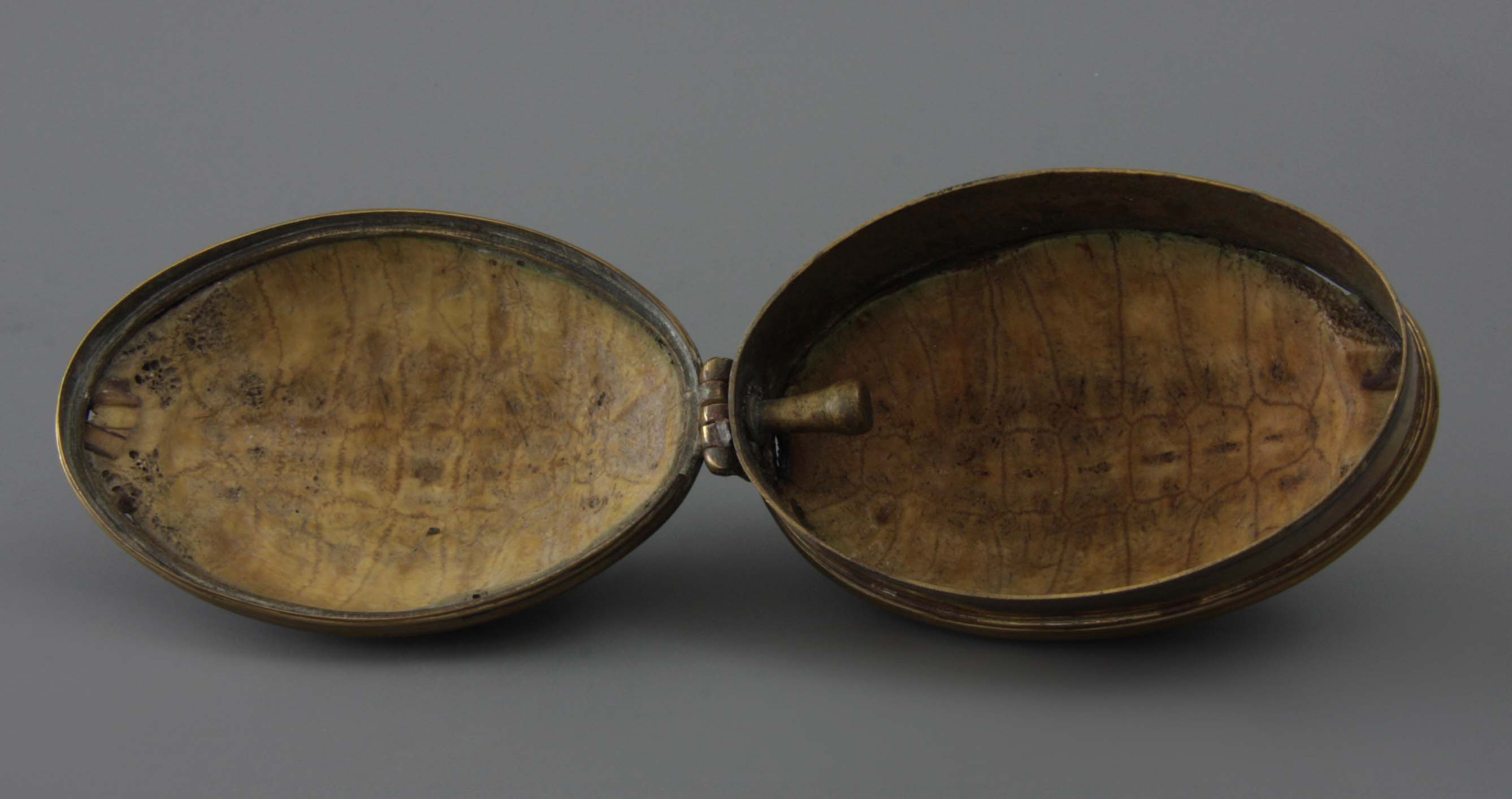
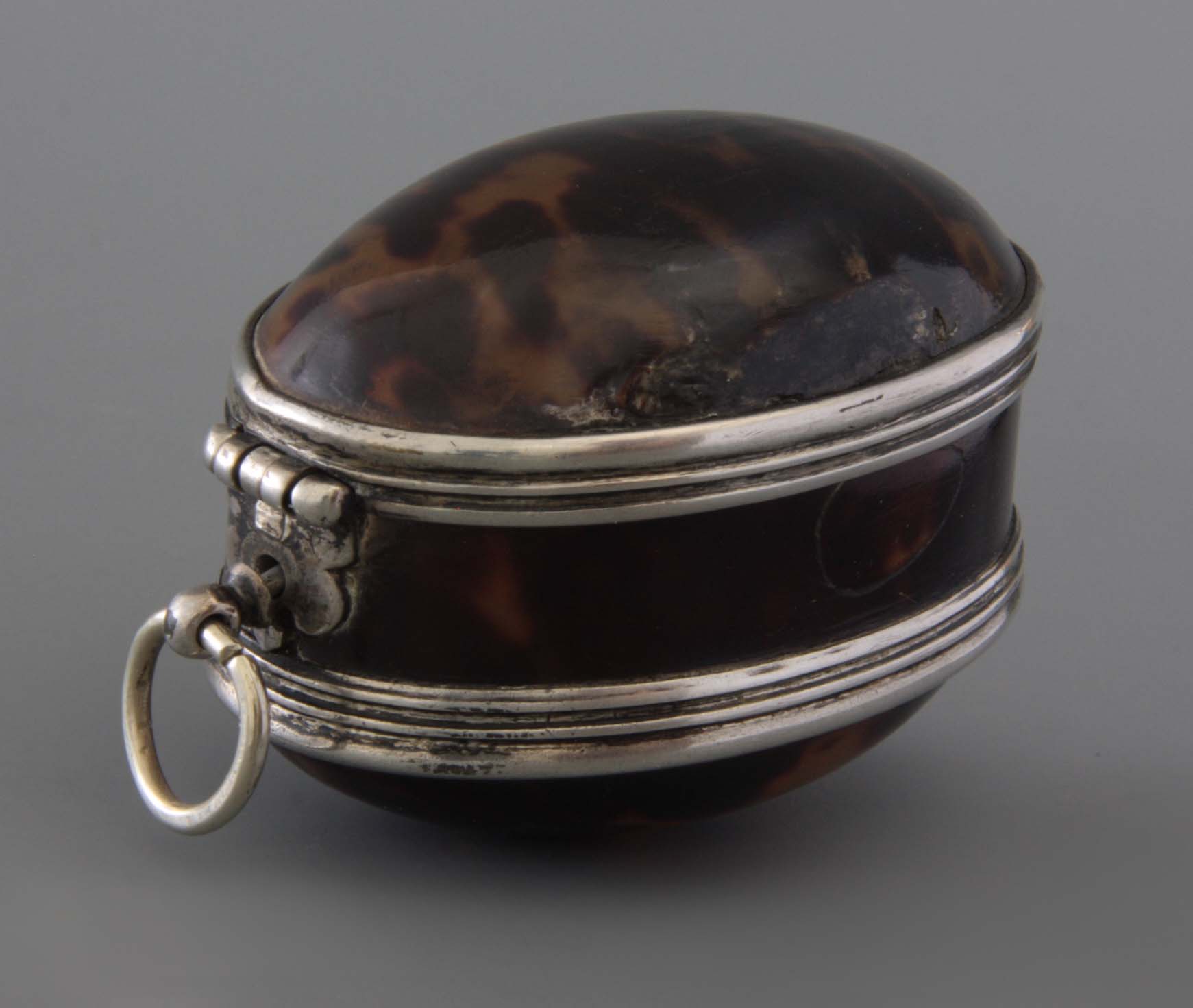
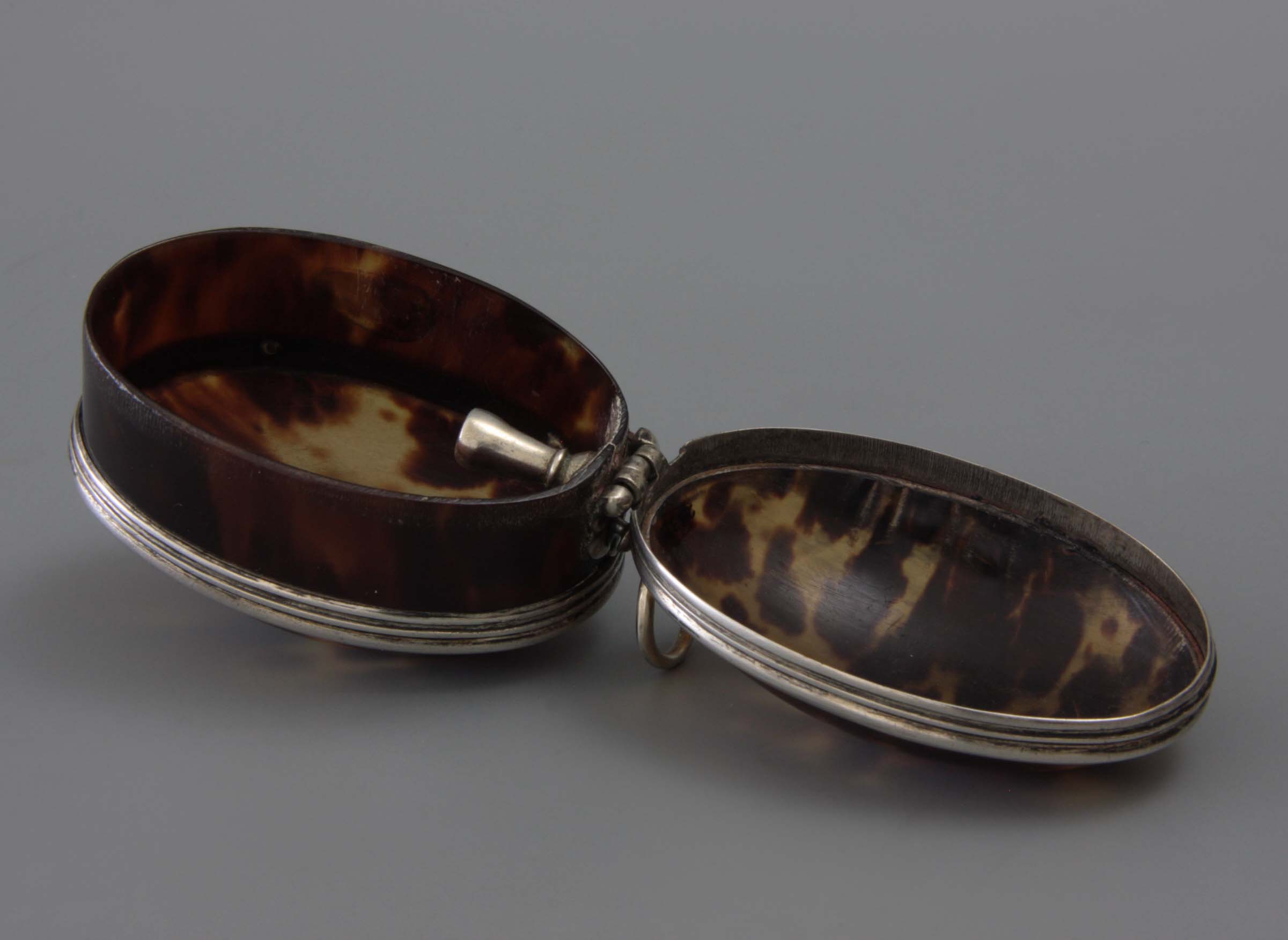
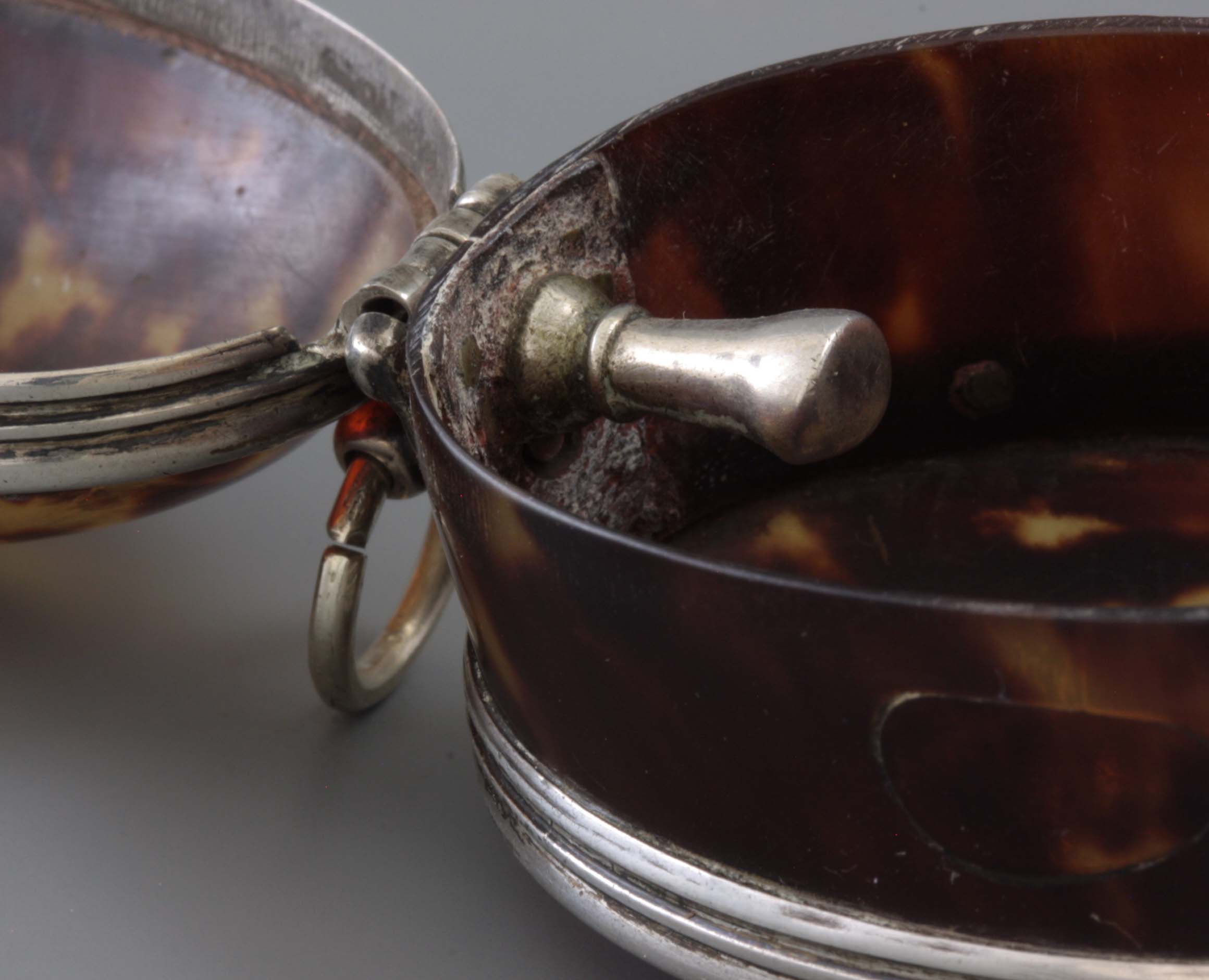
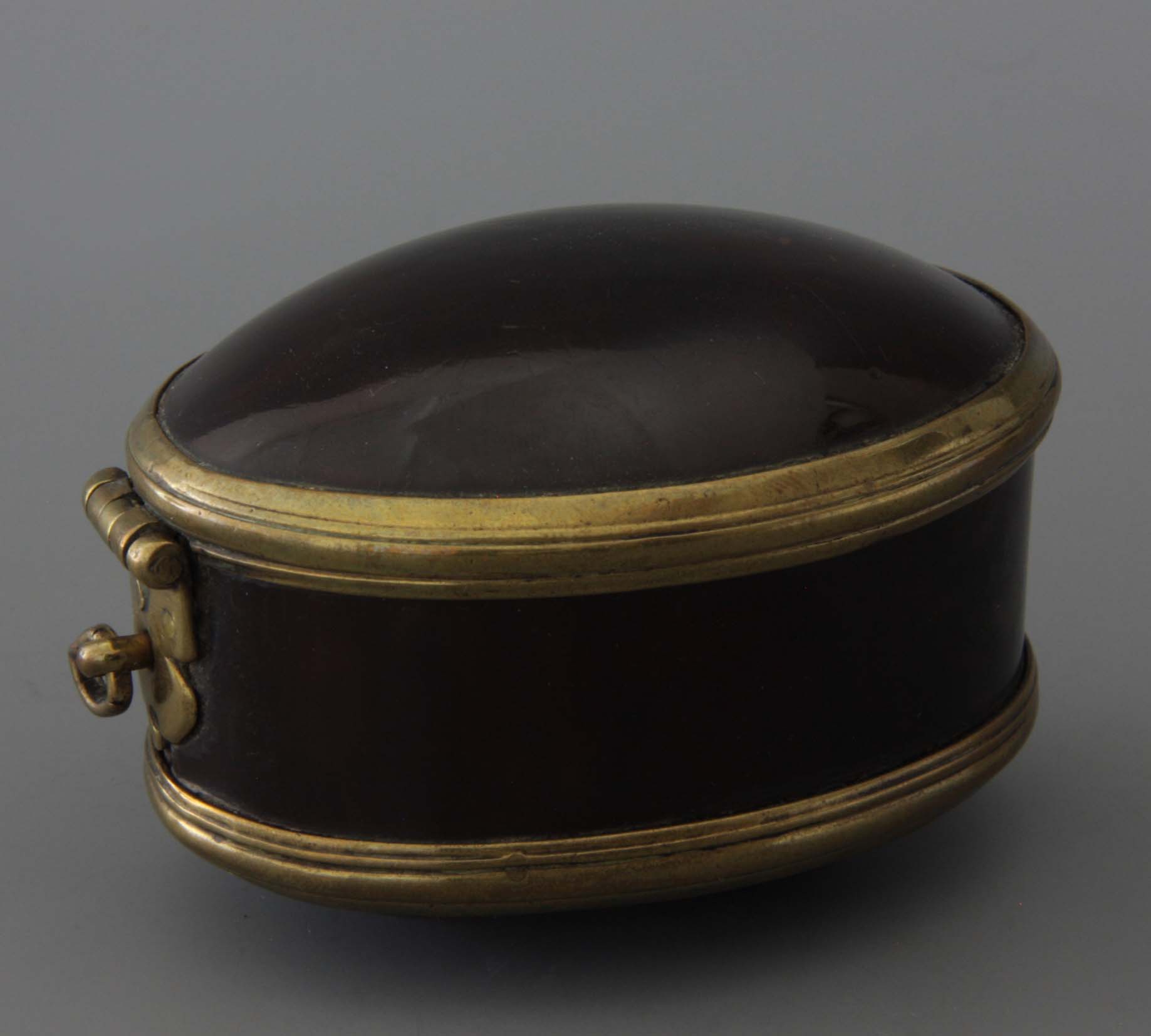
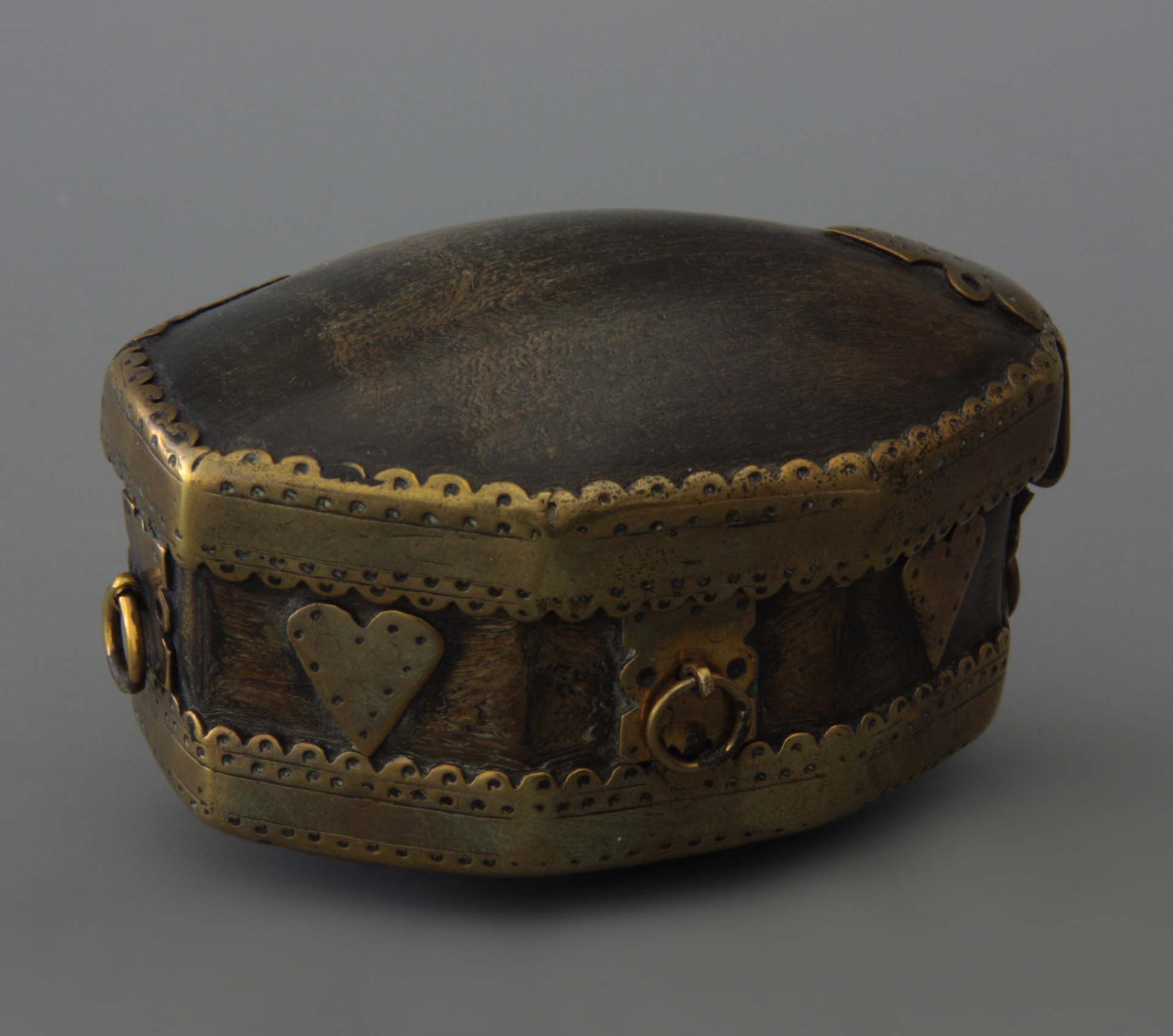
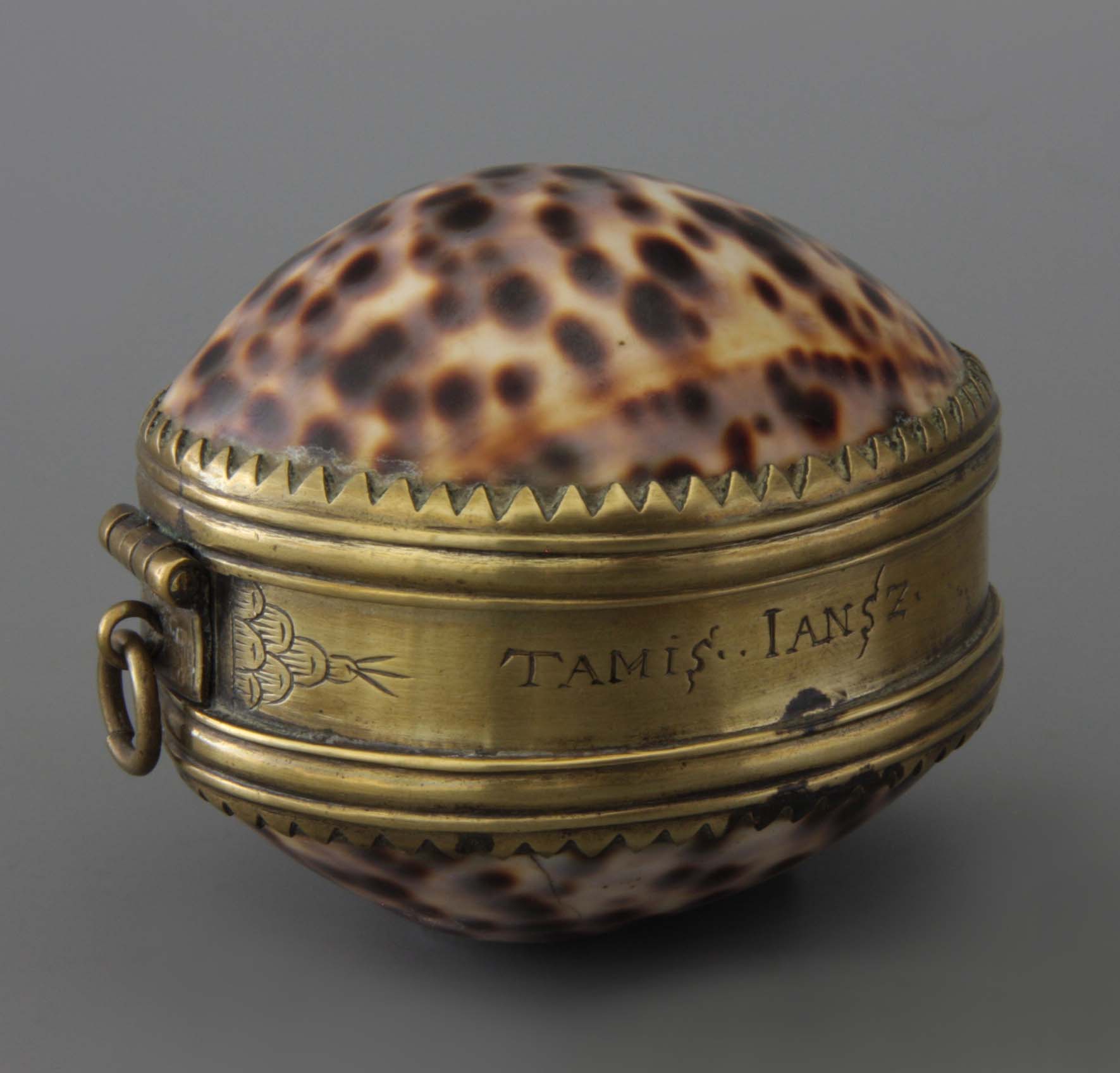
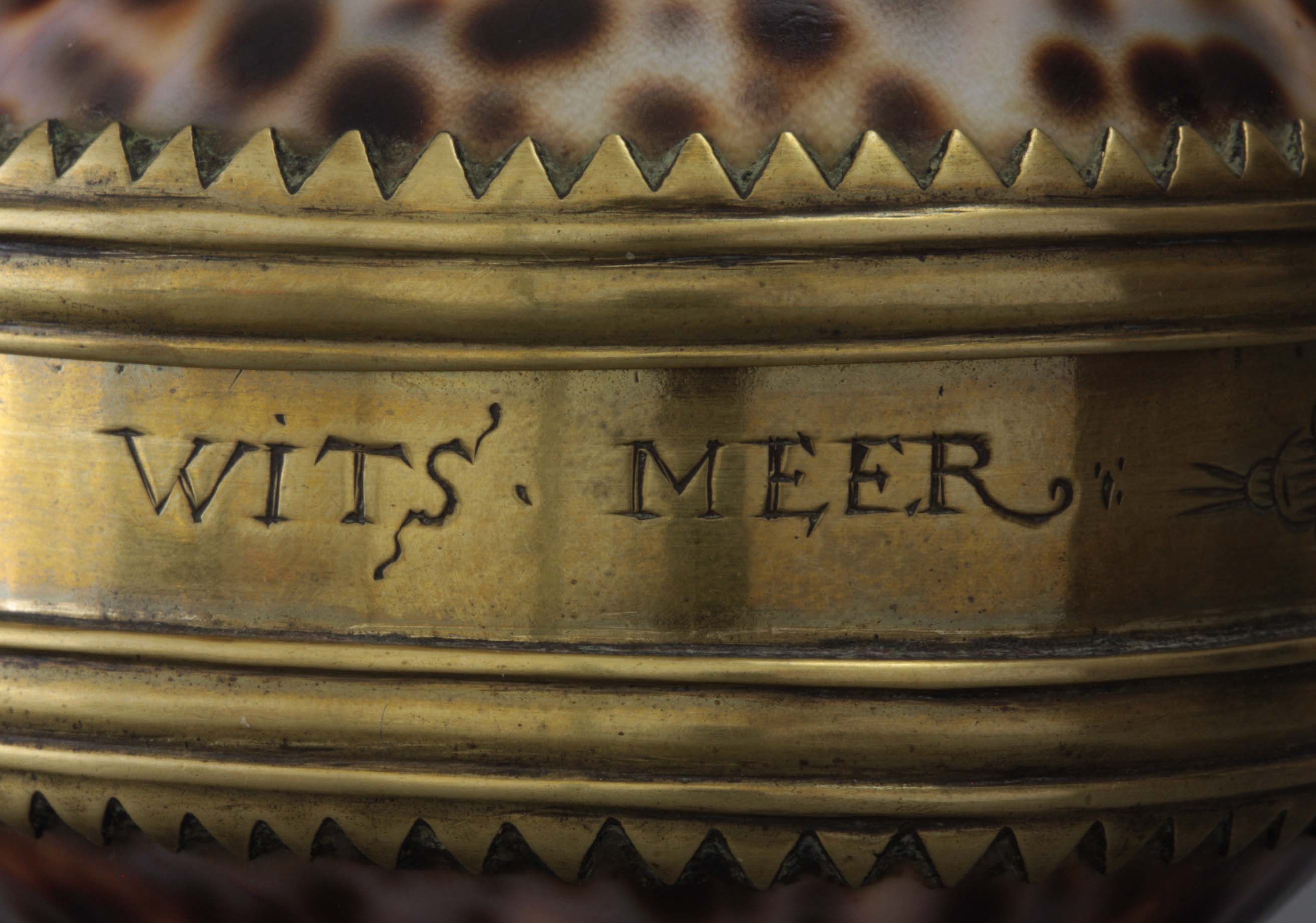
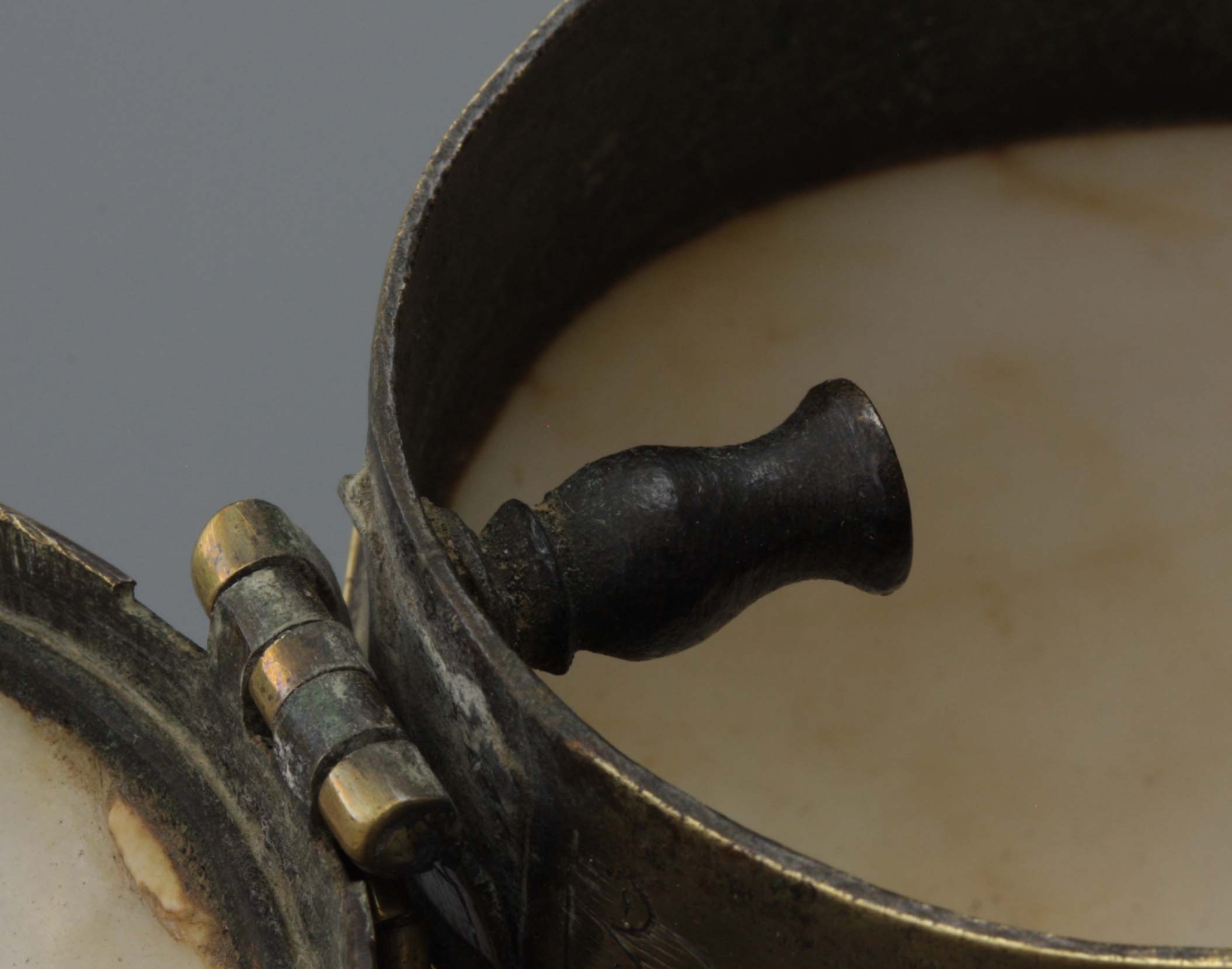
An important alternative material for the seventeenth century tobacco box is tortoiseshell, which was both polished and mounted with complete turtle shells (Fig. 1). Usually the assembly of silver (Fig. 2), but brass is used as well (Fig. 3). Uncommon is the use of whale baleen to make the box bottom and the lid (Fig. 4). In rare cases, larger cinnamon shells have been used as a tobacco box (Fig. 5) [28]. The assembly of exclusive materials such as turtle and shell gave a completely different status function than the precious metal box. It especially embraced the appreciation of the unexpected expressions of nature. Although in the past it was assumed that such boxes were used by people who brought the tortoiseshell shields from overseas, this must be doubted. Rather it seems that the shields were imported by certain quantity and that the boxes were made as a serial article. What is certain is that they have had a general spread and had a clear status function even if the target group can not be clearly indicated.
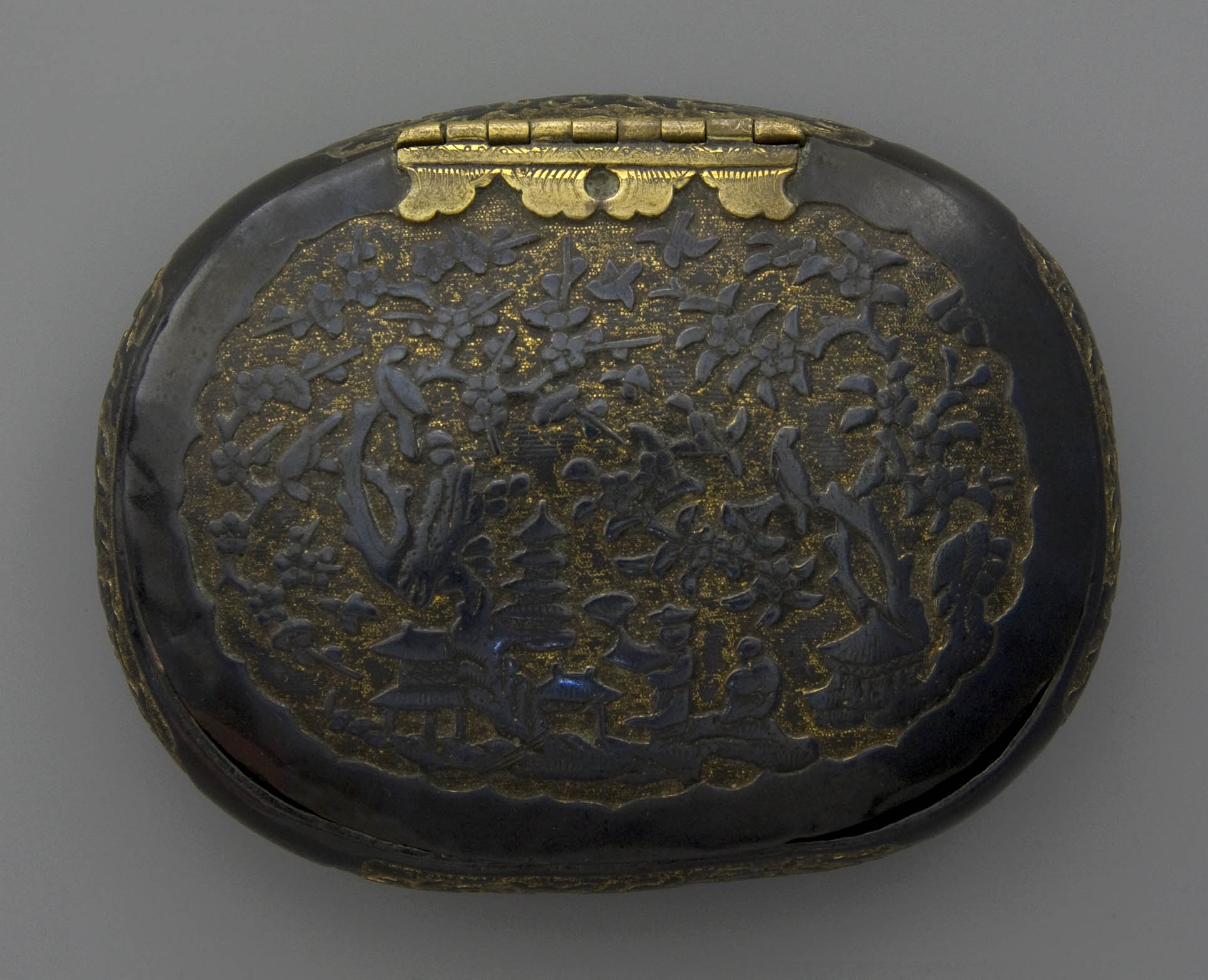
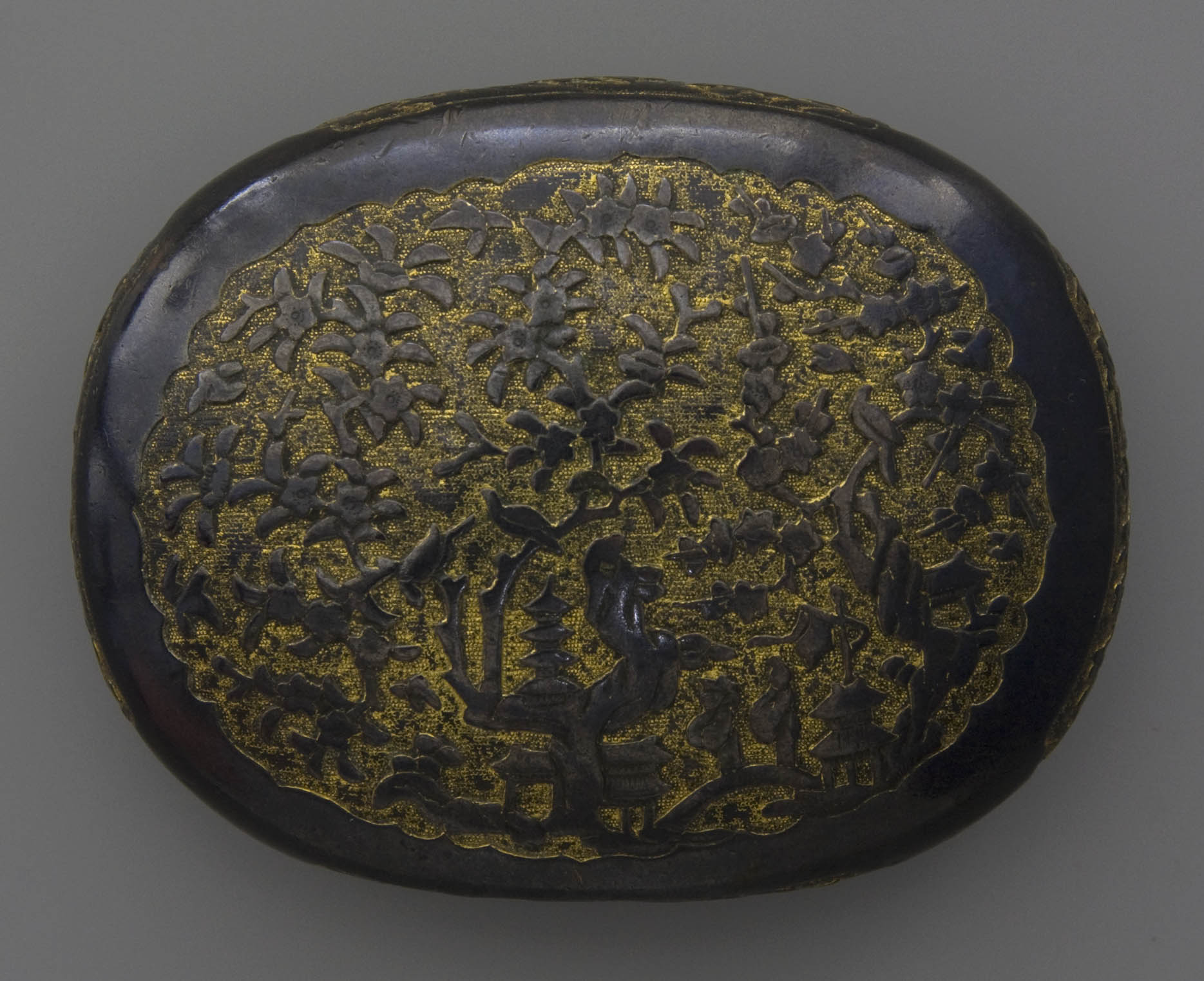
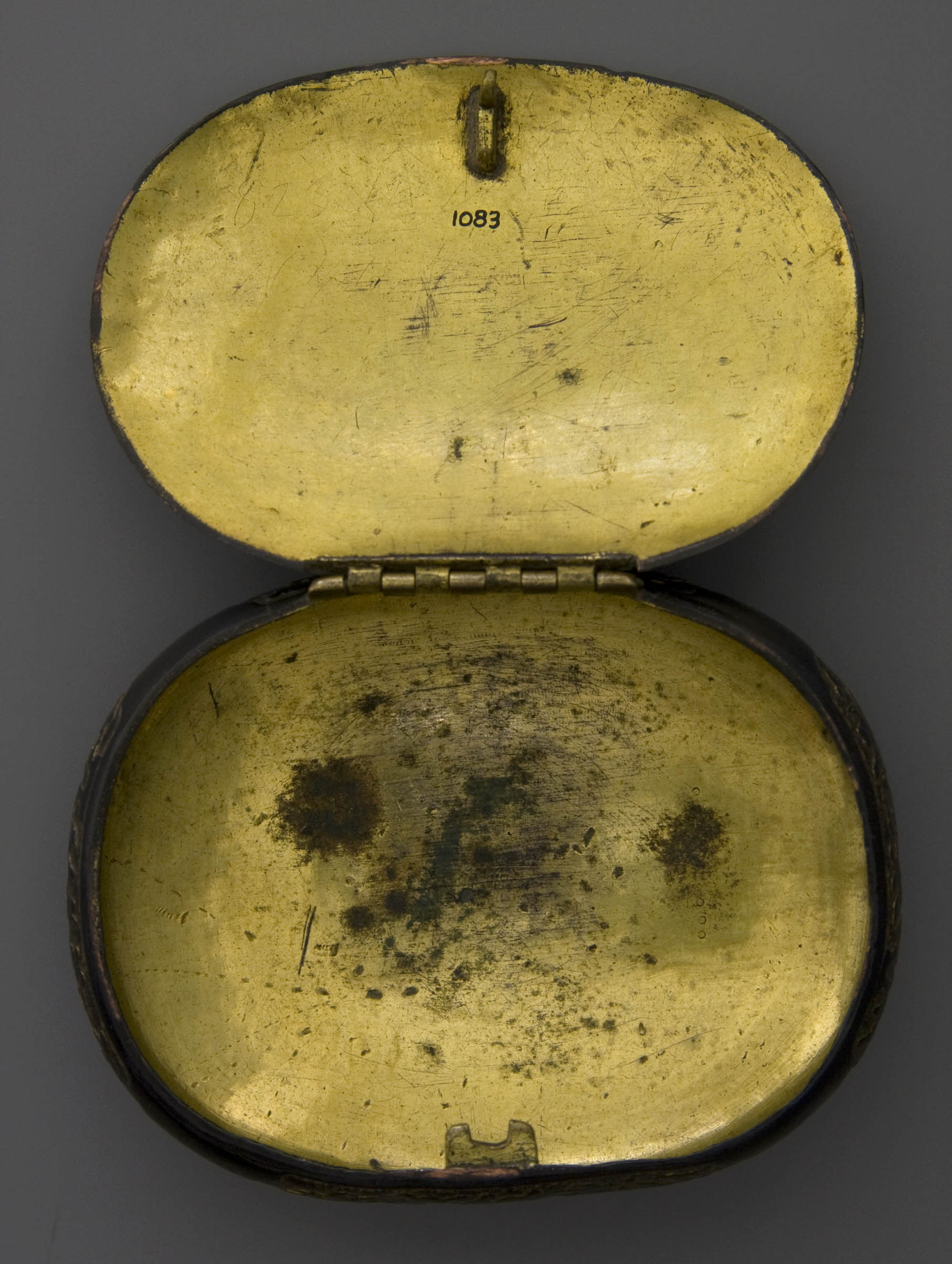
Another category of exclusive tobacco boxes was supplied by the VOC from the East and is known under the name sawasa [29]. It is a Chinese metal technique that was applied between 1680 and 1740 both in China and in Japan (Fig. 6), where the Japanese imitated the Chinese. These beautiful boxes are made of bronze and partly cast. As decoration, sunk panels are often arranged on which refined outstretched decorations. The metal is then blackened or lacquered in black, while the decorative parts are accentuated with fire gilding. It is the tobacco box that became popular in the circle of VOC merchants and fulfilled an important souvenir function for these people. Although the shape is related to the Dutch tobacco box, the product exudes an exotic atmosphere.
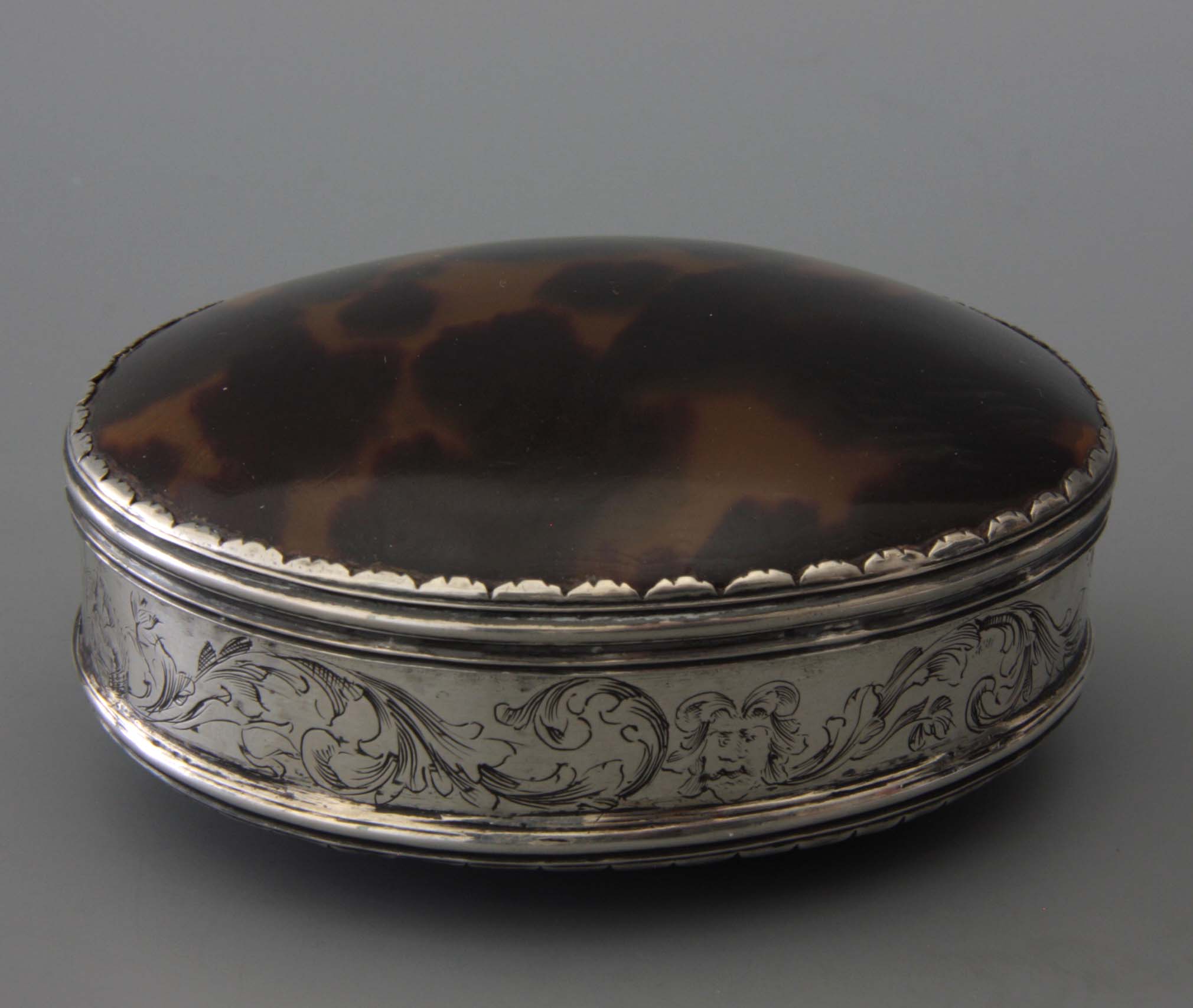
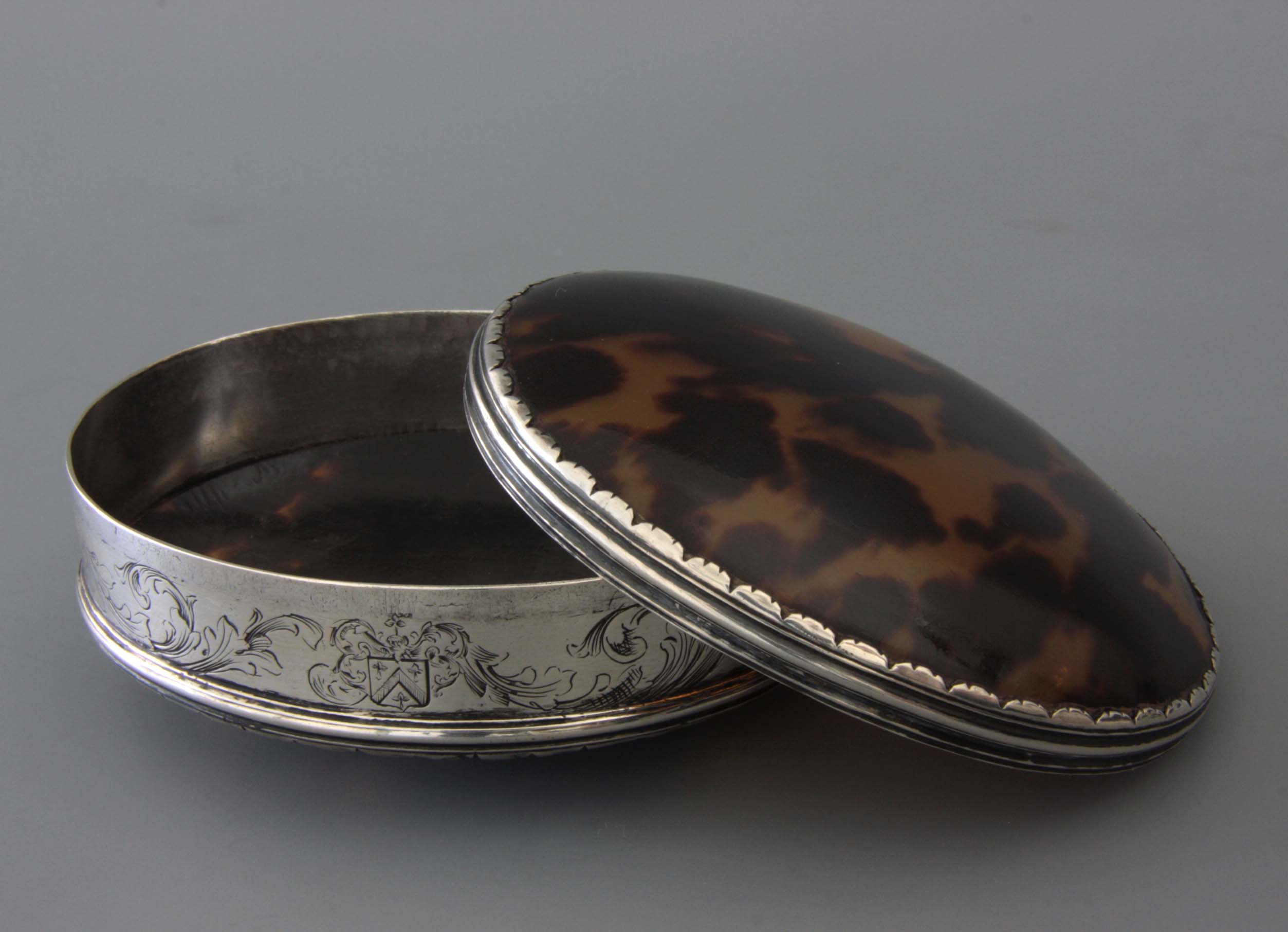
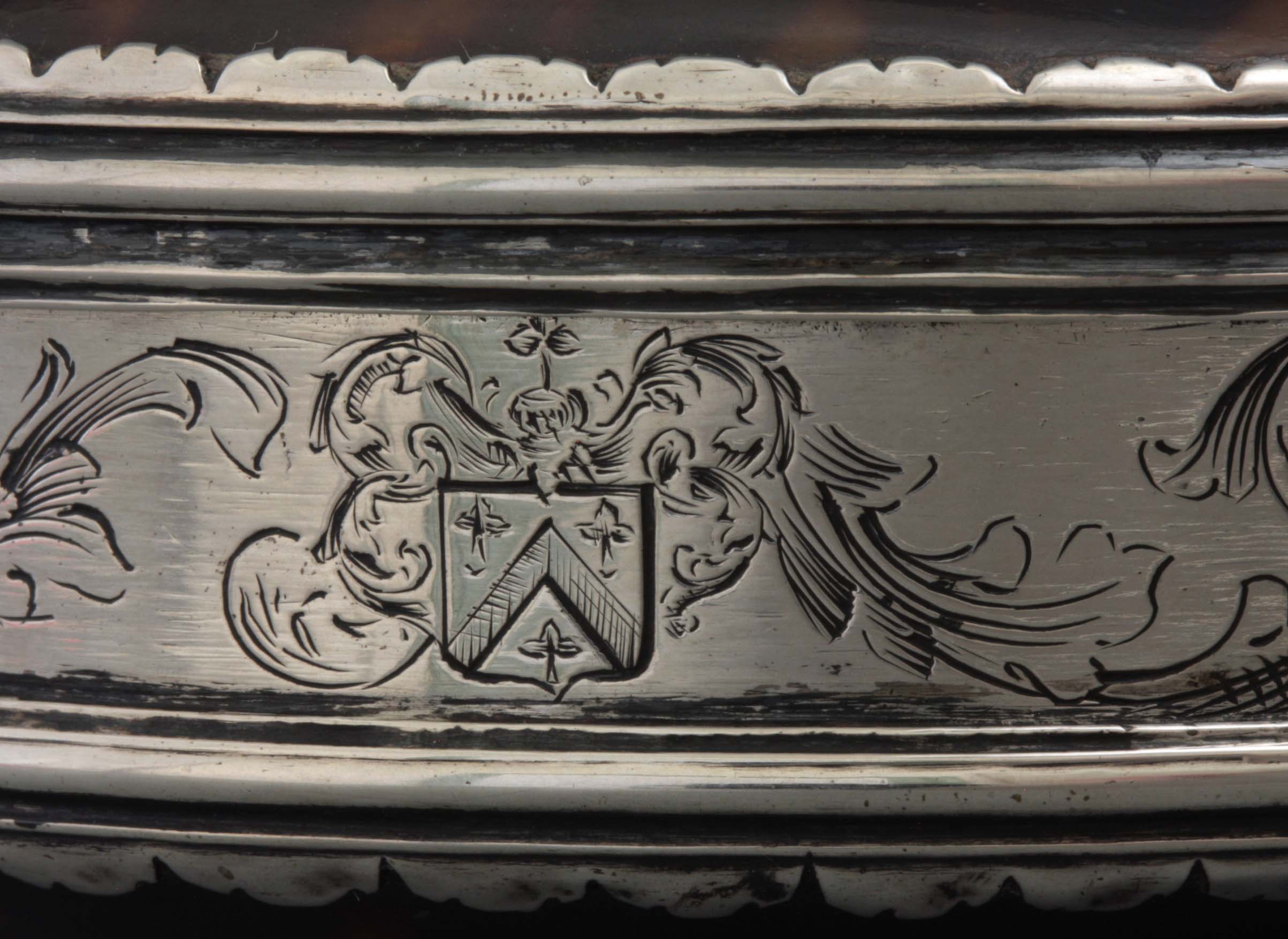
In addition to metal and exclusive materials, there was a wooden tobacco box for the common man: simple oval thin wooden boxes with a flat bottom and a flat lid with a lid edge over the box. Chip boxes have the major disadvantage that they keep the tobacco badly fresh. The luxurious version of these chip boxes is decorated on the outside with so-called travail de paille (straw work), a representation built from coloured straw that sometimes can have a surprising fineness.
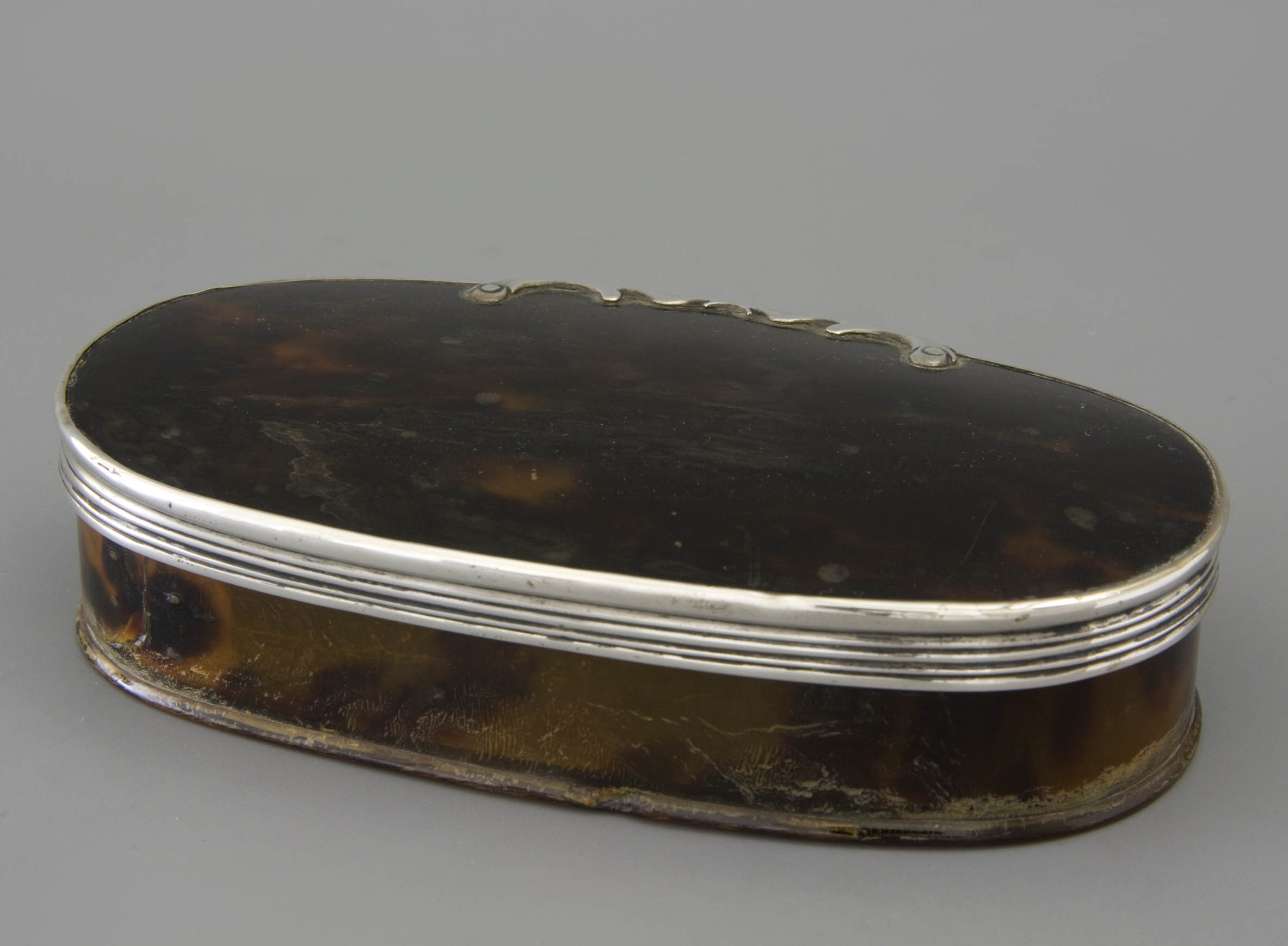
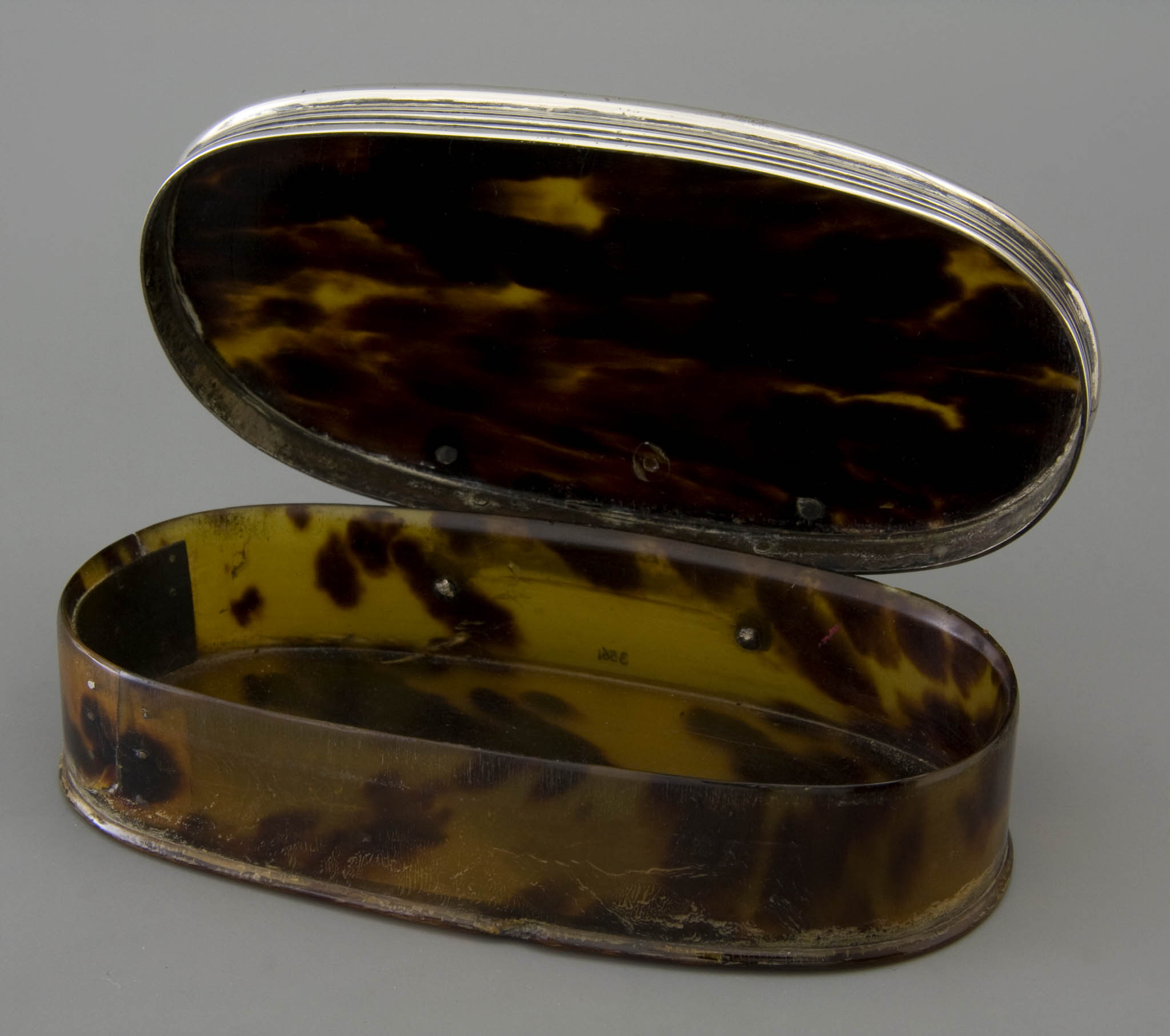
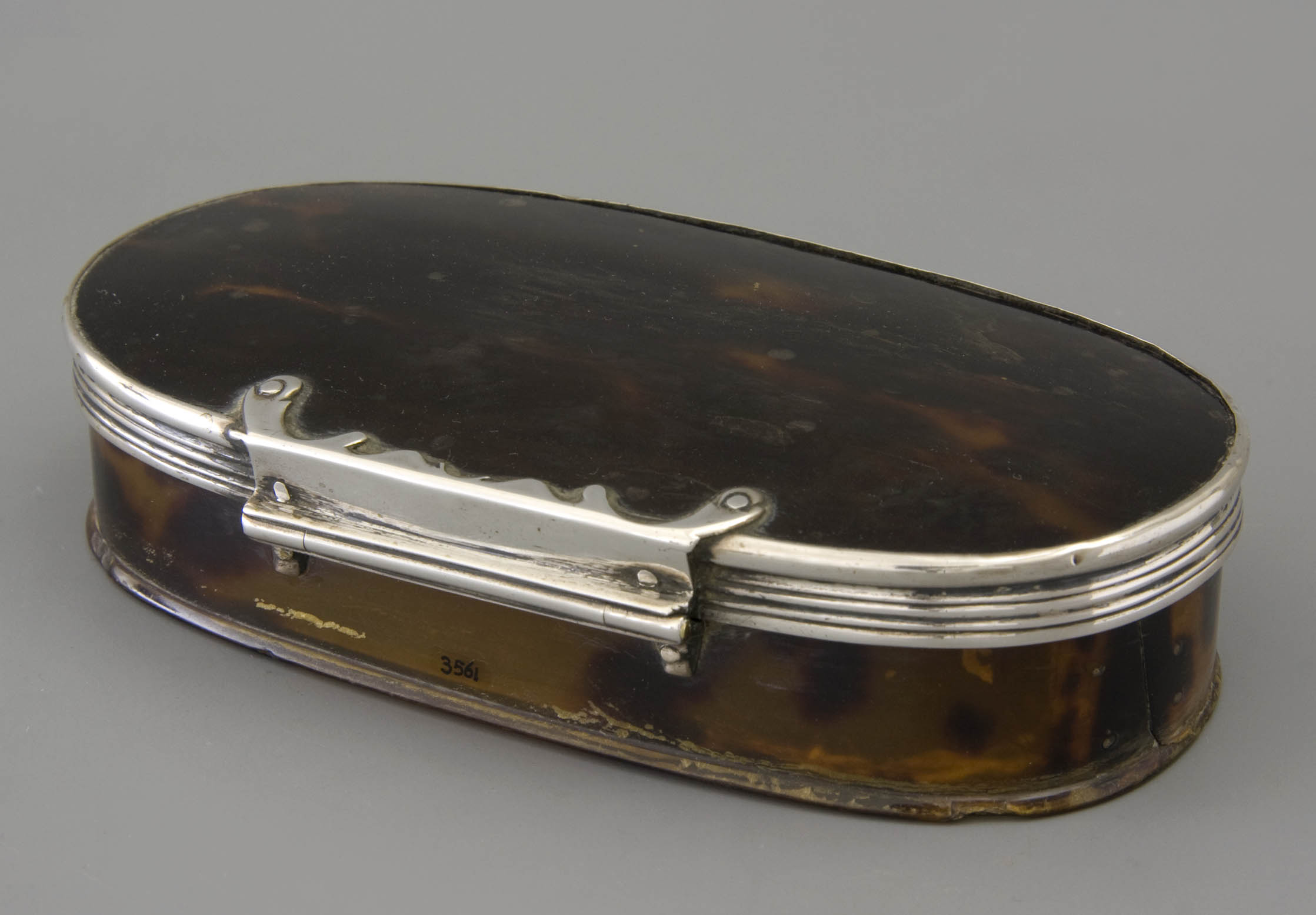
In the eighteenth century, numerous other materials were favoured alongside the copper and brass tobacco boxes. The decisive factor is that in that century the higher circles exchanged the pipes for the use of snuff. The greed was there focused on the snuff box, which has a substantially different appearance than the tobacco box. In addition, the silver tobacco box remained in production for the rich, which has a lot in common with the copper box in terms of form and decoration, although the execution is more luxurious and less serial. Also tortoise continues, such as a lens-shaped box with polished turtle in silver mounting (Fig. 7). The model of this box dates back to the beginning of the eighteenth century, but remained in vogue until about 1750. On the rim, the silver is engraved with a family coat of arms and three small representations. After the third quarter of the eighteenth century, this tortoise box will change to fashion in an oval model (Fig. 8).
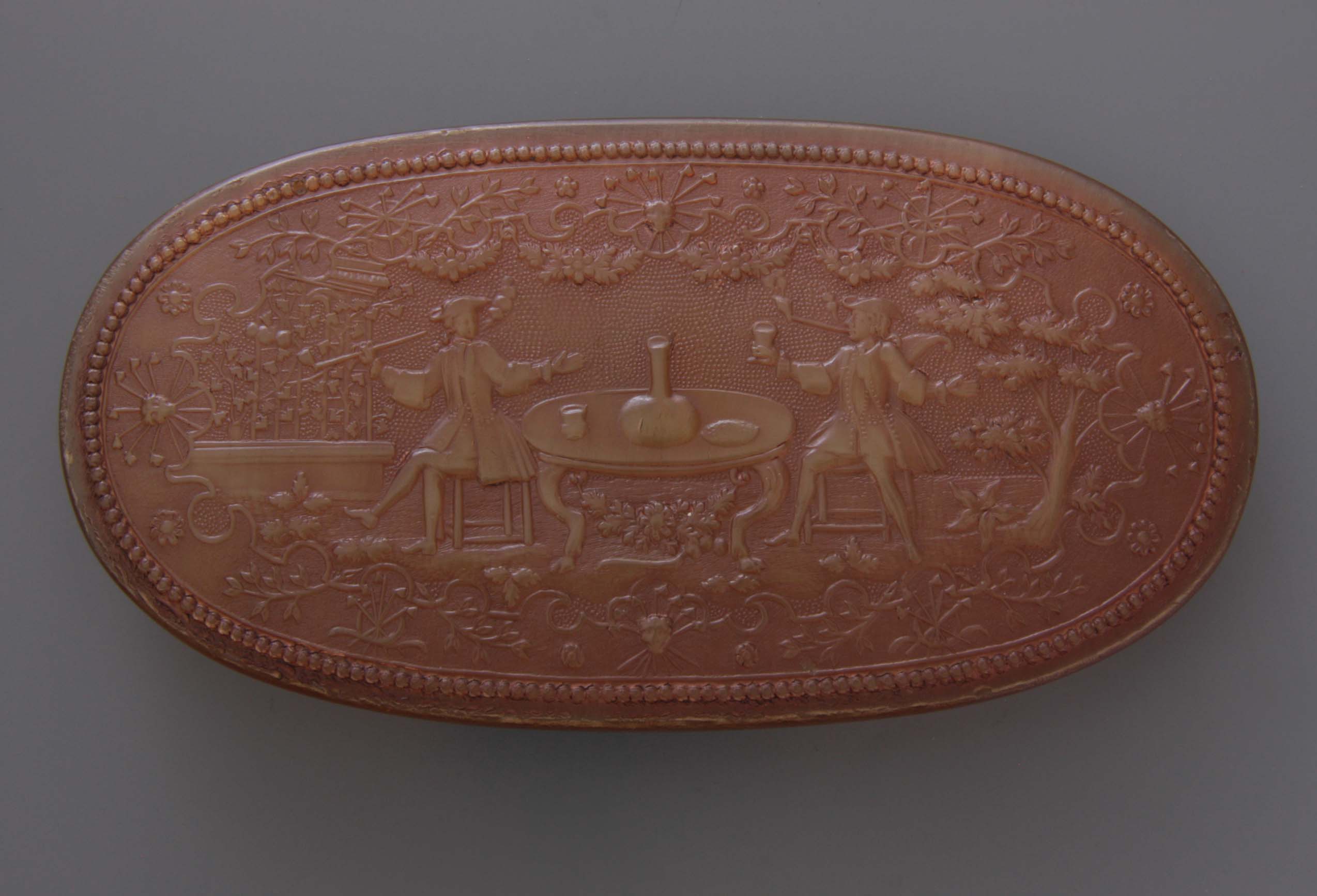
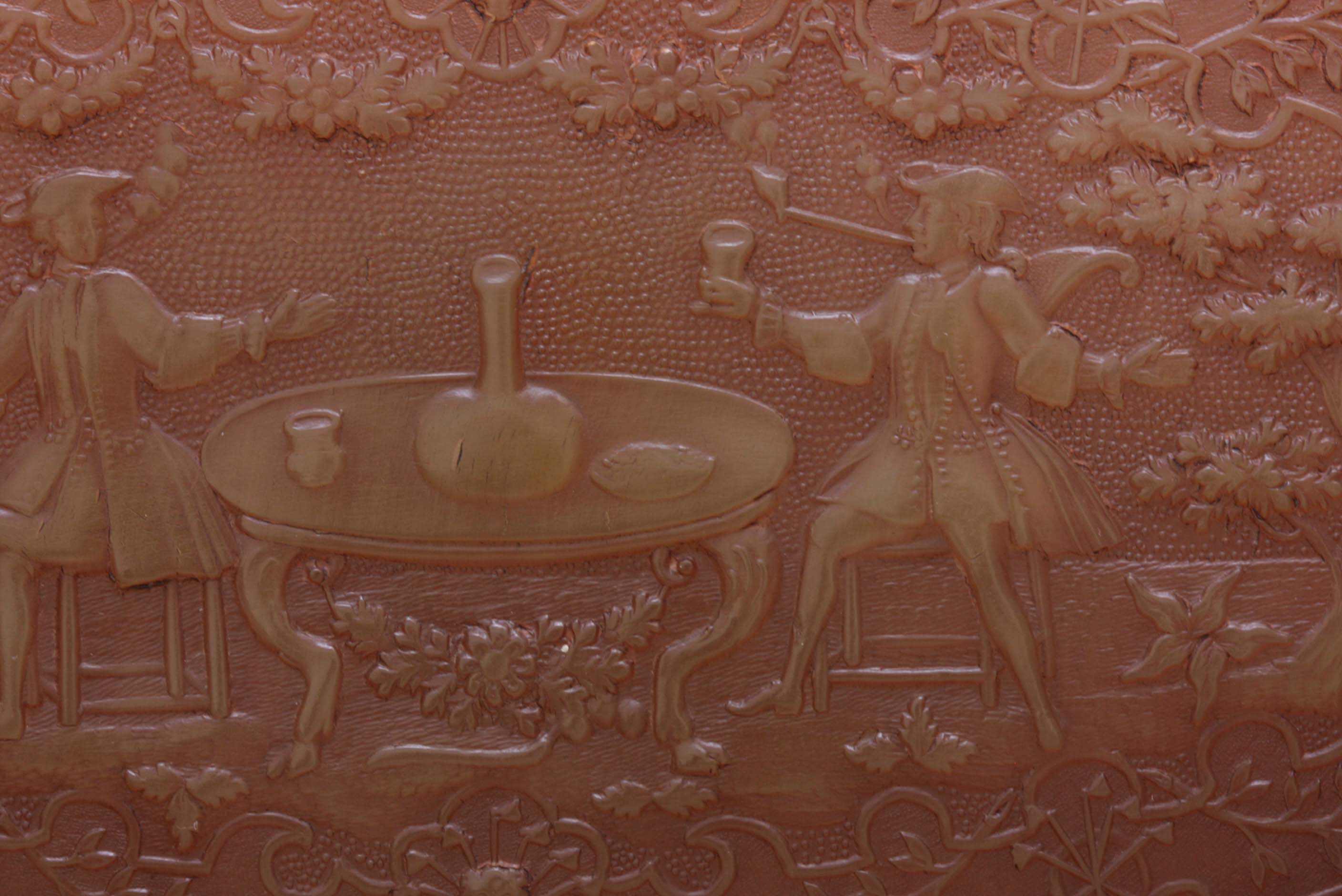
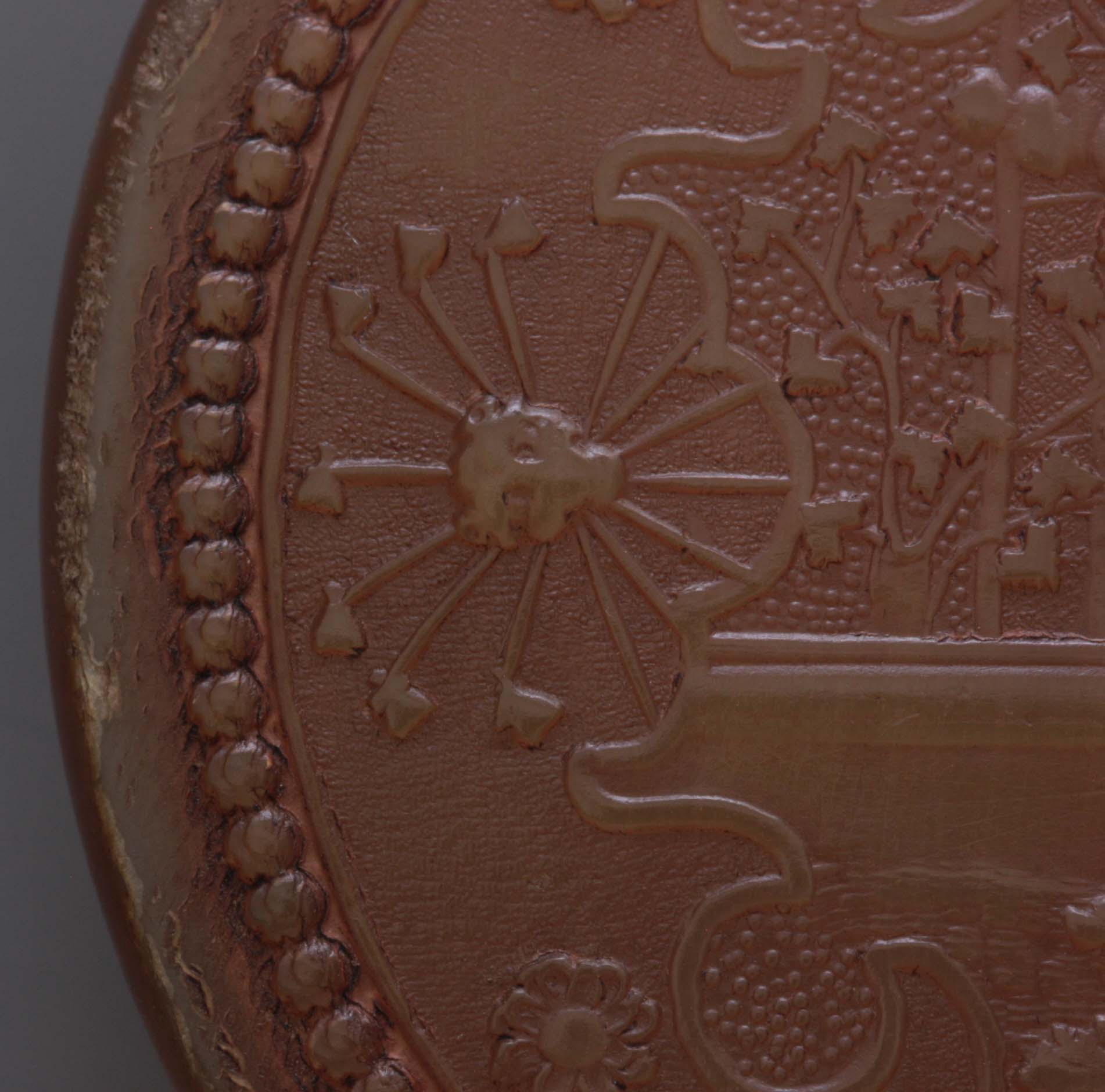
A typical eighteenth century product is the tobacco box made of pressed buffalo horn or whale baleen. This technique was developed in England at the end of the seventeenth century and has been quite common there. In the Seven Provinces this is only used much later for tobacco boxes. The horn or whalebone is embossed on a heated metal plate, and thanks to its toughness, such boxes are pretty durable. One type of box was made in large series and is oval in shape, rather flat with a slightly curved bottom and lid (Fig. 9). The relief work is only applied to the lid. Particularly known are two smoking gentlemen at an oval table, framed by vineyard vines in which four times bunches of tobacco pipes. There is also a beautifully executed harbor view with Dutch ships.
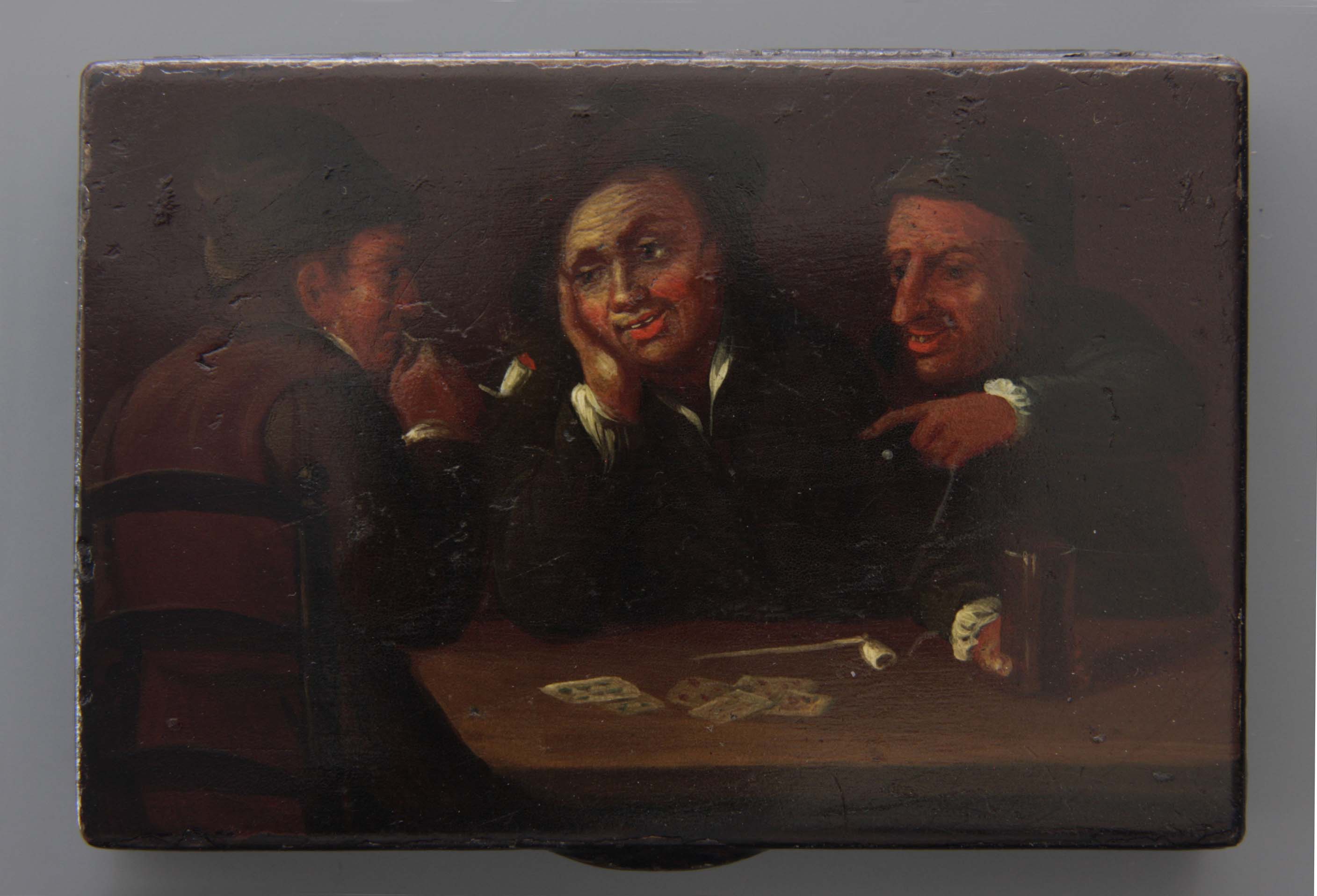
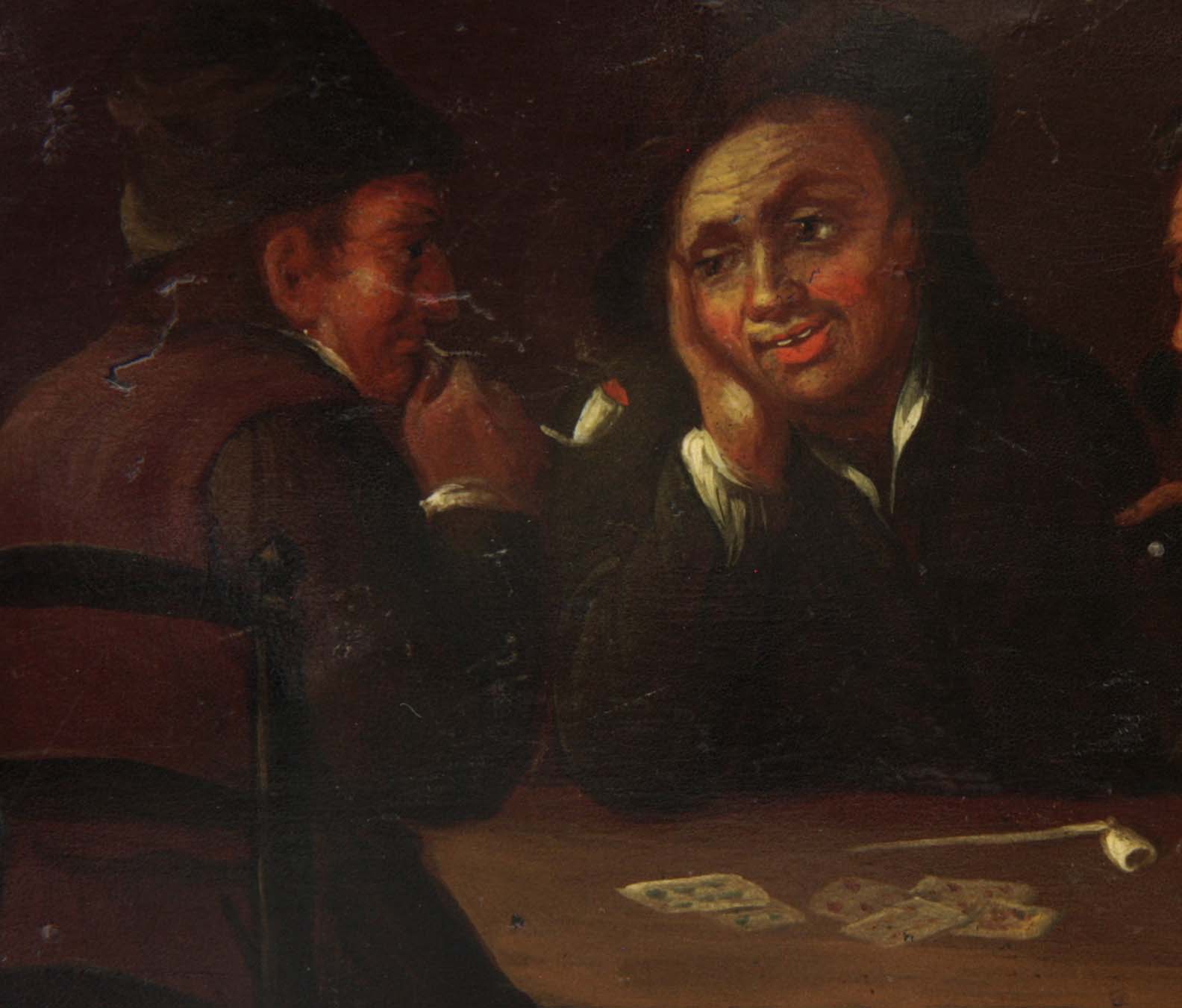
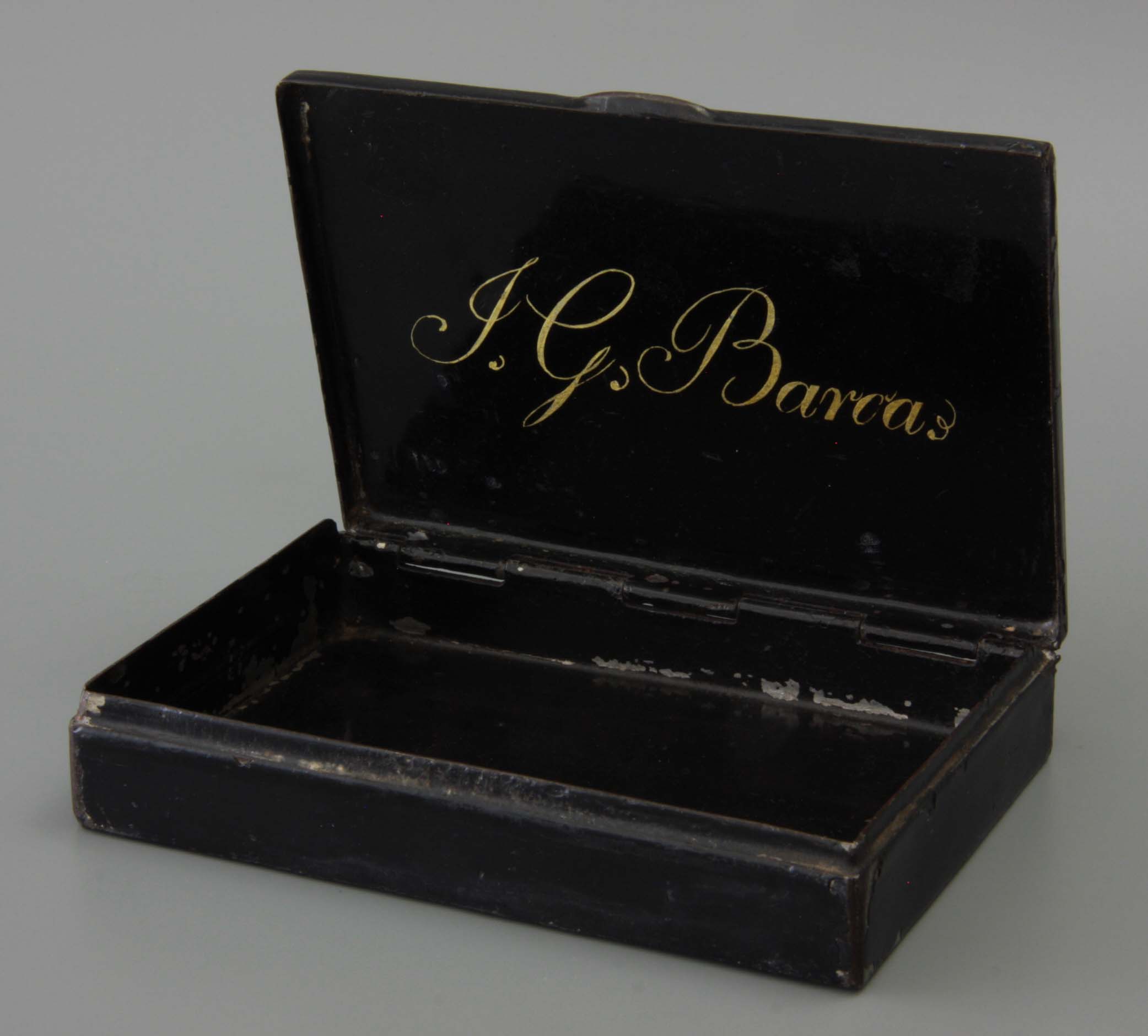
At the end of the eighteenth century, a new material came on the market: the tobacco box covered with skate-skins. This box type is also of a temporary nature and is primarily a showcase because it is fairly heavy-duty, while the leathery fish skin on the outside is vulnerable. Another fashion phenomenon is the painted tin tobacco box that becomes a formidable competitor for the copper tobacco box. This German tin box originated around 1790 after Georg Heinrich Stobwasser, together with his son Johann Heinrich, founded a factory in Braunschweig in 1768 [30]. They succeed in bringing the boxes to the market at a competitive price (Fig. 10). Although significantly less durable, the colourful box becomes a new craze. When in the nineteenth century the painting can be carried out with the help of transfers, the price drops drastically and this box is also accessible to the less mediated smoker.
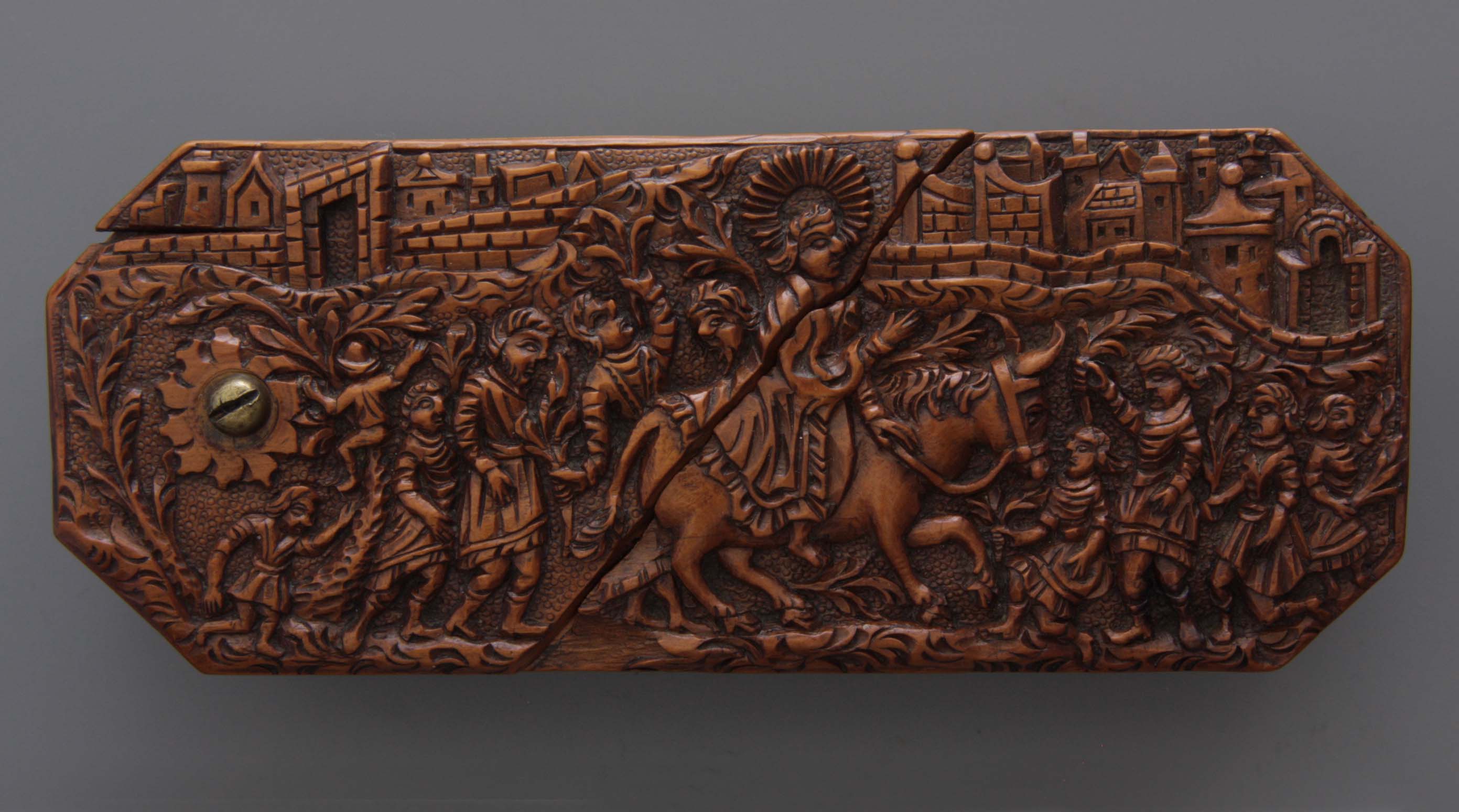
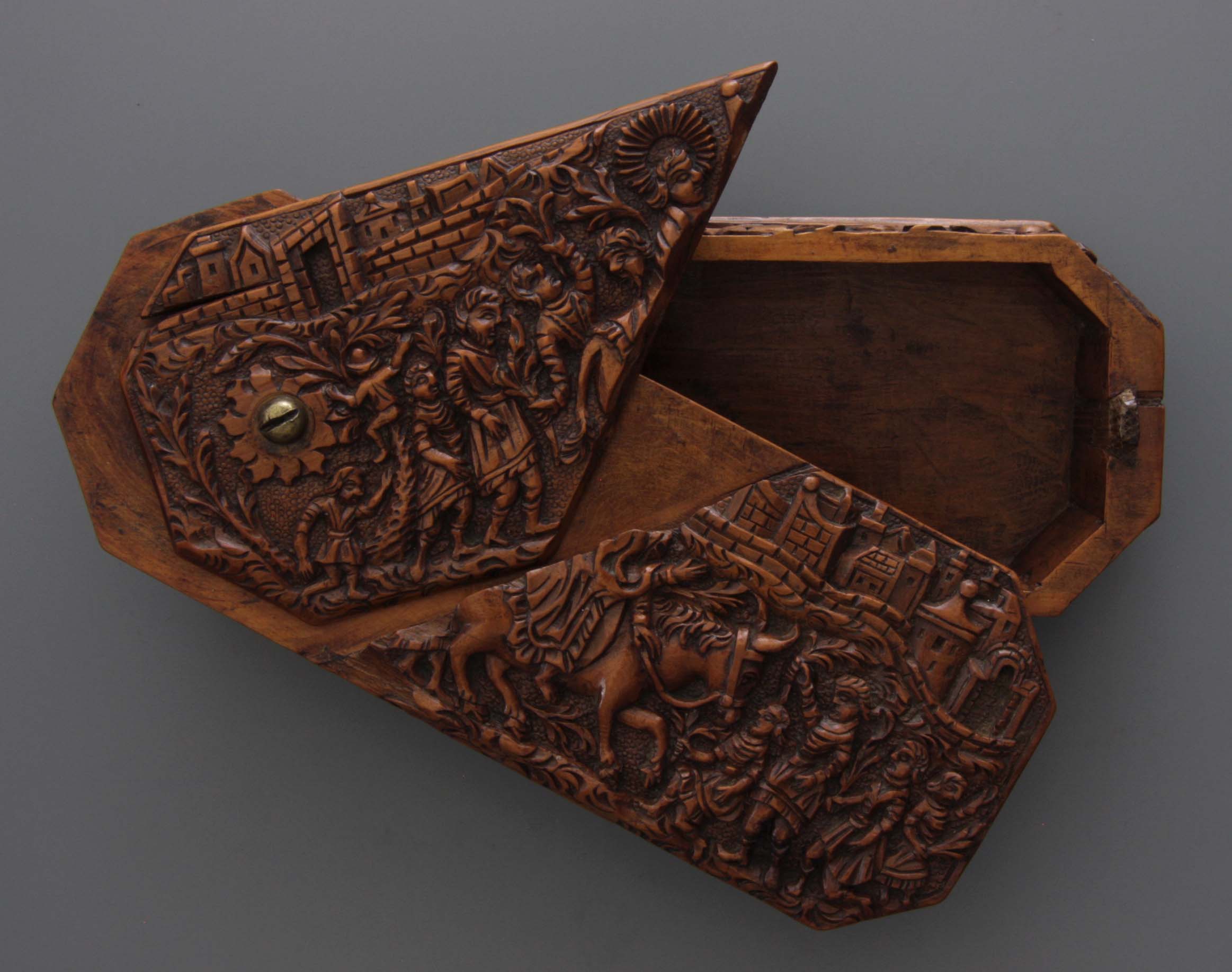
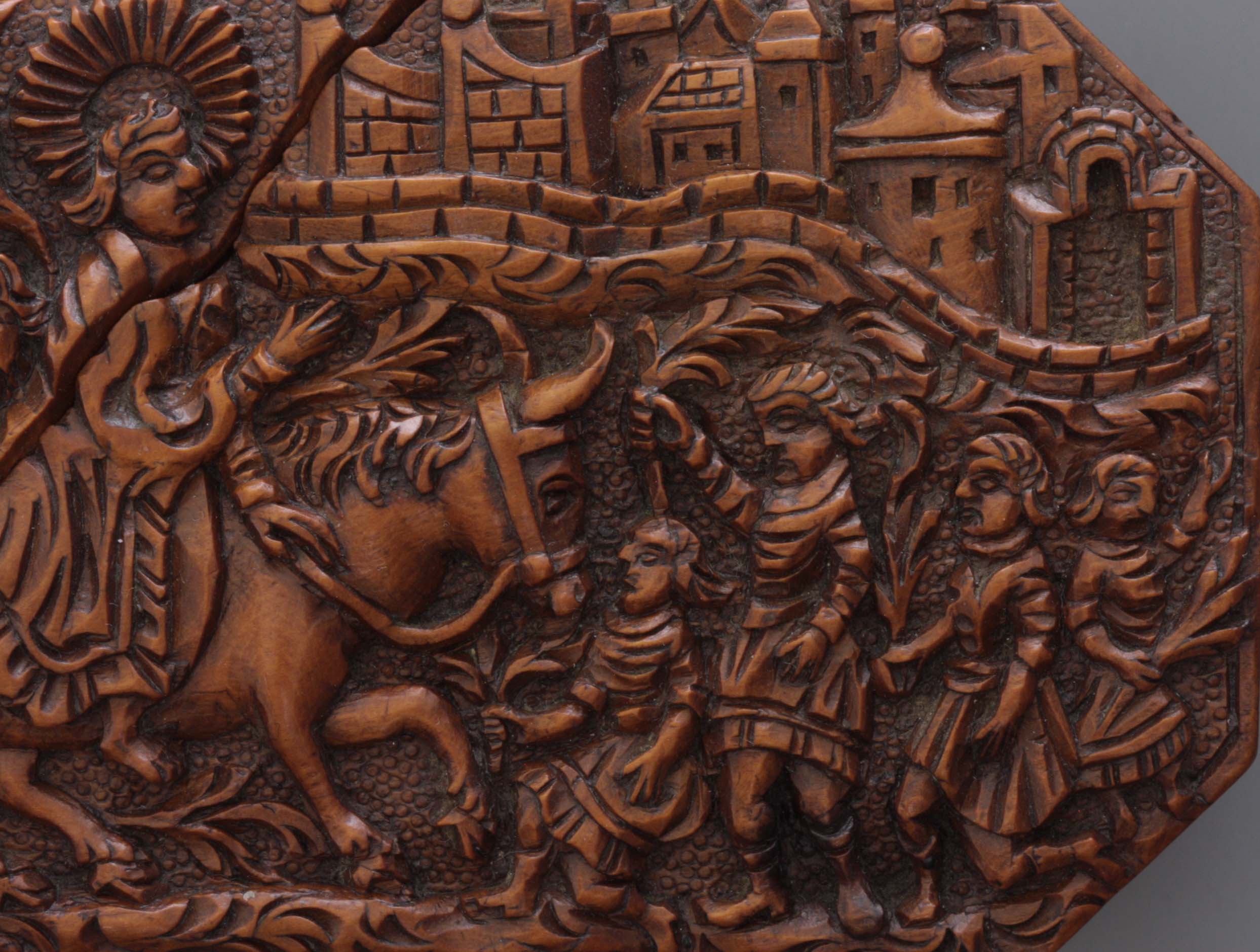
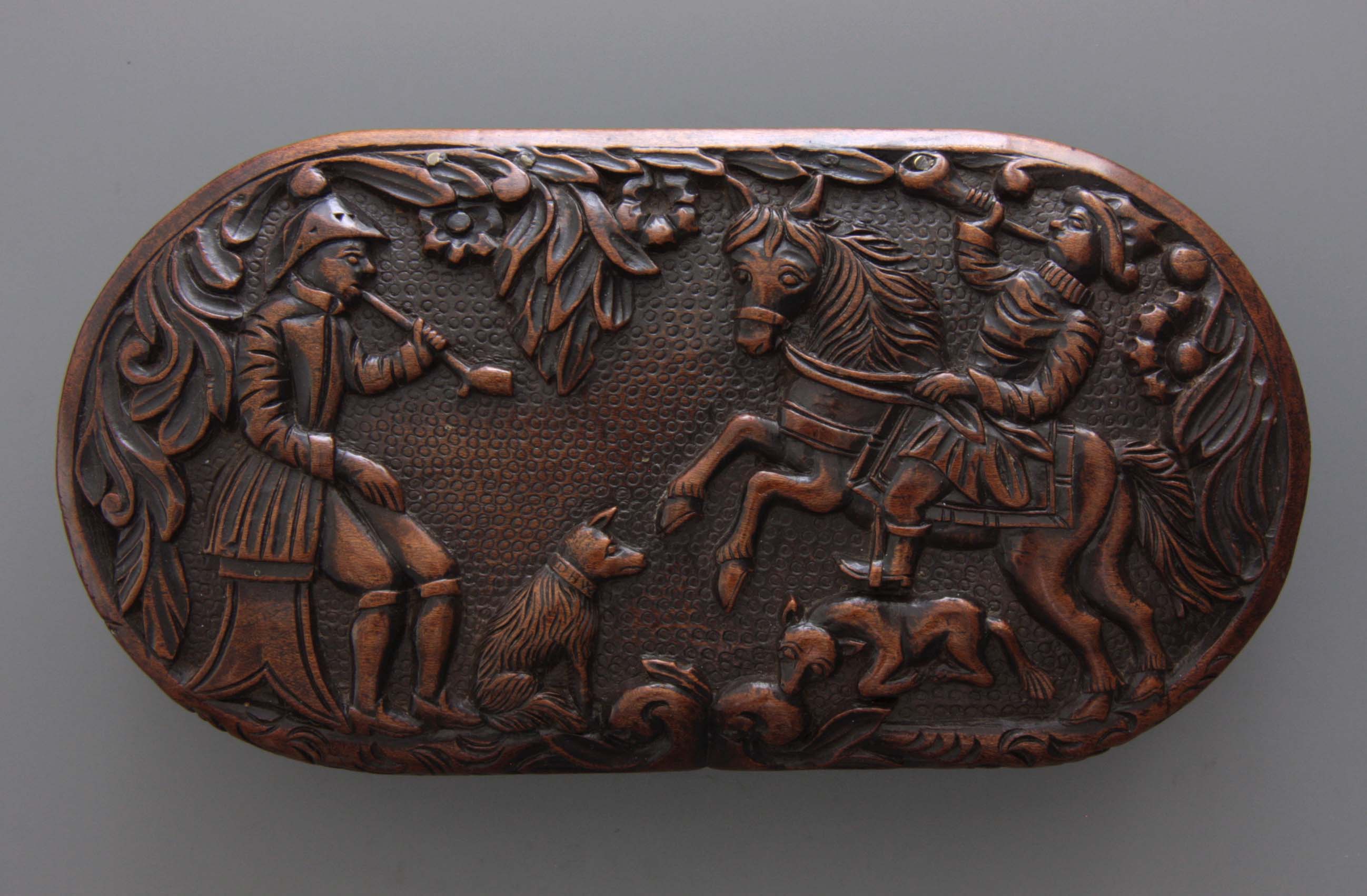
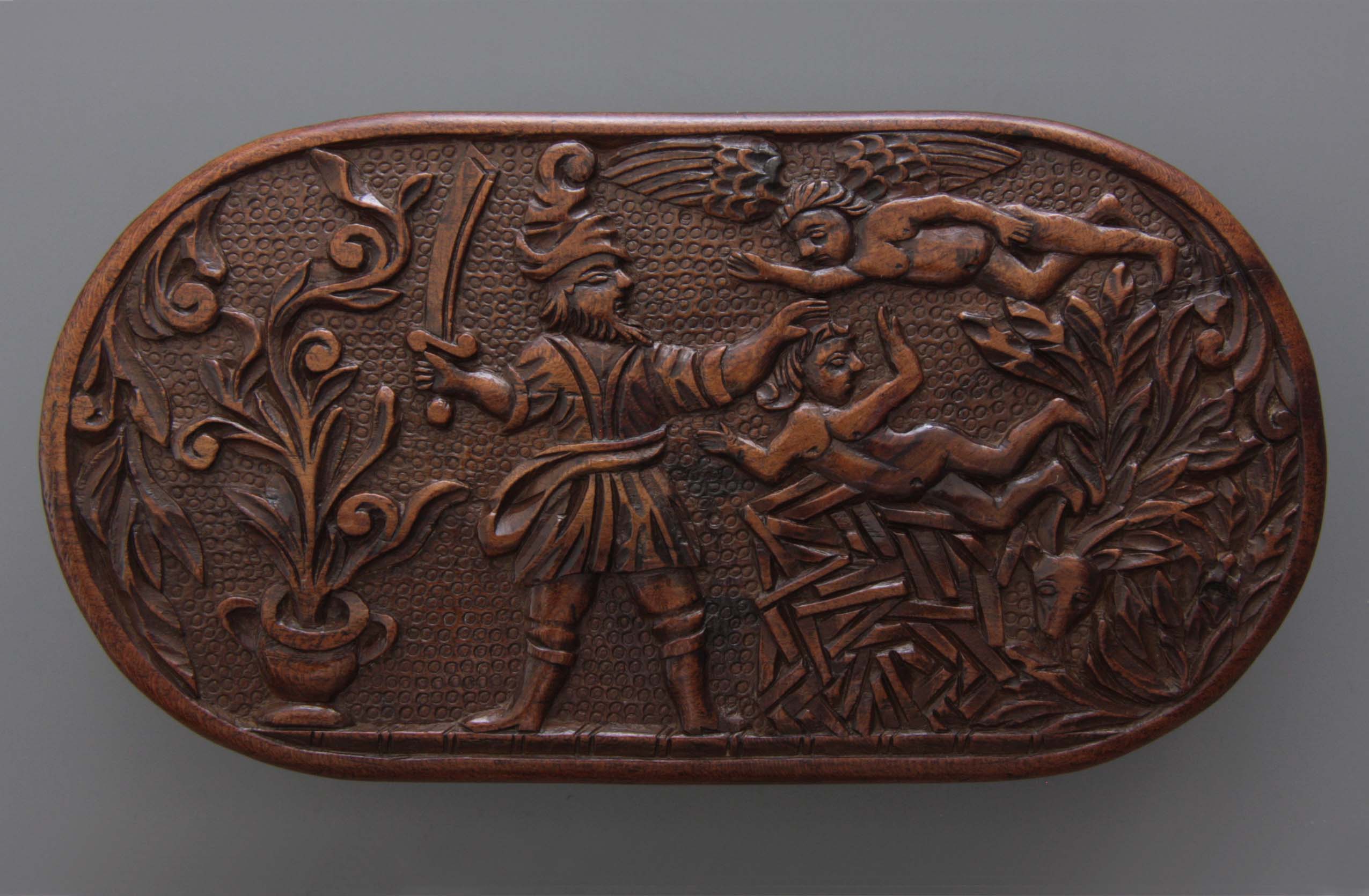
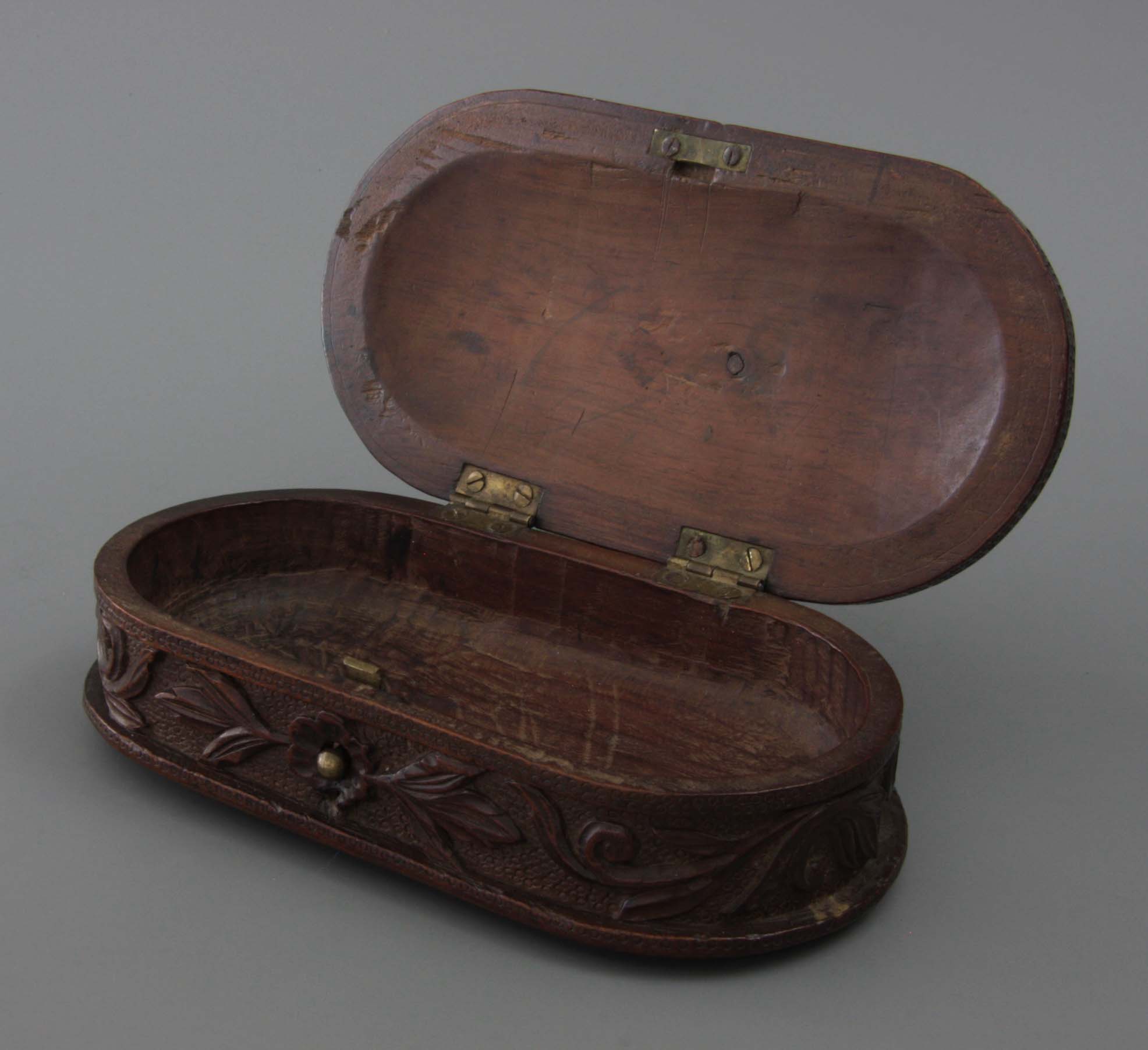
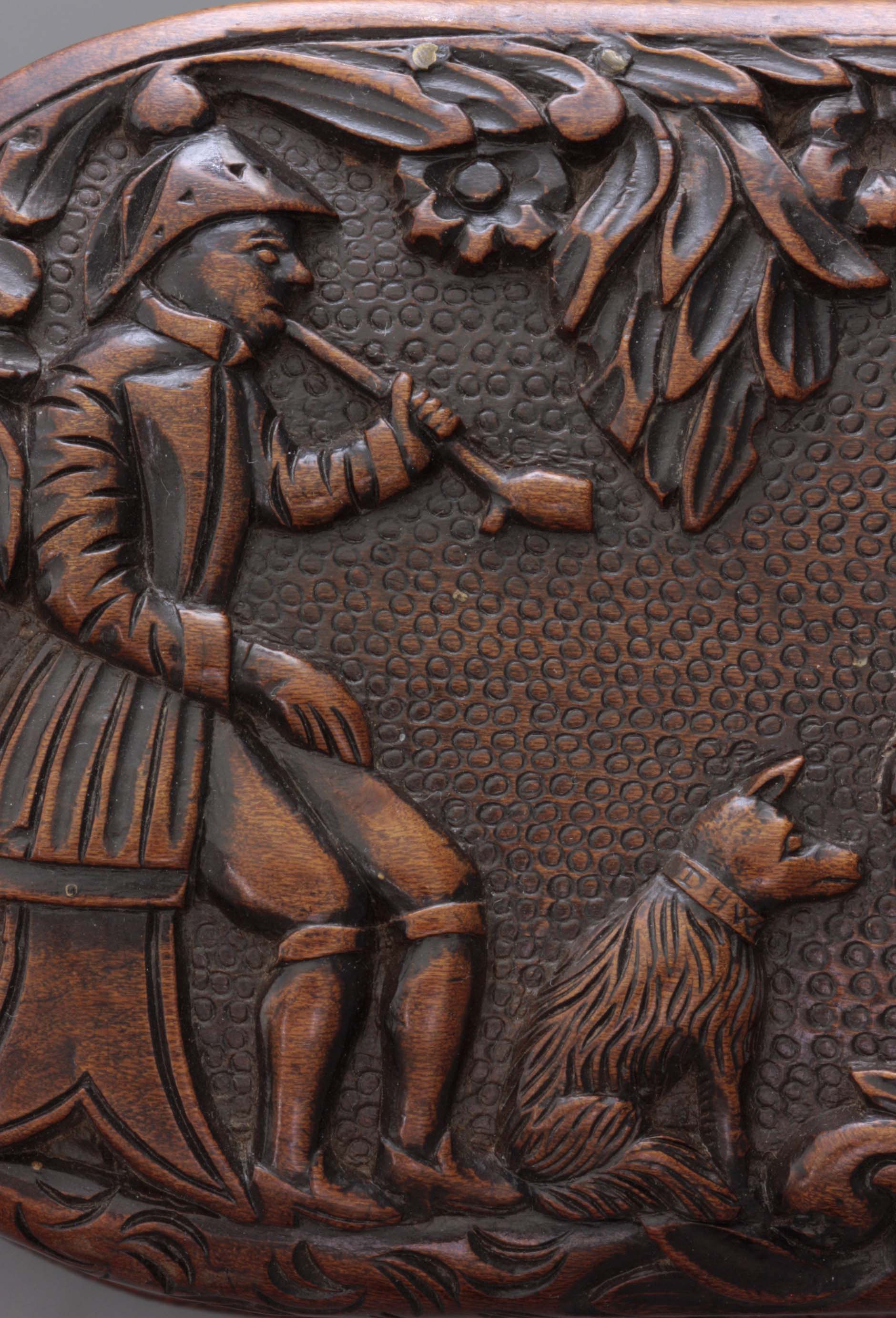
Wood has also been used for tobacco boxes and some folk-art specimens have been beautifully cut. Often the shape follows that of the brass box, but the decoration scheme is more strongly conceived from the material (Fig. 11). Remarkable about the box shown here is also the secret closure. A later example shows the devastation of the form, while the decoration is also less refined (Fig. 12). An alternative box that comes in the place of the chip box is the leather tobacco box (Fig. 13), a typical Northern Dutch invention. Such boxes are of considerable size and date from the time when the cross-section could still be very coarse.
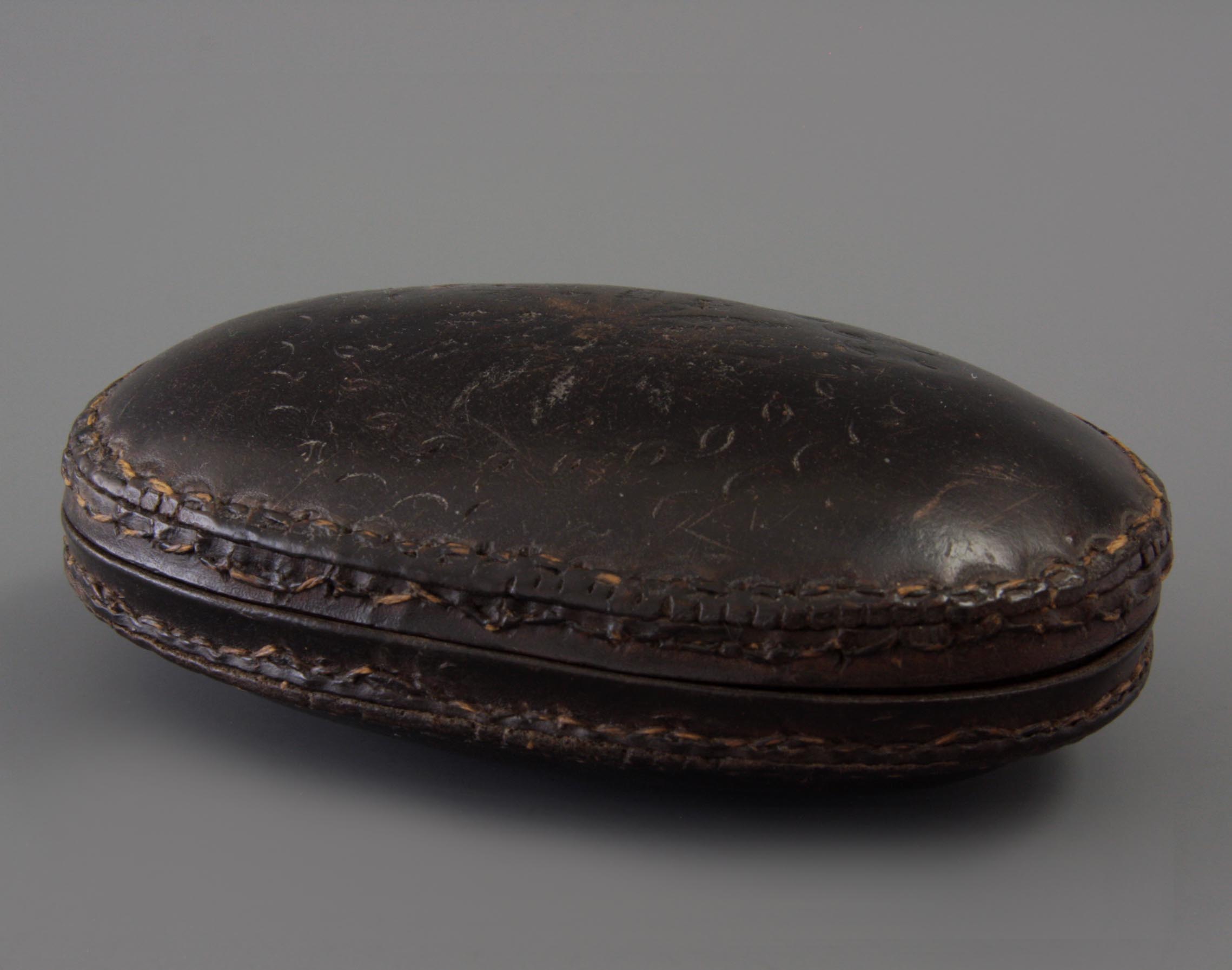
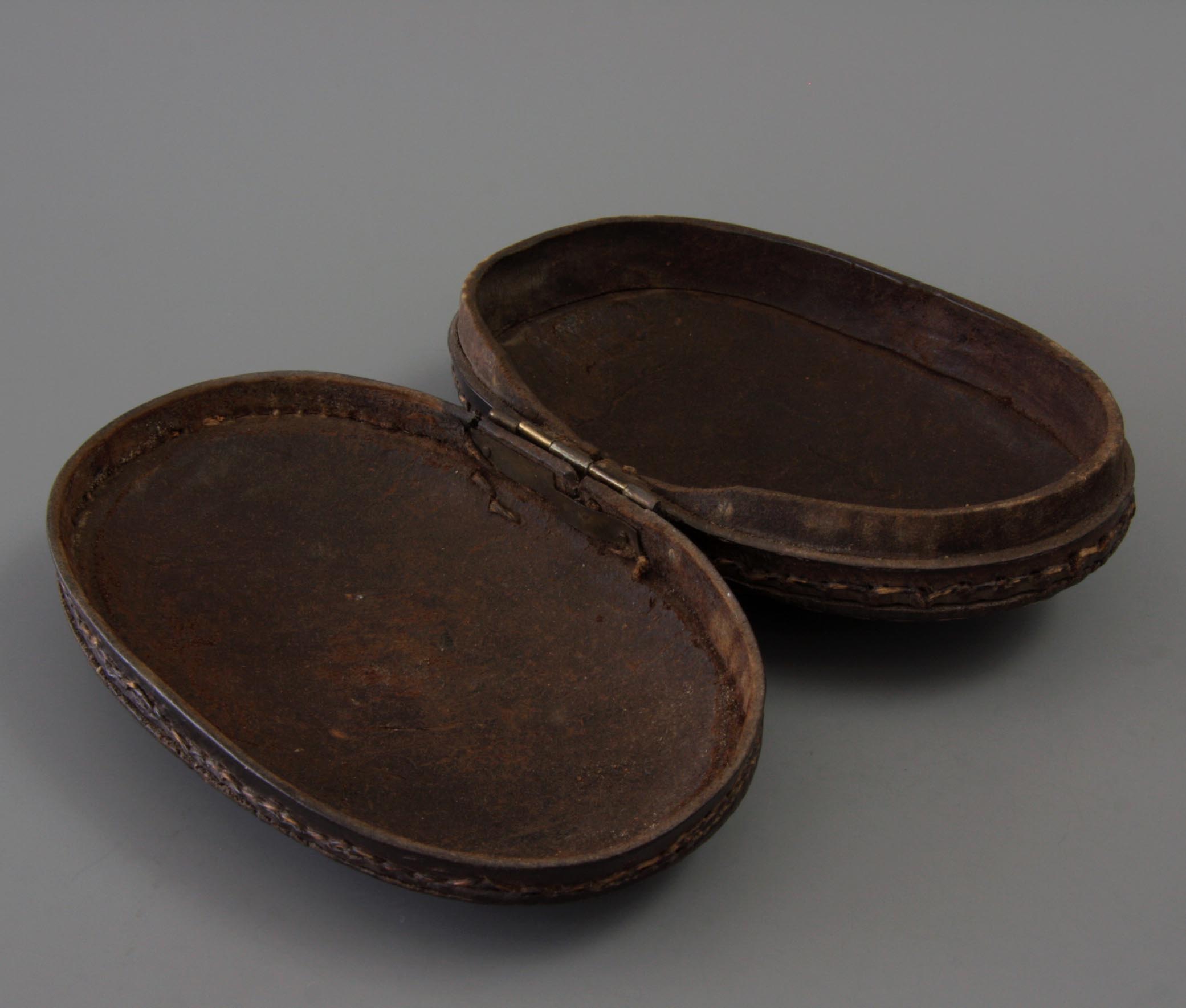
Biedermeier time is expressed in a new phenomenon. The tobacco box made of hard materials makes way for the pouch of leather or textile, lined internally with chamois leather against the drying out of the contents. Such tobacco pouches are sometimes exuberantly emblazoned with embroidery or embroidered beadwork so that their appearance is often somewhat feminine. They form the gradual transition to the tobacco set that will be characteristic of the twentieth century and that represses the tobacco box of hard material. Naturally, this is also related to the arrival of the aromatic tobacco sticks that are stronger in fiber and less likely to crush.
It is striking that many tobacco boxes from alternative materials show a similar development in terms of shape. They often show the same fashion characteristics as the brass tobacco box, although the running time is usually relatively short. The vulnerability of organic materials or painted tin is the reason that they quickly disappear from the market. In doing so, they underline the importance of brass and copper compared to the alternative materials.
The tradition summarized in more detail
It is clear that the Dutch brass or copper tobacco box from 1620 until well into the nineteenth century was a general article that has been used gratefully by many smokers. After a first generation of mostly singles, a fixed concept is created. The model line of the Dutch tobacco box is quickly determined by the tobacco box made in series and produced at increasingly large numbers. From 1650 the market offers a wide range, although little is left of this. The development of the tobacco box takes us through countless changes in the shape, the technique and in the closure of the box. From 1660 the decoration is focused on engraving, while brass becomes the main material. By the end of the seventeenth century, the form and the decoration method were standardized.
In the eighteenth century the tobacco box is characterized by large similarities, in which small developments succeed each other. The shapes can be placed well in time and brass is often combined with copper to create a wider range of products. The engraving work strongly determines the appearance of the tobacco box and is applied from simple and sketchy to minutely and artistically justified. The choice of subject remains limited, although there is always a considerable variation. By the year 1800 the importance of the tobacco box is gradually decreasing and not surprisingly we see hardly any development in the nineteenth century. Production continues to slim down.
Unfortunately, we are not really well informed about the social use, fashion, price and status of the tobacco box. That subject is not easy to explore because there are hardly any sources. This also means that attribution to makers or even production sites is virtually impossible. By incorporating the discussion of the competing materials in this article, the development and use of the tobacco box is placed in a more general context. It proves the importance of brass and copper box as a source of inspiration, but especially as a mainstream within a popular consumer product.
It is clear that the tobacco box of brass or copper as a use and status article has been a generally accepted object with a wide spread. The object is closely related to tobacco use and the smoker and that makes the tobacco box a prominent place in the cultural history of smoking. In addition, the imaginary world is varied and tells us the stories that were popular in past centuries.
© Don Duco, Pijpenkabinet Foundation, Amsterdam – the Netherlands, 2012.
Catalogue
Box 1 Email cloisonné
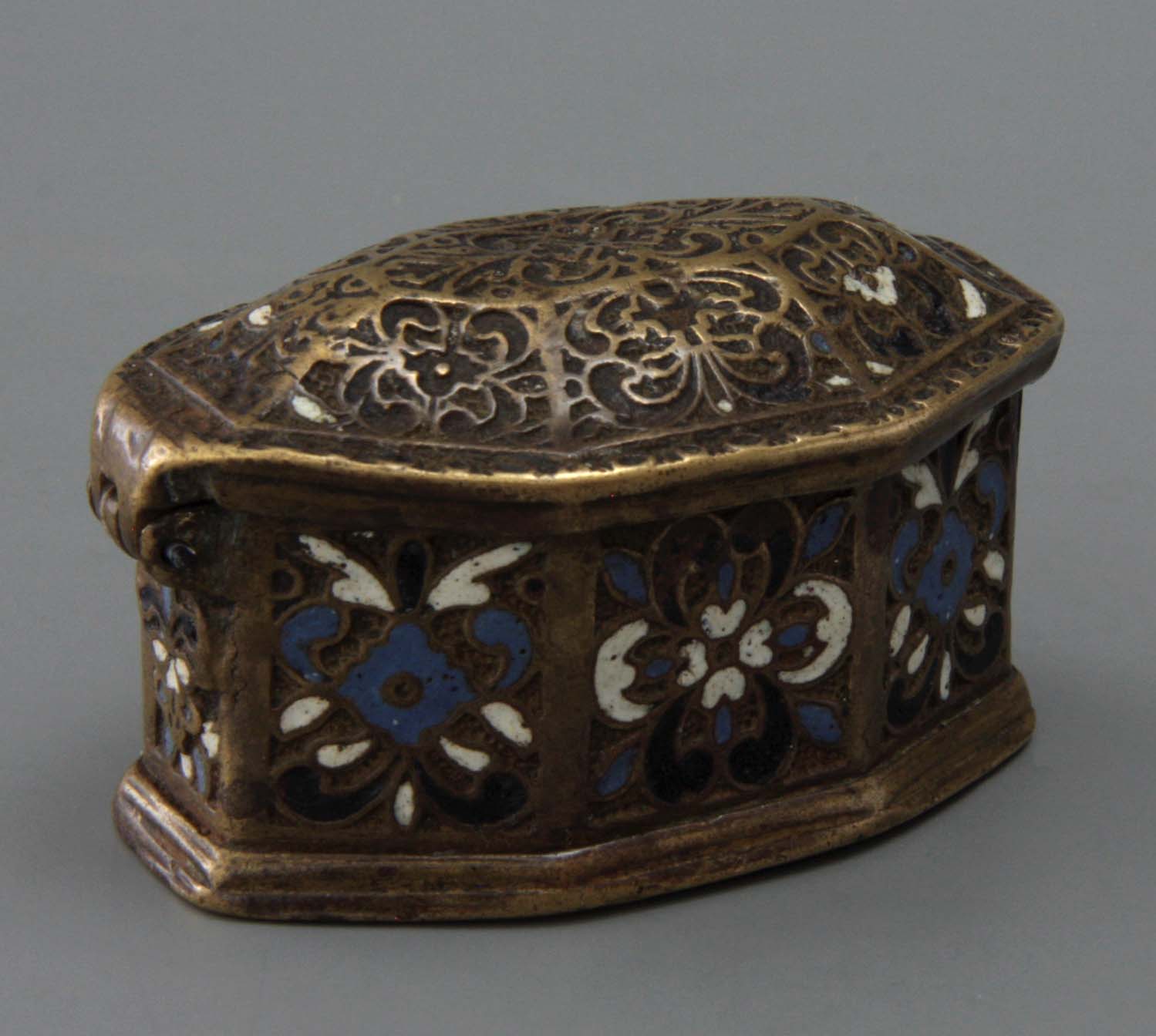
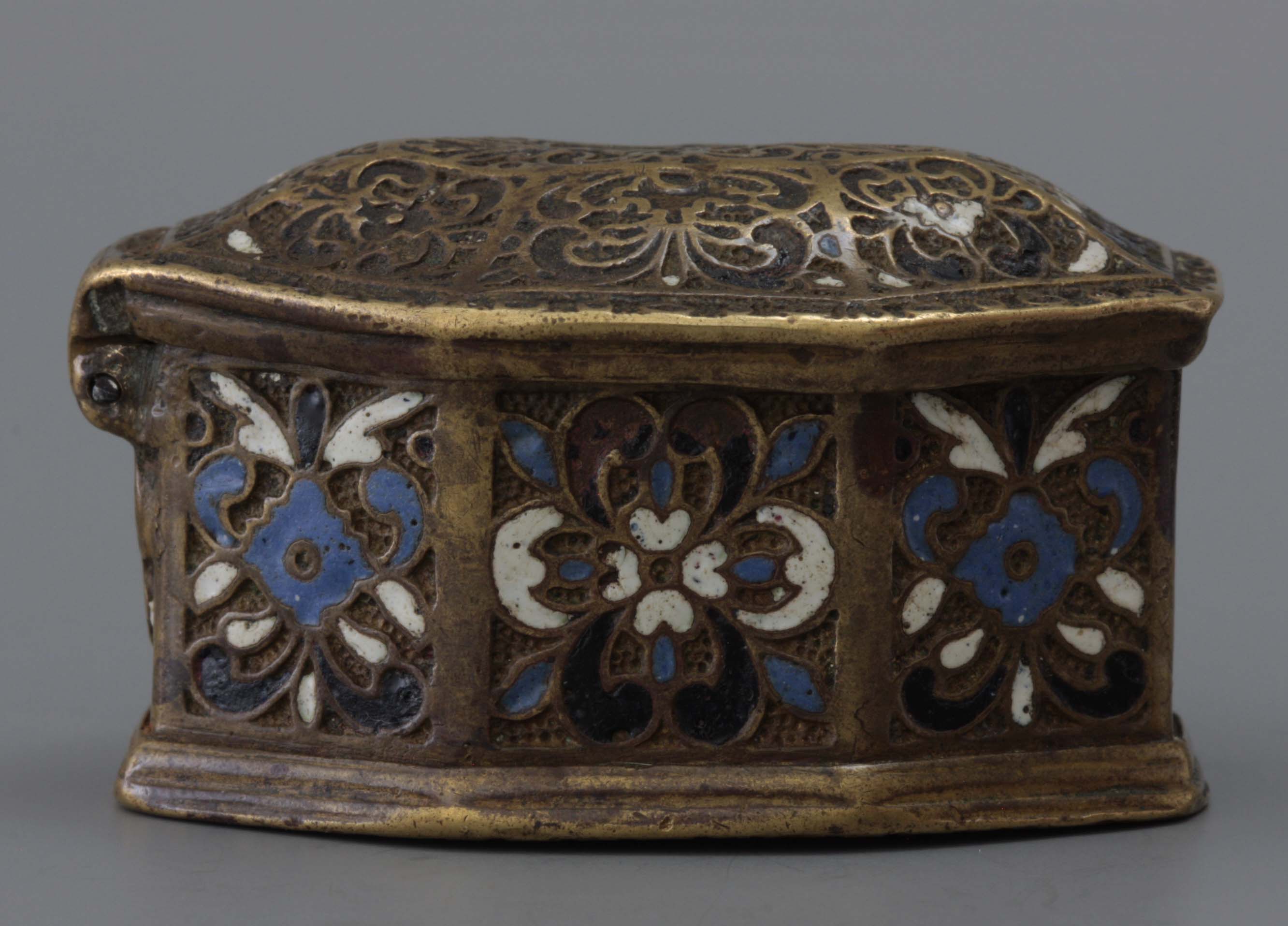
Description: Click here.
Comment: Earliest known tobacco box with clear renaissance characteristics. The chic appearance of this box underlines the appearance of the tobacco in the higher social circles. Technically, it is a skilful piece of craftsmanship made by a metal; worker who used to make totally different objects. The upright wall of the box is curved out of a single piece of sheet metal, the folding edges are first filed on the inside to get the correct sharpness of the corners and to prevent tearing of the brass. Finally, the outstretched decoration has been filled in with an email.
Date: 1610-1625
Collection: Amsterdam, Pijpenkabinet Collections Pk 20.711
Box 2 Sacrifice from Abraham
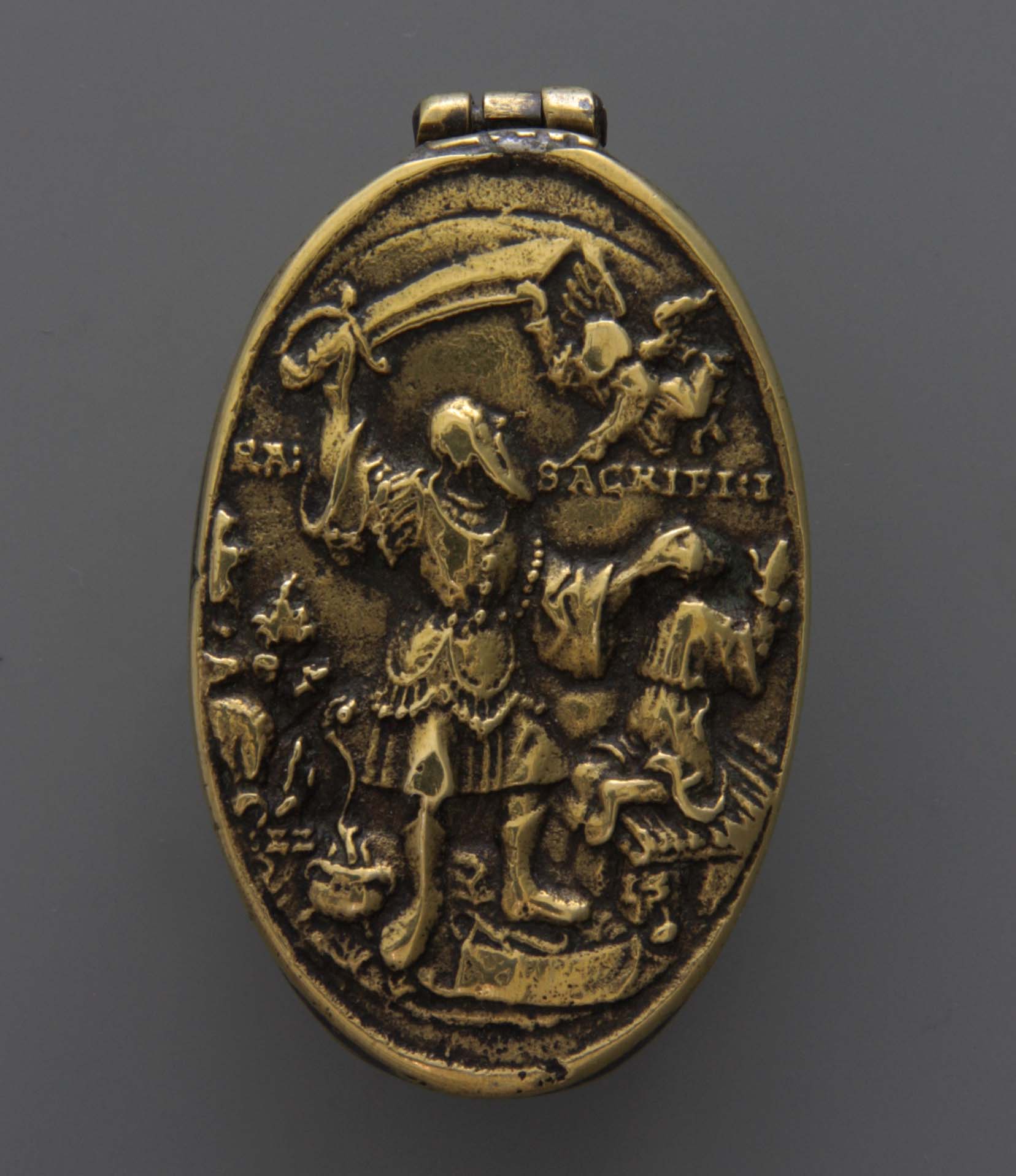
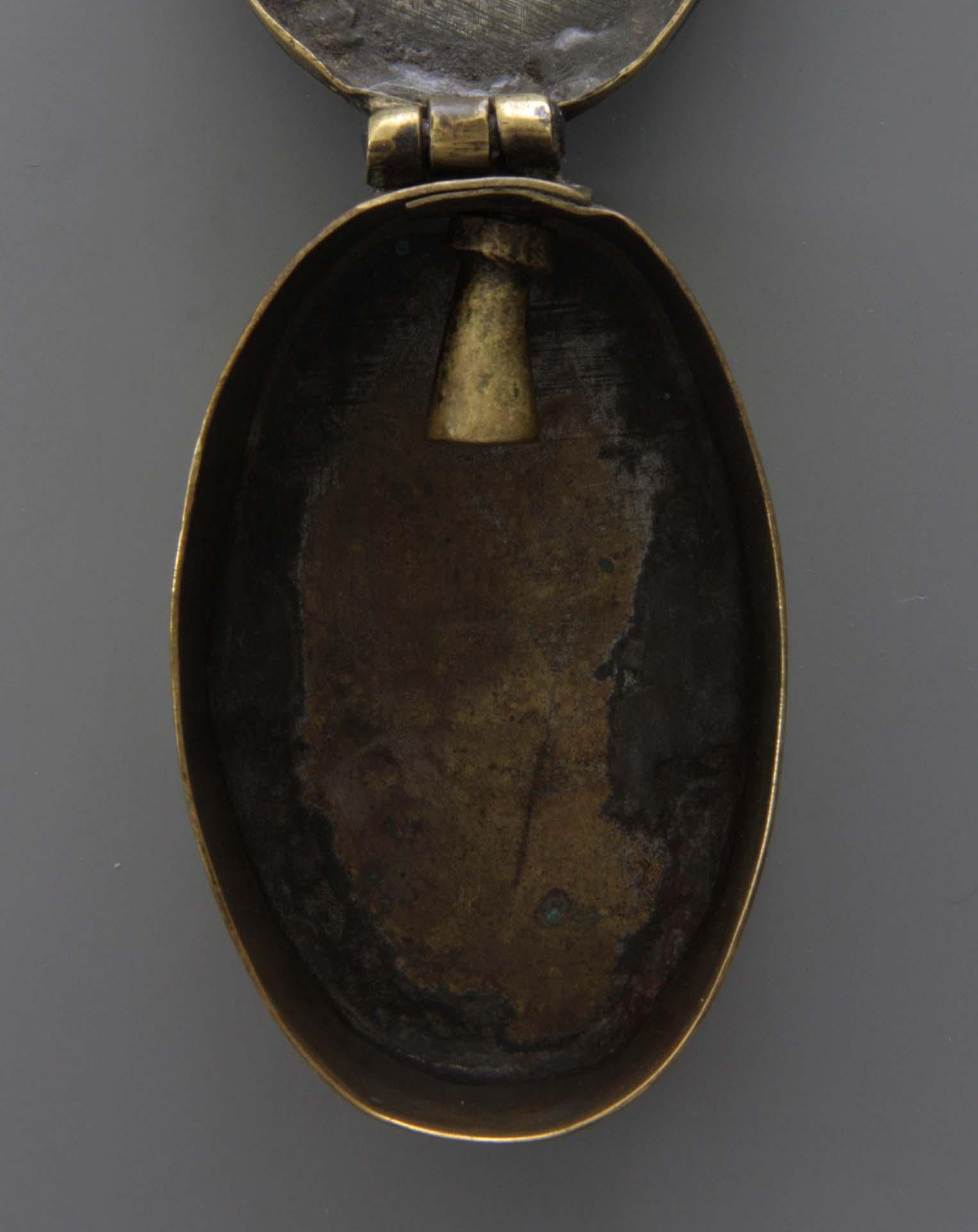
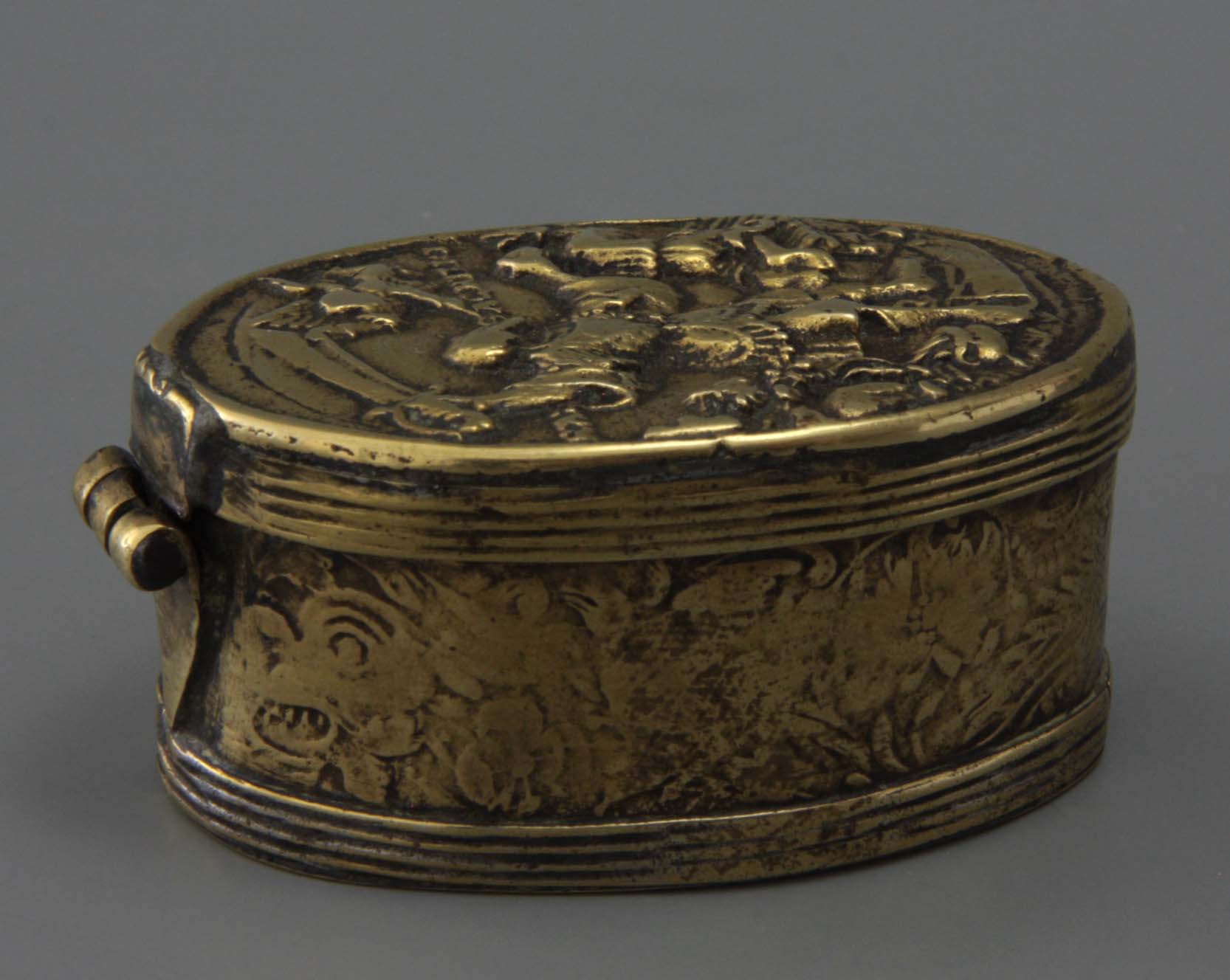
Description: Click here.
Comment: A beautiful and well-kept tobacco box clearly made in series. The printed upright wall is the first proof of this, the mould for the lid is the second. The inscription "RA" stands for Rex Abraham, the "I" for Isaac, the initials below refer to the maker "ZZ" probably working in "IS" (Iserlohn). Another reading than the maker monogram is that the numbers 22 are meant that indicate the date 1622.
Origin: Iserlohn
Date: 1625-1635
Collection: Amsterdam, Pijpenkabinet Collections Pk 20.712
Box 3 Appliqué with royal portrait
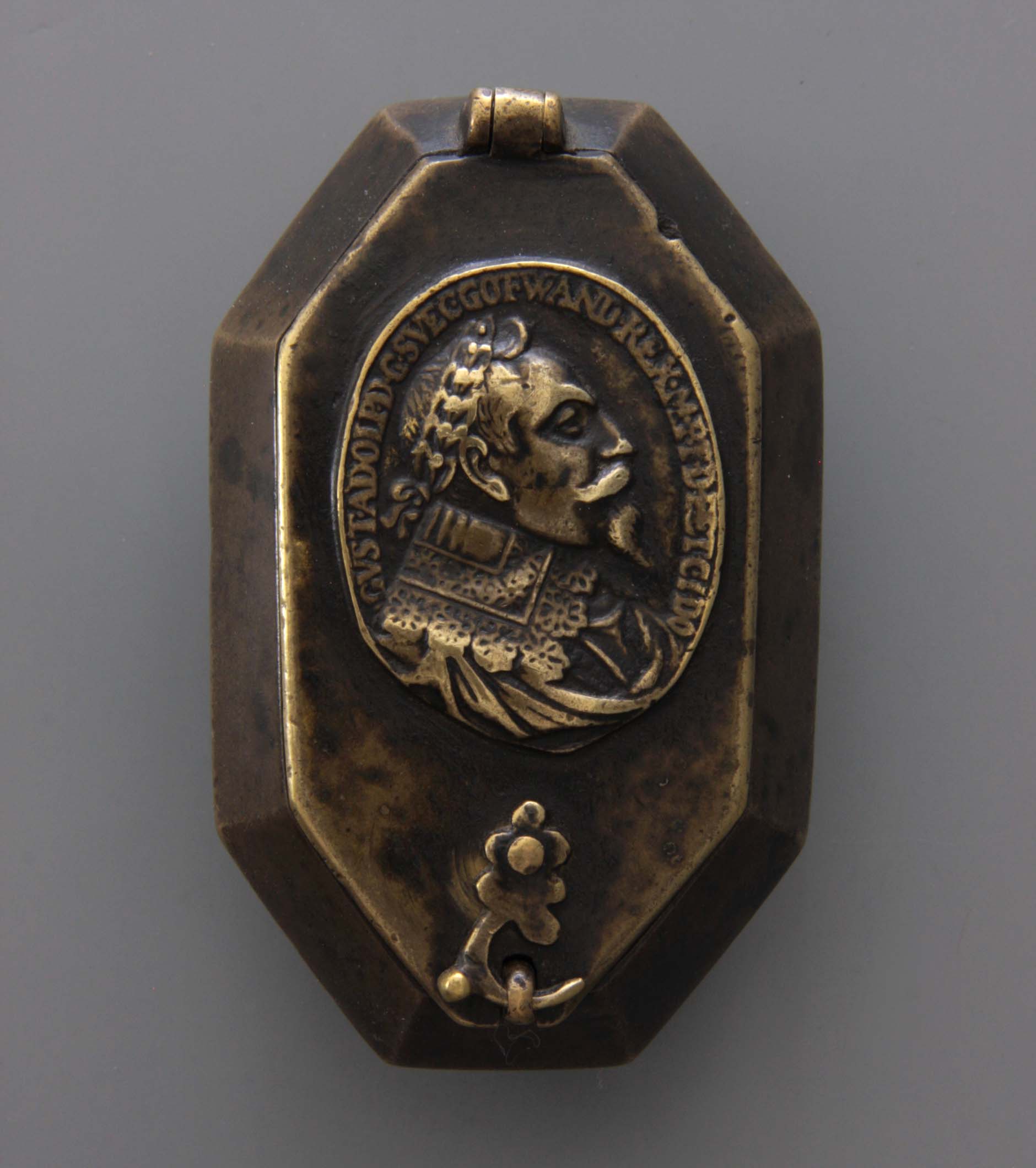
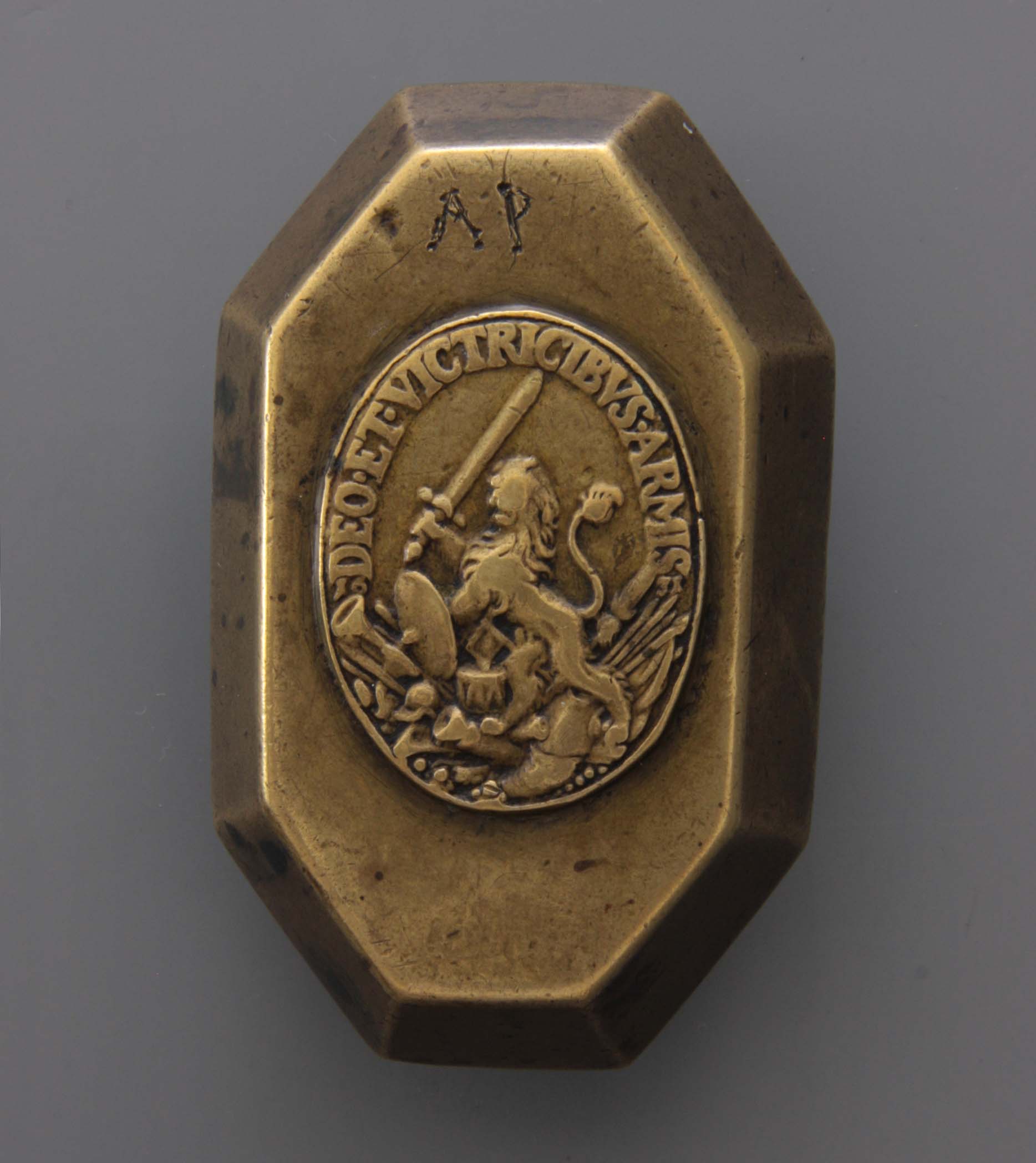
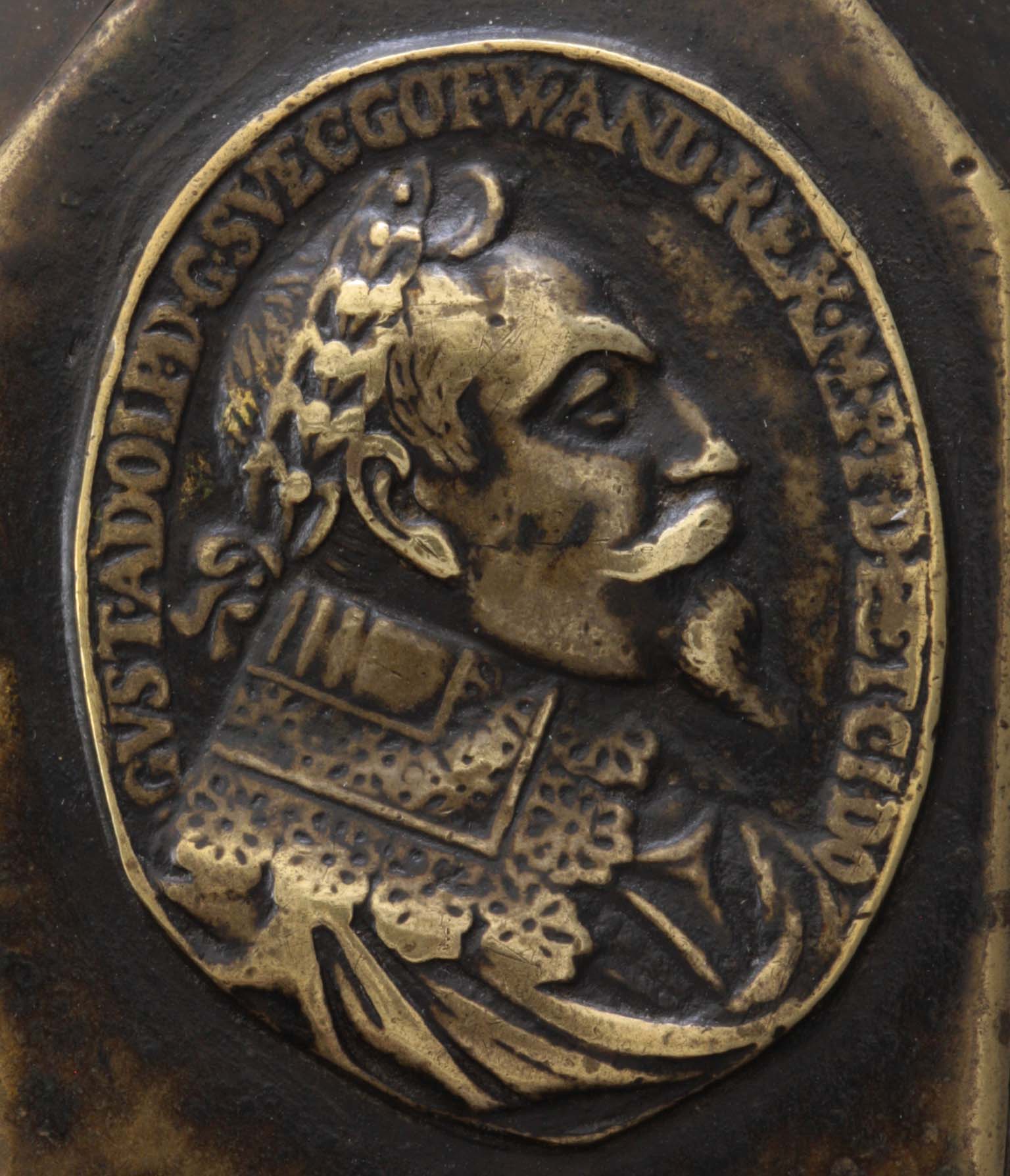
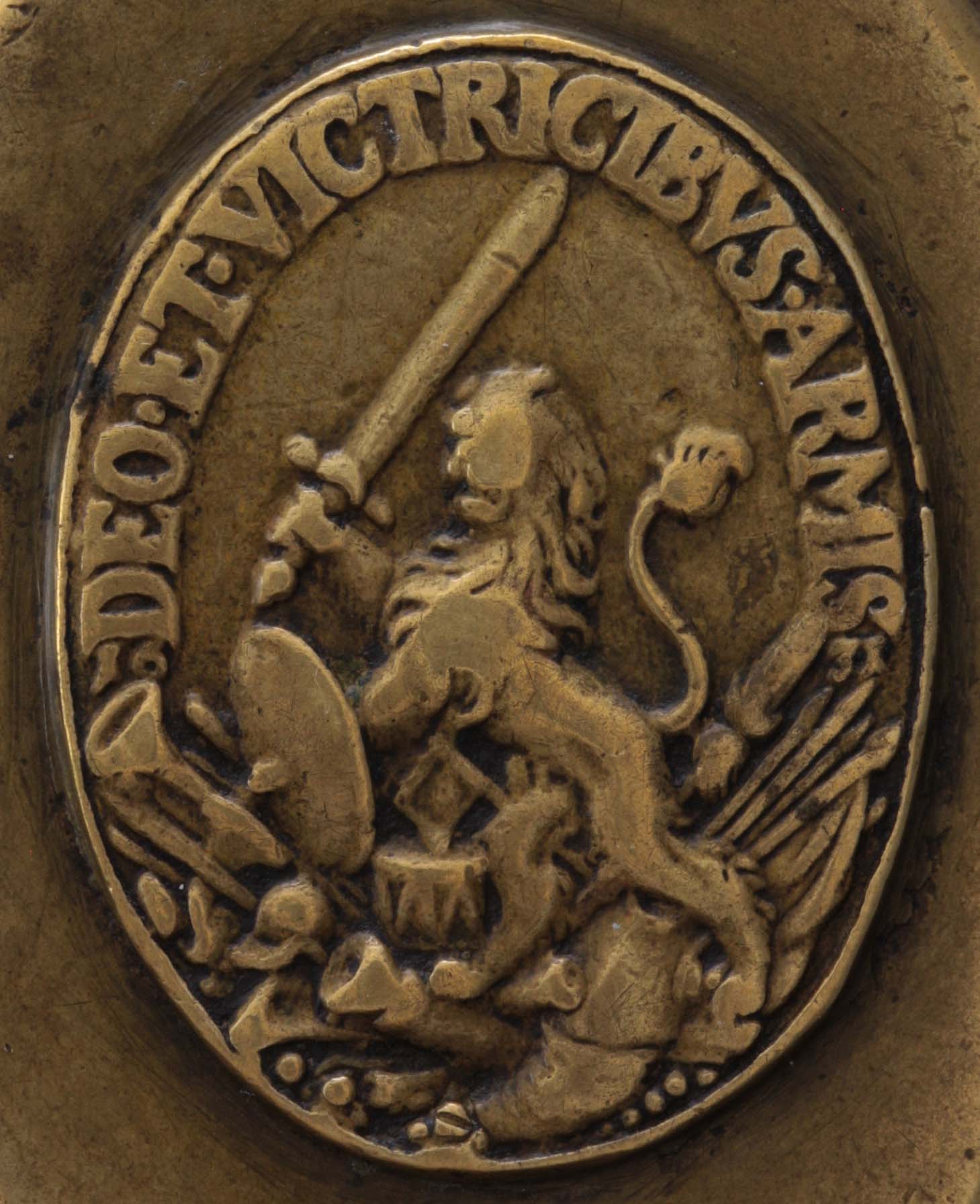
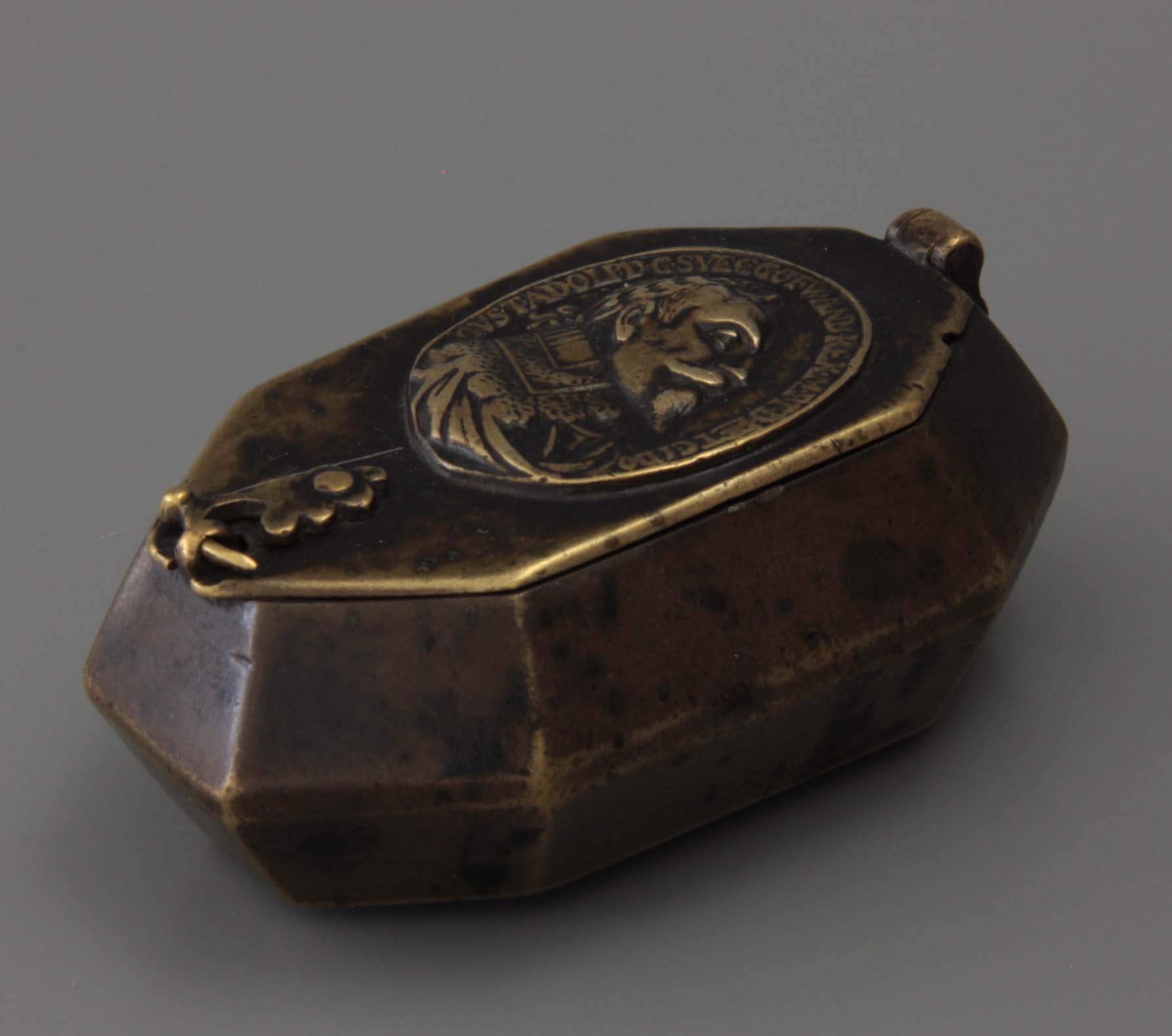
Description: Click here.
Comment: The proposed is King Gustav Adolf II of Sweden (1611-1632), born in 1594 and deceased in 1632. Gustavus Adolph was Lutheran and defender of Protestantism in Germany. He did this from 1630 onwards and with success until his defeat in 1632 followed. Translation of the Latin saying: "By God and the weapons (is he) victorious". The image is pro-protestant and therefore contra-catholic.
A beautiful heavy brass box with a special shape that has been used more often. Proof for the early date is the pipe stopper on the inside of the box, at the location of the hinge. Unexpectedly, this stopper is completely without profile, which is in contrast to the special design of the box. The decoration is cast and the maker used an existing plaque denomination which he printed in the casting sand so that the representation could easily be reproduced.
Characteristic of these boxes is the locking hook with which the lid is locked onto the box. This was necessary because a flat lid without a profiled edge opens too quickly. On the underside, the owner has engraved the property mark with the letters "AP".
Interesting about this object is the date of the coin on the bottom of the box, which shows the year 1631 in tiny figures. However, this year goes back to the historical event depicted in the medal.
A standard box type, made serially in a wide variety, in this case probably intended for sale to Scandinavia.
Origin: Amsterdam
Date: 1645-1665
Collection: Amsterdam, Pijpenkabinet Collections Pk 3.262
Box 4 Appliqué with young stadtholder
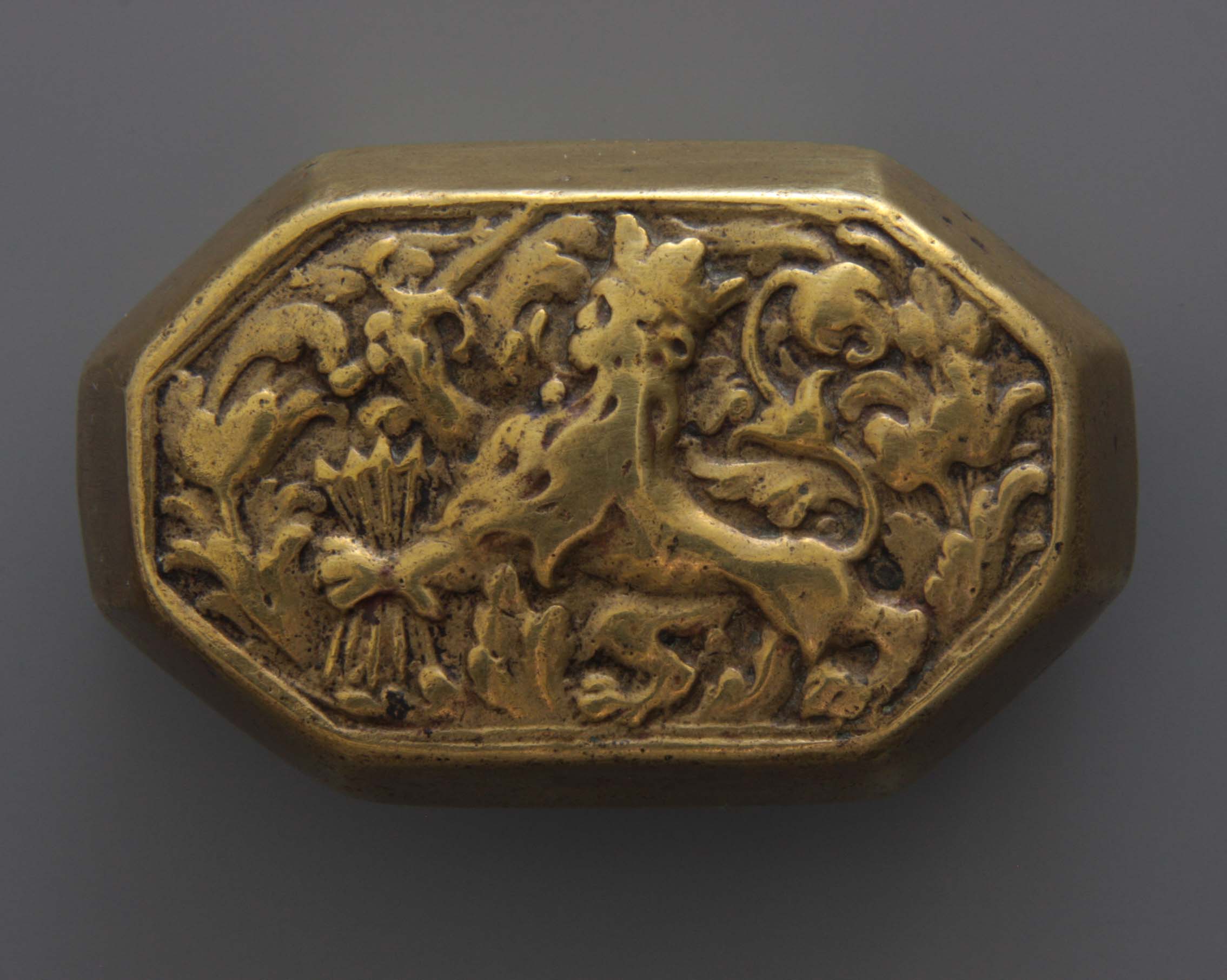
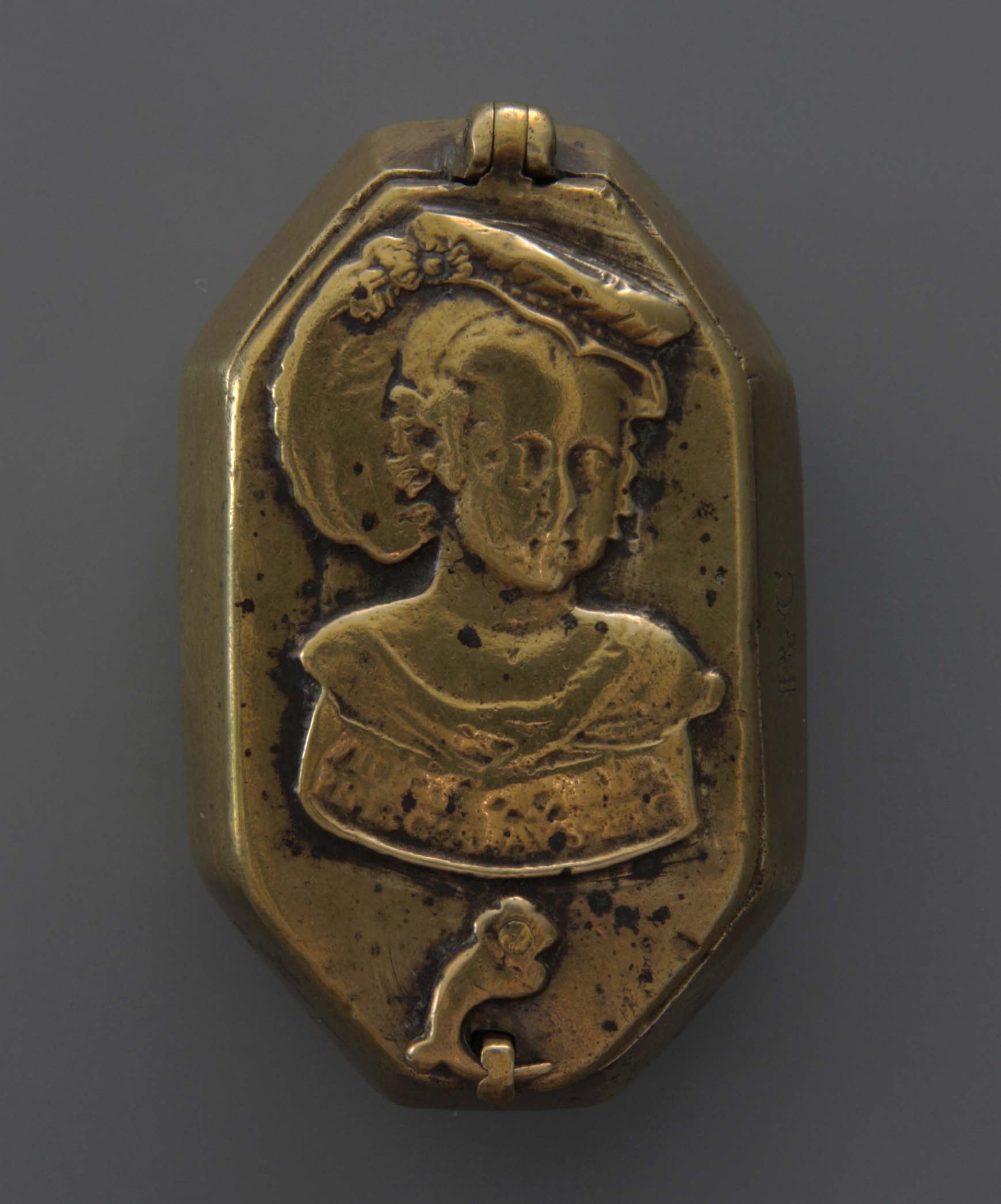
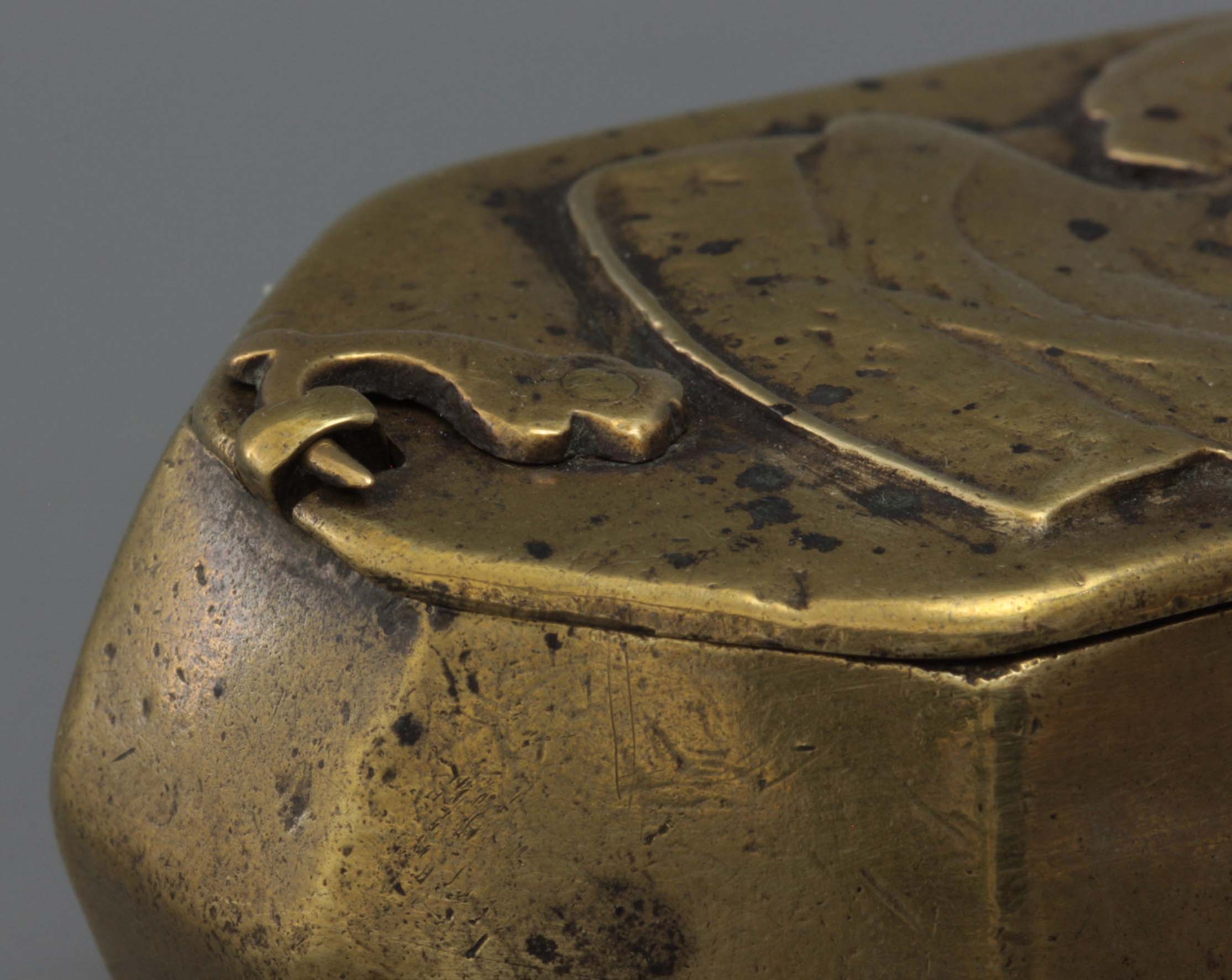
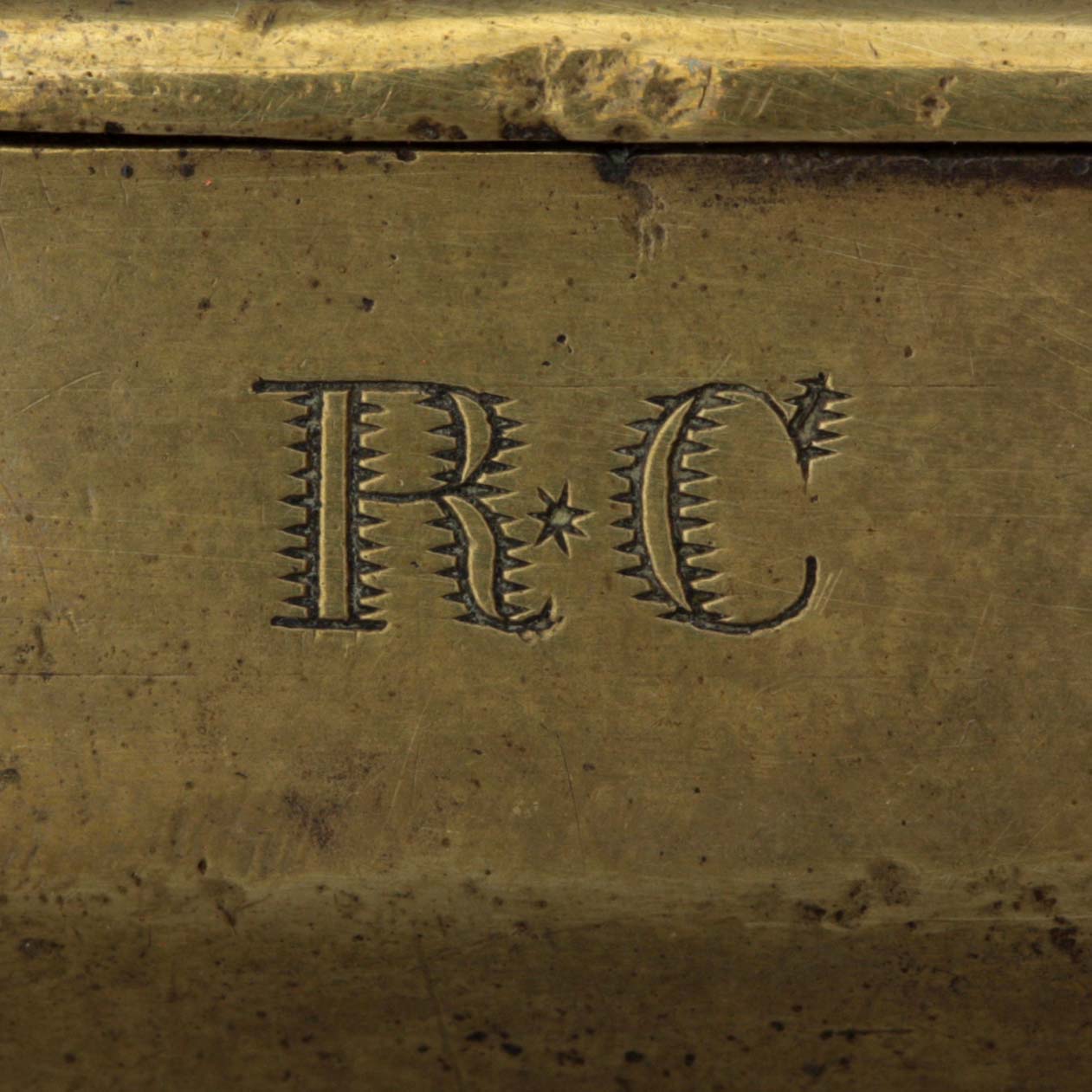
Description: Click here.
Comment: For the performance on the lid, a plaque commission of Pieter van Abeele from 1654 was used and that year is also mentioned. The relief on the bottom is also used in combination with other representations. See catalogue 5 for this.
Literature: Choix de Monnaies and Médailes du Cabinet Royal de la Hayé, The Hague, 1911, no. 232. Picture of a penny with bust of Prince William III with underneath in rectangular cartouche "WILHELMVS III DG PRINC: ARAVS. ETC", next to the rectangular cartouche the date "AN 1654" and around the show a branch with among others orange apples. The original coin made by Pieter van Abeele as a tribute to the Prince of Orange and his mother.
Origin: Amsterdam
Date: 1655-1665
Collection: Amsterdam, Pijpenkabinet Collections Pk 20.713
Box 5 Relief show stadtholder on horseback
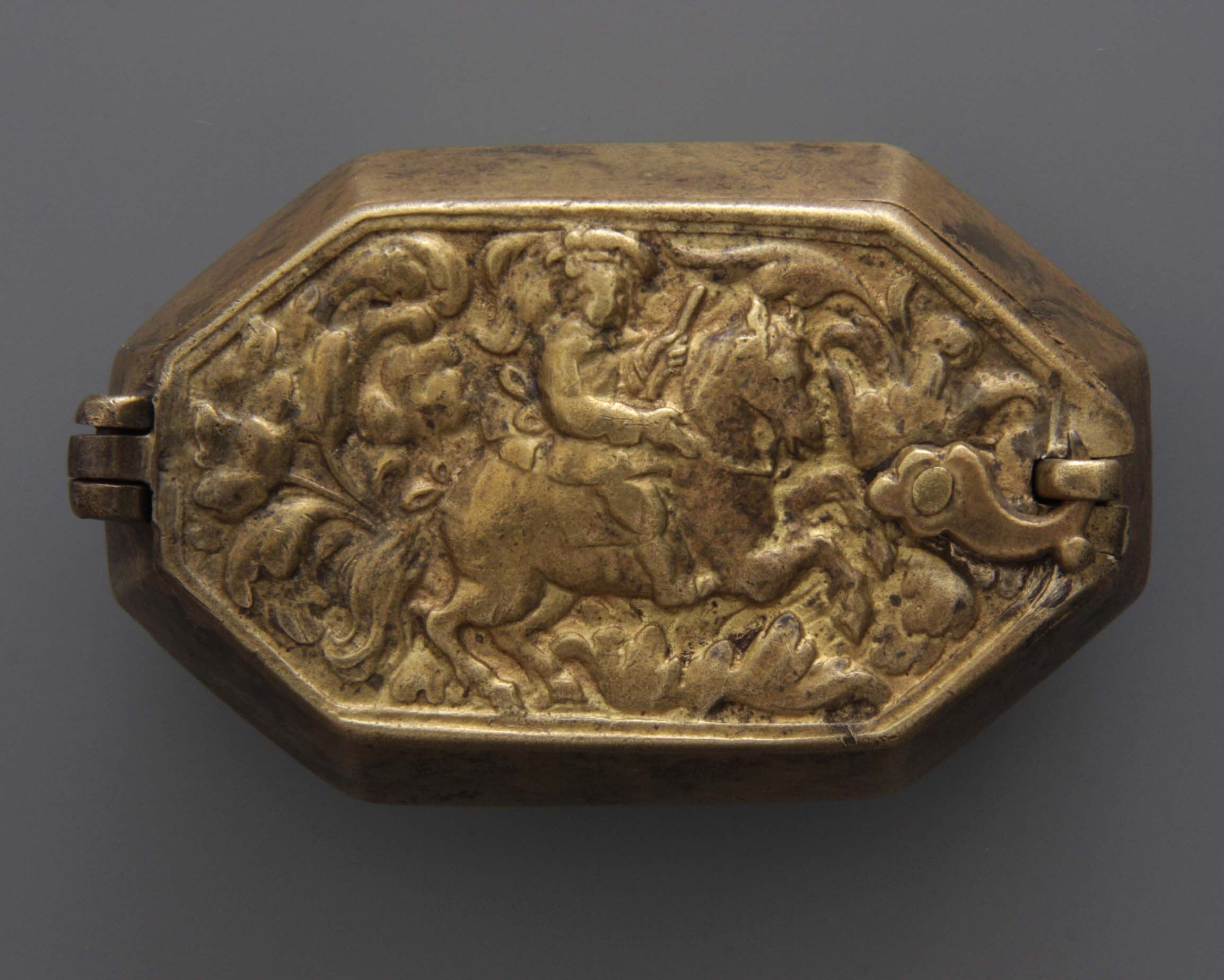
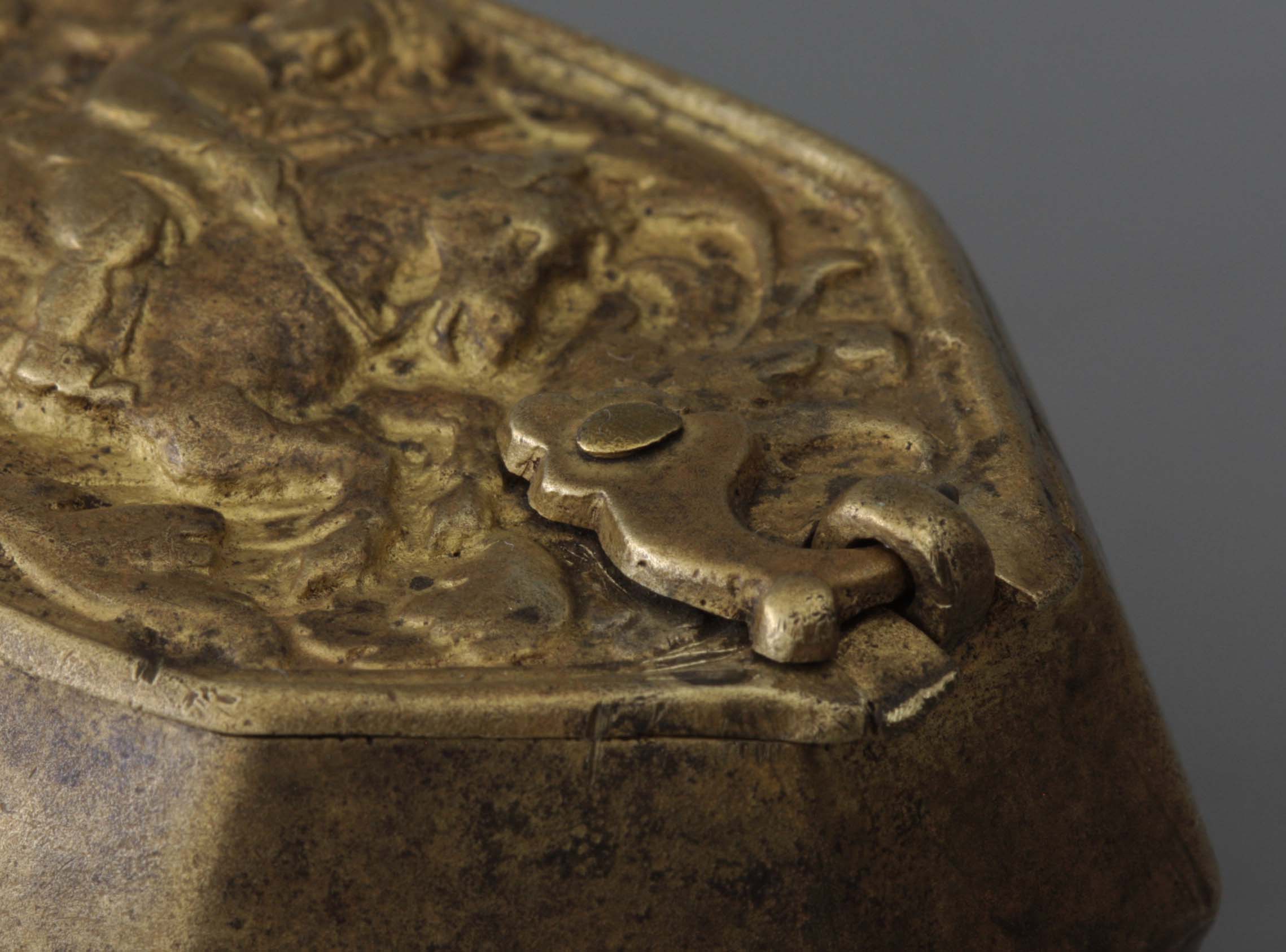
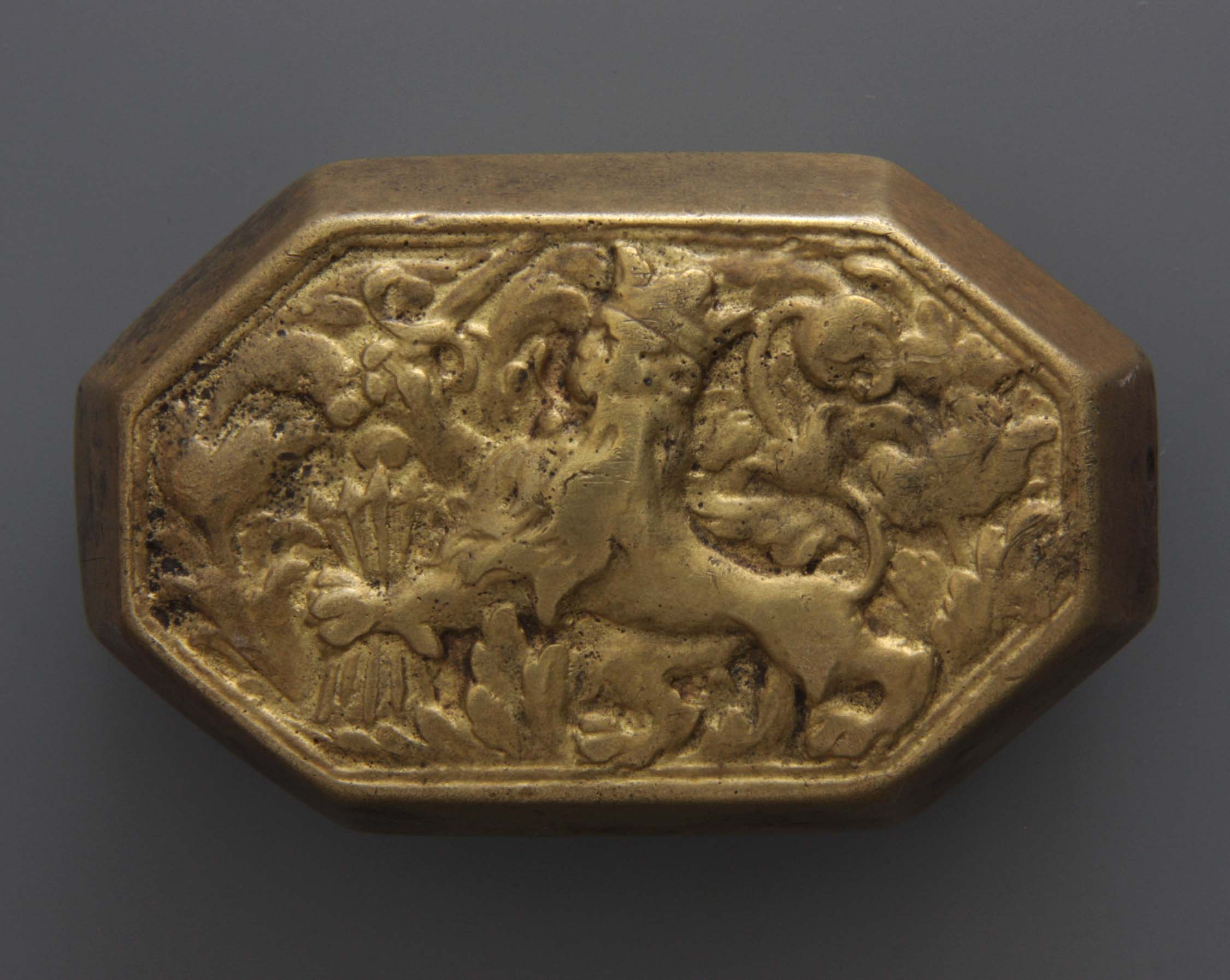
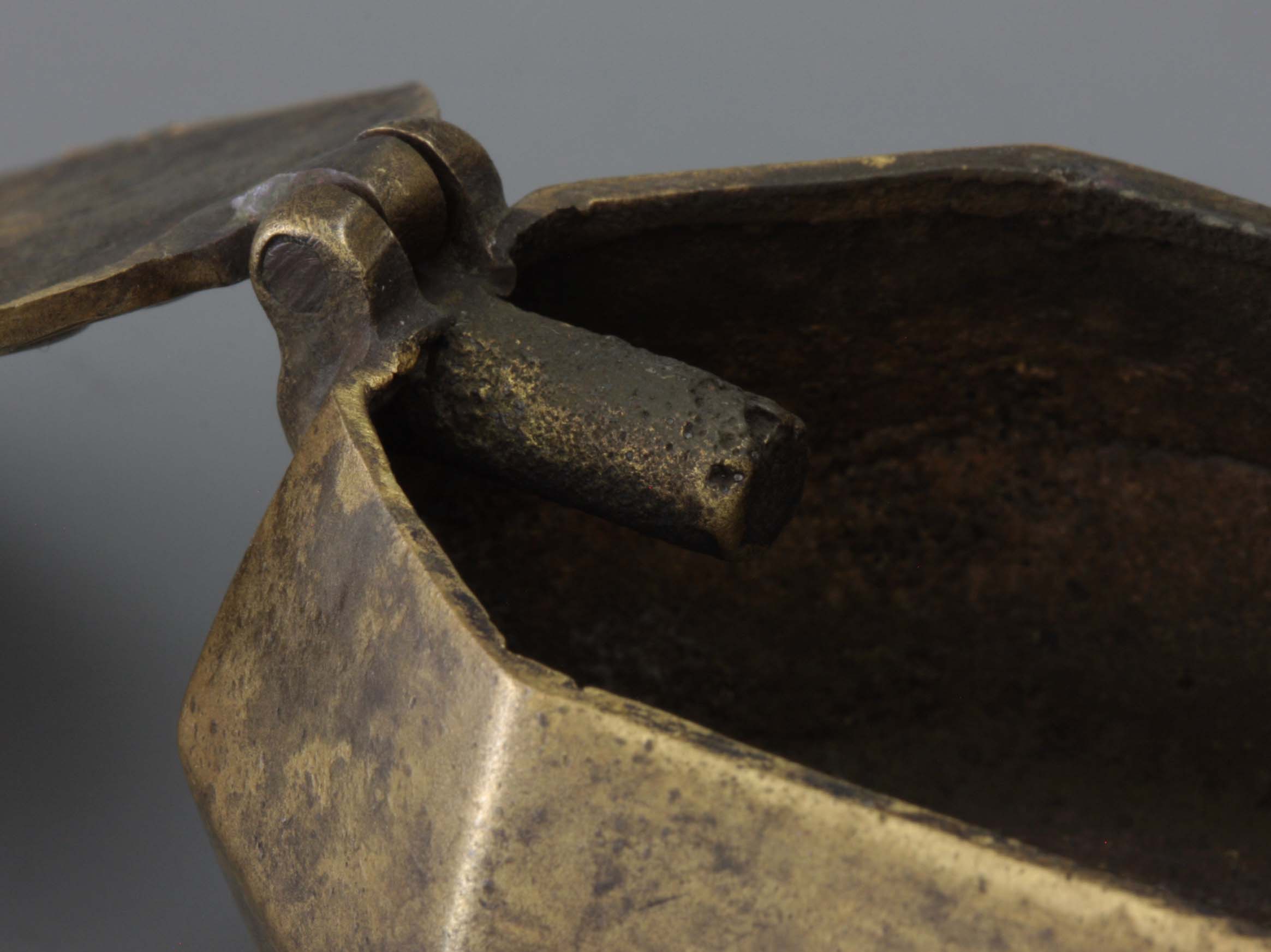
Description: Click here.
Comment: The casting mould for the box is the same as that of catalogue 4, but the lid has been modernized. The young prince has given way to a combative rider, a concept that fits better at the bottom of the box. Like the previous box, it testifies to the use of a strongly worn matrix.
Two of these cantankerous tobacco boxes were recovered in 1972 from the ship of Santo Christo de Castello, which was lost in Genoa in 1667. The ship had loaded in Amsterdam and was stranded at Mullion Cove in Cornwall. The whereabouts of the second box is unknown.
Origin: Amsterdam
Date: 1665-1667
Collection: Amsterdam, Pijpenkabinet Collections Pk 20.714
Box 6 The taste
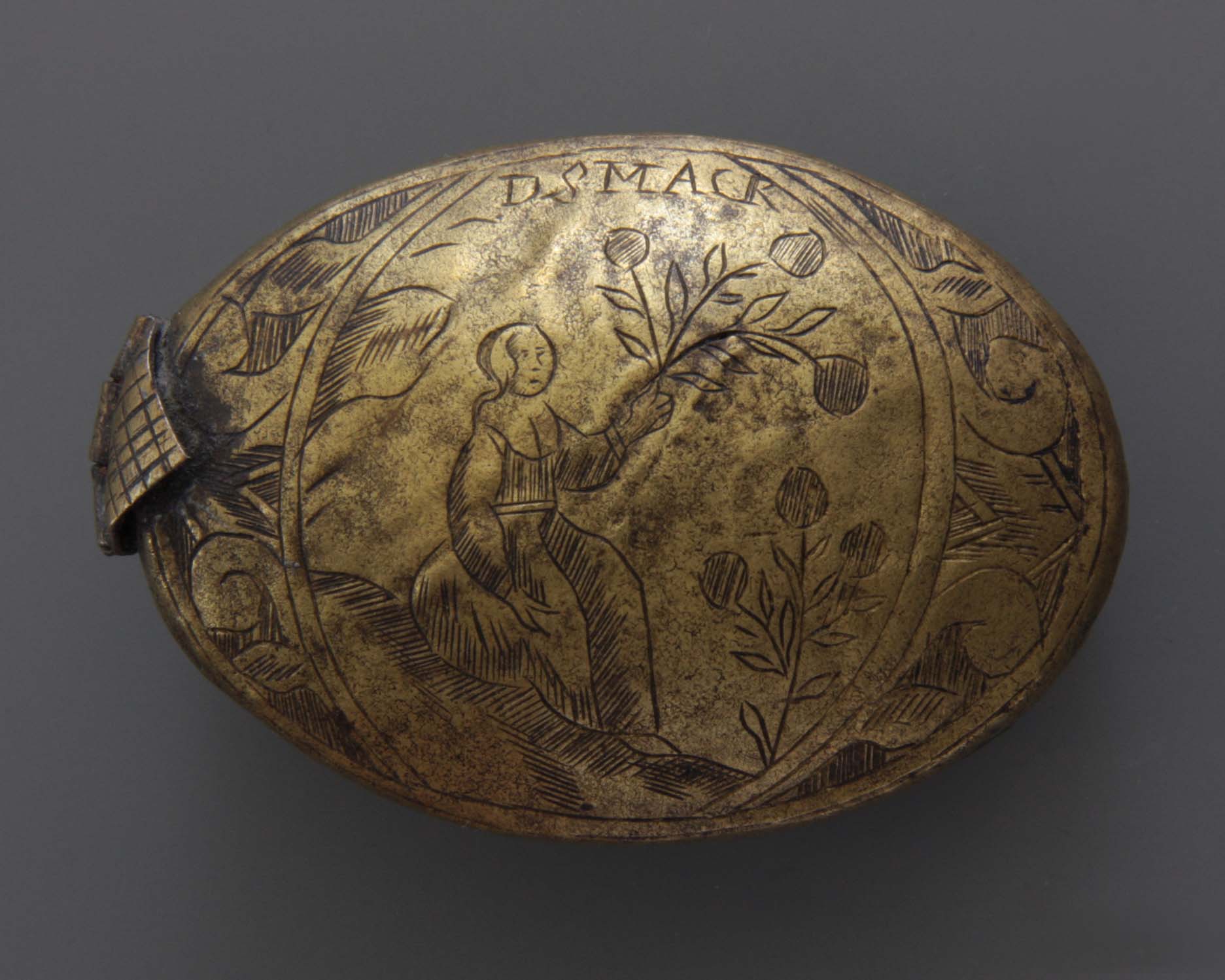
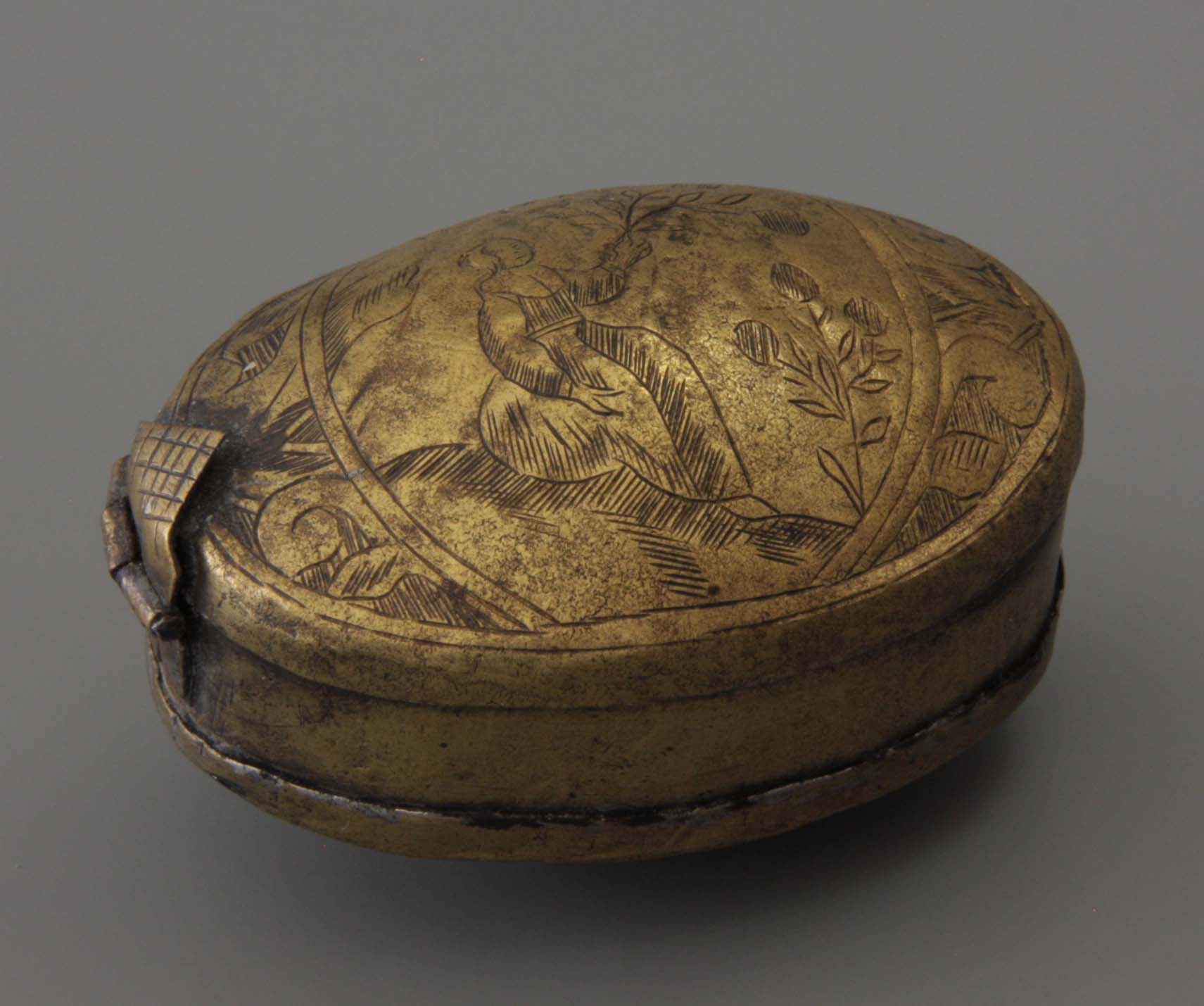
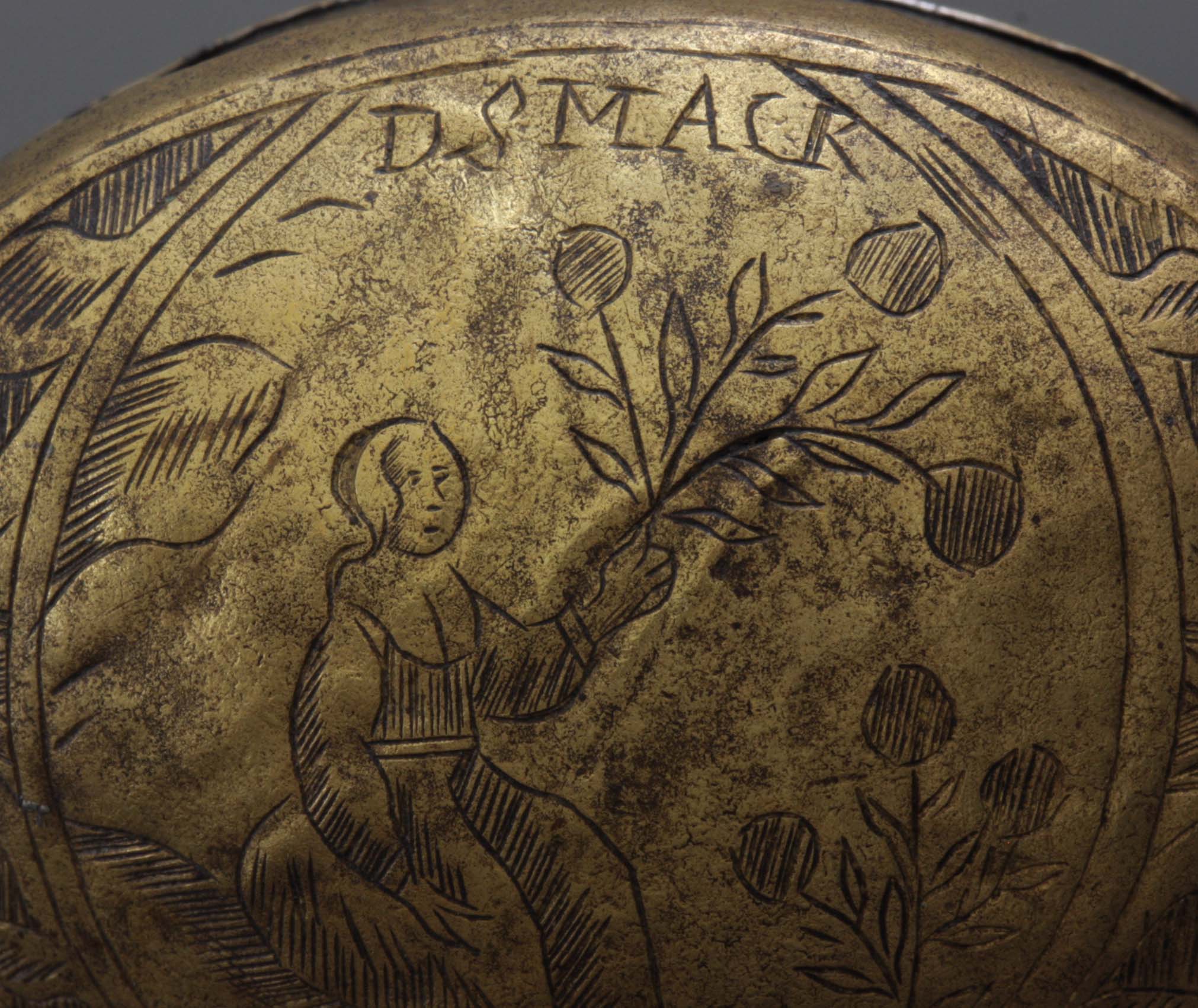
Description: Click here.
Comment: Simple hammered tobacco box with good use value, but not durable with the hinge as the weak point. The date around 1660 corresponds to a similar box with a corresponding engraving on the lid with the year 1657. Numerous examples of such boxes are made in the same style and thus probably made in the same workshop. It is clearly a matter of serial production of simple copper work that is accentuated with an engraving. They are ordinary use boxes and the thin brass plate and the simple way of engraving indicate this. Possibly the branch with fruits is a disguised symbol for Orange and in that case there is a pro-Orange object. Variations on this performance show the cityscape of Zwolle and that of Amsterdam.
Origin: Amsterdam
Date: 1650-1665
Collection: Amsterdam, Pijpenkabinet Collections Pk 9.655
Box 7 Baleen bottom and lid
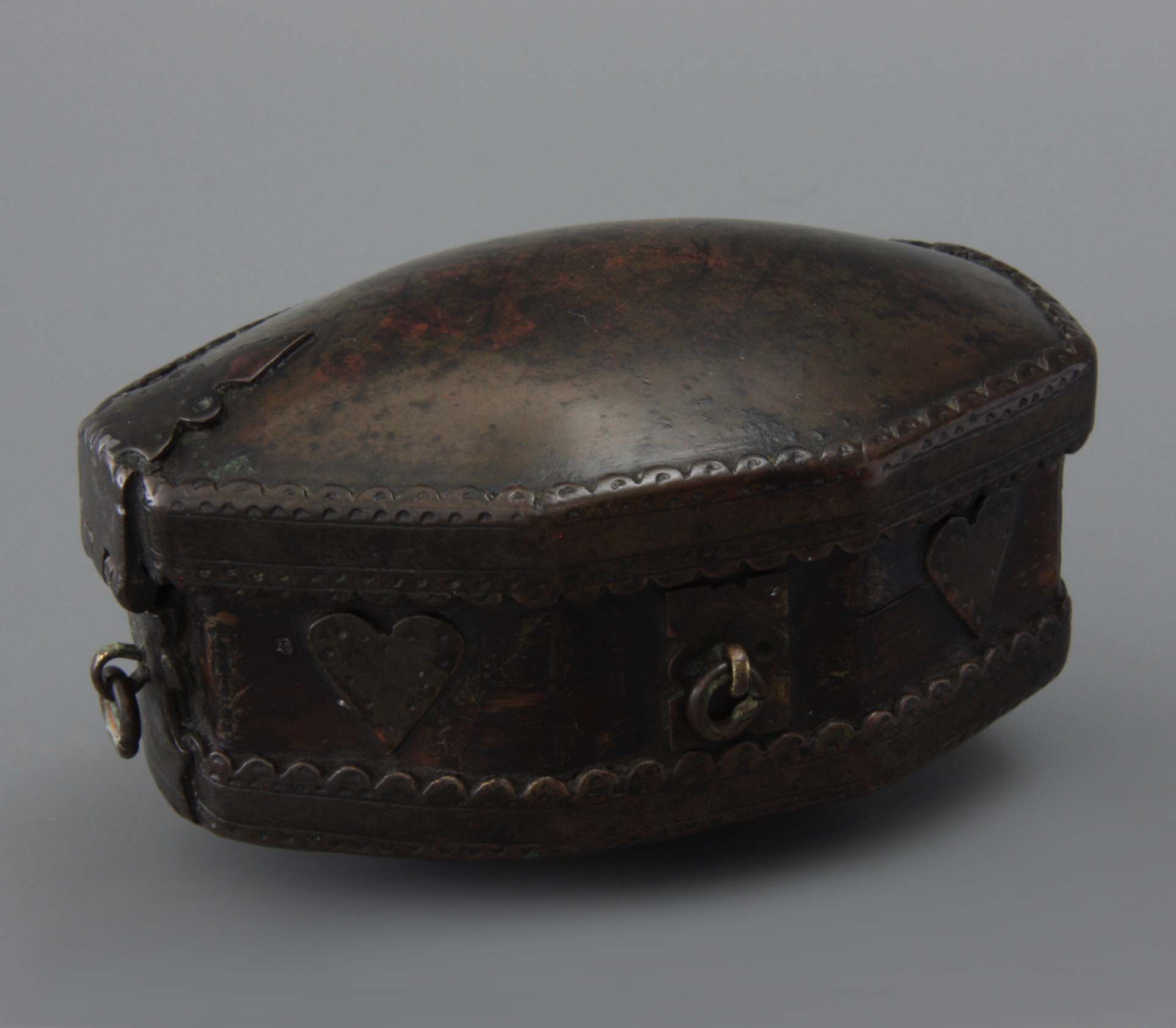
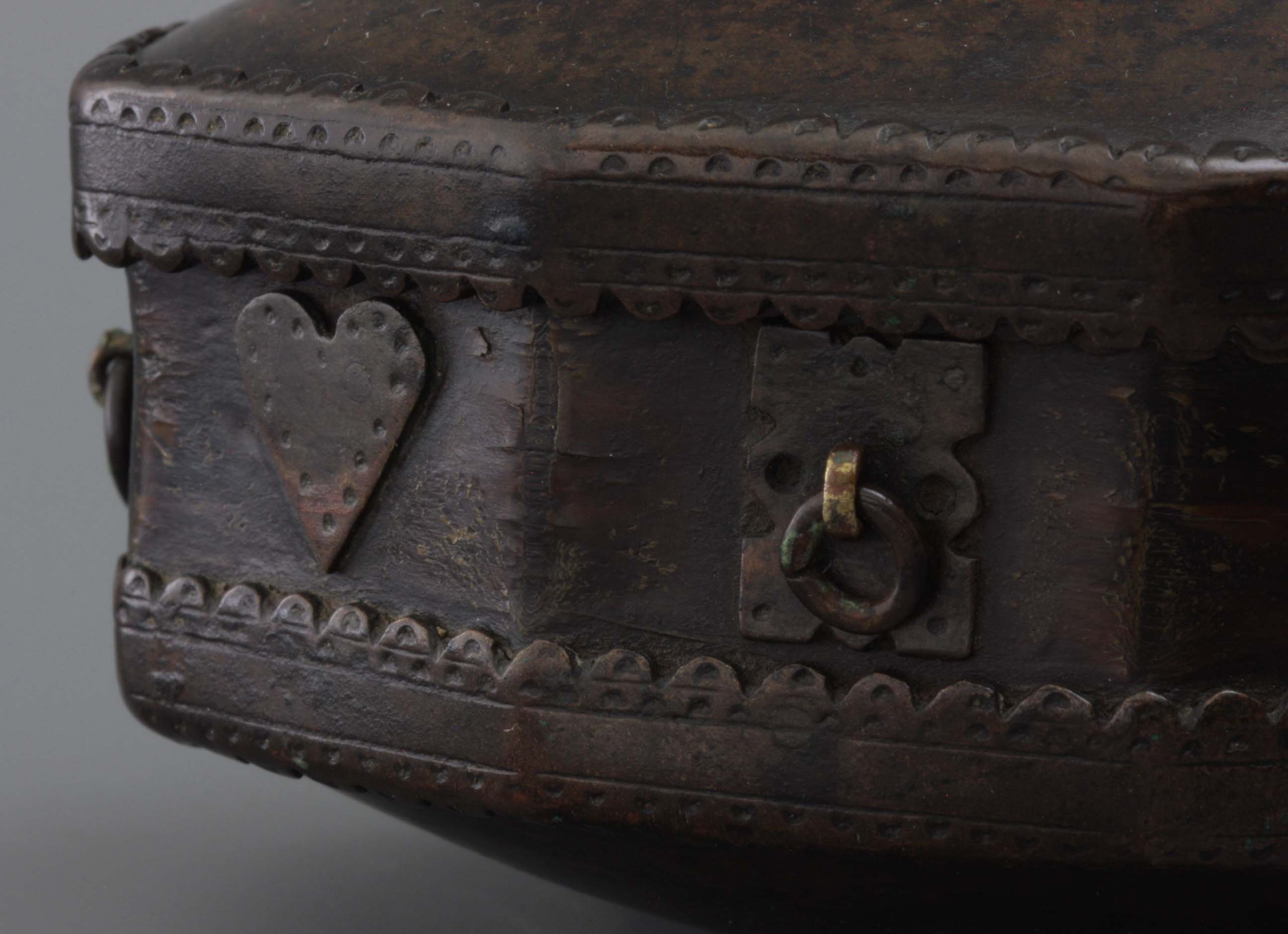
Description: Click here.
Comment: The upright walls of this box are made of whale bale and are decorated with decorations of nailed hearts and rectangles decorated with rings.
Origin: Groningen?
Date: 1670-1700
Collection: Amsterdam, Pijpenkabinet Collections Pk 20.721
Box 8 Cityscape with secret lock
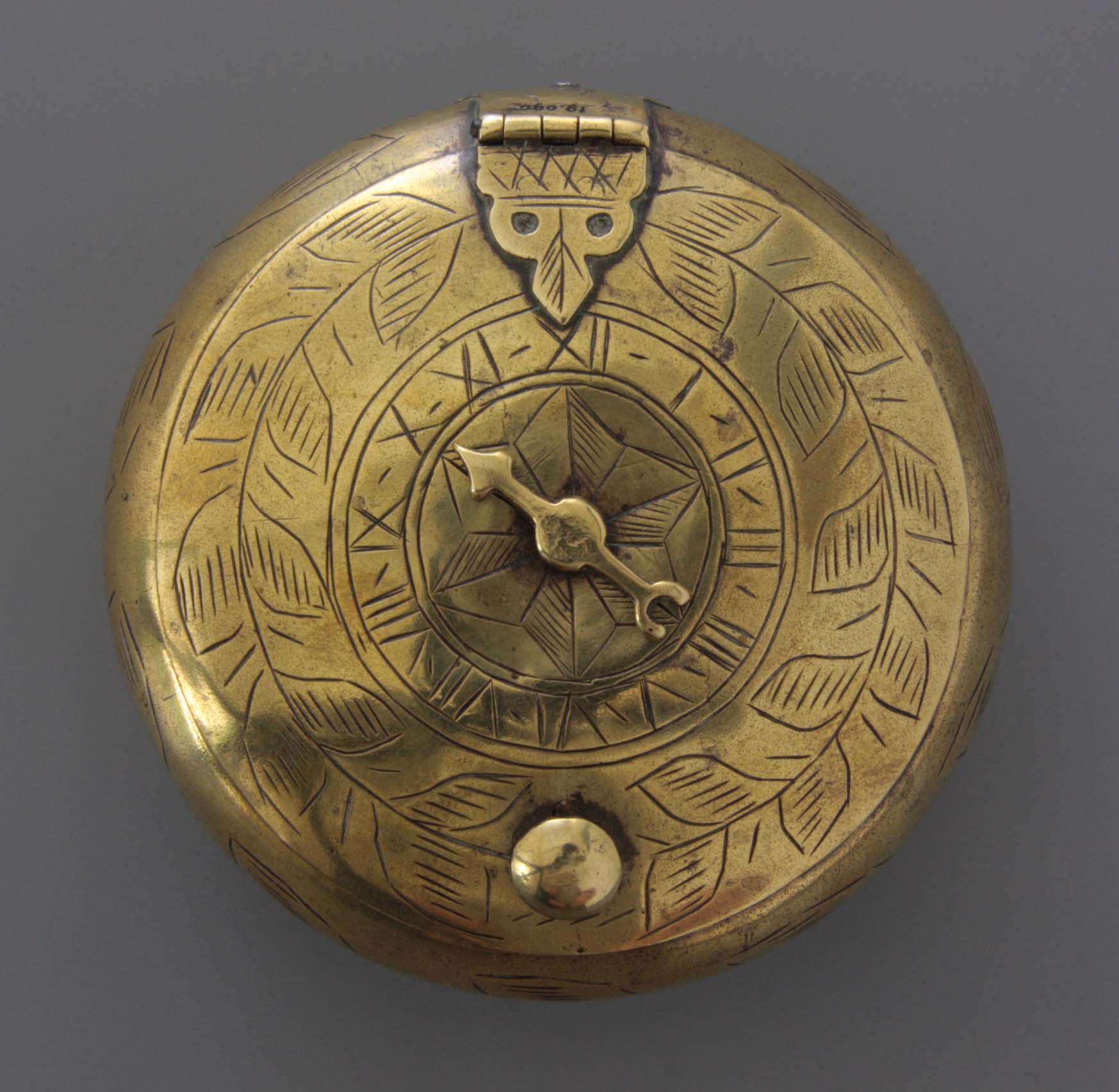
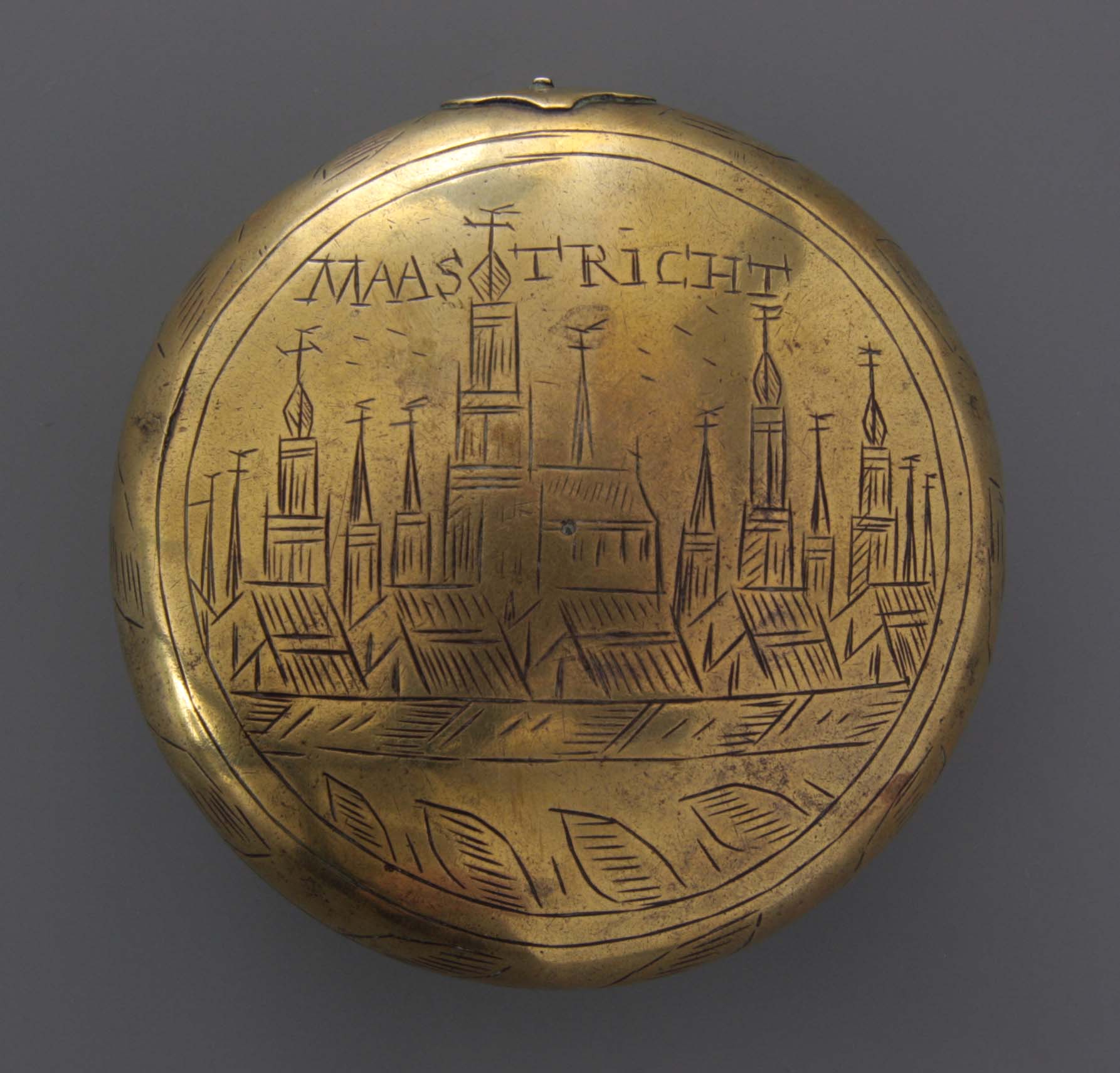
Description: Click here.
Comment: A special box for different reasons. Firstly, it concerns a transition type: the round box with lenticular bottom and lid has only been delivered for a short time and does not exist in one standard type. Characteristic here is the appearance of a pipe stopper on the inside of the box, which indicates a date before the year 1700. After that date the pipe heads become funnel-shaped and the use of a stopper is less necessary,
A second special feature is the lock on the box. This had two reasons: to protect the owner from cackling, but also to allow the carrying of the box to a belt. Thanks to the lock, the box could not open unexpectedly. On the inside this lock with the stamped initials is presumably from the maker. The box opens with the arrow on the numeral VIII.
The engraving is fairly simple. Centrally on the lid is the number ring of a clock with a single hand as usual at that time. The lock is operated with that hand. Around this performance we see a branch with repetitive stylized leaves with a shape determined by the direction of the burin. A similar circular leaf branch has been arranged along the outside of the box. On the underside the representation is placed in a double circle that is apparently engraved with the tongue between the teeth and does not completely fit at the top. Within this circle we see the city profile of Maastricht with a maze of towers and in the foreground houses with sloping roofs. The swallow at the bottom has been filled with the same primitive leaves in a few successful ways. The explanatory text is engraved in block letters along the top of the city profile and excludes speculation about the depicted city.
Date: 1680-1700
Collection: Amsterdam, Pijpenkabinet Collections Pk 19.090
Box 9 Bible box with double lids
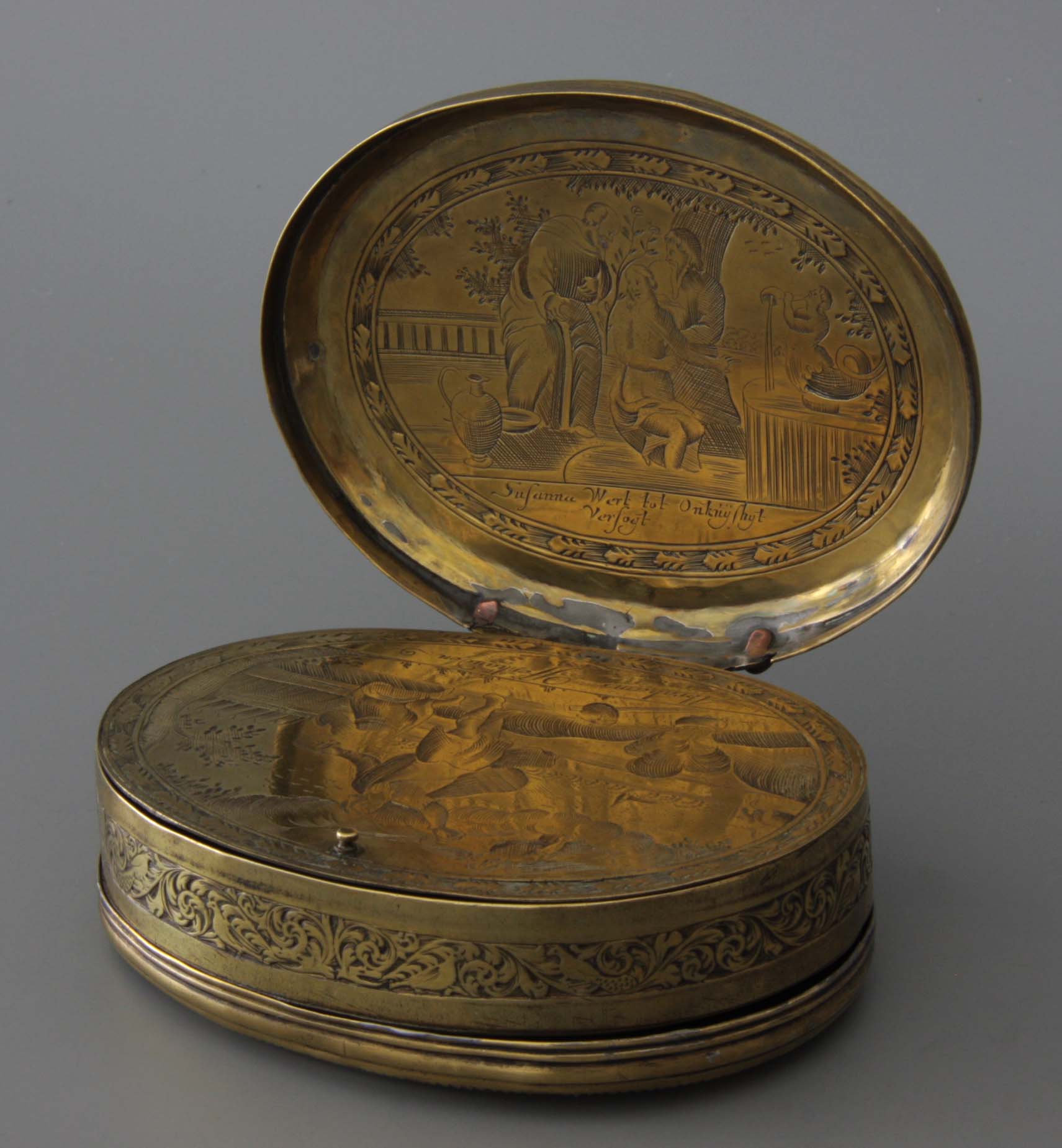
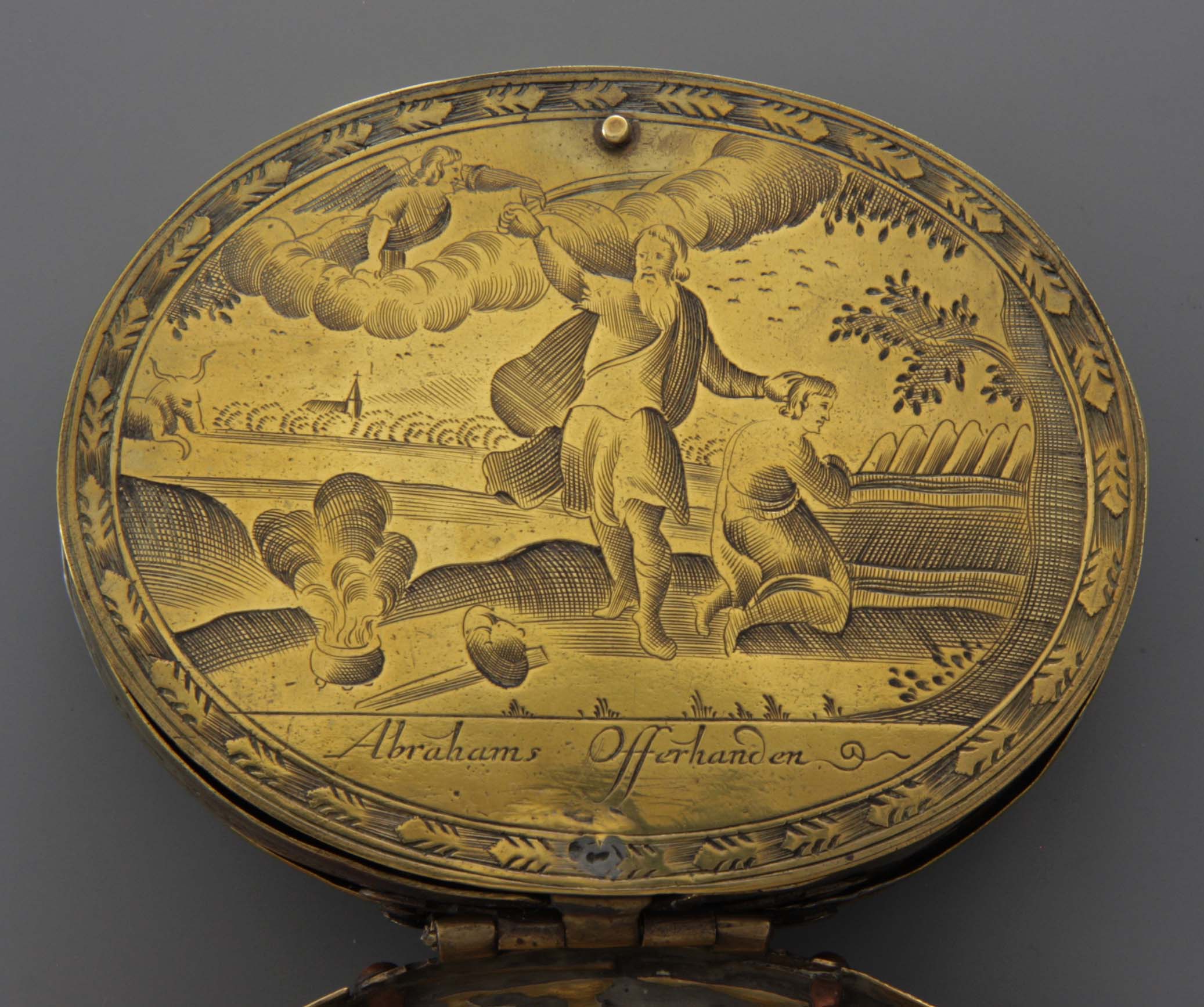
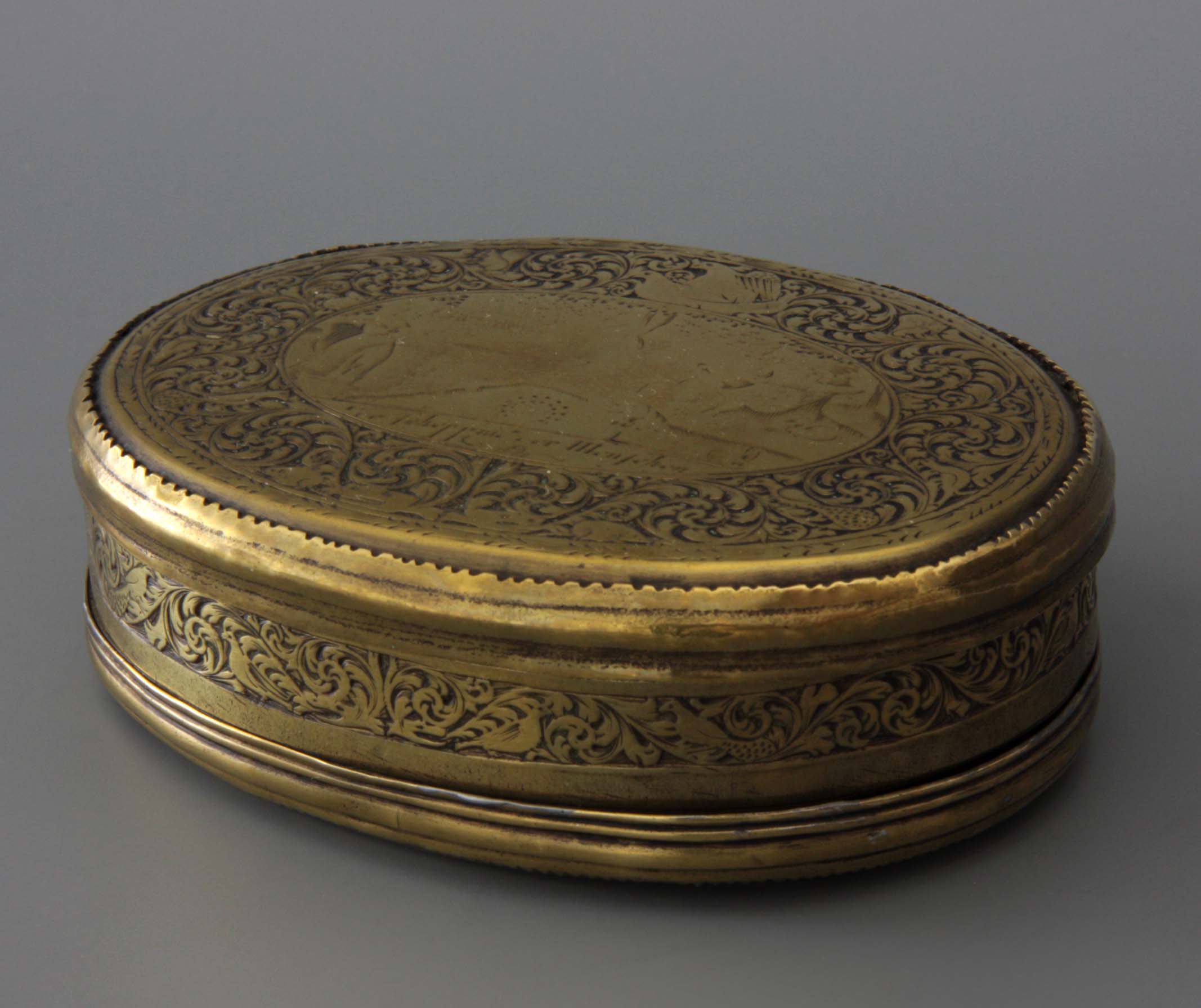
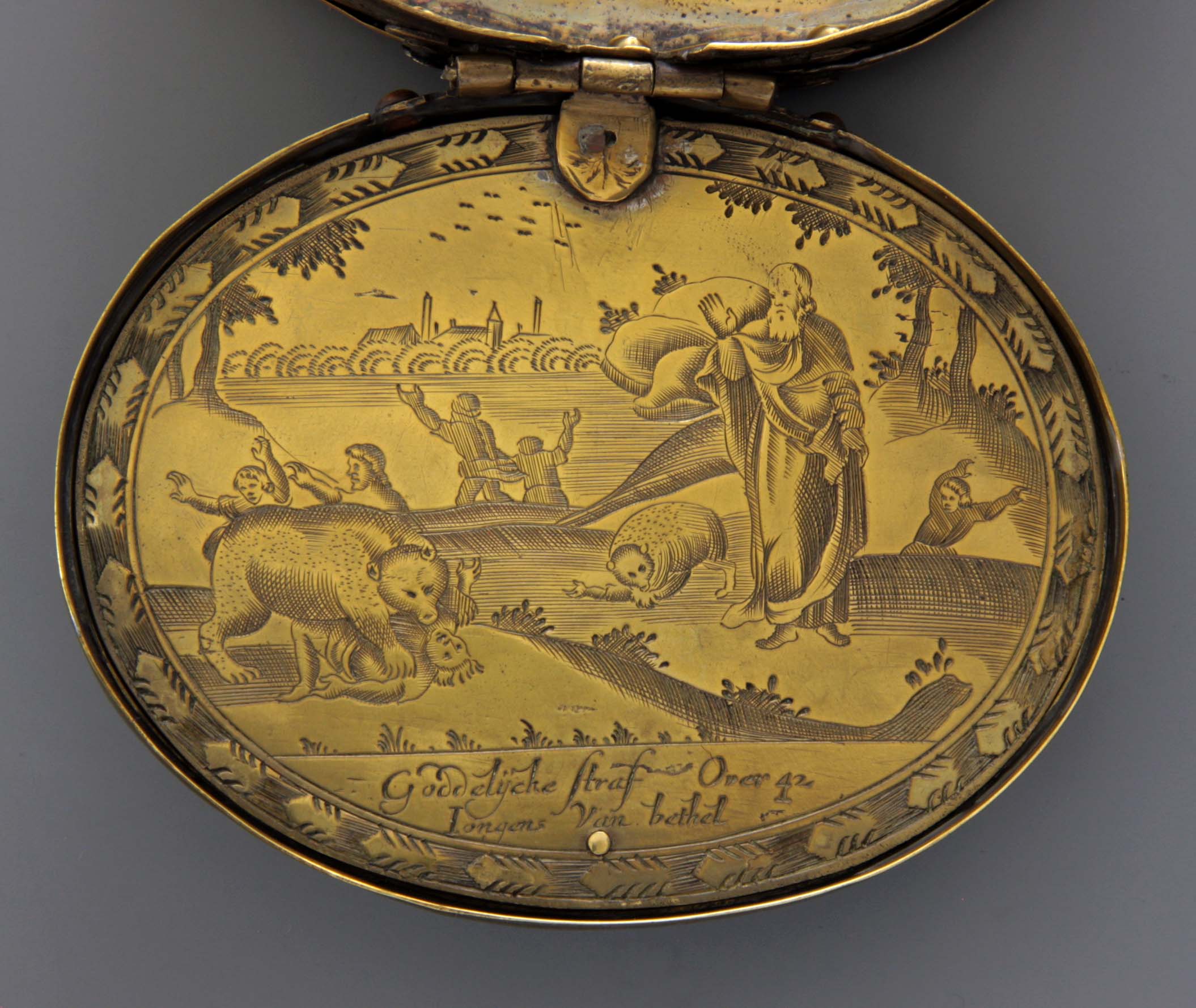
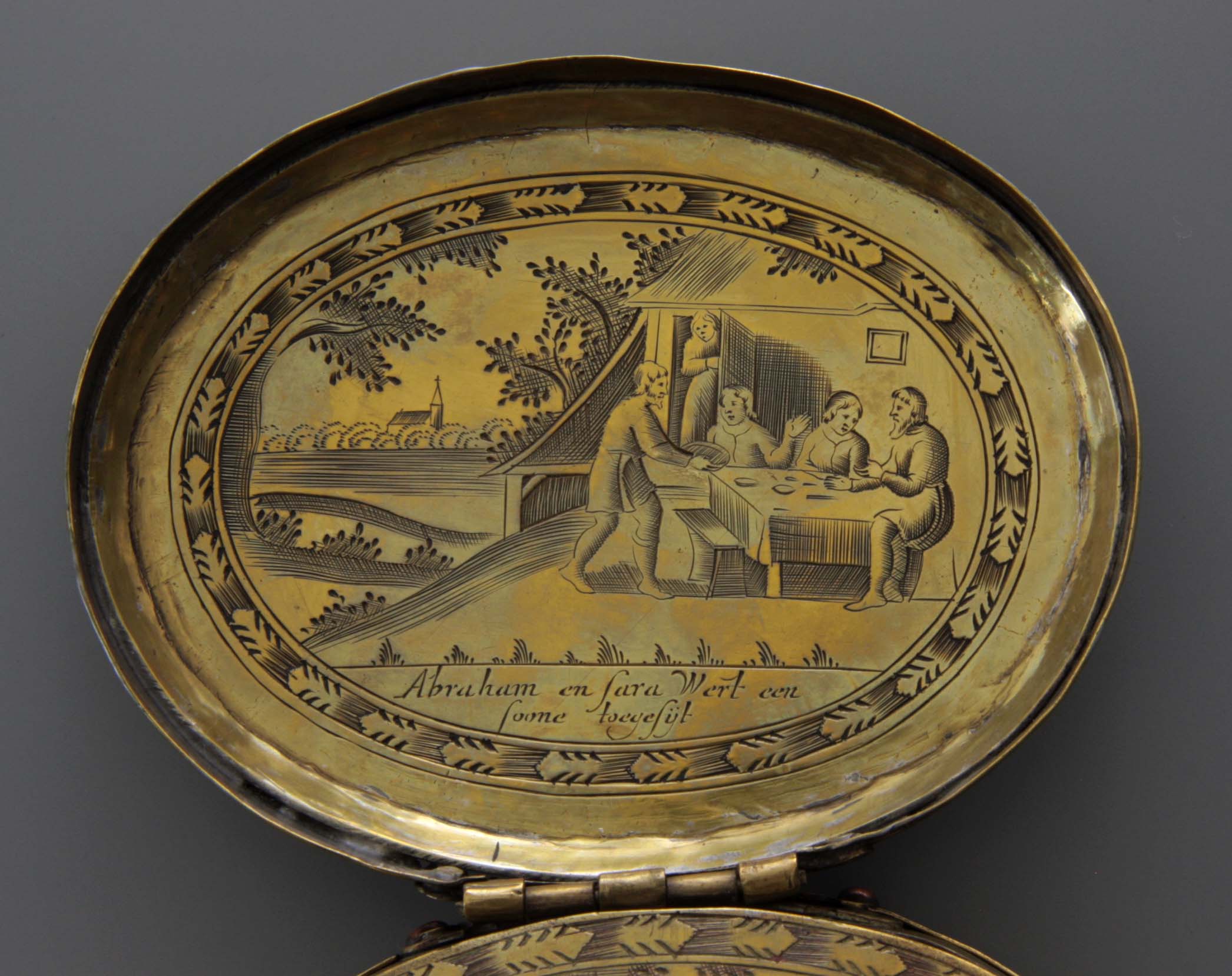
Description: Click here.
Comment: A showcase in two respects. Firstly, the fact that lid and box were embossed, a method that was highly unusual. Secondly, because of the double lid and bottom that are richly engraved. All engravings betray the hand of the same, very skilled engraver, using a picture Bible as an example. Both in a positive and in a negative image some are clear to Matthaeus Merian and some others a free interpretation of Schut's picture Bible, which Merian followed again. Given the beautiful border decoration with birds and stylized leaves and the further present symbolism of mating pigeons and rooting moles, an elephant and dragon heads, the box is clearly rooted in the seventeenth century. The picture Bible of Schut appeared in 1659, but the box was created much later.
Literature: Claire Le Corbeiller, Alte Tabakdosen aus Europa, Fig. 434. A very similar piece is in the Collection of the Museo del Palazzo di Venezia in Rome.
N.I. Schadee, Zilverschatten, drie eeuwen Rotterdams zilver, Rotterdam, 1991, p 81, Cat. 89. Silver box by Van de Abeelen, Rotterdam, identical and dated in the first quarter of the eighteenth century.
Origin: Rotterdam?
Date: 1680-1720
Collection: Amsterdam, Pijpenkabinet Collections Pk 20.723
Box 10 Bible box Christ and John
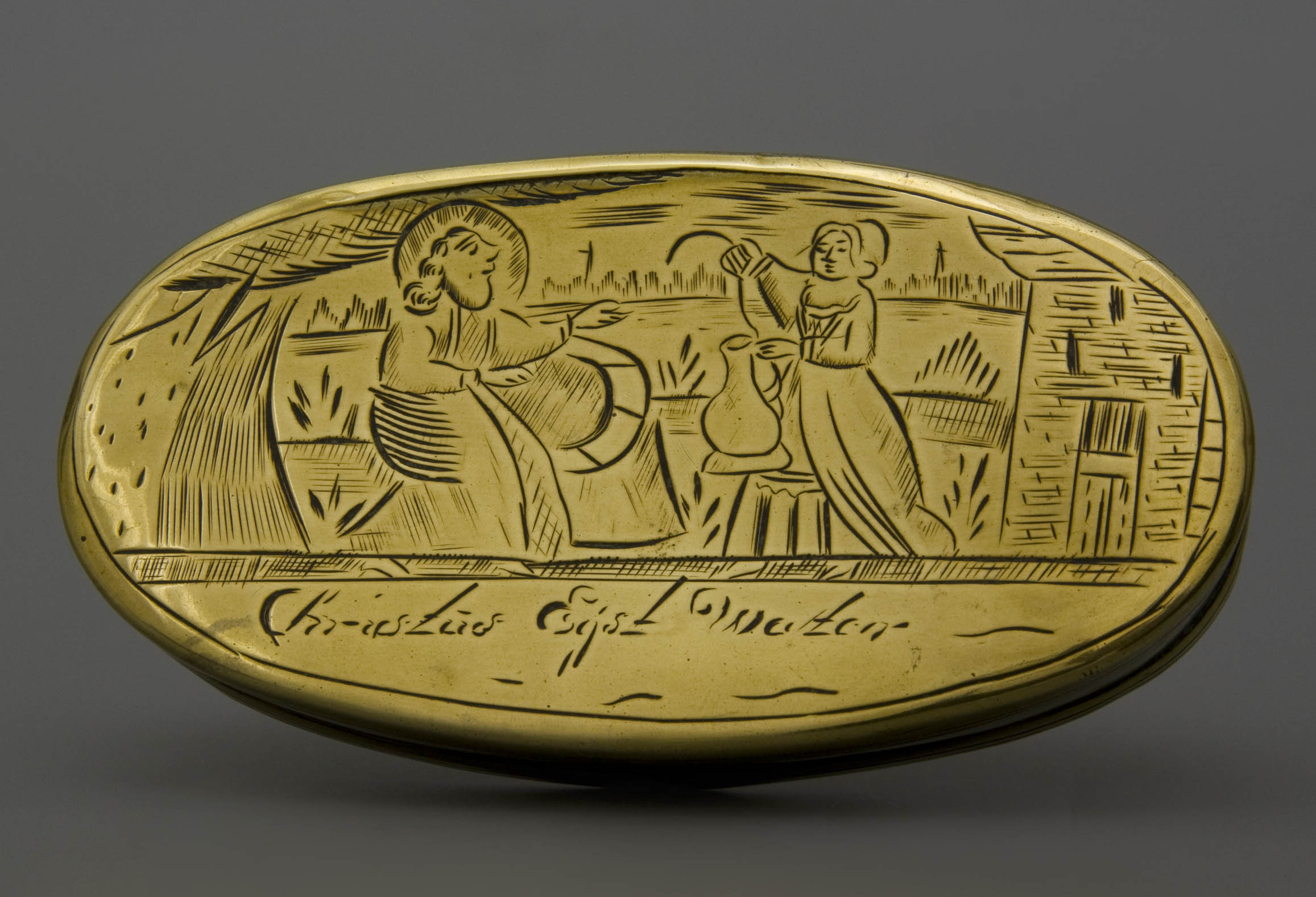
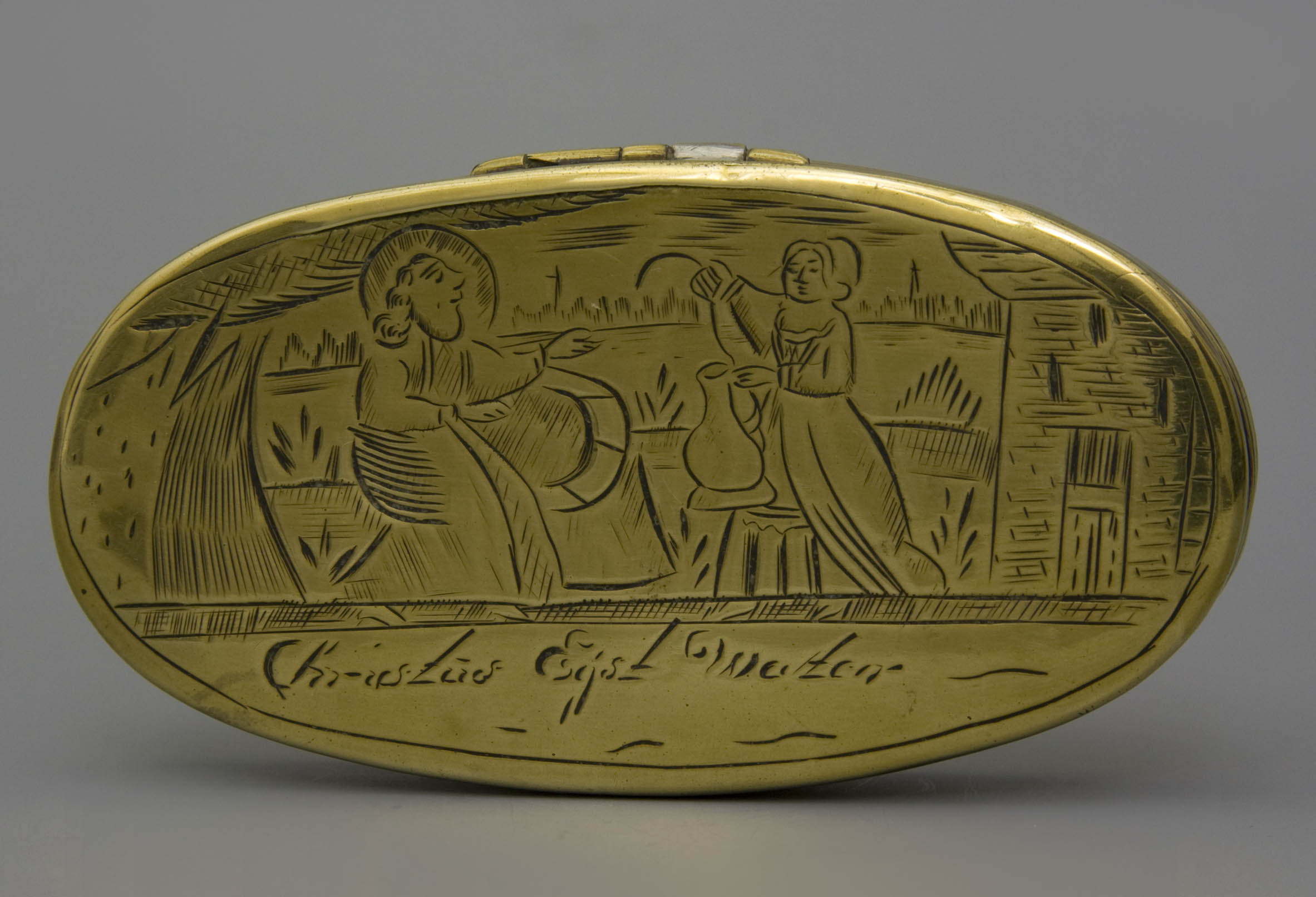

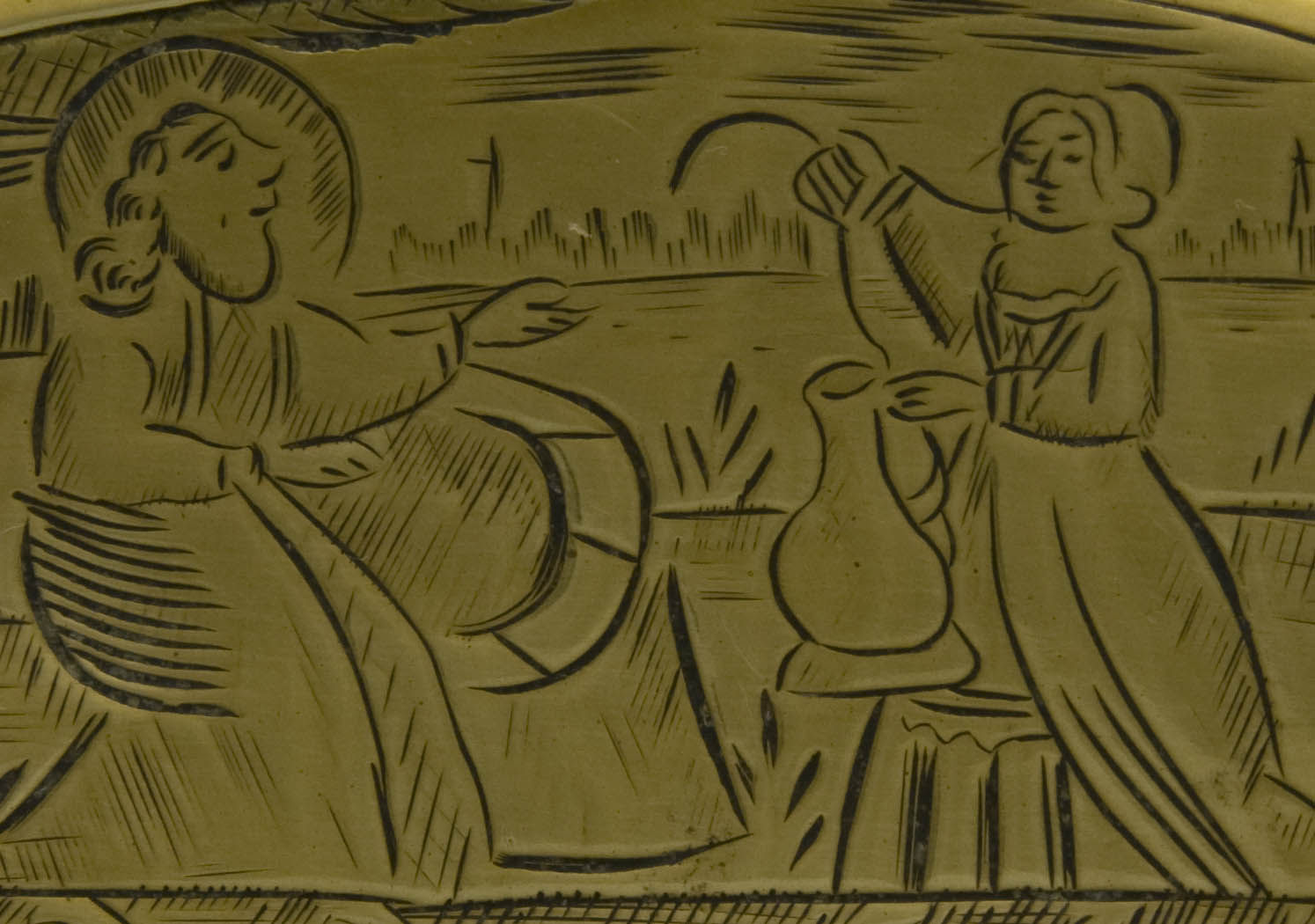
Description: Click here.
Comment: Simple but decent product. Characteristic is the flat oval shape, which is easy to put away between the clothes. The low height and thus modest content indicates a period in which the tobacco was still stored in smaller quantities. The early dating also means that we would expect a pipe stopper on the inside, which is not the case.
Origin: the Netherlands
Date: 1690-1720
Collection: Amsterdam, Pijpenkabinet Collections Pk 449
Box 11 Moralizing image
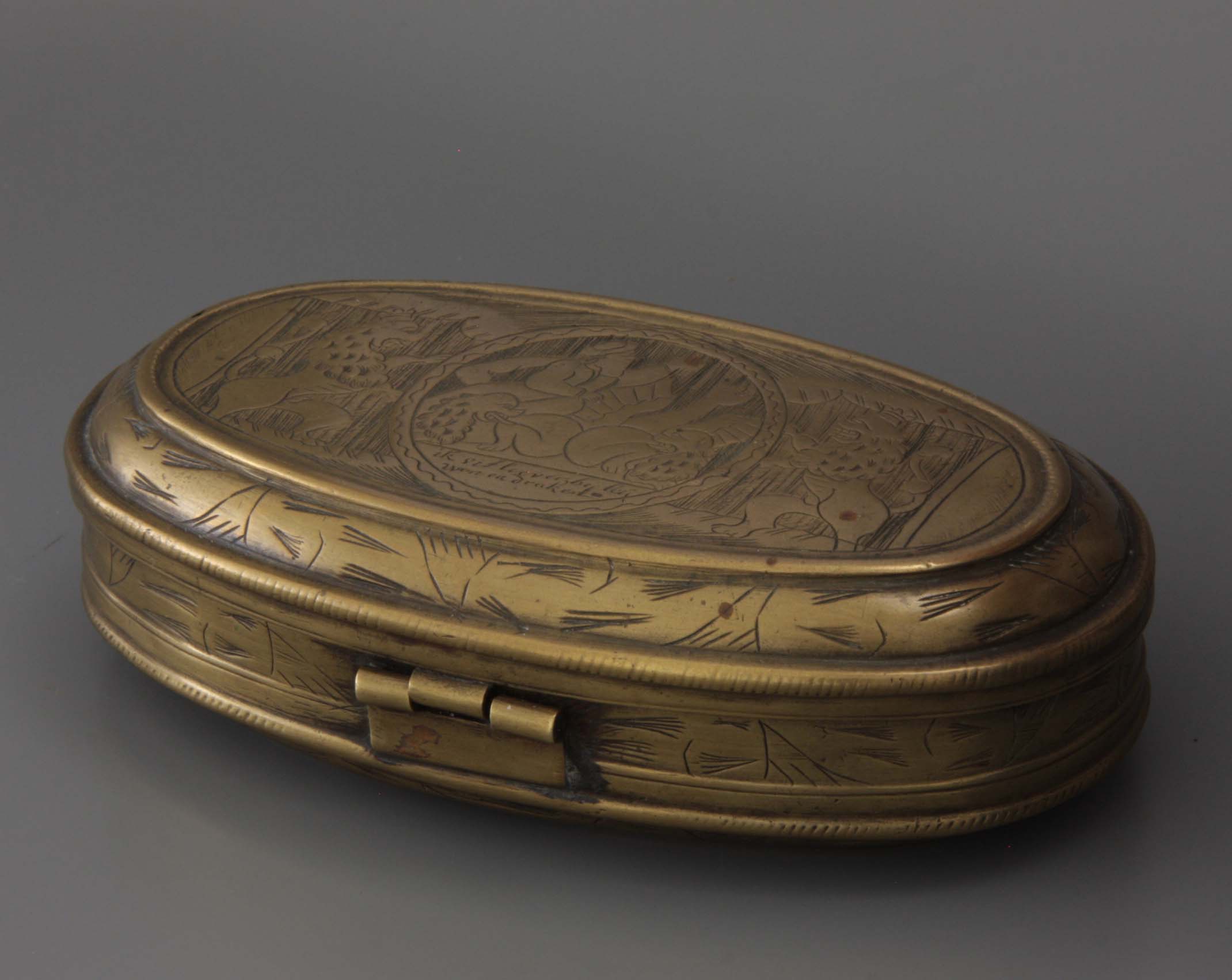
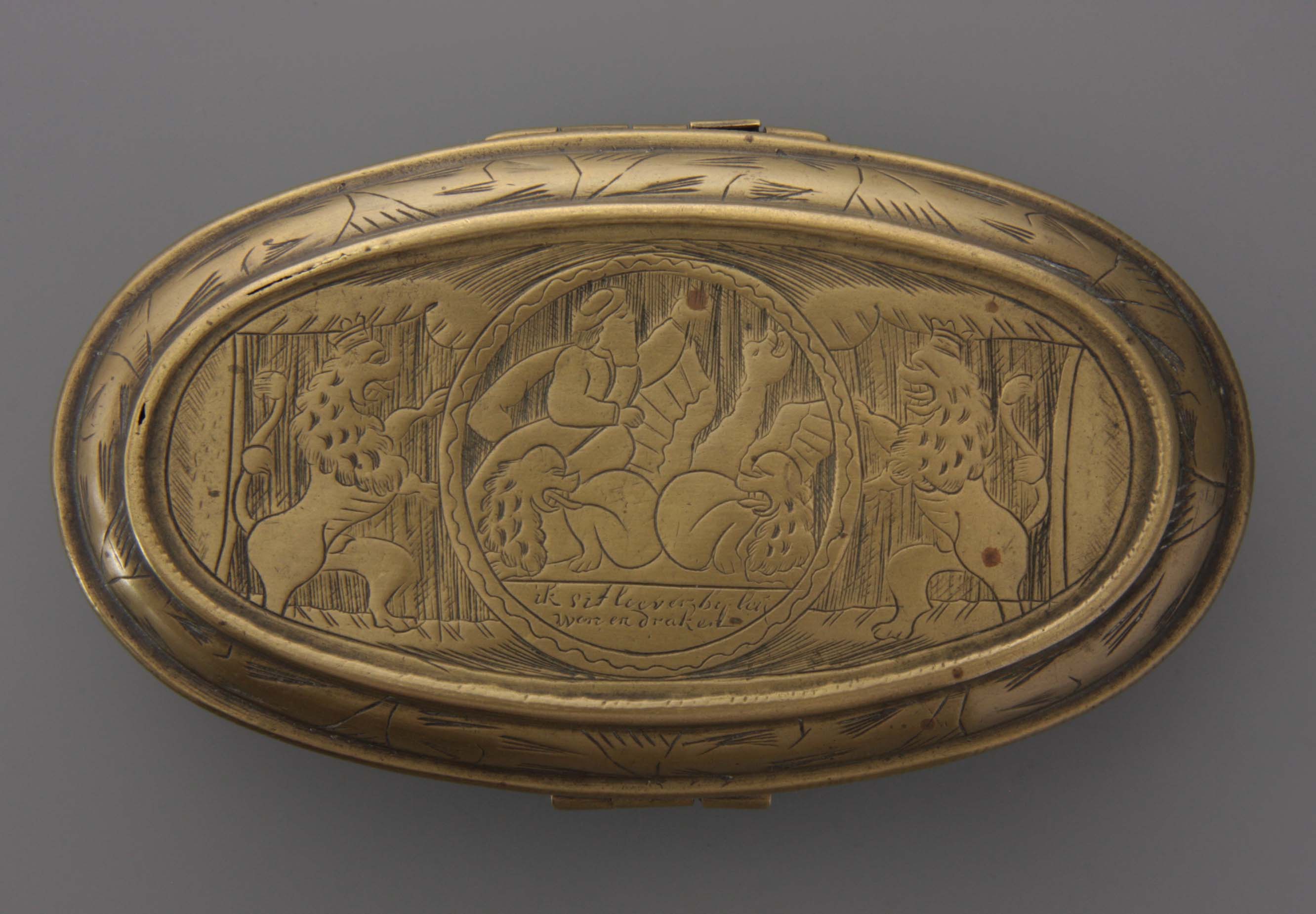
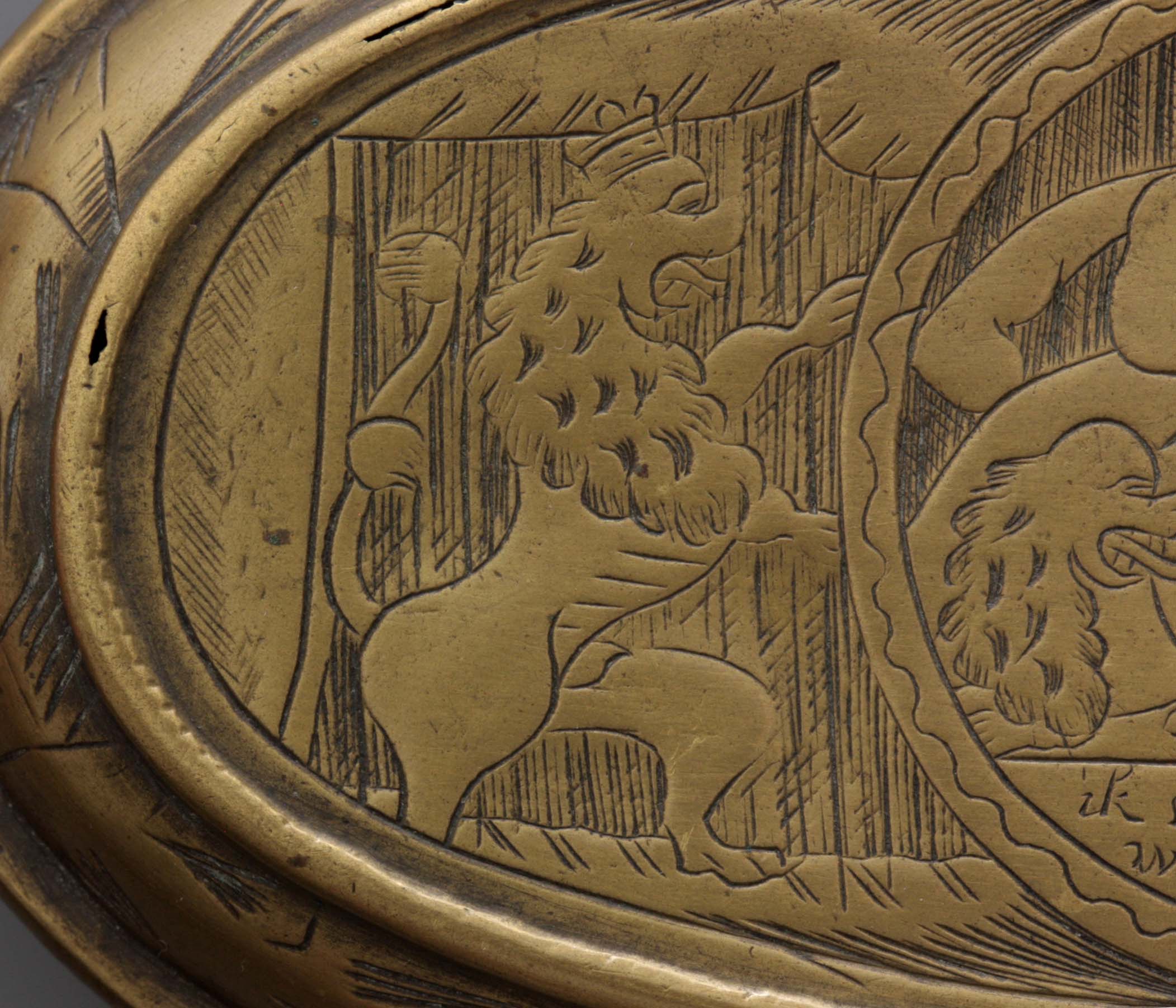
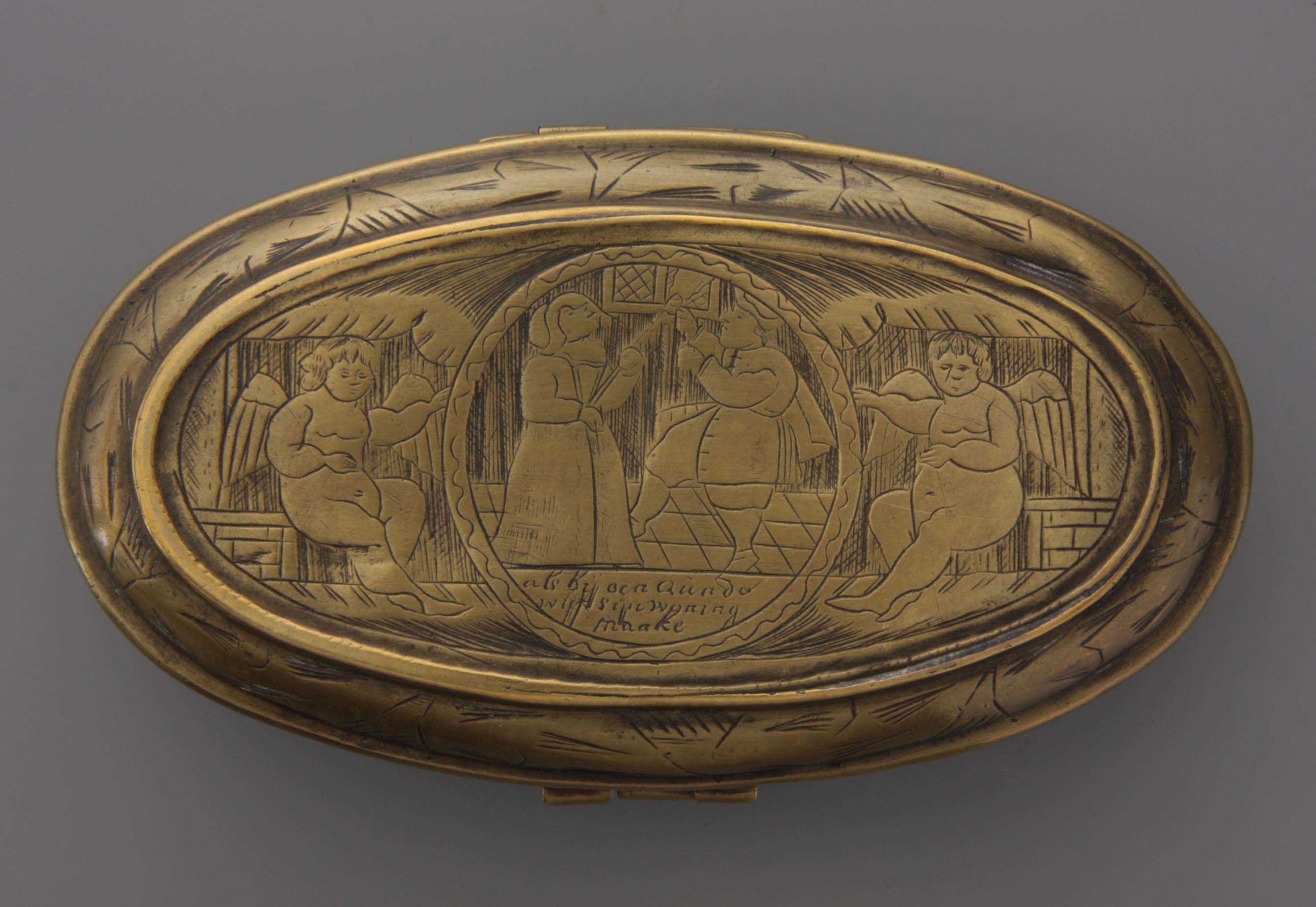
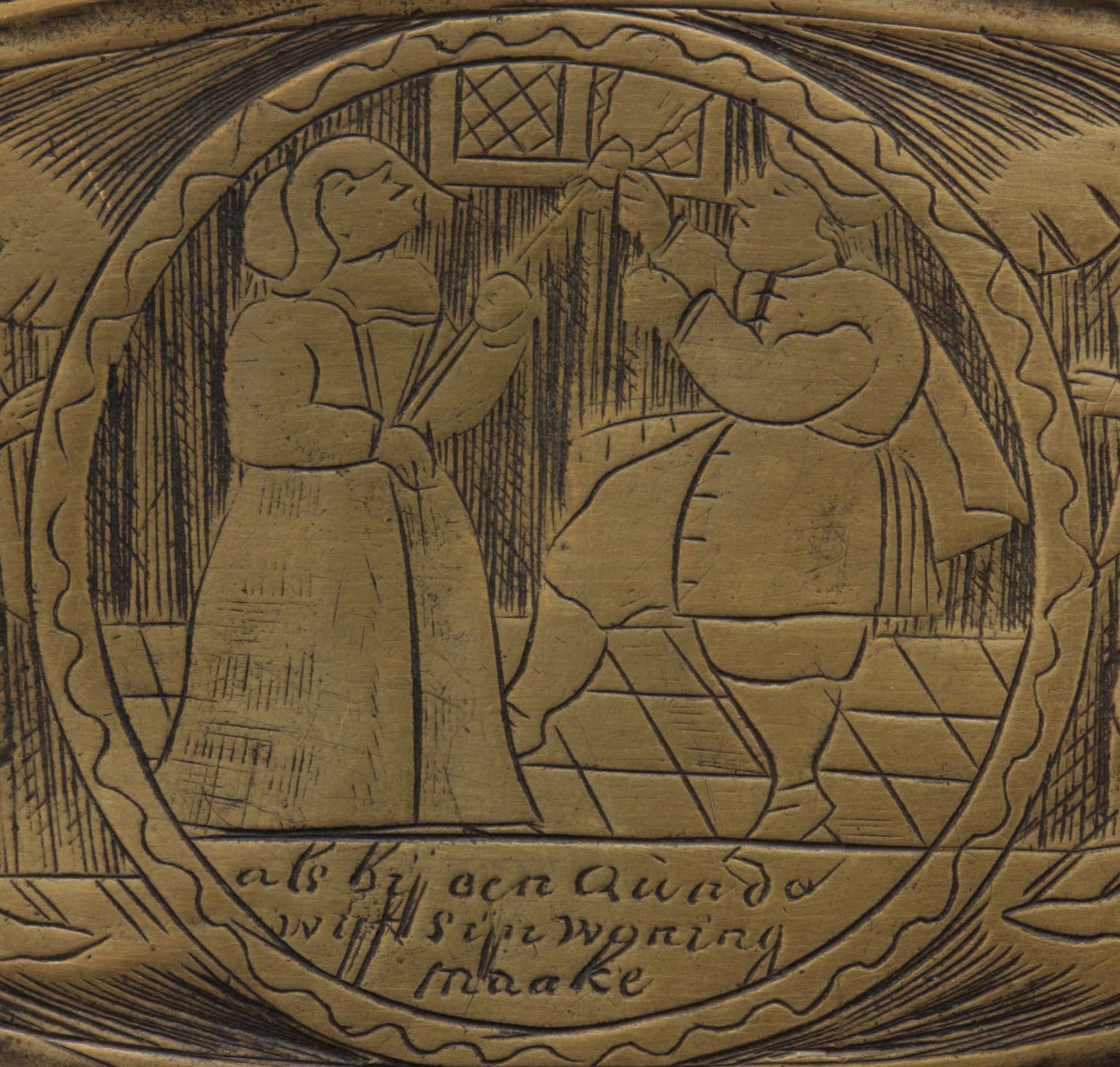
Description: Click here.
Comment: Standard box with a moralizing performance. The fleeting engraving style is evidence of production in large series. The prescription is a boundary layout but is purely ornamental. The two bumpers are provided with a cable pattern as usual. Although over-decorated, the incoherent engraving method emphasizes the simplicity of the box.
It is nice that the closure of the box was adjusted. As a consumer product, this box went to India where it was provided with an extra lock according to the use there. This consists of a single-pivot hinge in which a separate pin is inserted as a locking device. Eventually the box came back as a souvenir in Lisbon.
Origin: the Netherlands
Date: 1720-1740
Collection: Amsterdam, Pijpenkabinet Collections Pk 19.141
Box 12 Miniature
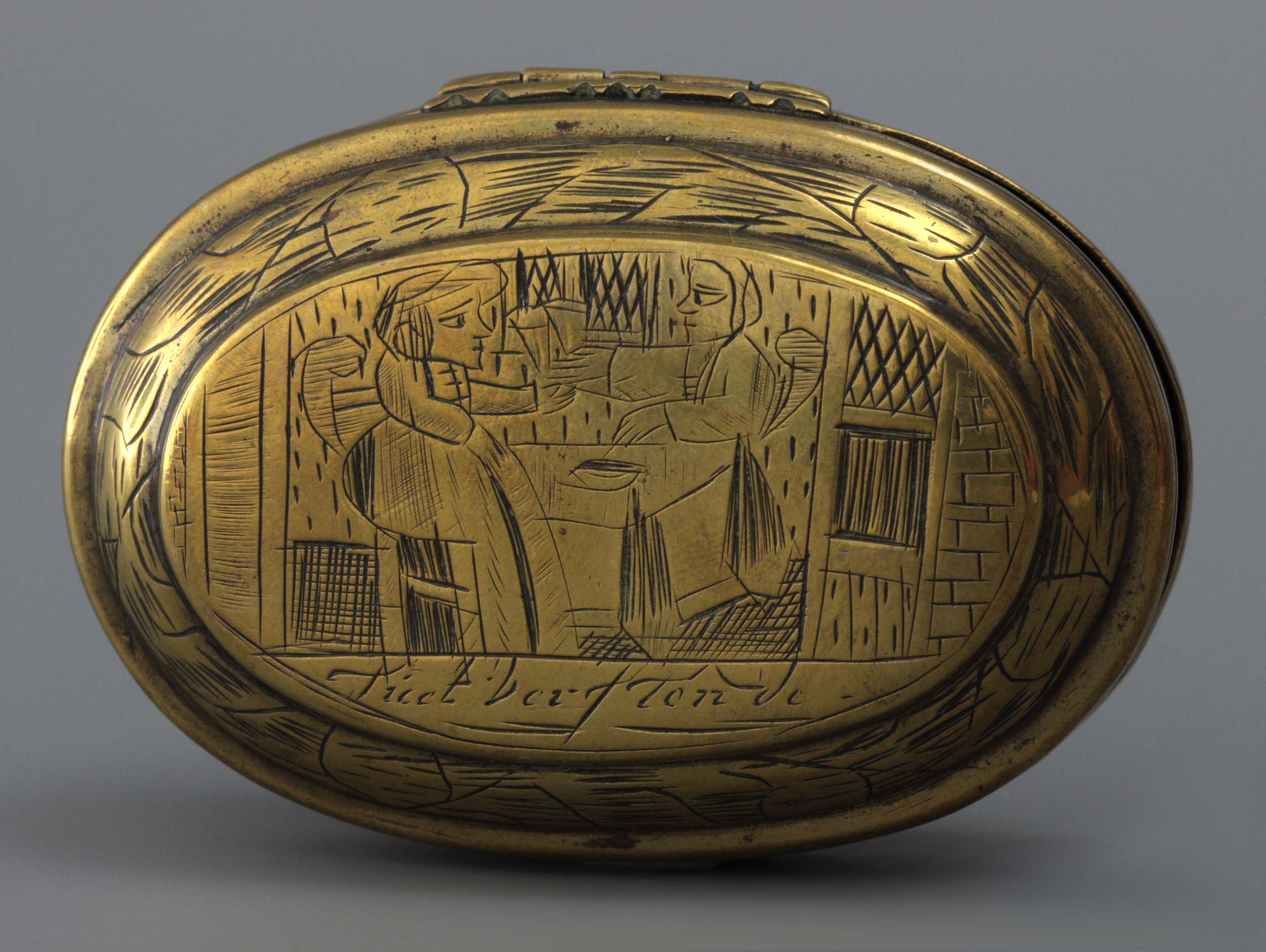
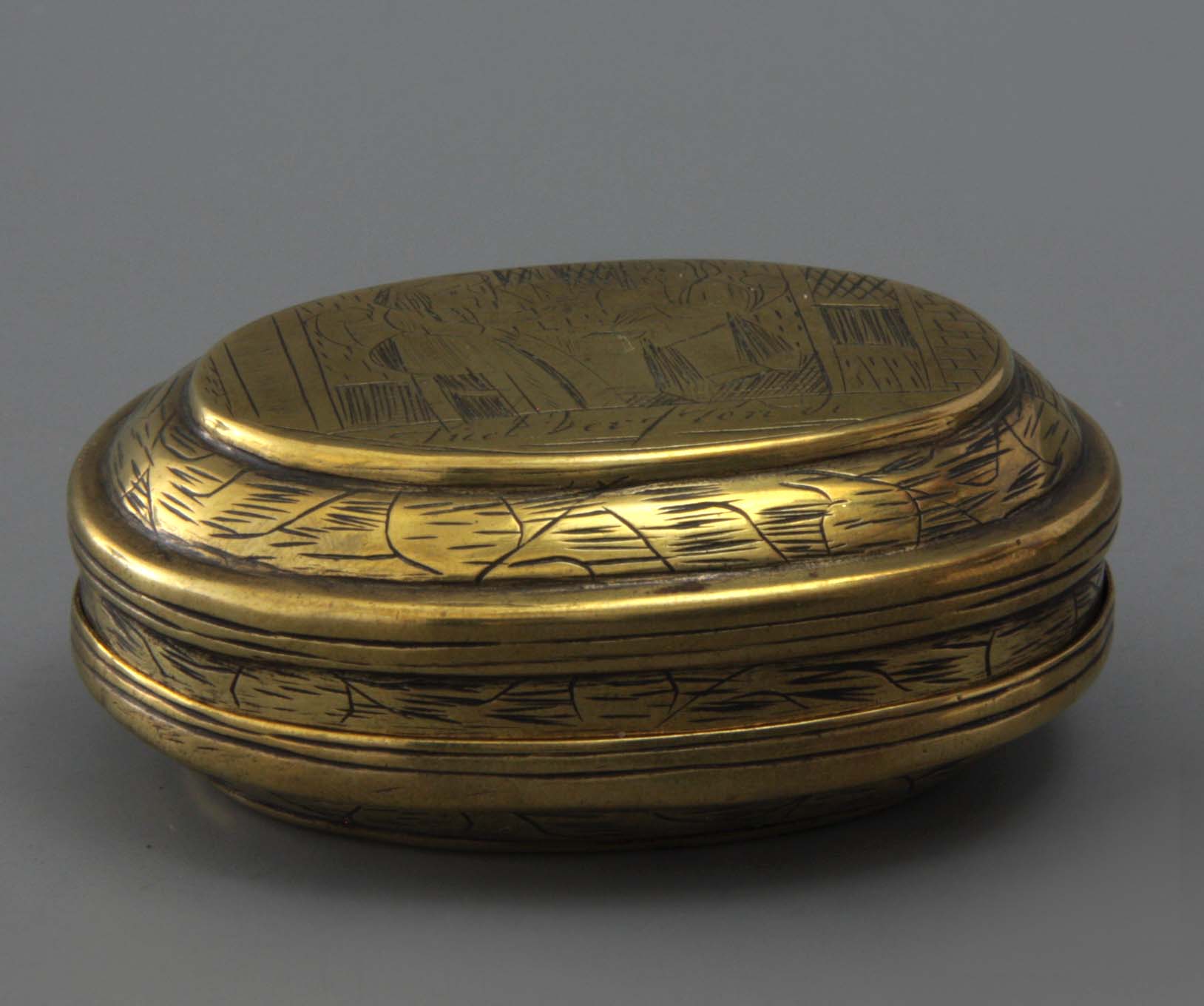
Description: Click here.
Comment: A beautiful example of a tobacco box in small cutlery, both intended as a curiosity and use for a luxury tobacco, for which, in that period, special small-sized pipes were also available. The method of engraving has been adapted to the format here: more fine burins have been used, while the performance has also been simplified.
Origin: the Netherlands
Date: 1720-1760
Collection: Amsterdam, Pijpenkabinet Collections Pk 20.724
Box 13 Susanna spies
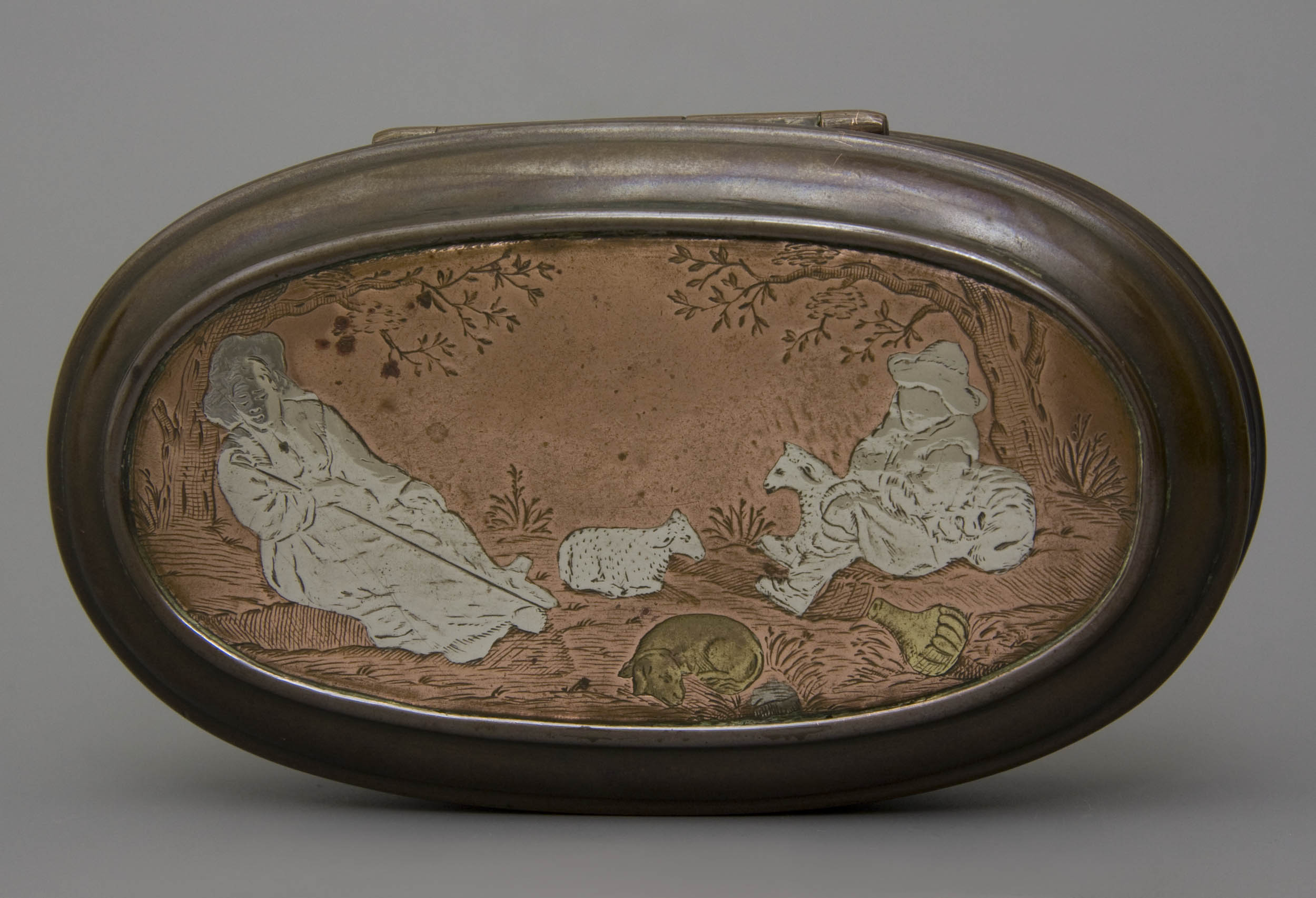
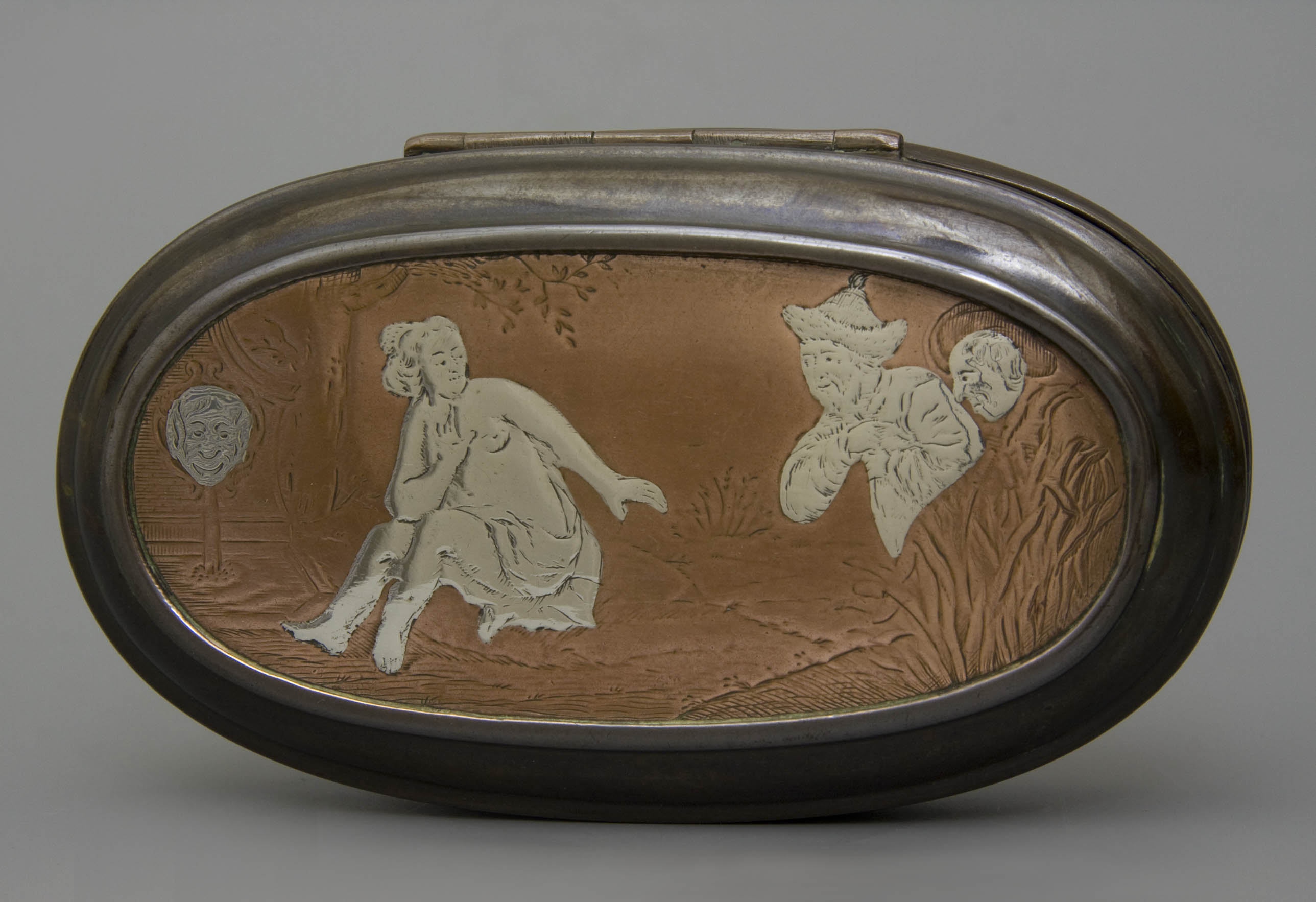
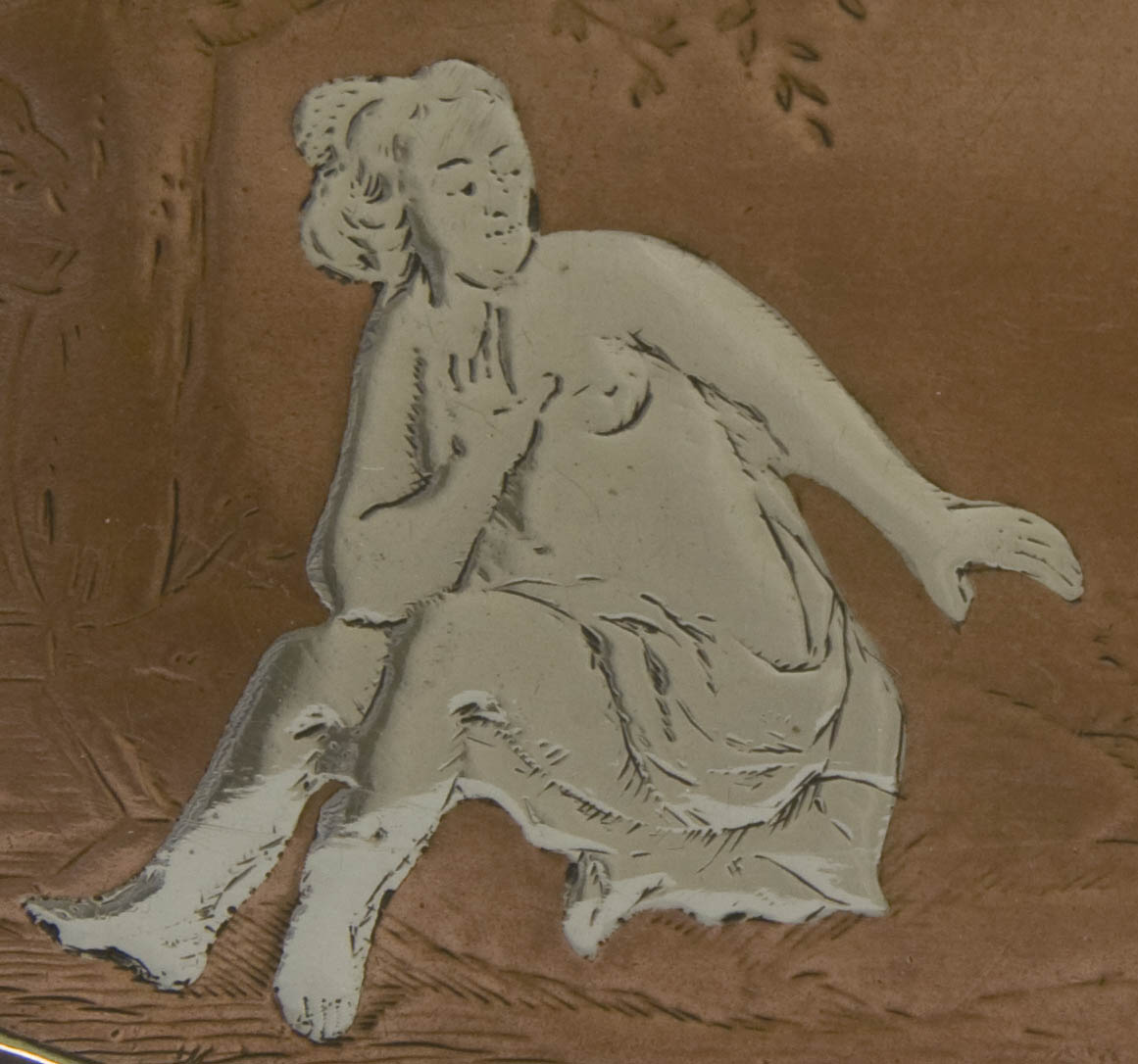
Description: Click here.
Comment: Standard box shape but exceptional due to a specific decoration. First, the box is made of copper, which is not common. Subsequently, it was inlaid on the bottom and the lid with silver, after which a finer, artistic engraving was applied without the usual horror vacuums. This created an unusual effect with a calm appearance, in stark contrast to the overgraved standard box from that period.
Origin: the Netherlands
Date: 1740-1770
Collection: Amsterdam, Pijpenkabinet Collections Pk 16.088
Box 14 Elias and David
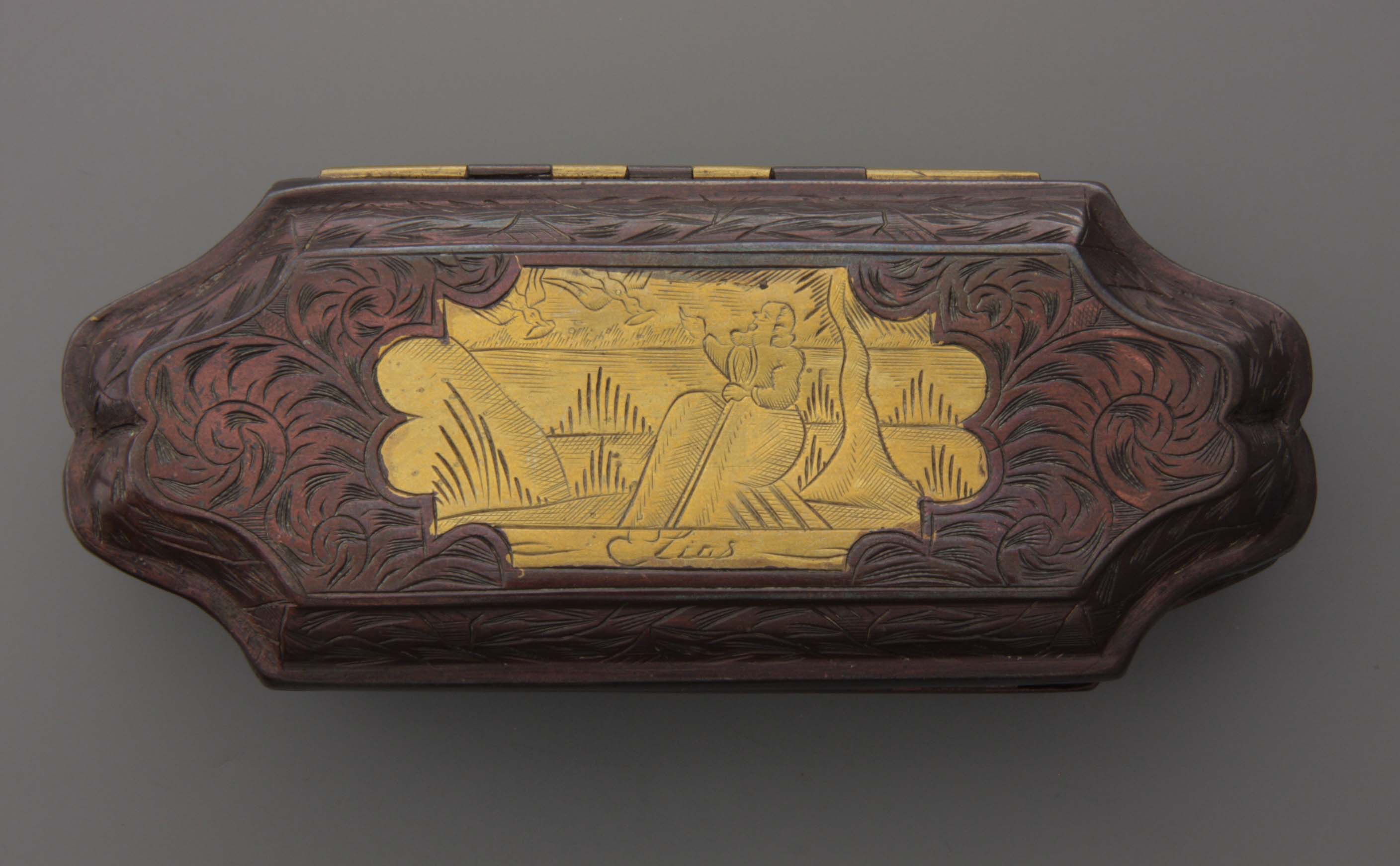
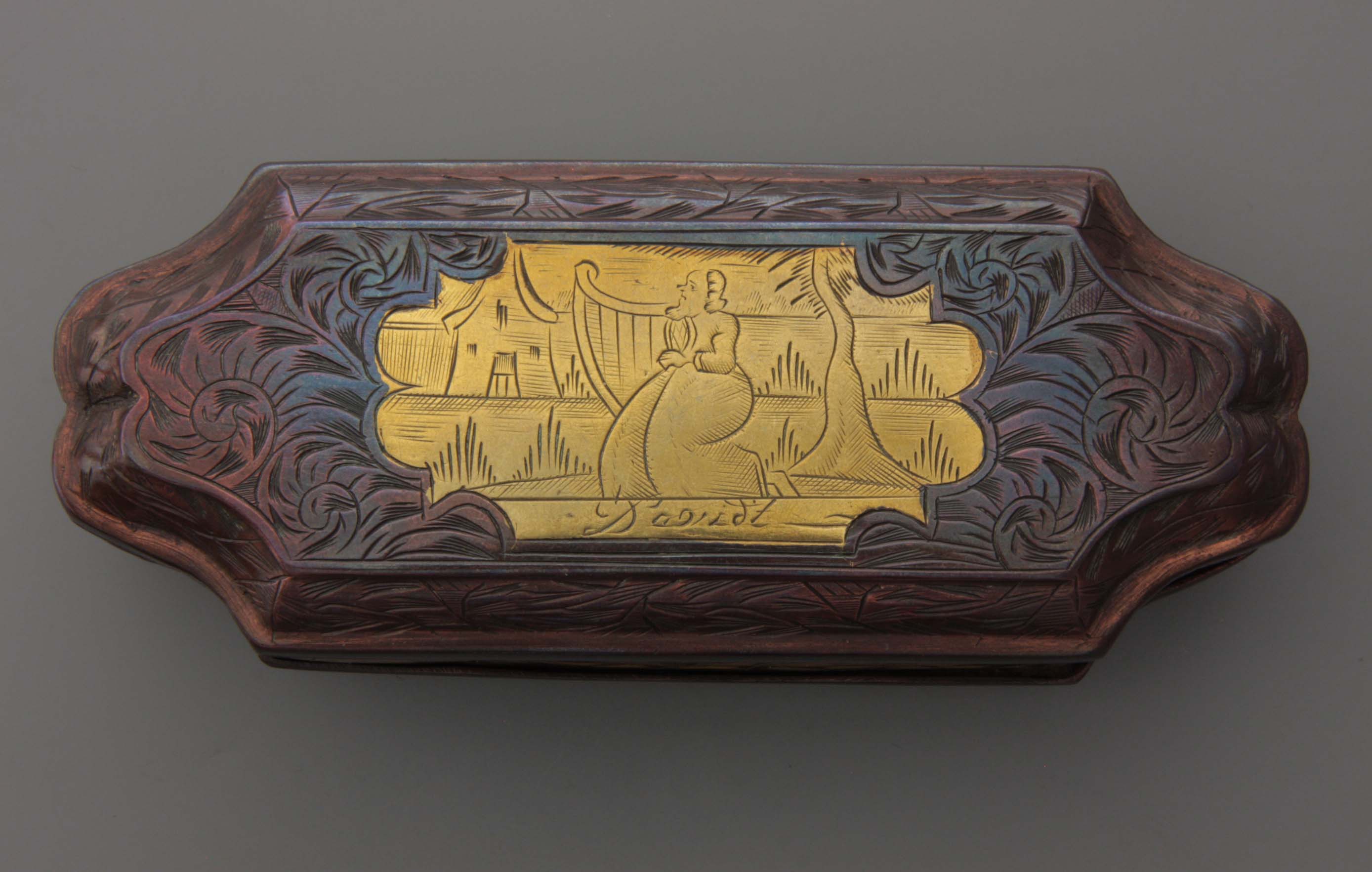
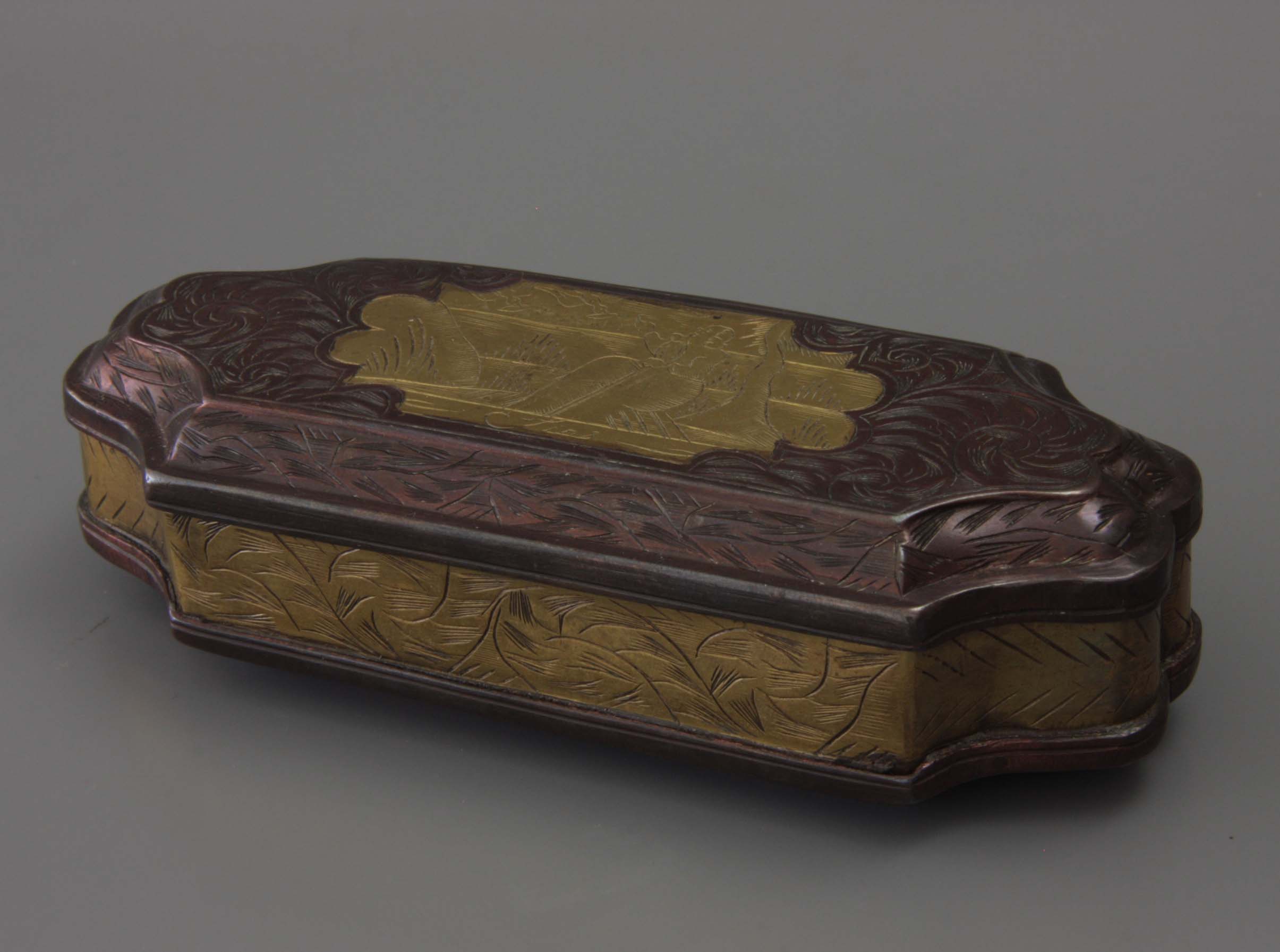
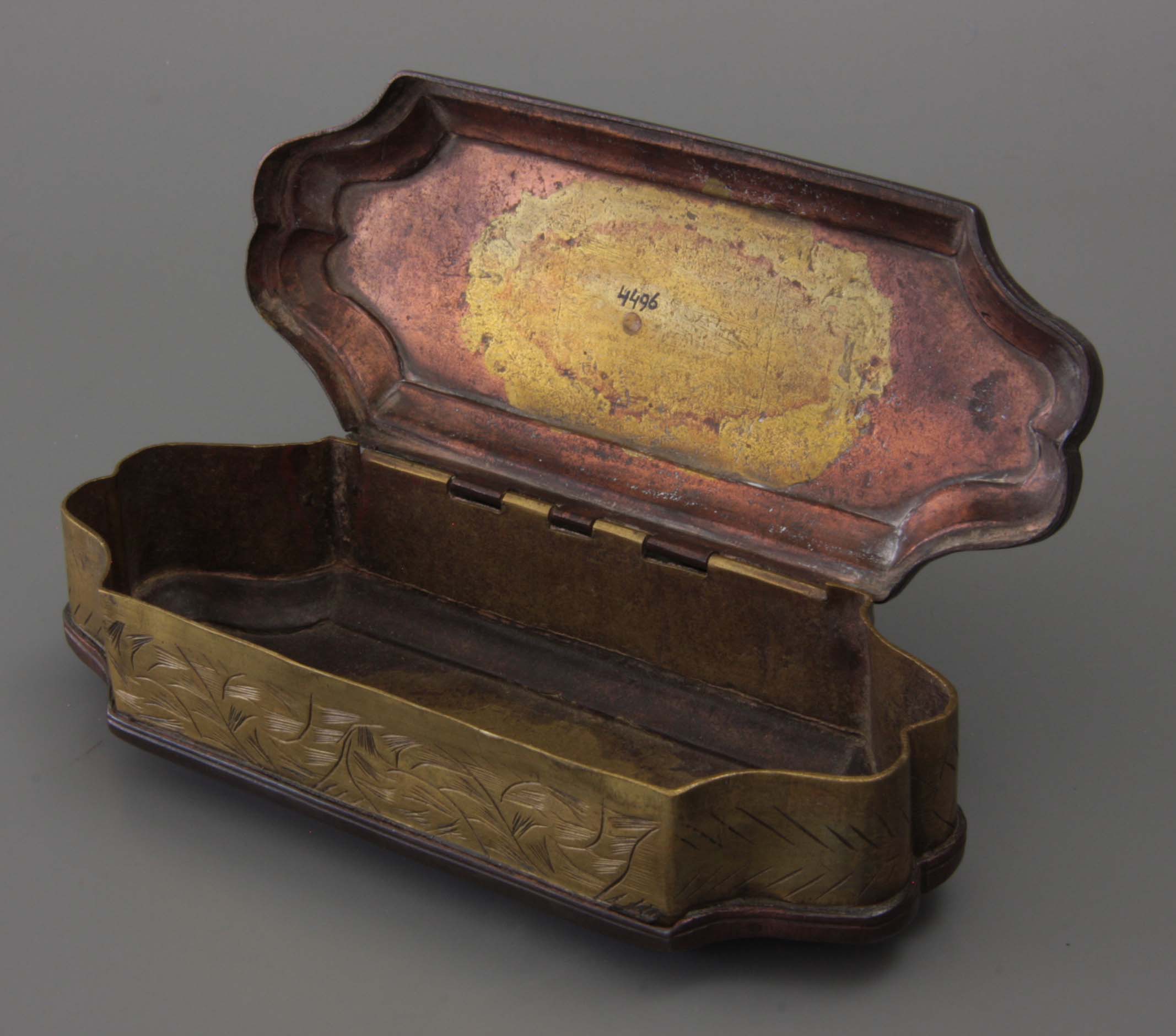
Description: Click here.
Comment: A bible box in two colours copper with a beautiful shape, a heavy execution and a characteristic engraving. The main performances are placed in a modest medallion on the lid and bottom, and these fields have the same contour as the box ends. An ornamental decoration of stylized sheet work is arranged around these fields. The embossed edges are also adorned with elaborately engraved scroll ornaments. The upright edges of the box have stylized leaf motifs on the front, which change to the side and back sides in simple slanting hatchings that have been a considerable saving in work. The state is virtually undamaged and gives a good picture of how a tobacco box looked like a new article at the time.
Origin: the Netherlands
Date: 1740-1760
Collection: Amsterdam, Pijpenkabinet bPk 4.496
Box 15 Seven provinces
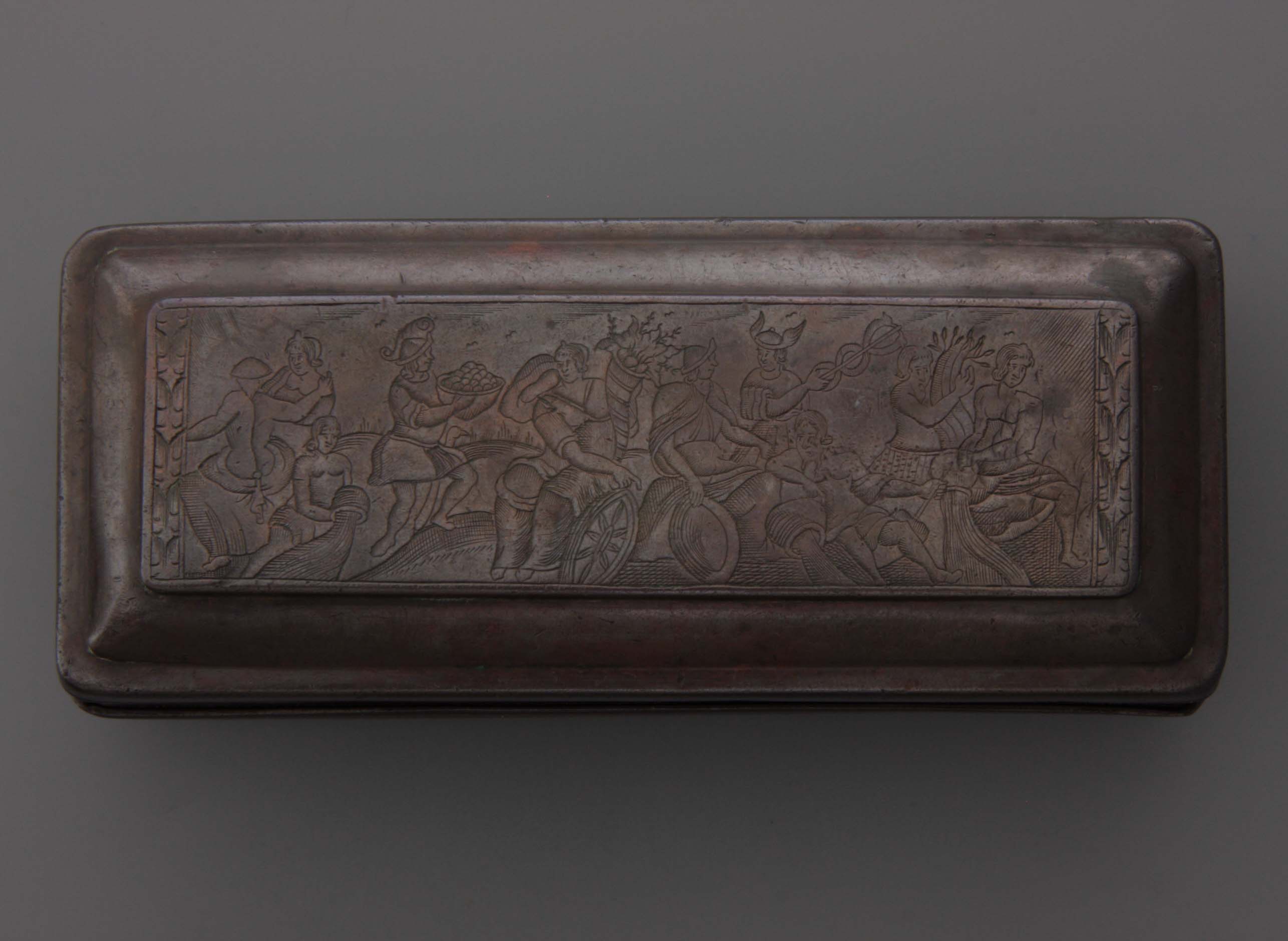
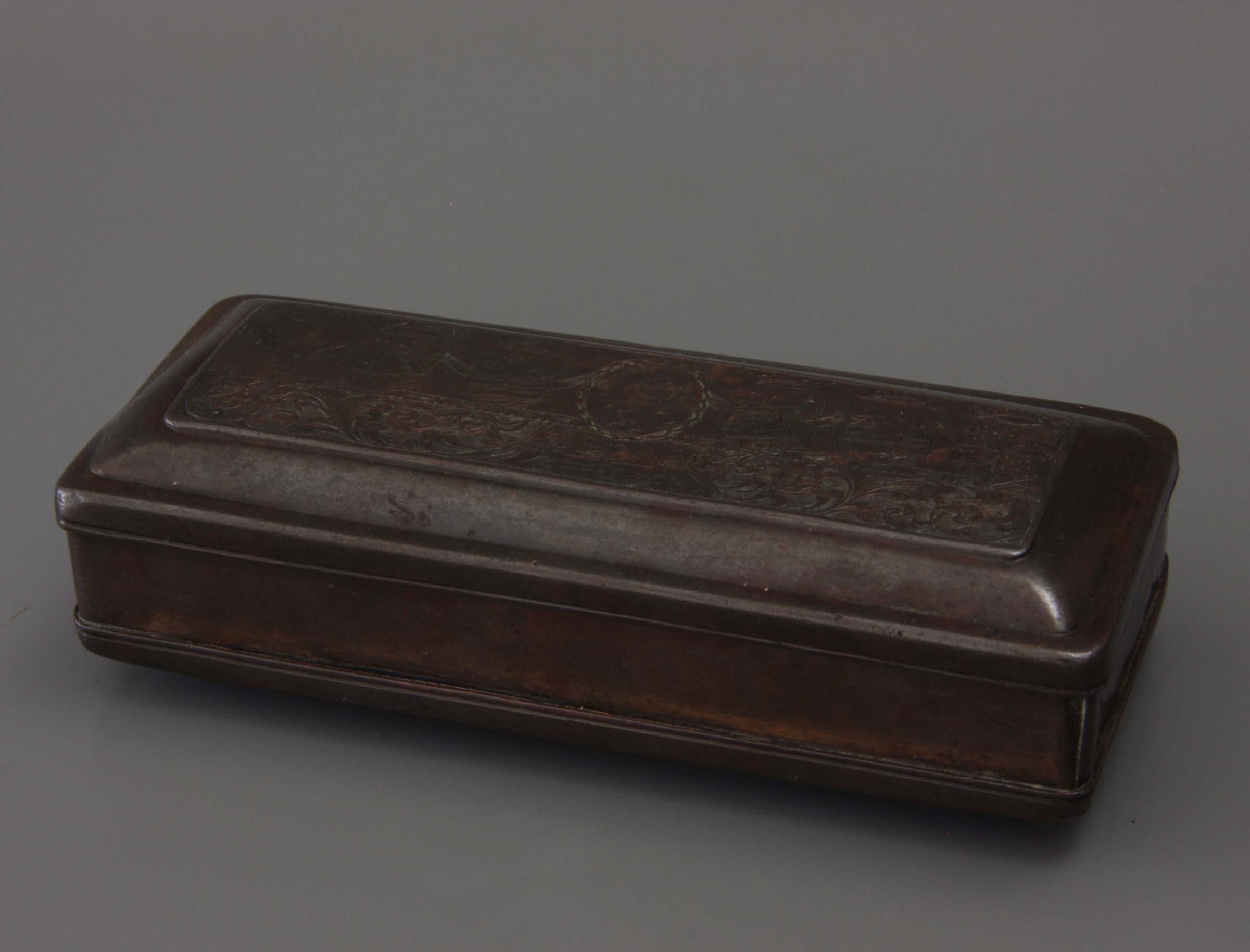

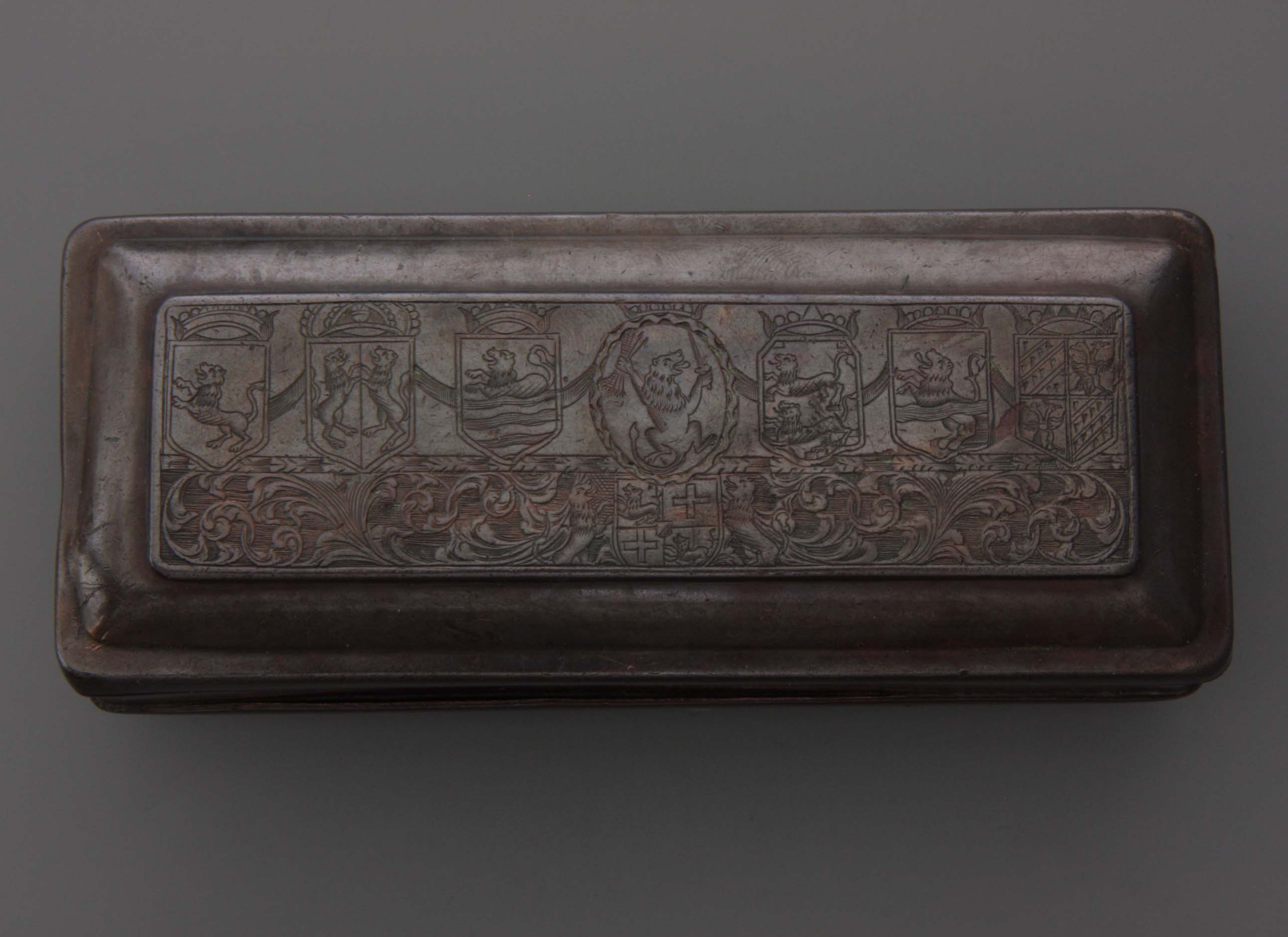
Description: Click here.
Comment: The rectangular shape of this box with a rather compact appearance is provided on the lid and on the bottom with a finely engraved representation, while the edges and the upright side have remained undecorated. In this way a subtle contrast has arisen. The subject is nationalistic in theme. On the lid the weapons of the Seven United Provinces are placed, in a row next to each other, along the bottom edge with ornament work that is centrally broken by the coat of arms of the city of Rotterdam held by standing lions. Although the engraving is fine, the arrangement of the motifs is not very striking. For example, the swinging tendril does not come out optimally because it is placed against a hatched ground. In the heraldry we see unexpected engraving variations, such as the coat of arms of Gelderland, which is placed in a shield with bevelled corners and forms a contrast with the other shields. This indicates separate engraving examples that are not synchronized to a unit when copying. Some variation can also be seen in the crowns of the coats of arms. The coat of arms of the province of Holland is central and has been placed in an oval to emphasize the importance of this province. The lion with this weapon is displayed very freely: it is seen from behind instead of sideways and that is from heraldic point of view an unacceptable freedom.
The attractive engraving work speaks mainly from the bottom of the box, with an allegorical representation dedicated to the well-being of the Seven Provinces. Neptune and the Dutch Virgin are worshiped here and all kinds of gifts are offered. This box, although not directly assigned to the stadholder, still exudes the hint of a rising Orangism. It is also remarkable that there is no text on the box.
The subtle engraving on this modest box is a big contrast with comparable boxes from the same period. The quality of the box is evident not only from the engraving but also from the careful hinge with no less than six jaws. Surprisingly, this hinge is not made from the upright side of the lid, but it is soldered loose. It seems that something went wrong with the cutting and bending of the sleeves, which led to this solution.
Origin: Rotterdam?
Date: 1730-1750
Collection: Amsterdam, Pijpenkabinet Collections Pk 18.461
Box 16 Sliders with hidden scenes
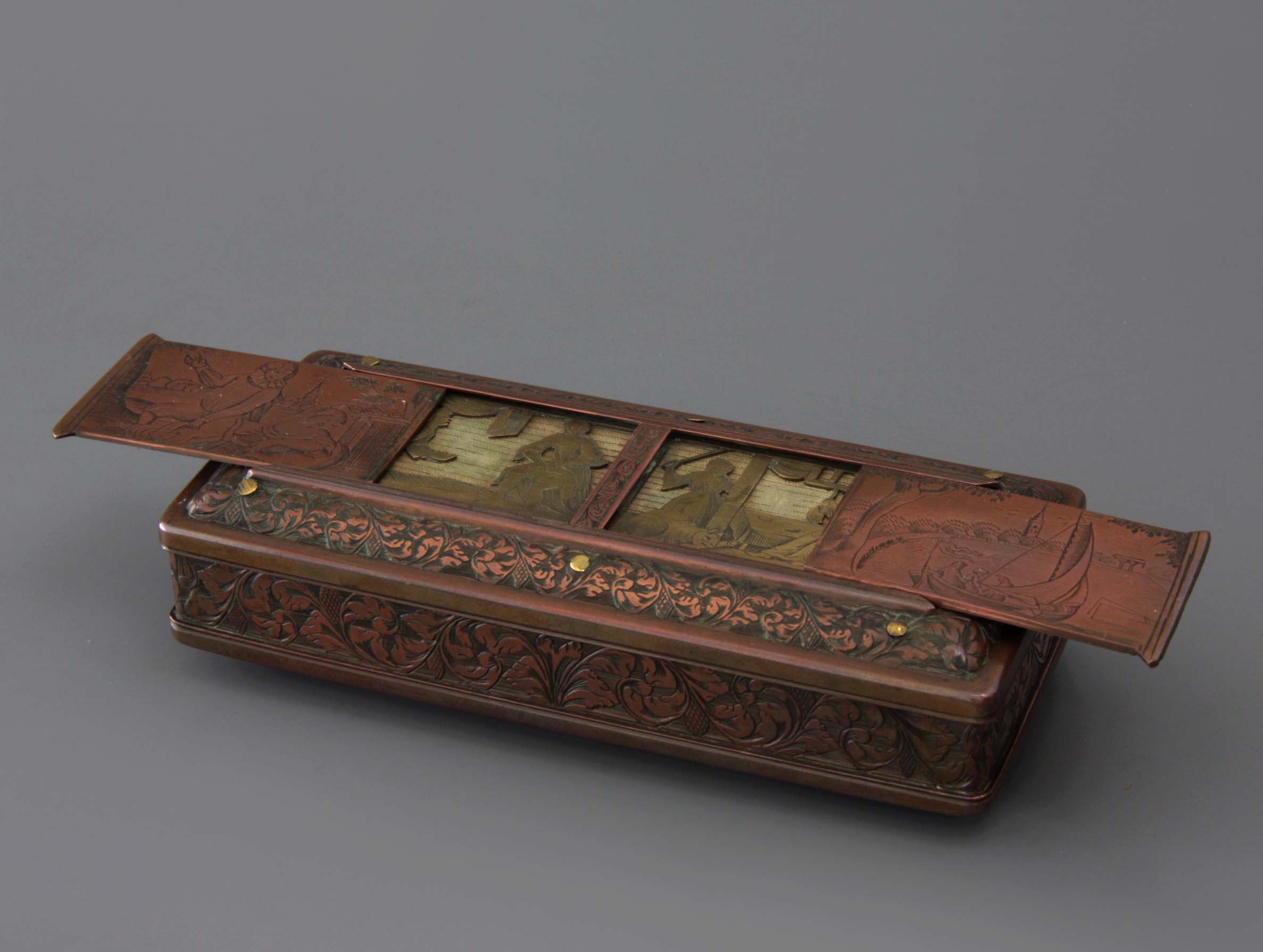
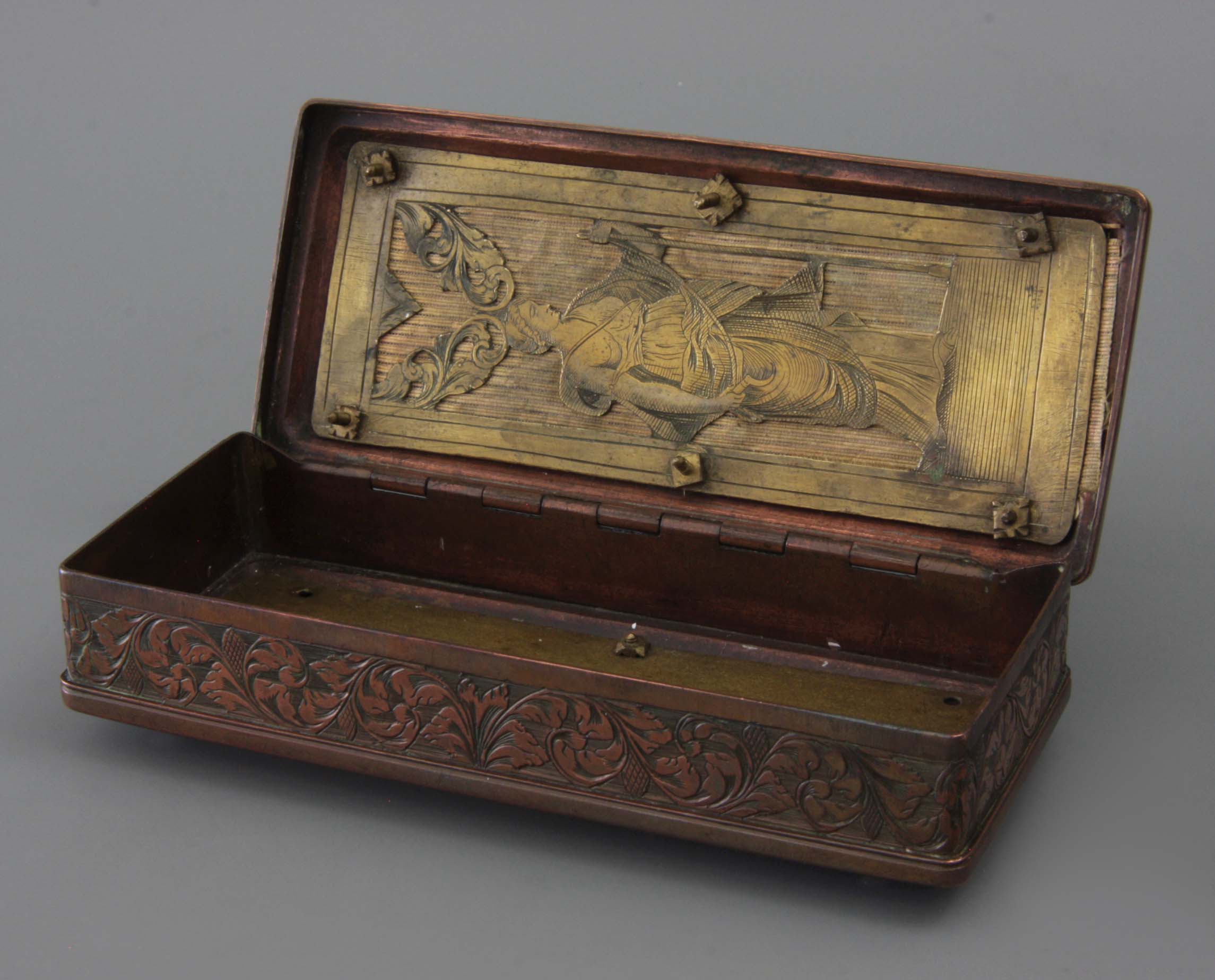
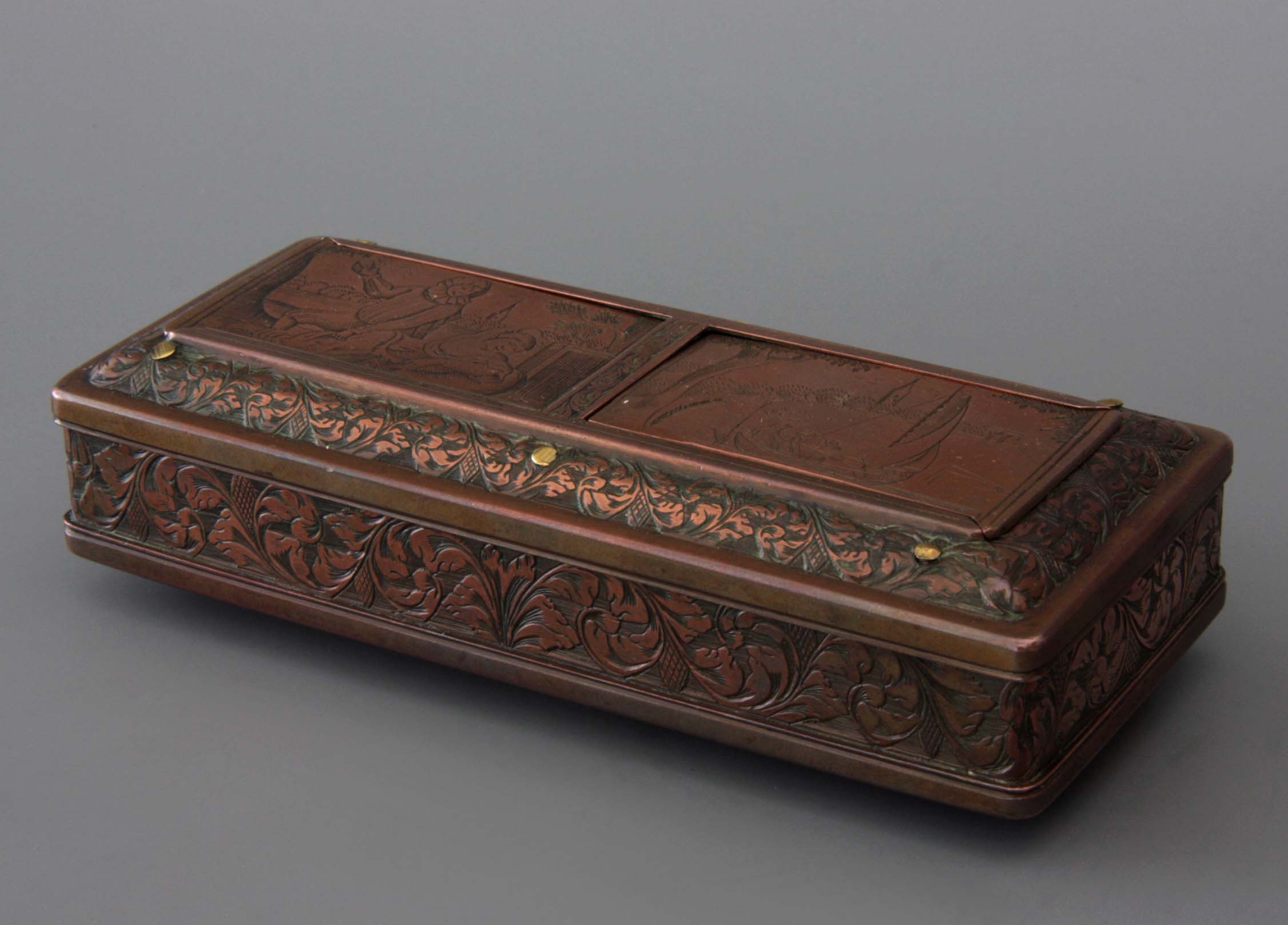
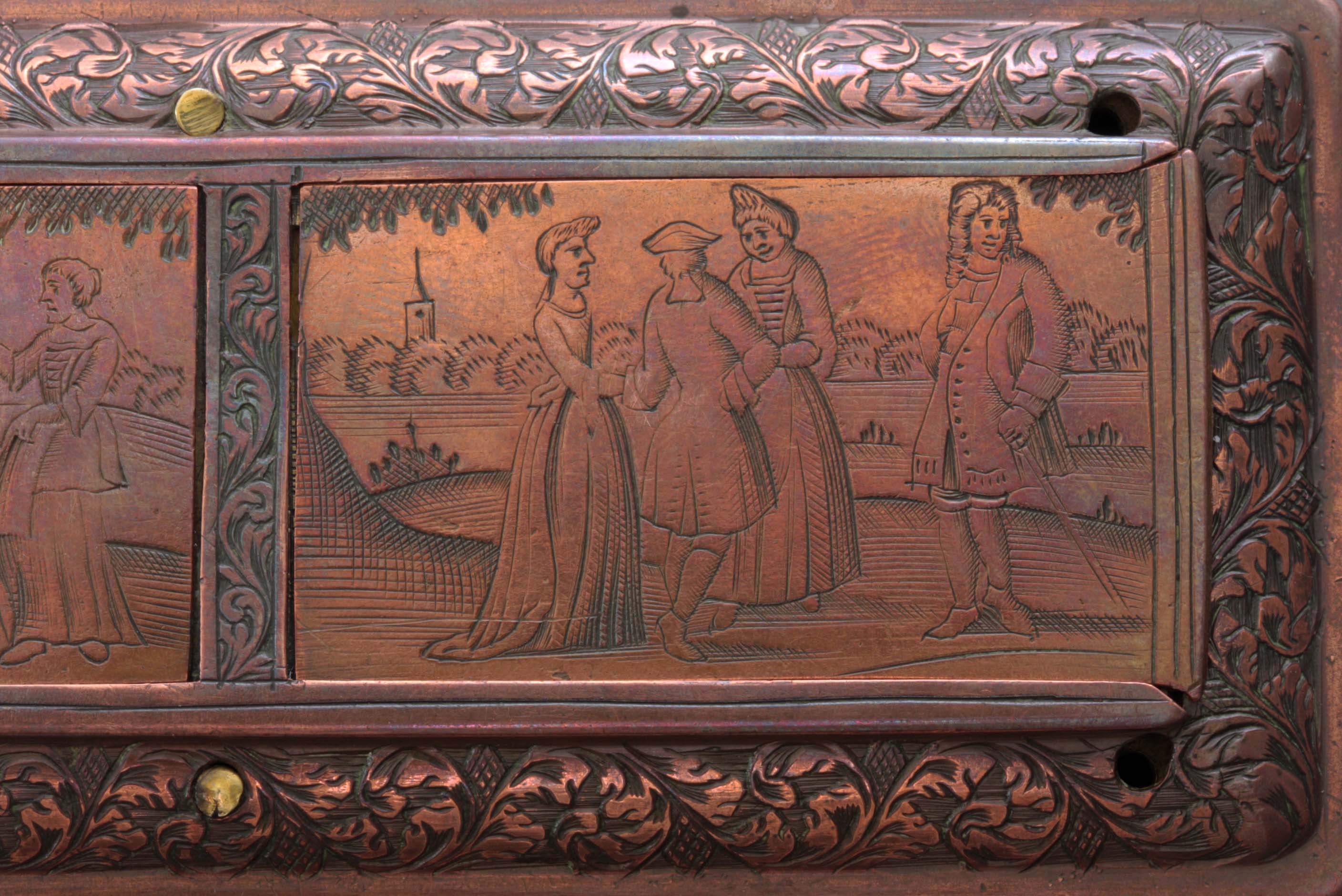
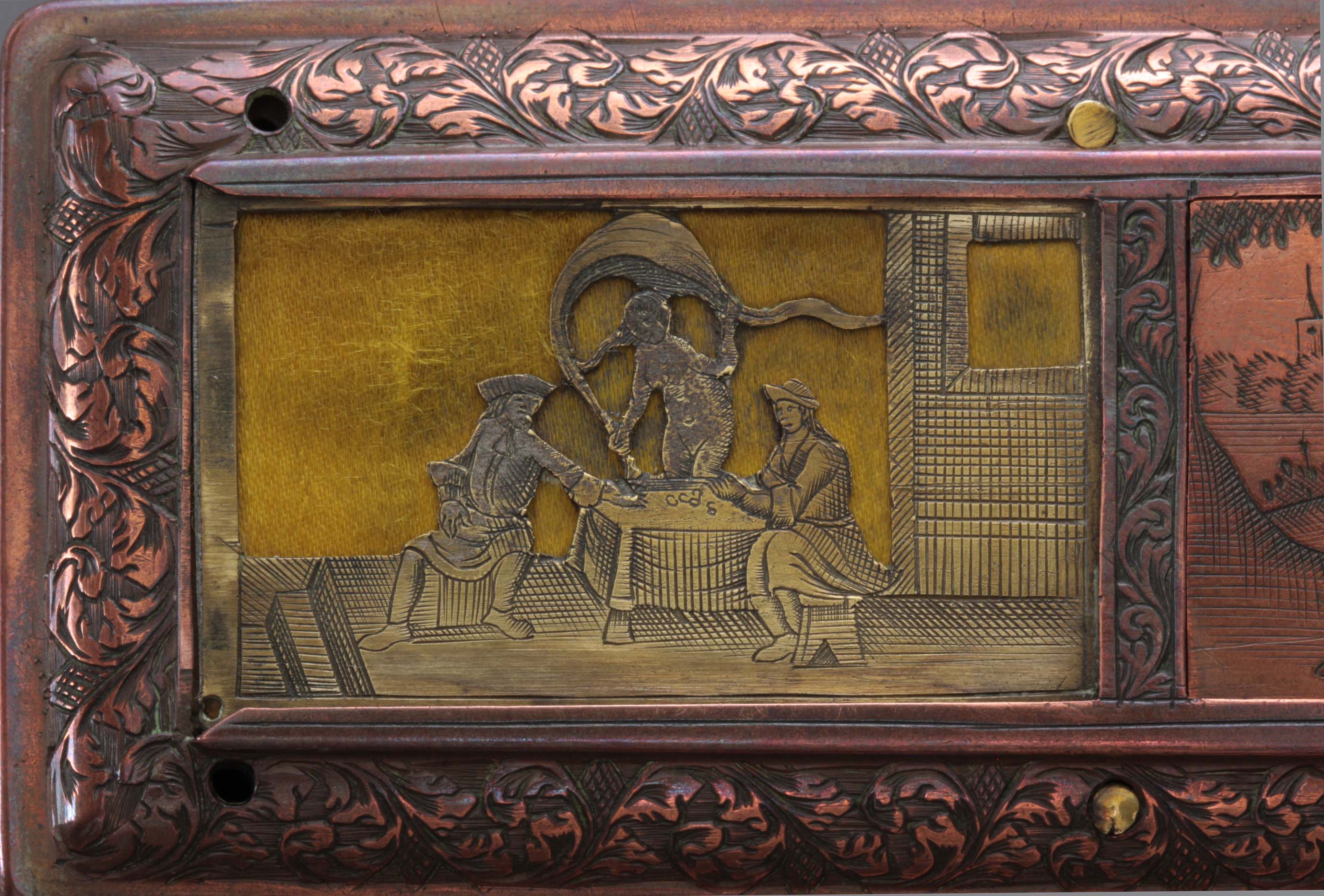
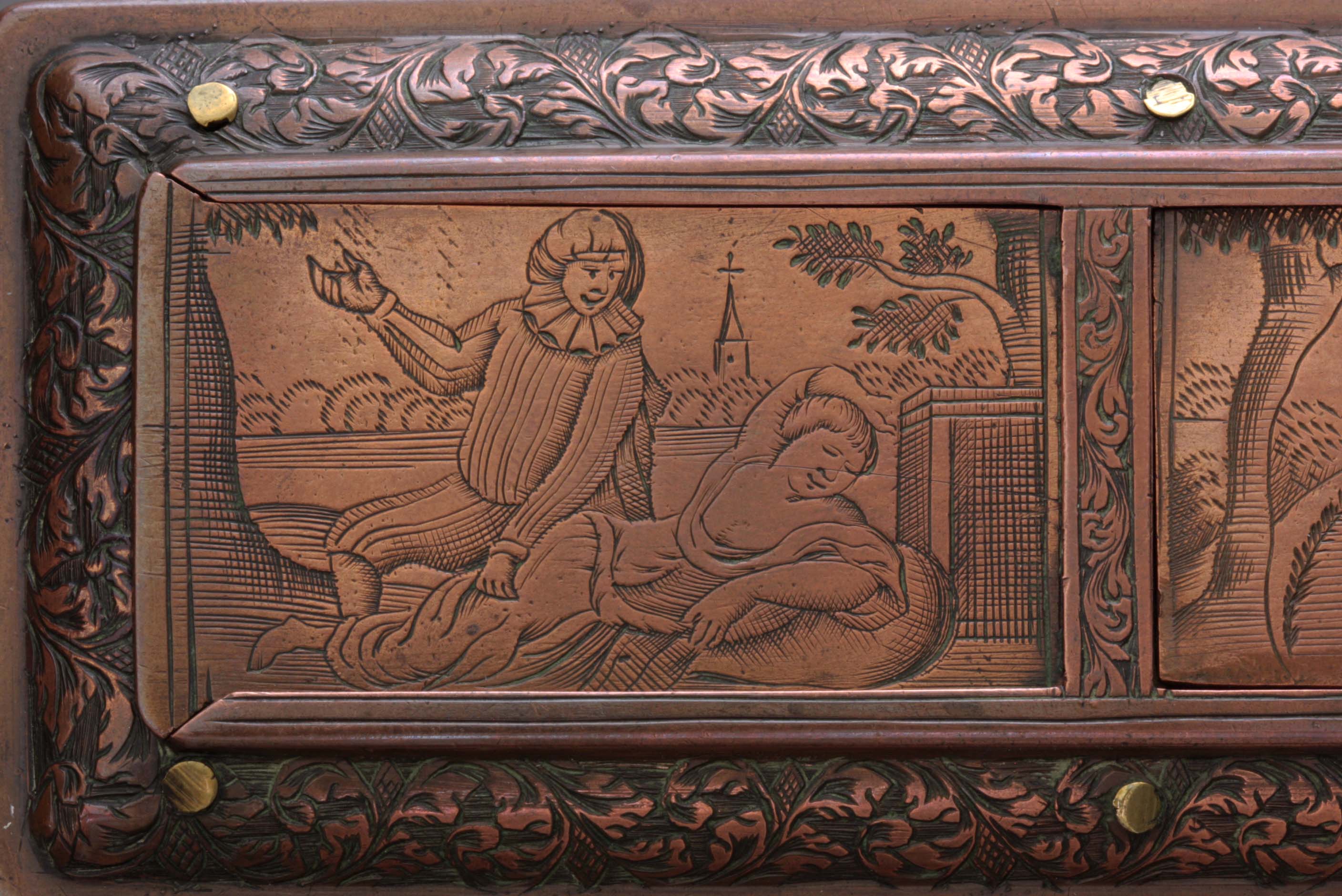
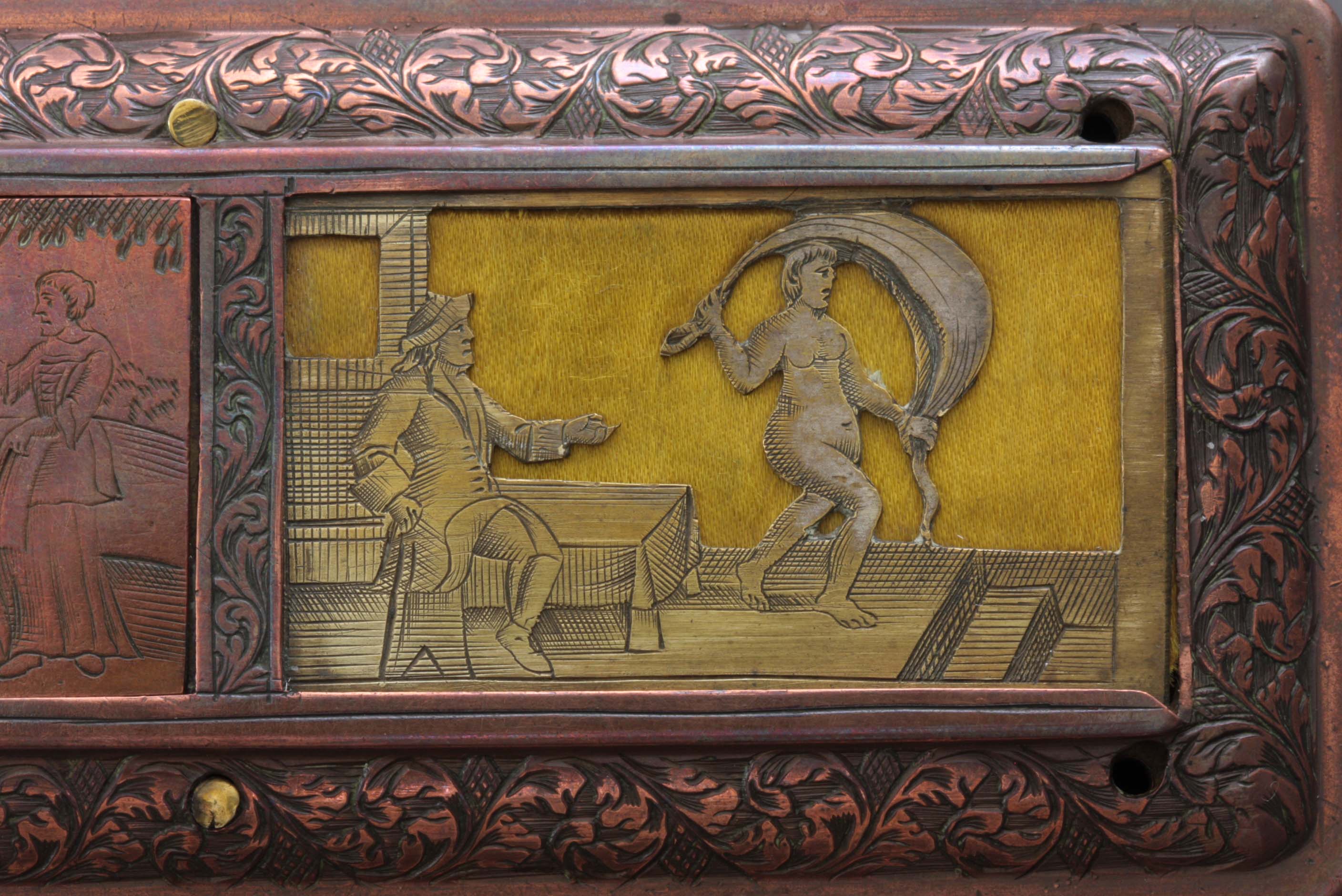
Description: Click here.
Comment: An extraordinarily luxurious box from the heyday of the engraving and then on the rectangular box (Cat. 15). Bottom and lid each have two sliders with gallant representations behind which, when they are pushed away, a representation with erotic hue becomes visible. On the inside of this box the lid is internally decorated with sawing in which a standing woman with staff and sickle is depicted. Incidentally, this theme only fits in moderately with the erotic story behind the four sliders. It is a showcase, more of a display piece for the nouveau riche than a consumer item.
Origin: the Netherlands
Date: 1740-1760
Collection: Amsterdam, Pijpenkabinet Collections Pk 20.725
Box 17 Cattle plague
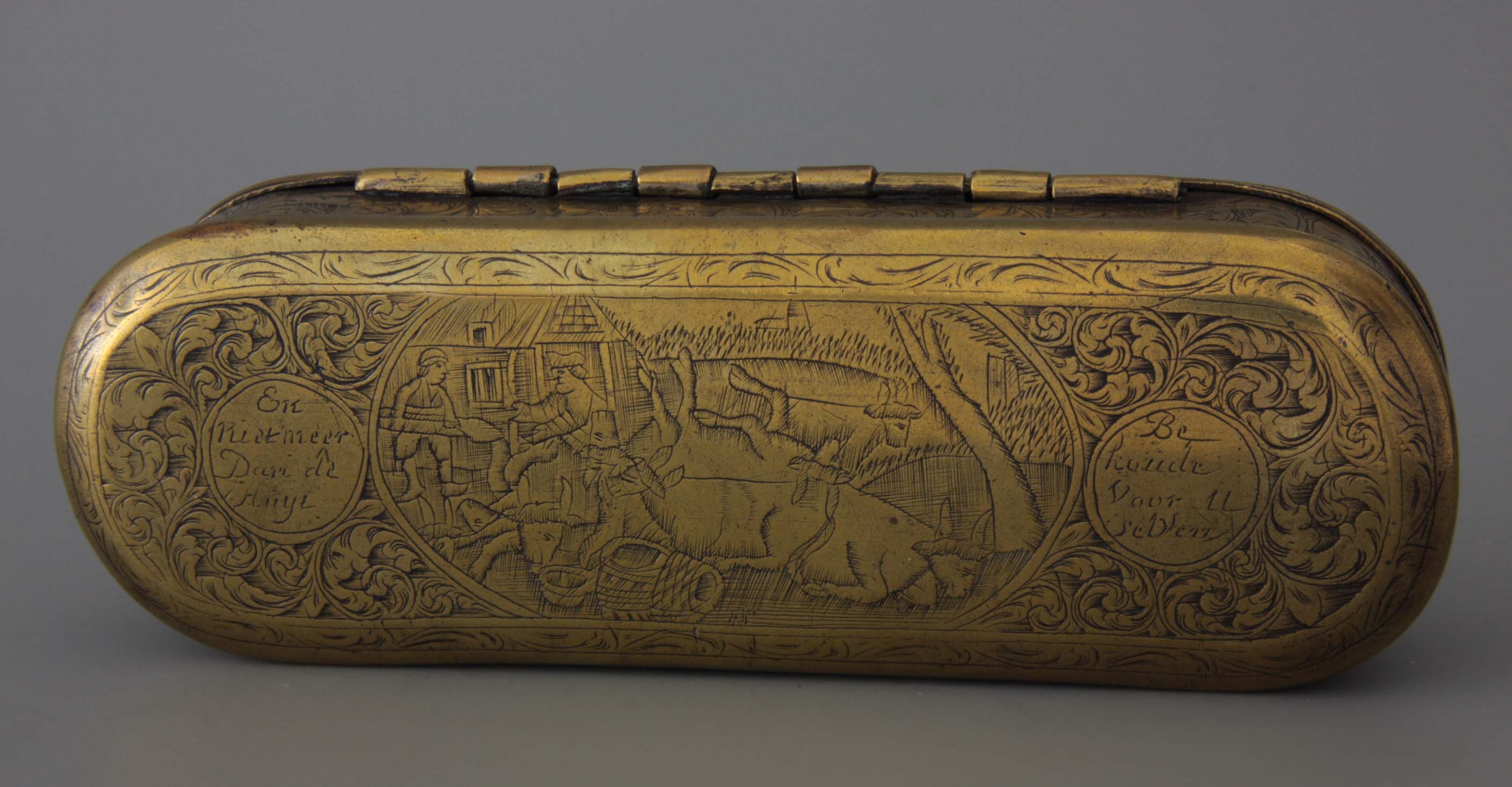
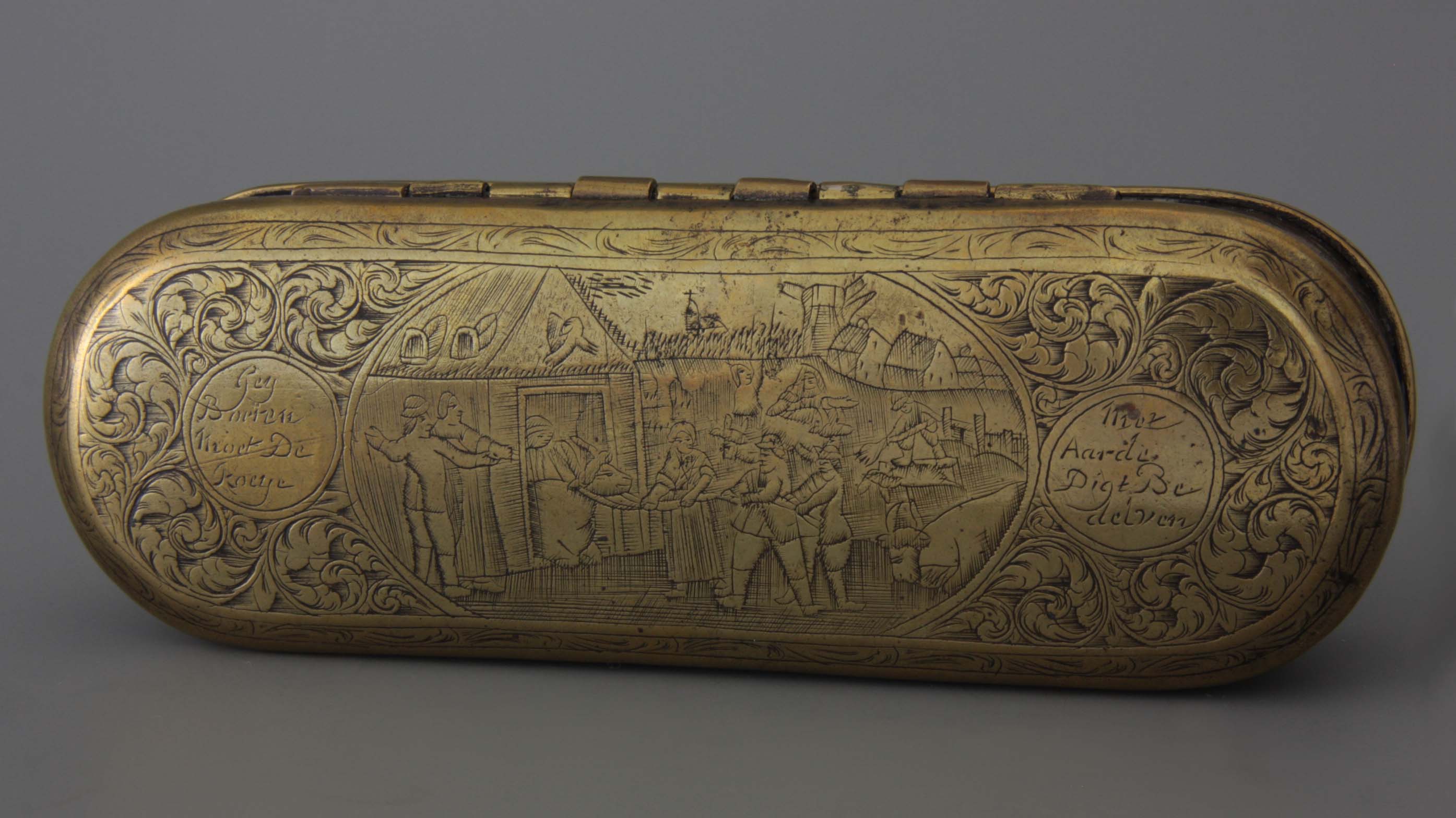
Description: Click here.
Comment: Striking is the exceptionally heavy version of the brass plate.
The representation on the bottom was engraved from a print released in 1745. According to Brongers this tobacco box was made in Amsterdam between 1719 and 1726 when the cattle plague ruled there, but that is not possible given the engraving example. In the eighteenth century, however, our area was hit by three cattle plague, namely from 1713-1720, from 1744-1765 and from 1768-1786. The sturdy size of the box is in line with a later date.
Origin: Amsterdam?
Date: 1745-1765
Collection: Amsterdam, Pijpenkabinet Collections Pk 20.727
Box 18 Nautical box from Holm
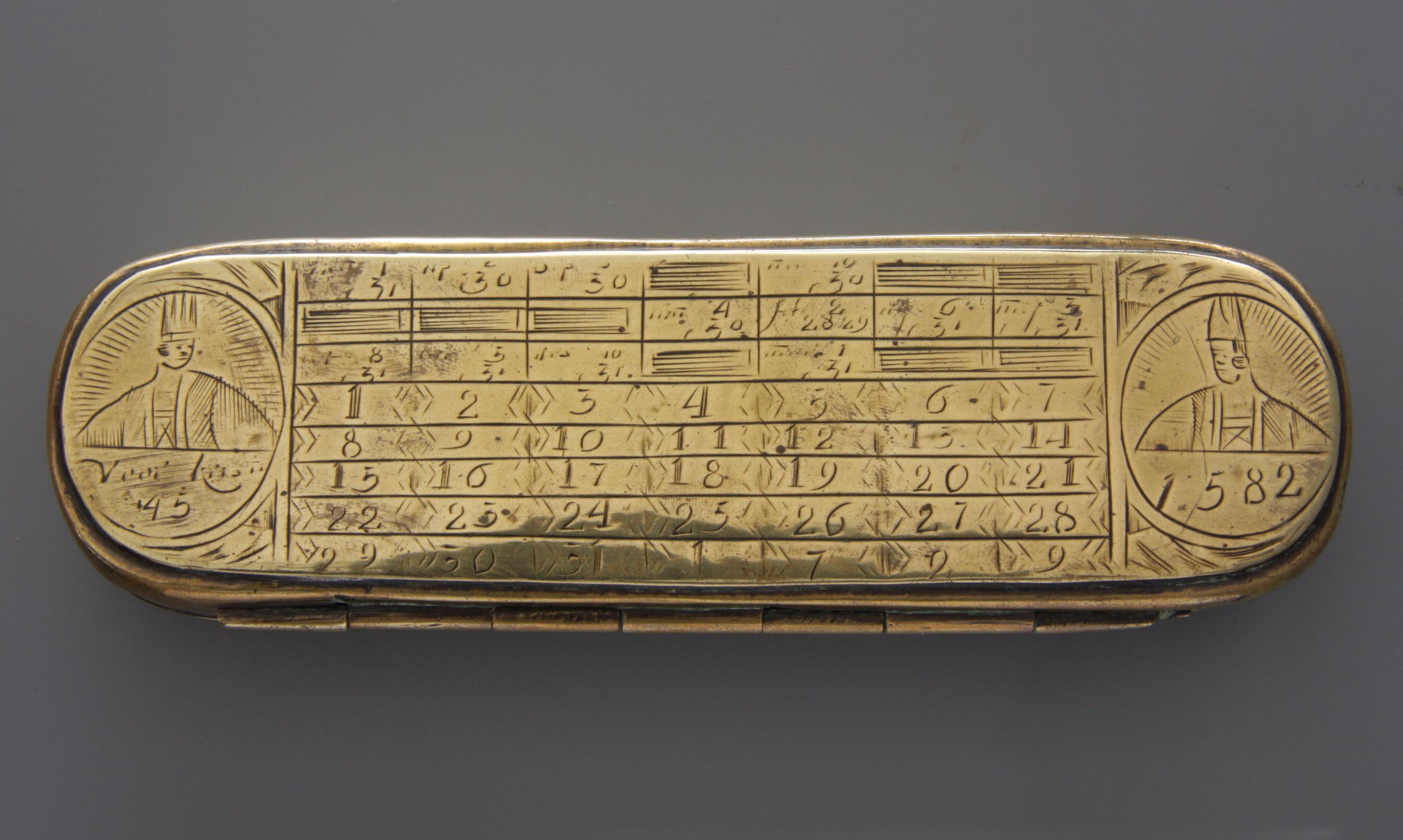
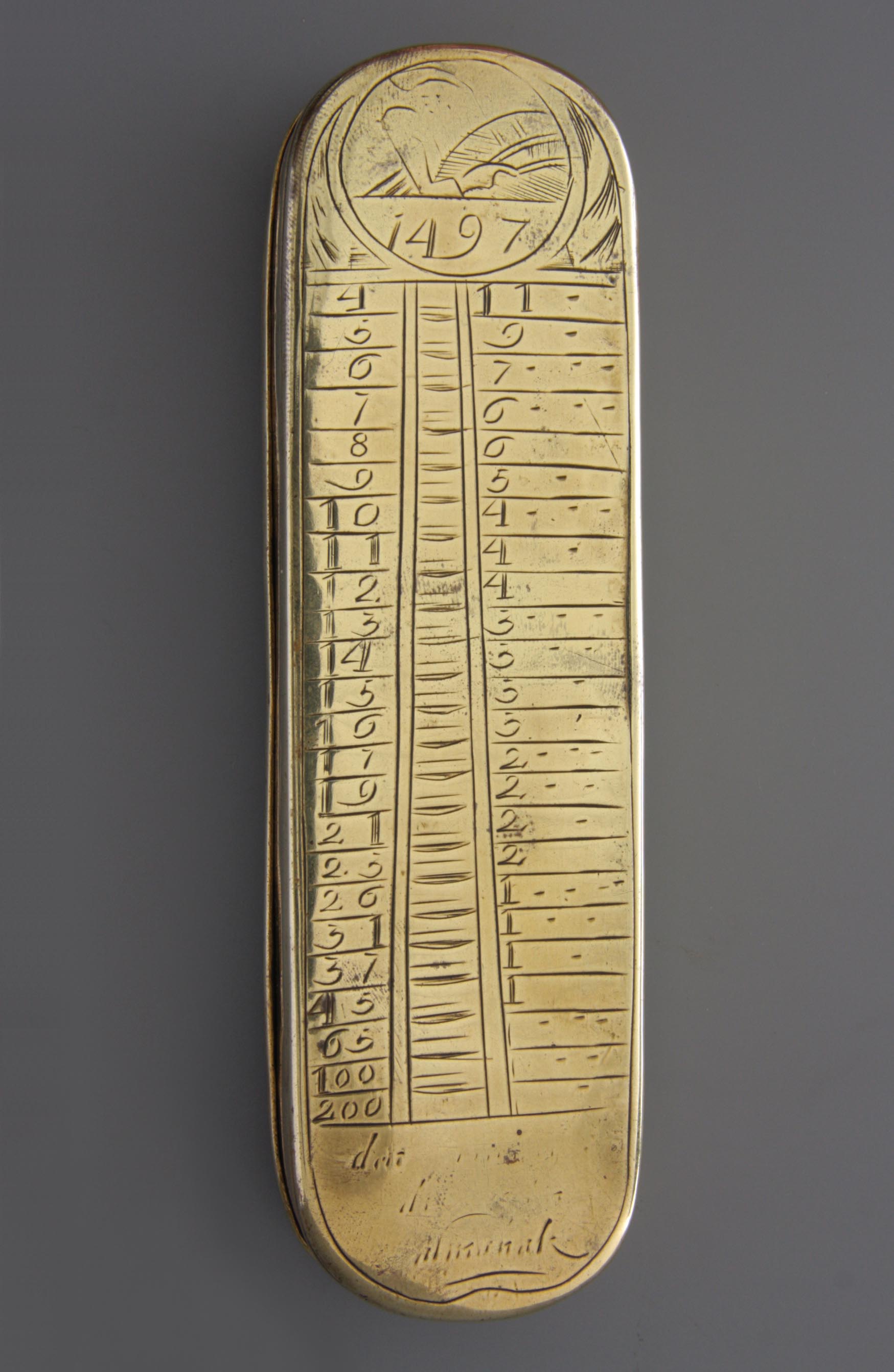
Description: Click here.
Comment: The so-called Holm-box is said to have been put into circulation from 1728 by Pieter Holm, a Swedish merchant who settled in Amsterdam. This sailor from Sweden led a nautical school in Amsterdam and also sold tickets, nautical instruments and apparently also tobacco boxes. After his death in 1776, the production of these boxes was continued by his pupil Arend Swieter. In view of the general appearance and the routed manufacturing method, however, it must be the work of an ordinary tobacco box maker working in Amsterdam. Quite unexpectedly, the last four digits on the table represent the dating of the tobacco box, here the year 1729 or an early example.
It is a characteristic engraving in hundreds of perhaps a few thousand copies performed on behalf of Pieter Holm. In artistic terms, there is not much to do with these boxes. Almost without exception they show the perpetual calendar on one side and a table on the other to calculate the speed of the ship. On either side of the tables are the circular portraits of Julius Caesar, Roman emperor with the year "FOR KRIST 45" and that of Pope Gregory and the year "1582". In a number of cases the year 1482 was erroneously engraved. Both portraits indicate the Julian and Gregorian time calculations. Small and especially flat copy that also fits well with the early elongated box. It is heavy-duty and therefore durable and durable.
Origin: Amsterdam
Date: 1729-1730
Collection: Amsterdam, Pijpenkabinet Collections Pk17.128
Box 19 Stadtholder portrait and stadtholder's coat of arms

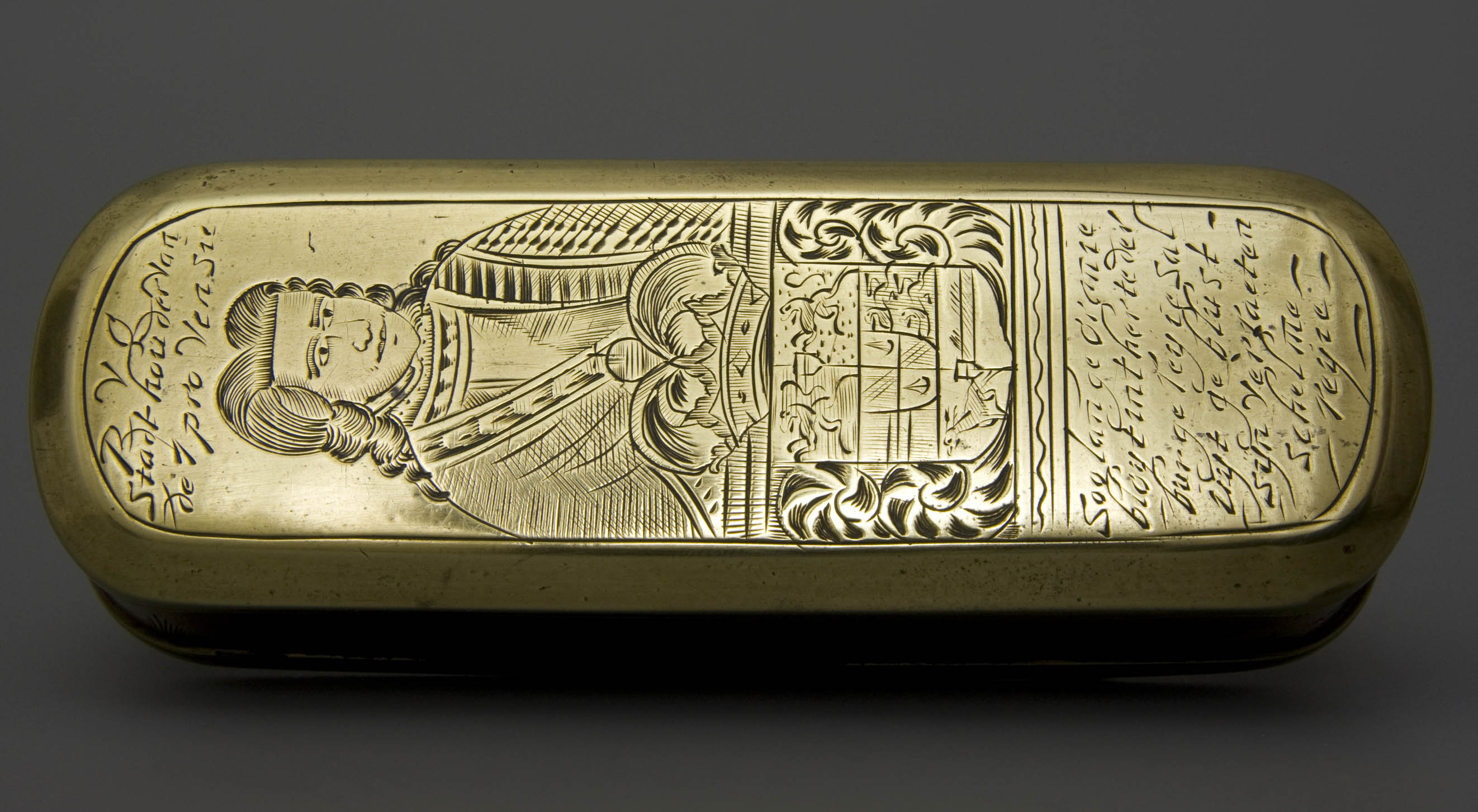
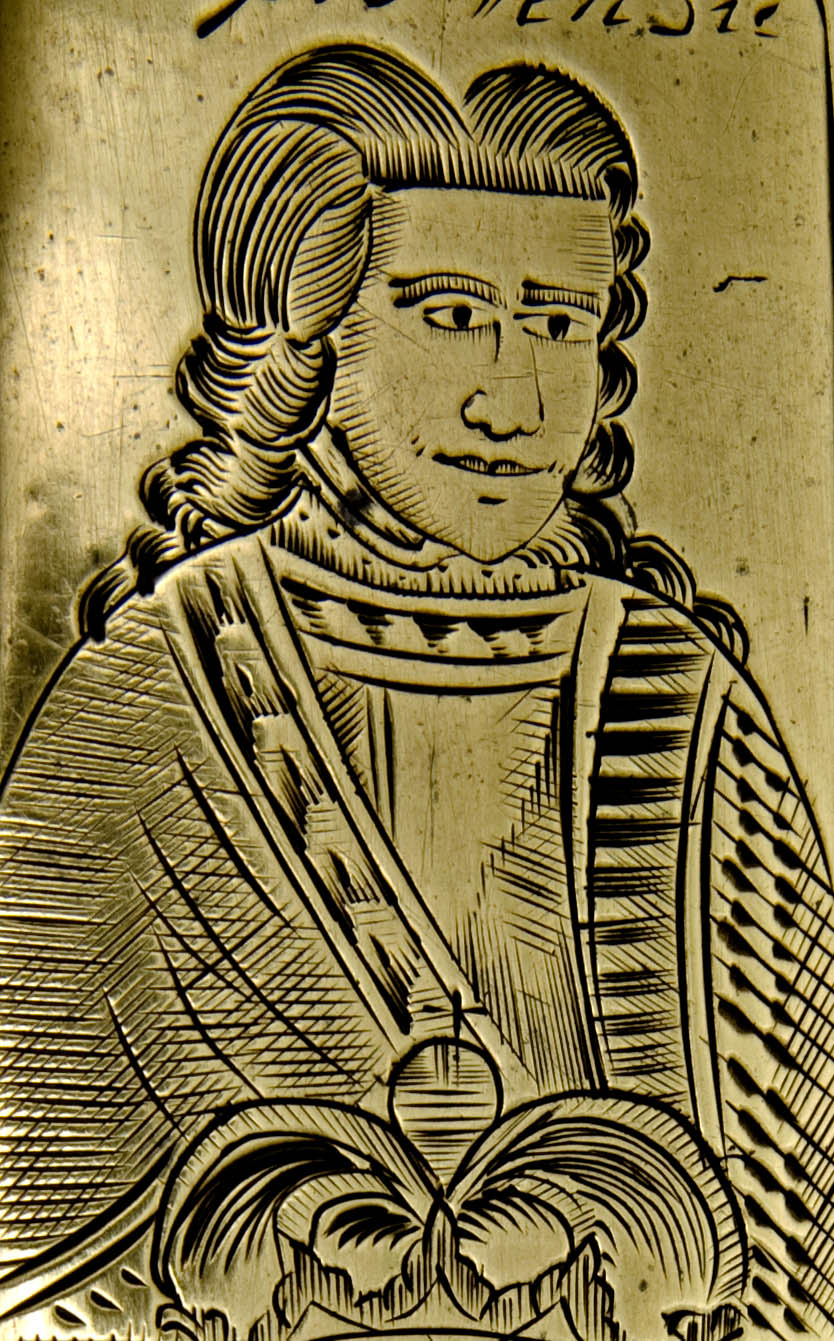
Description: Click here.
Comment: Rectangular tobacco box but with a size ratio that is more broad and shorter and thus characteristic of the middle of the eighteenth century. Along the lid and the bottom a bevelled profile as we see more often in that period. The performance is pro-Oranje and shows on the lid the knee piece of Prince William IV with his weapon and a sign underneath. The bottom shows the weapons of the Seven Provinces about which he was stadholder. These weapons are placed in a staggered rhythm, the coat of arms of Holland is central. On the side we see a circumspect hunt-derived performance that was extremely popular during that period. A somewhat ragged hole underneath the hinge of this box presupposes a user-fitted chain with which this box was worn on the belt in order to make clear the Orangistic preference.
Origin: the Netherlands
Date: 1745-1755
Collection: Amsterdam, Pijpenkabinet Collections Pk 3.236
Box 20 Religious rebus
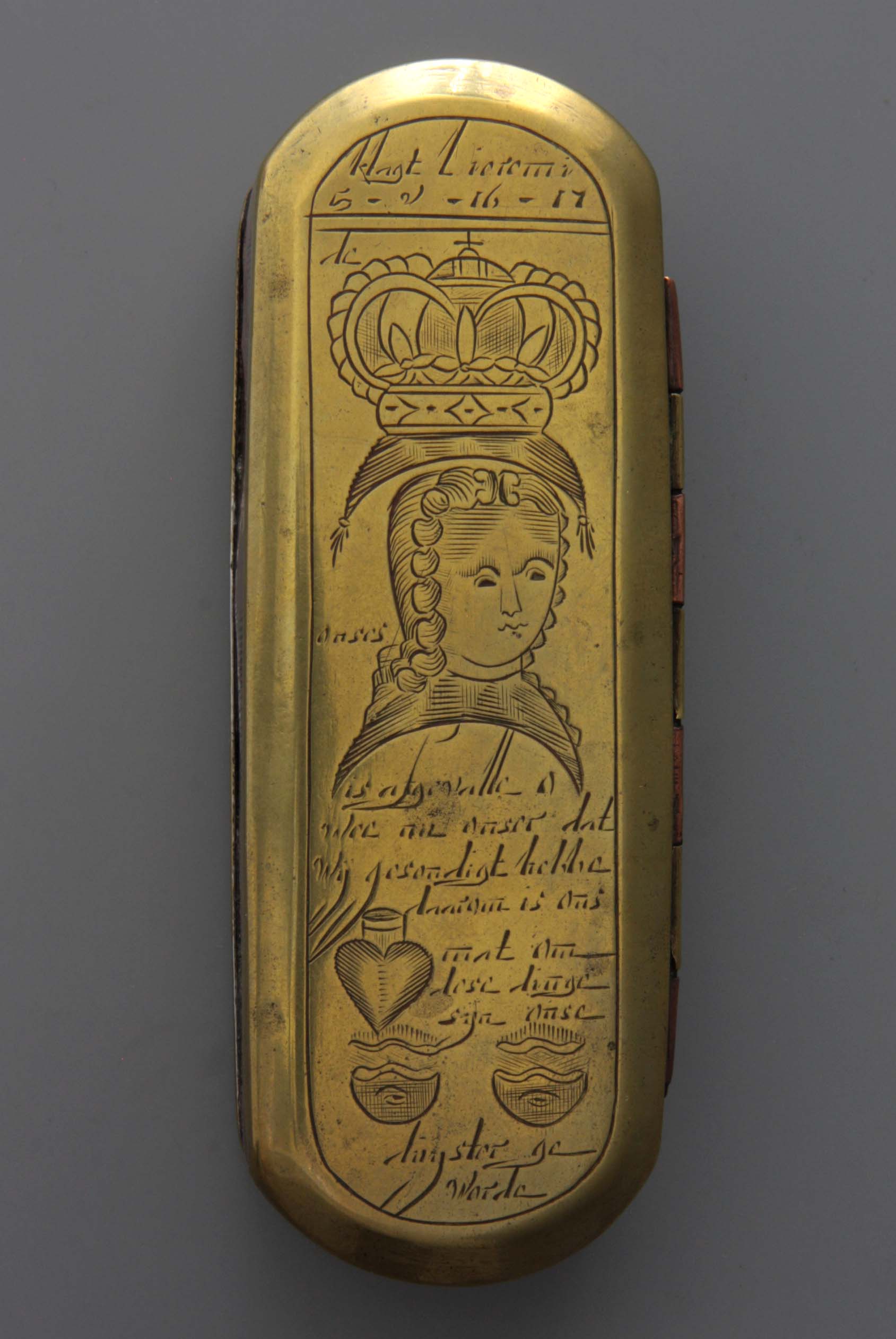
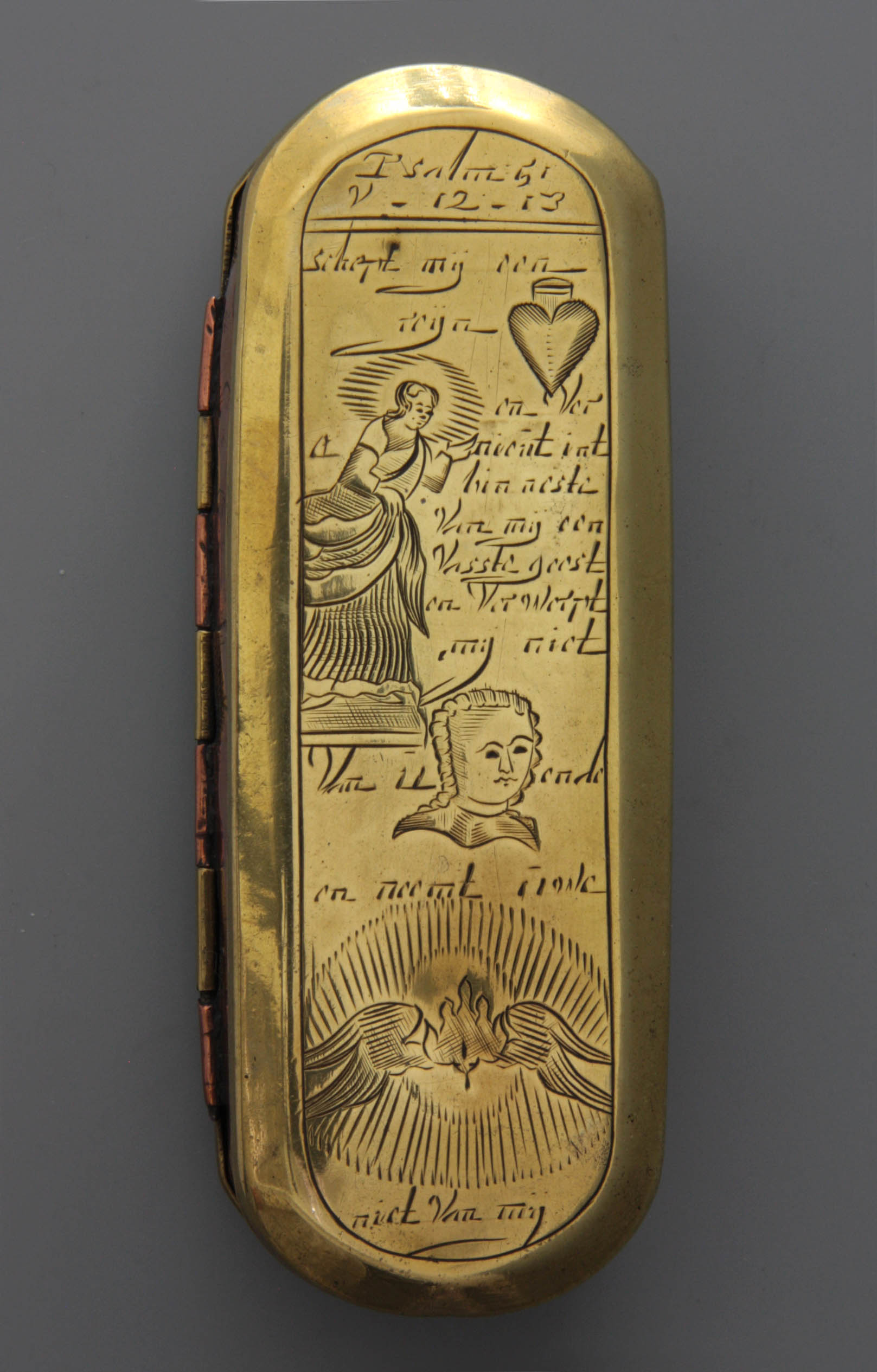
Description: Click here.
Comment: Box type characterized by an oblique edge on the lid and bottom (Cat. 19), which makes it easier to move between clothes. Presentation engraved after a print from "THE SMALL PRINT-BIBLE", published in Amsterdam by Dirk van der Linden in 1754 (page 51) in which the rebus was placed on this box. The main performance on the upright edge alternated with two times a hunting dog behind a fleeing deer.
Origin: the Netherlands
Date: 1755-1785
Collection: Amsterdam, Pijpenkabinet Collections Pk 20.728
Box 21 Life of Christ
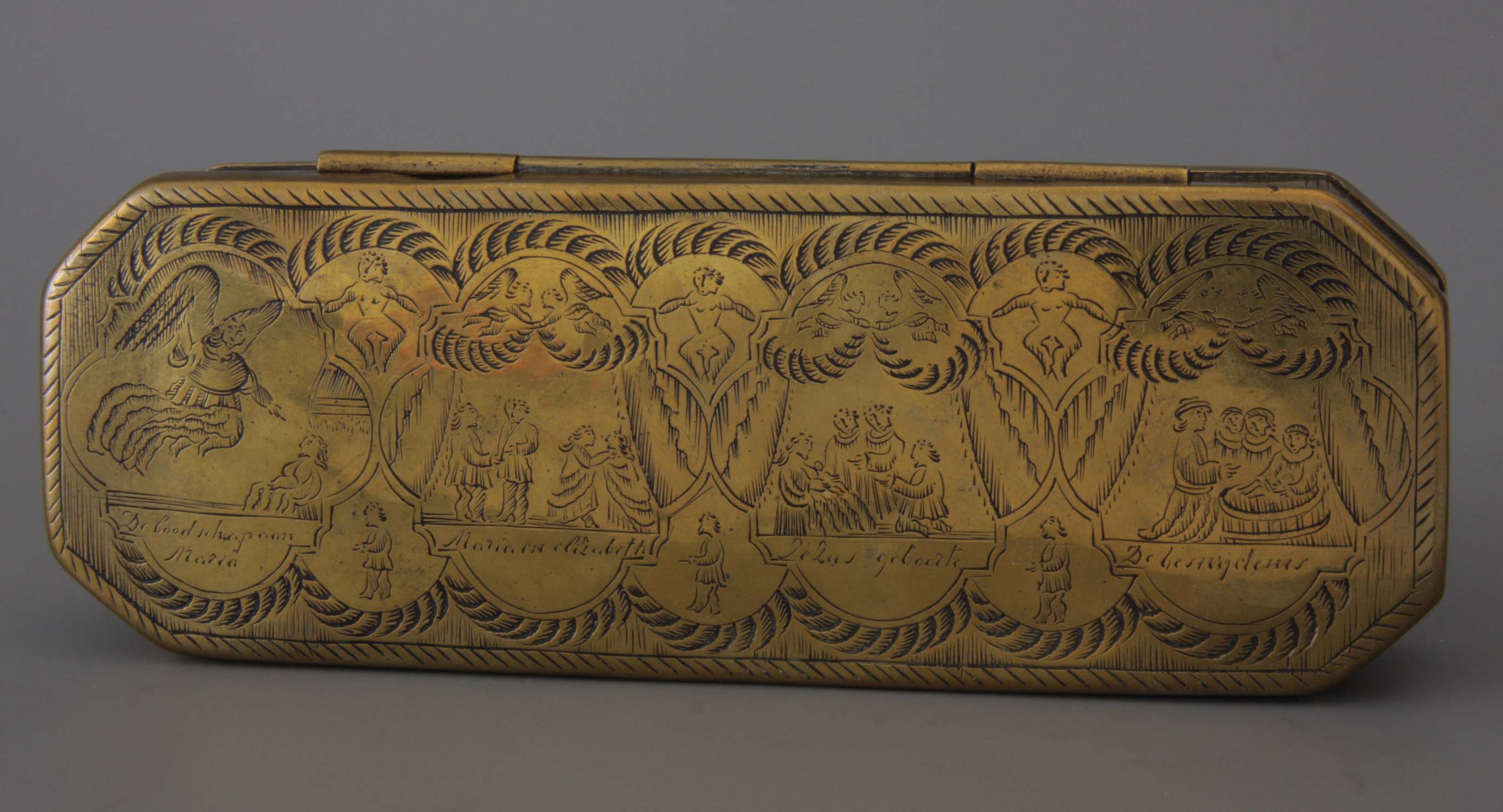
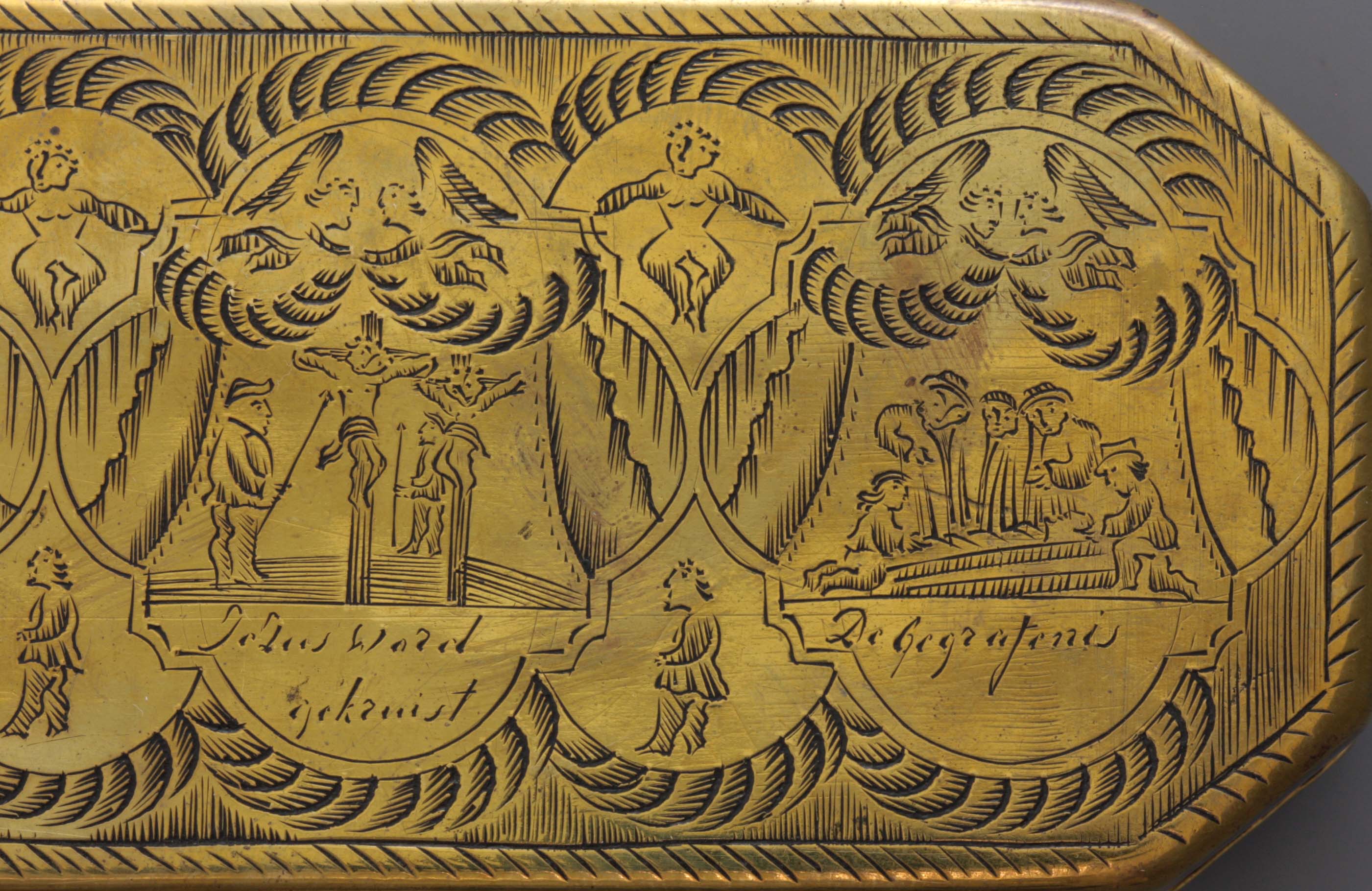
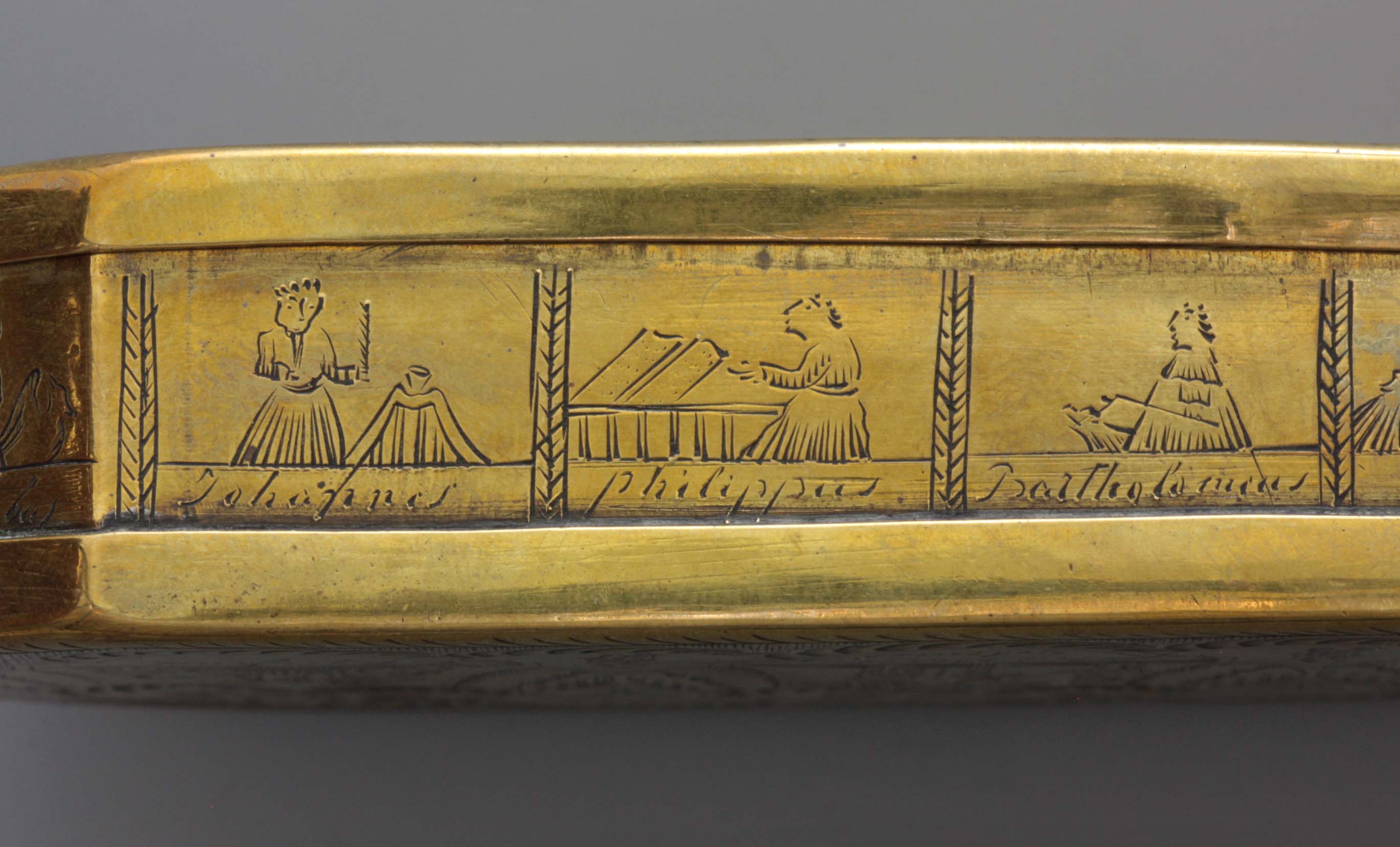
Description: Click here.
Comment: A specific method of engraving that deviates from the standard. The performance is not made up of continuous lines but of short strokes. A remarkable and atypical box due to its low flat design and its decoration concept and method of engraving. Is it a coincidence that the first quadruple is not provided with the garlands held up by the angels? Also remarkable is the single-pivot hinge.
Origin: the Netherlands
Date: 1780-1830
Collection: Amsterdam, Pijpenkabinet Collections Pk 20.730
Box 22 Erotically tinted
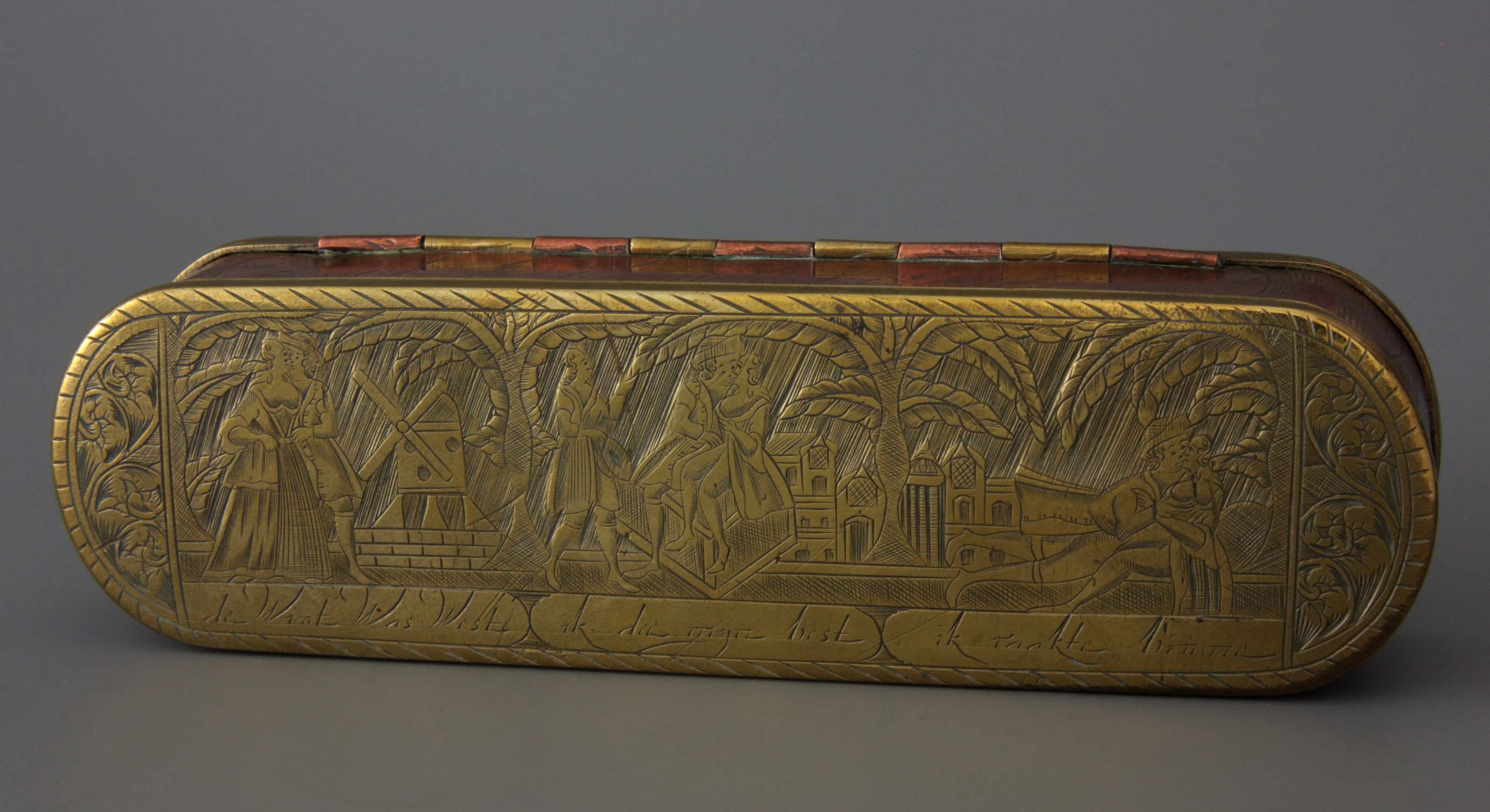
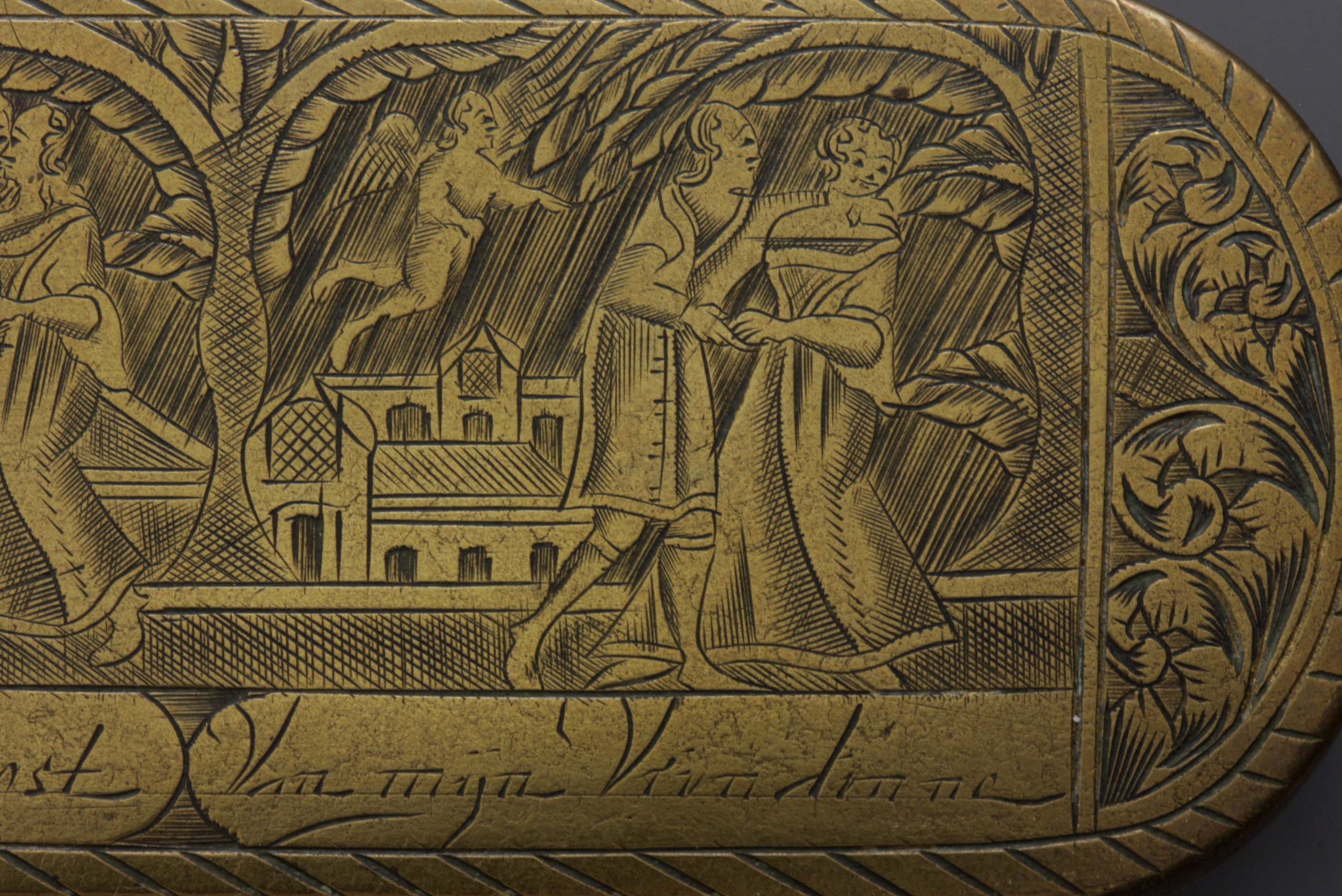
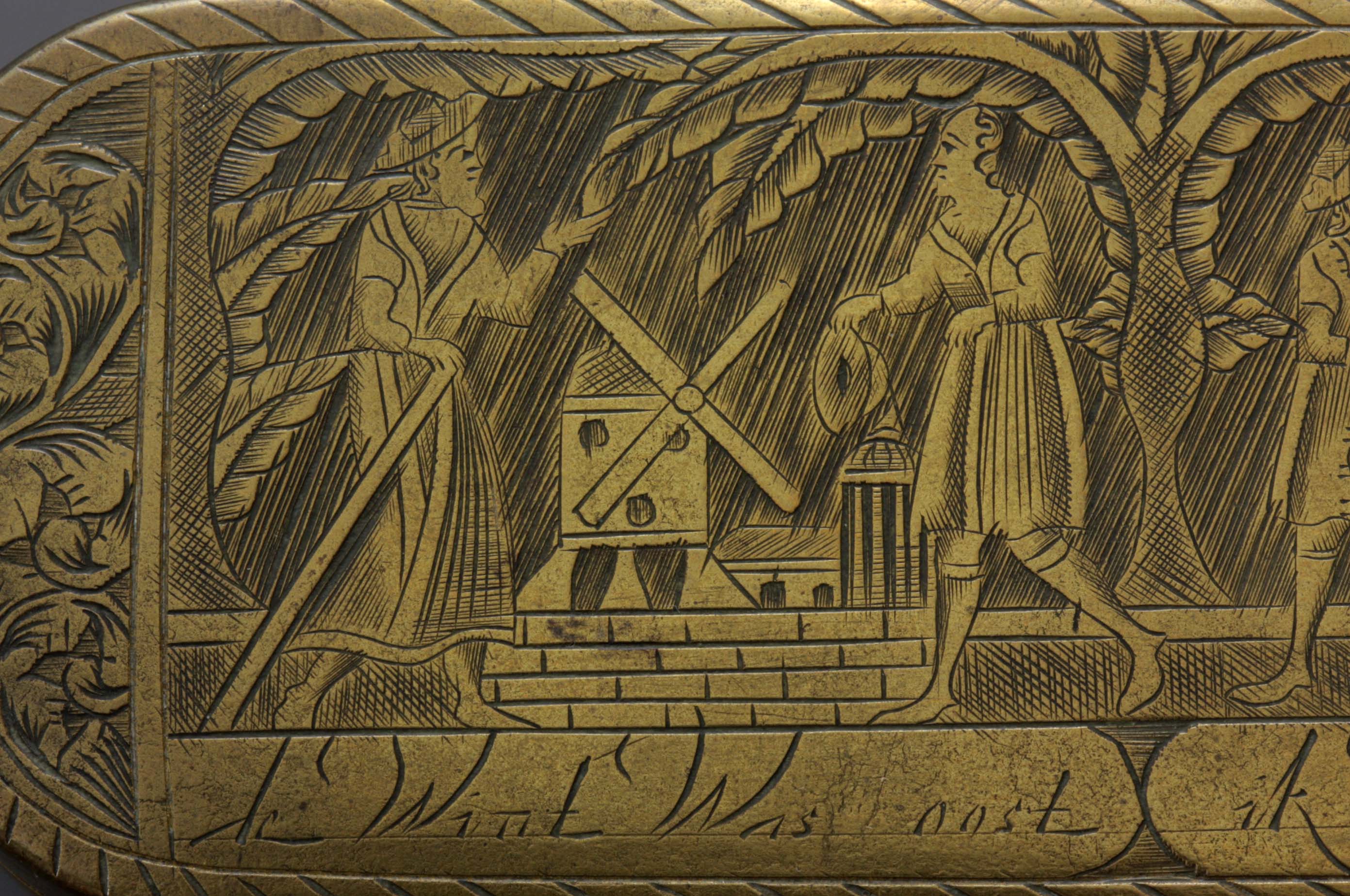
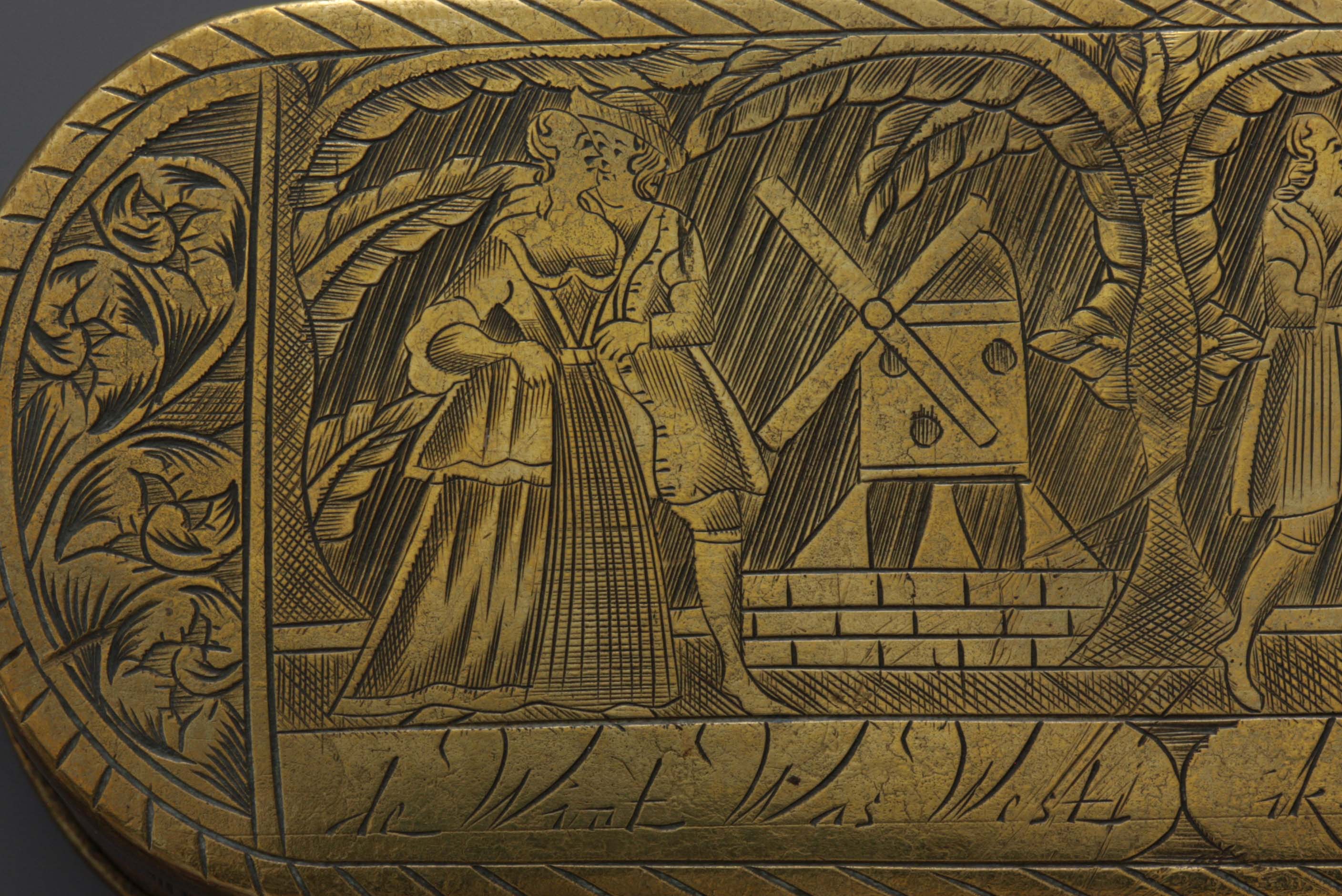
Description: Click here.
Comment: An extensively engraved box but not very artistic. The lid and the bottom of the box are rather scratchy, with a sort of shrine showing with dense shading against the background. Is this attempted to imitate the box in two colours of copper? The upright walls bear extensive inscriptions on two lines.
Origin: the Netherlands
Date: 1745-1770
Collection: Amsterdam, Pijpenkabinet Collections Pk 20.726
Box 23 Coat of arms of Batavia
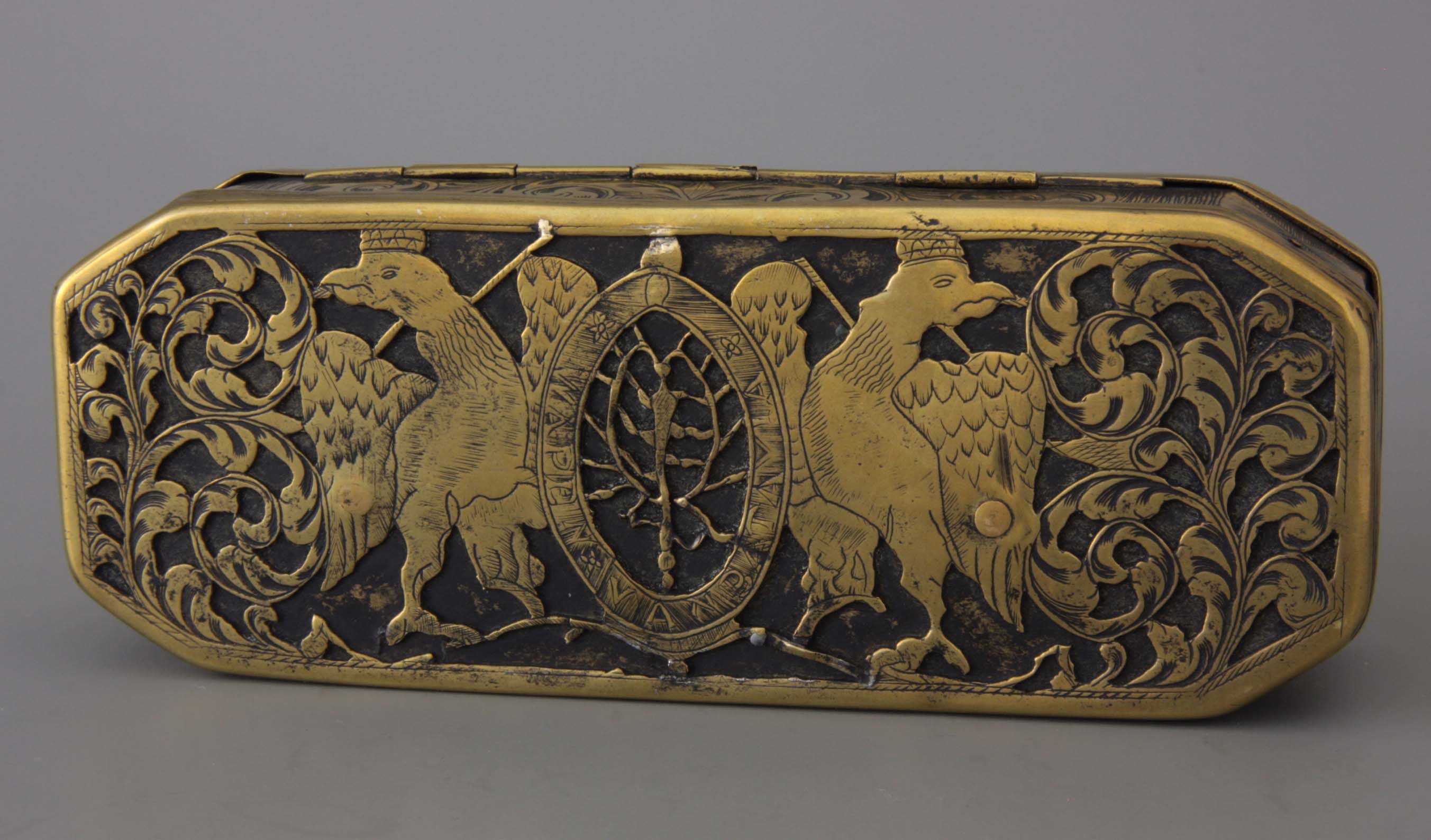
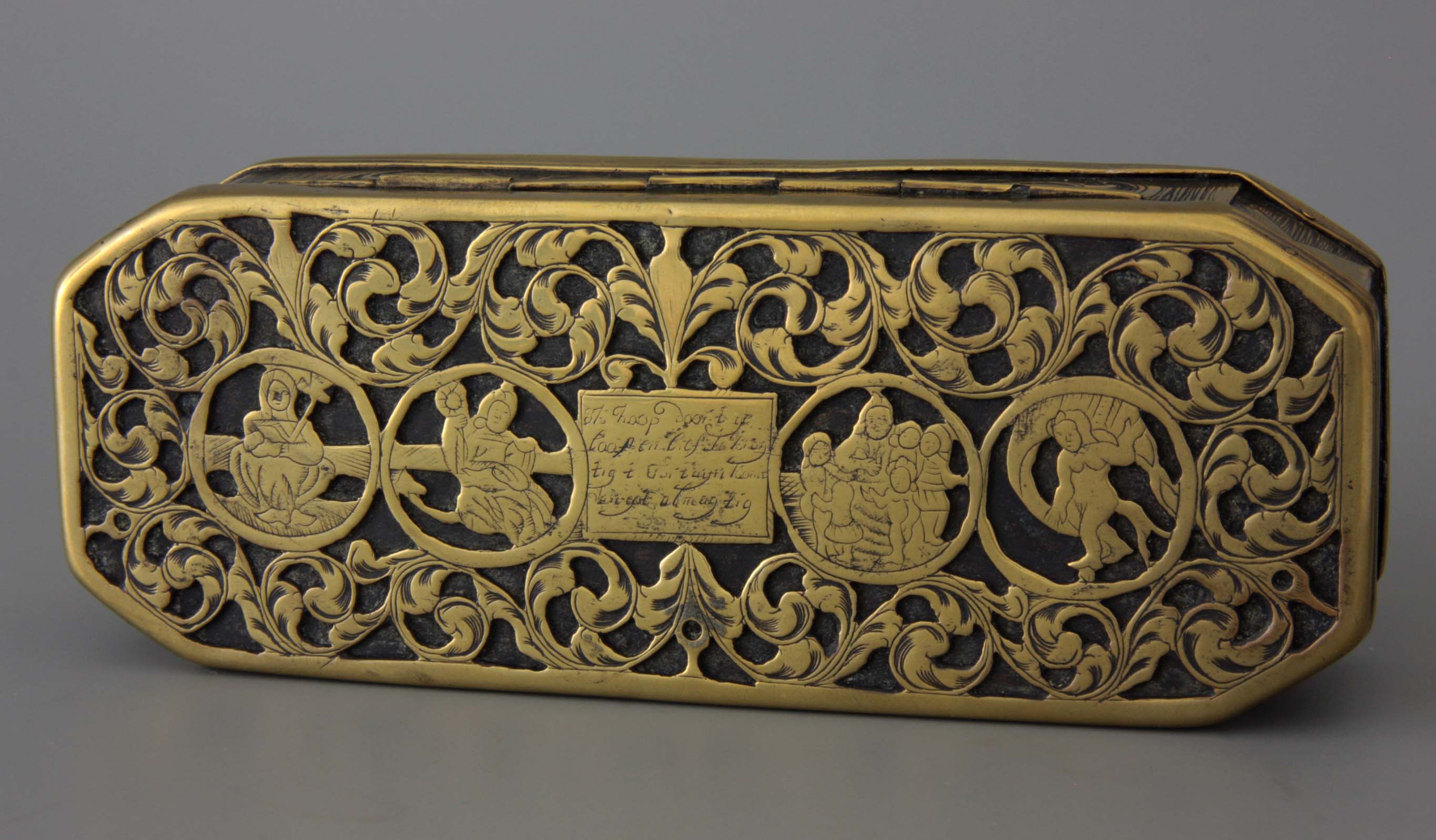
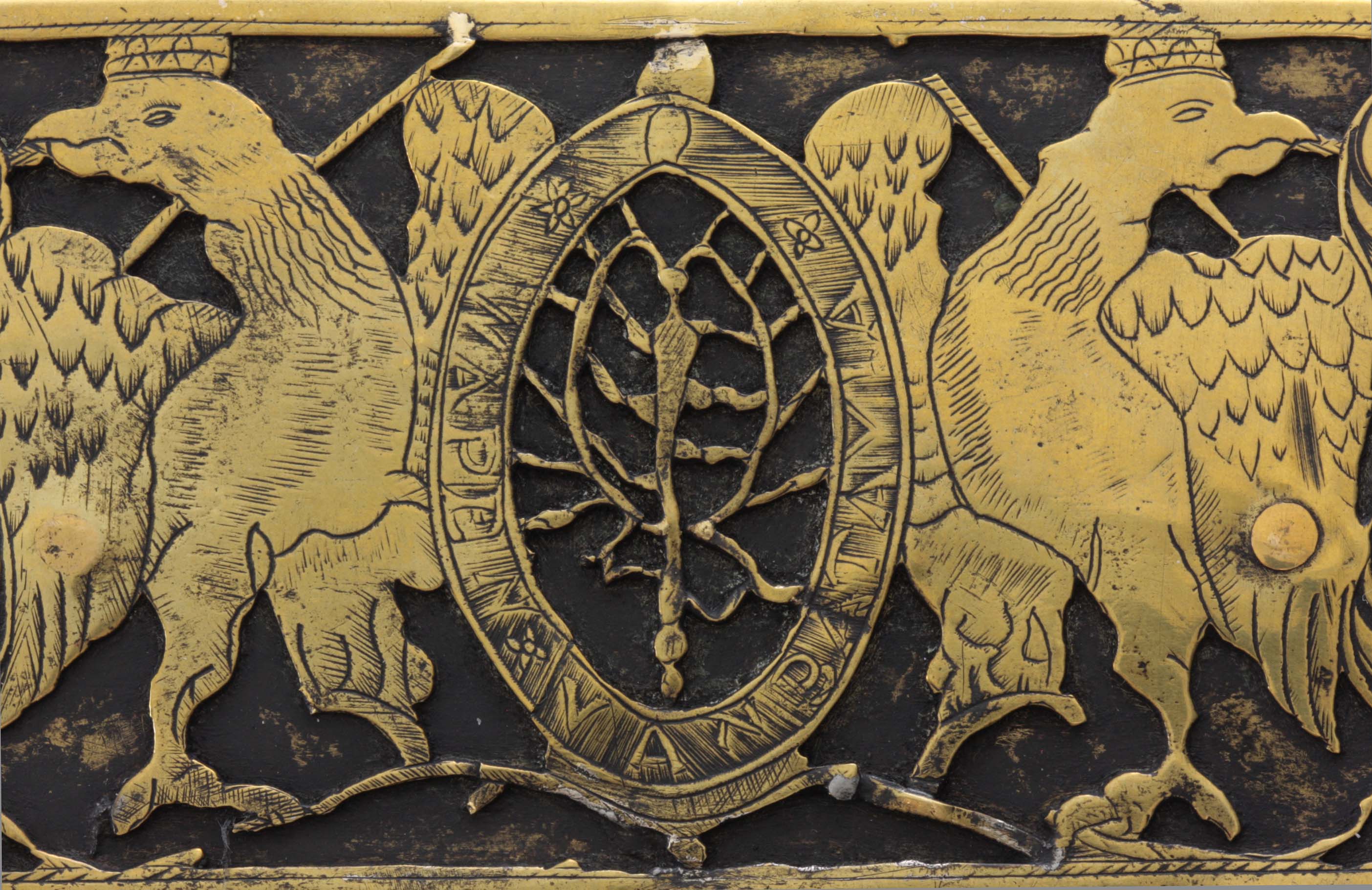
Description: Click here.
Comment: Remarkable design by sawing open the lid and the bottom, giving the image more relief even though the effect remains highly two-dimensional. The engraving example for the coat of arms was copied from the brand vignette of pipe maker Abraham van den Berg from Gouda, where his trademark is kept by two seated eagles. However, the weapon of Batavia is not kept by birds but by standing lions. Brongers supposes Amsterdam as a production site.
Literature: Catalogue Kleykamp, number 43: A similar open-cut box with the coat of arms of Amsterdam on the lid and the moralizing representation on the bottom.
Origin: Amsterdam?
Date: 1745-1775
Collection: Amsterdam, Pijpenkabinet Collections Pk 20.731
Box 24 Rosettes with moralistic filling
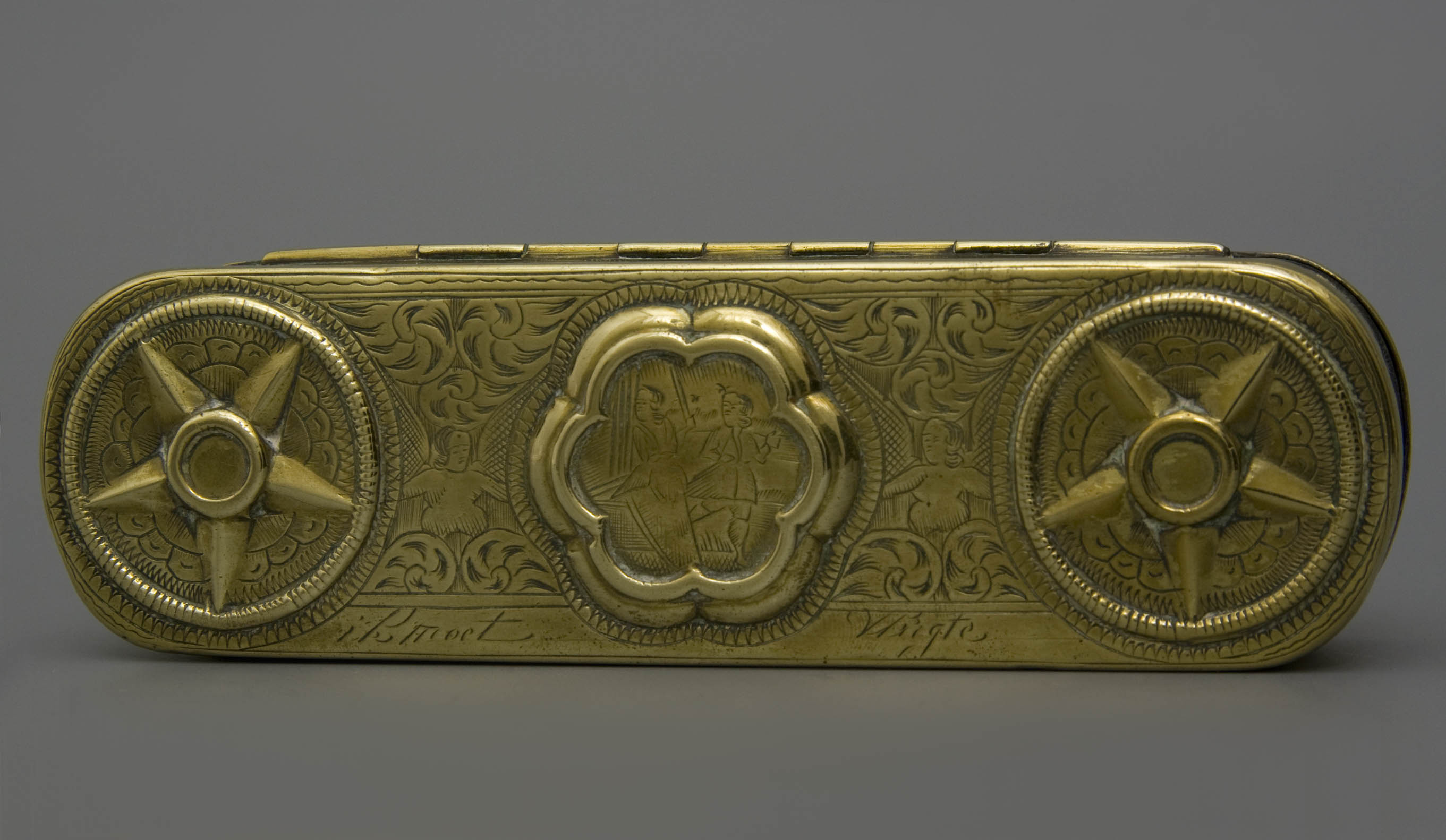
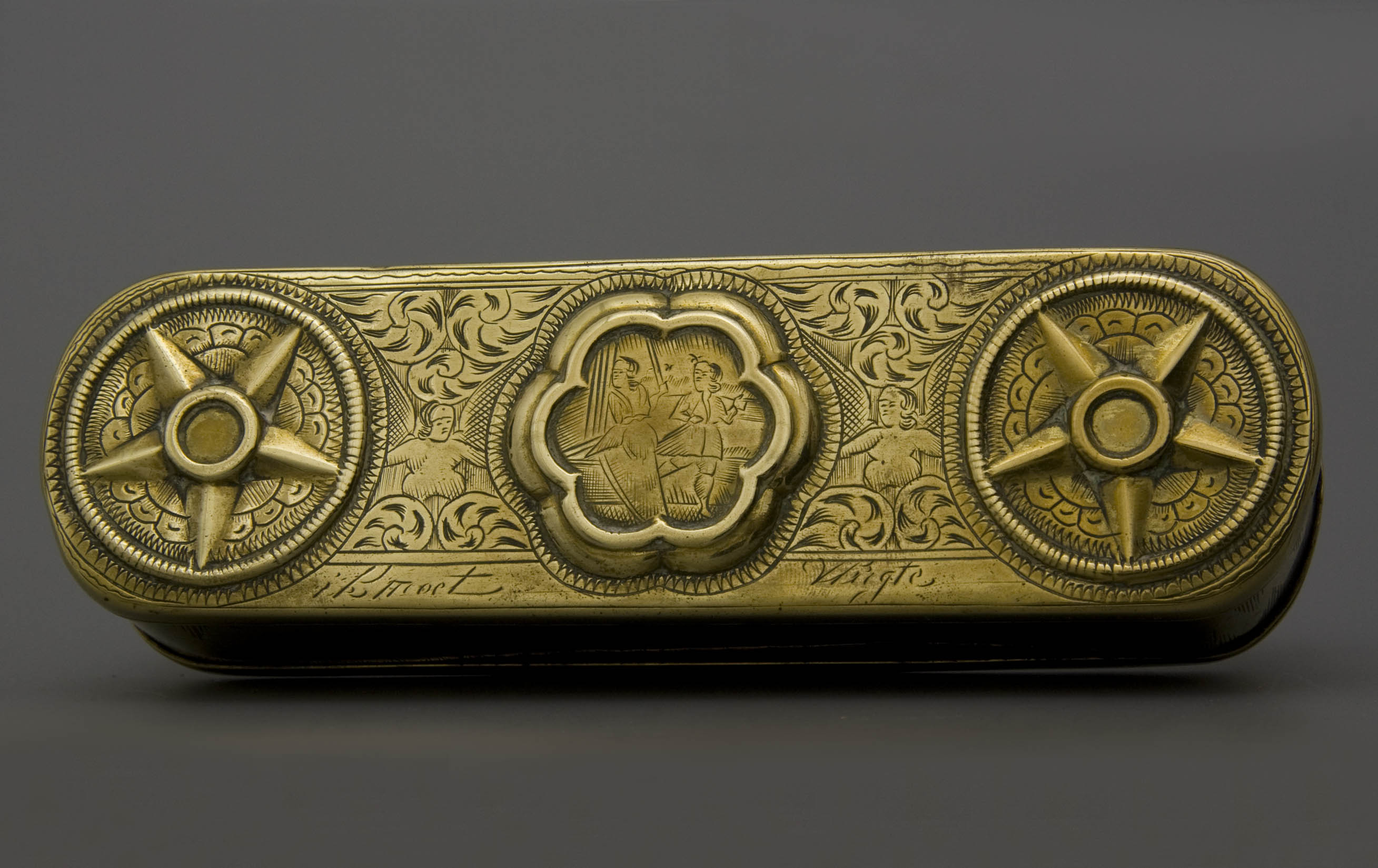
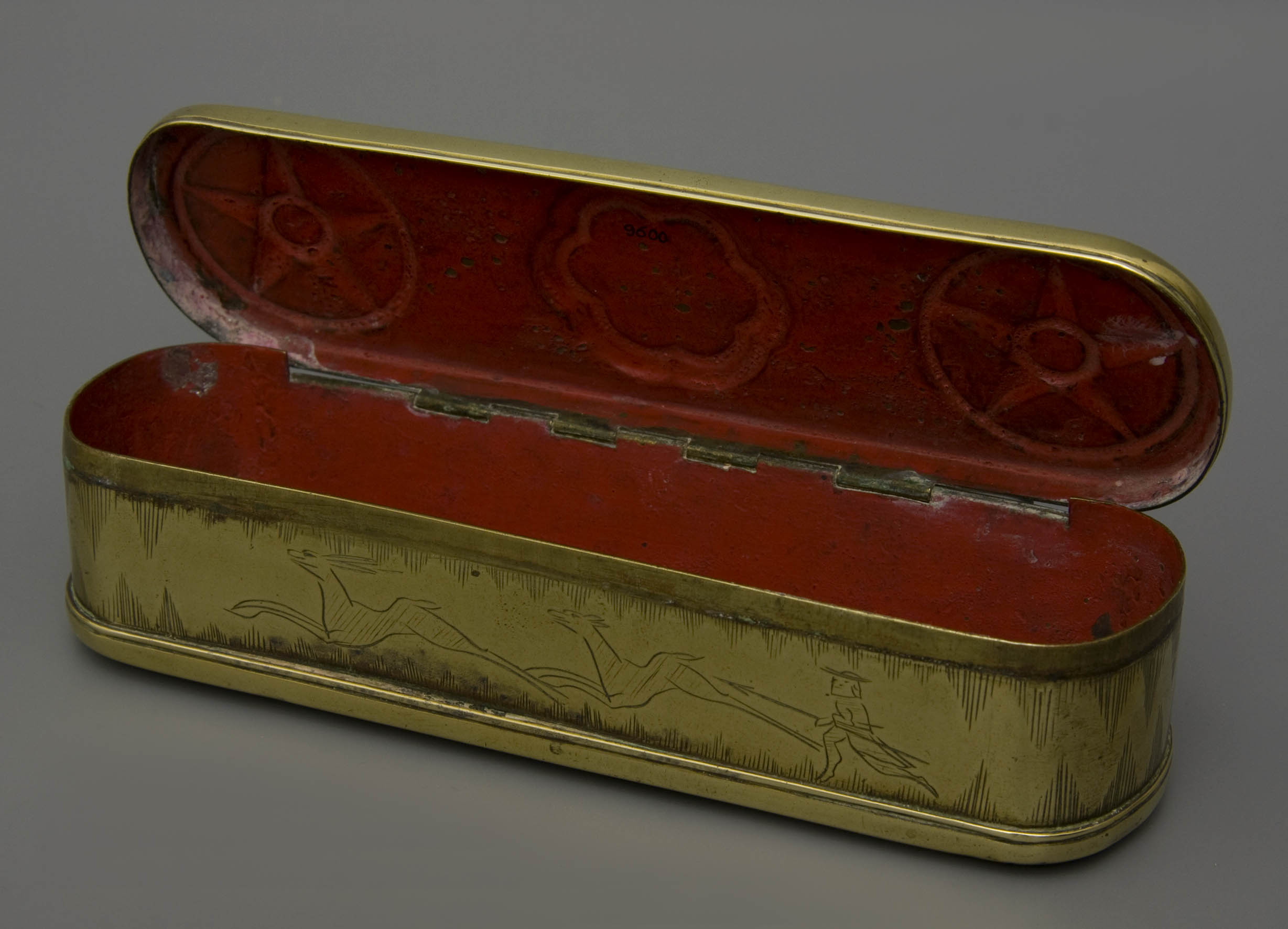

Description: Click here.
Comment: In terms of form a standard box but striking because of the printed rosettes and the raised cartouche on the lid and the bottom. Such a printed decoration is not very common for a Dutch tobacco box. The relief work fulfils a special role in the concept of decoration. Due to the flanging of these decorative elements little space was left for the engraving work. The choice has been made for a moralistic representation that is explicitly present. On the inside the box is covered with red paint, possibly this was against the spiciness of the brass.
Origin: the Netherlands
Date: 1740-1770
Collection: Amsterdam, Pijpenkabinet Collections Pk 9.600
Box 25 Frost and battle
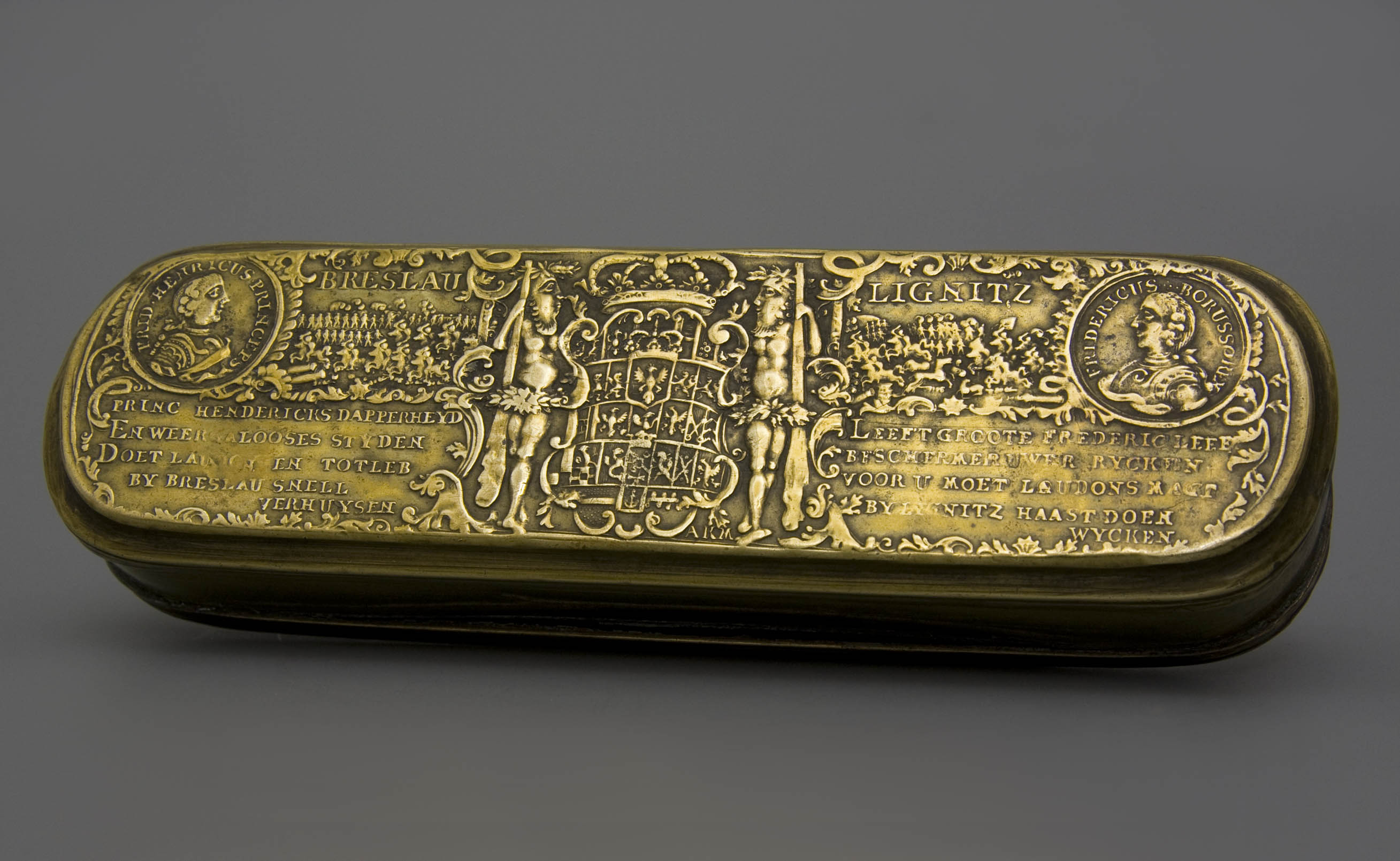
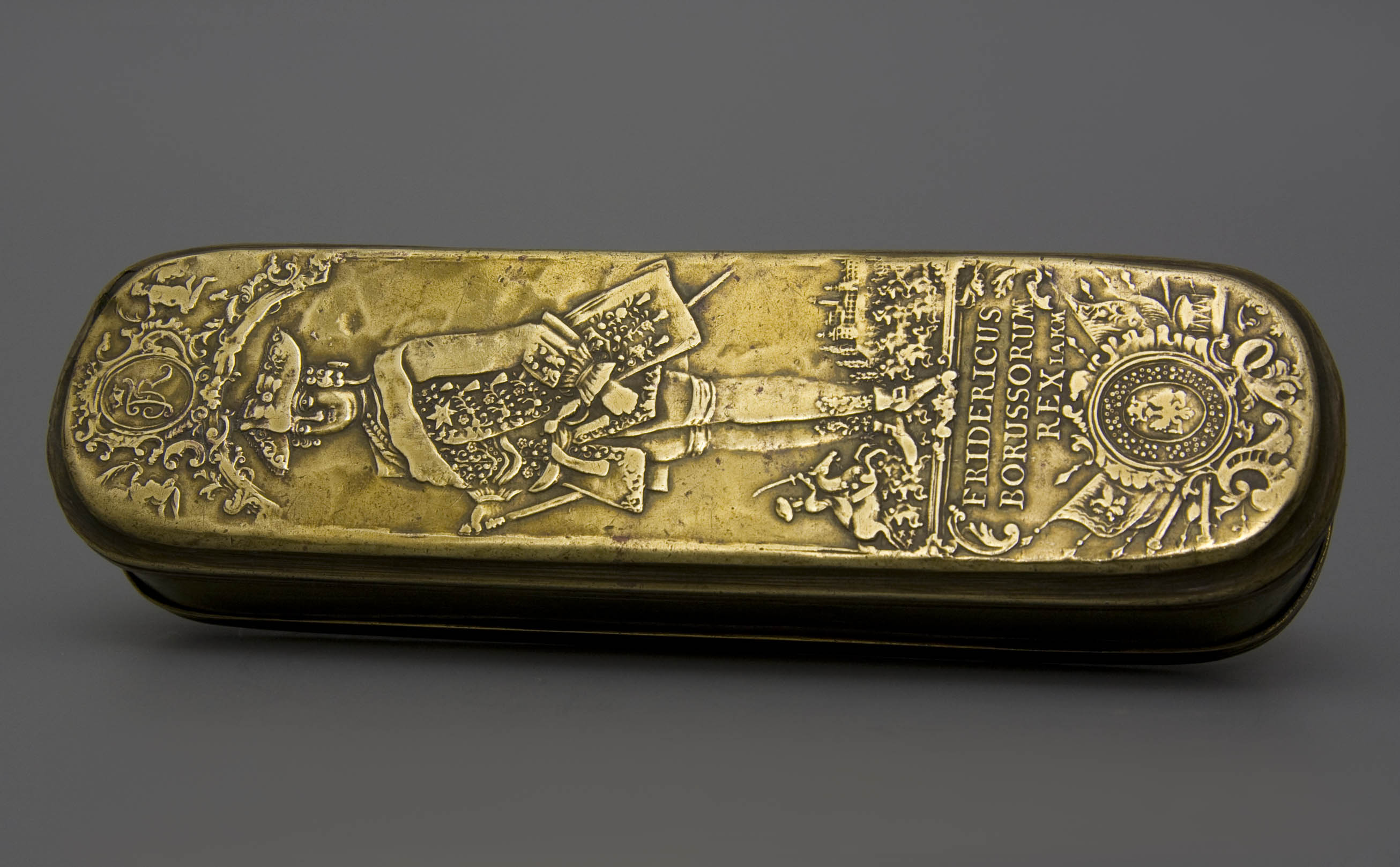
Description: Click here.
Comment: Iserlohn box with feet on the lid from the portrait of King Frederick the Great, on the reverse side a battle. Creator brands AKM and IAKM. A distinctive box for the production site with a sturdy and penetrating representation that fits seamlessly with the other mechanically printed serial boxes from Iserlohn.
Literature: Eq. Wolf-Dieter Könenkamp, Iserlohner Tobacco Doses, Bilder einer Kriegszeit, Münster, 1982, p. 20, Abb 17. (bottom with standing frost) Idem, p. 48, Abb 78. (lid)
Origin: Iserlohn, Johann Adolph Keppelmann
Date: 1755-1785
Collection: Amsterdam, Pijpenkabinet Collections Pk 15.553
Box 26 Bust of emperor and battlefield
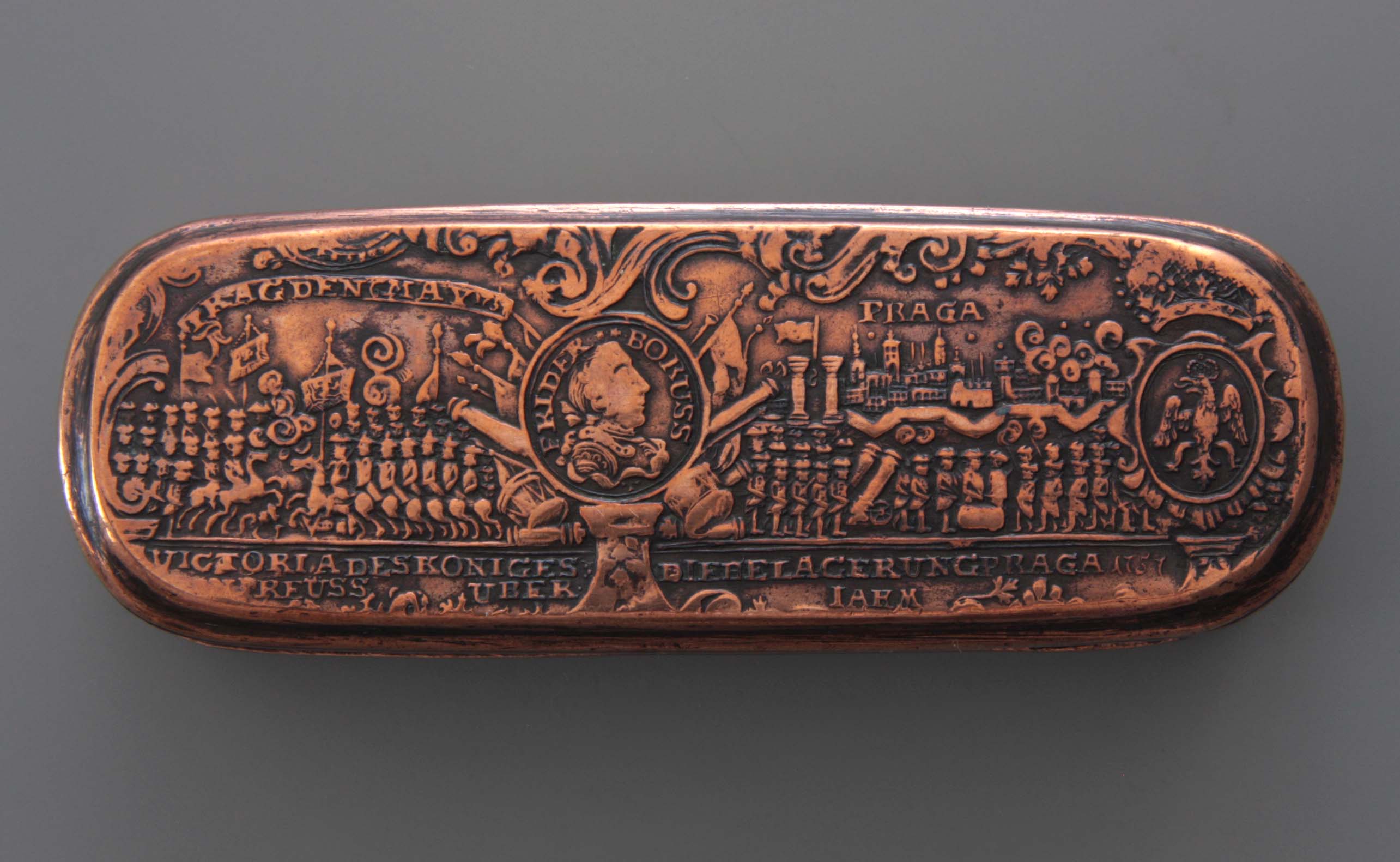
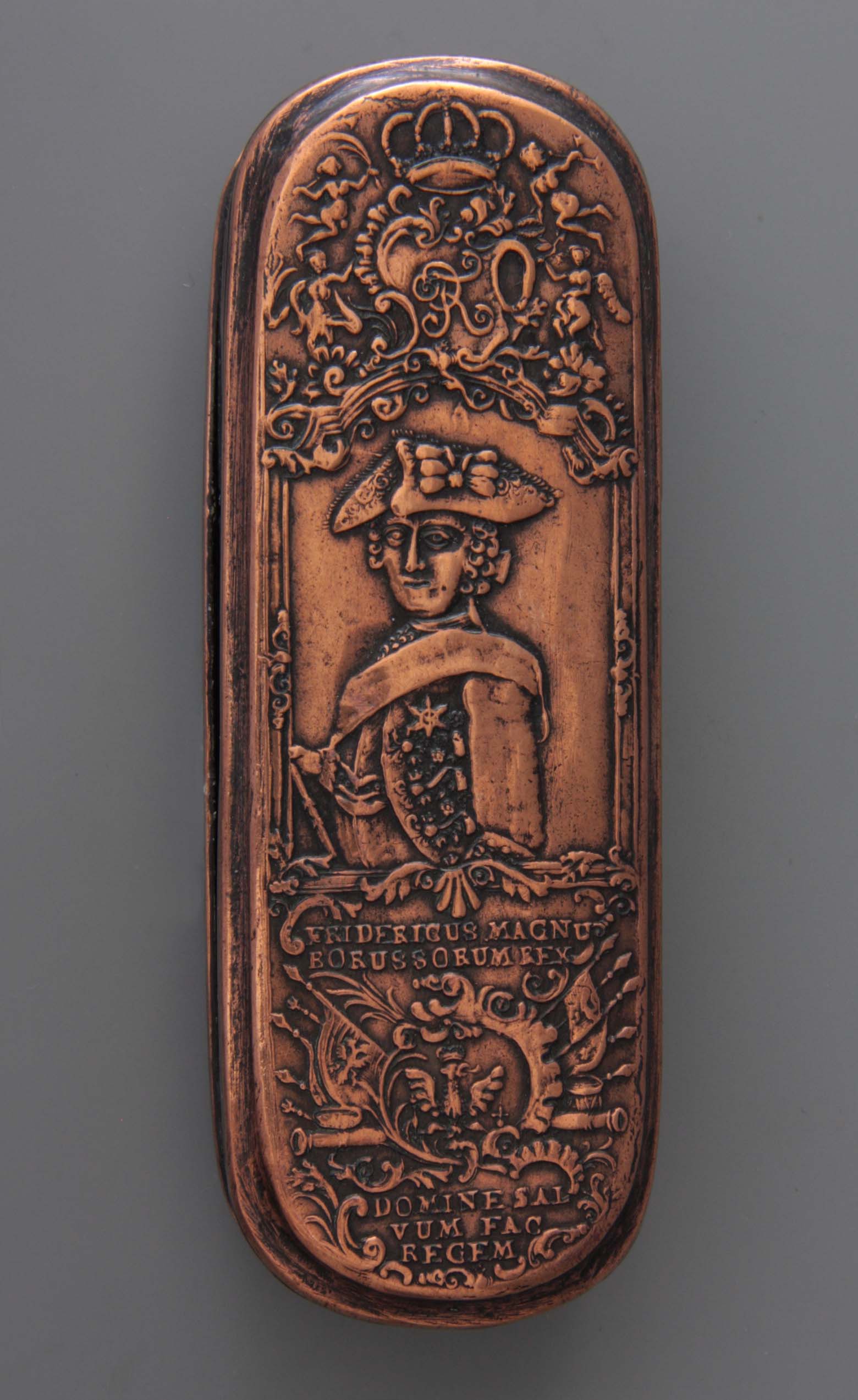
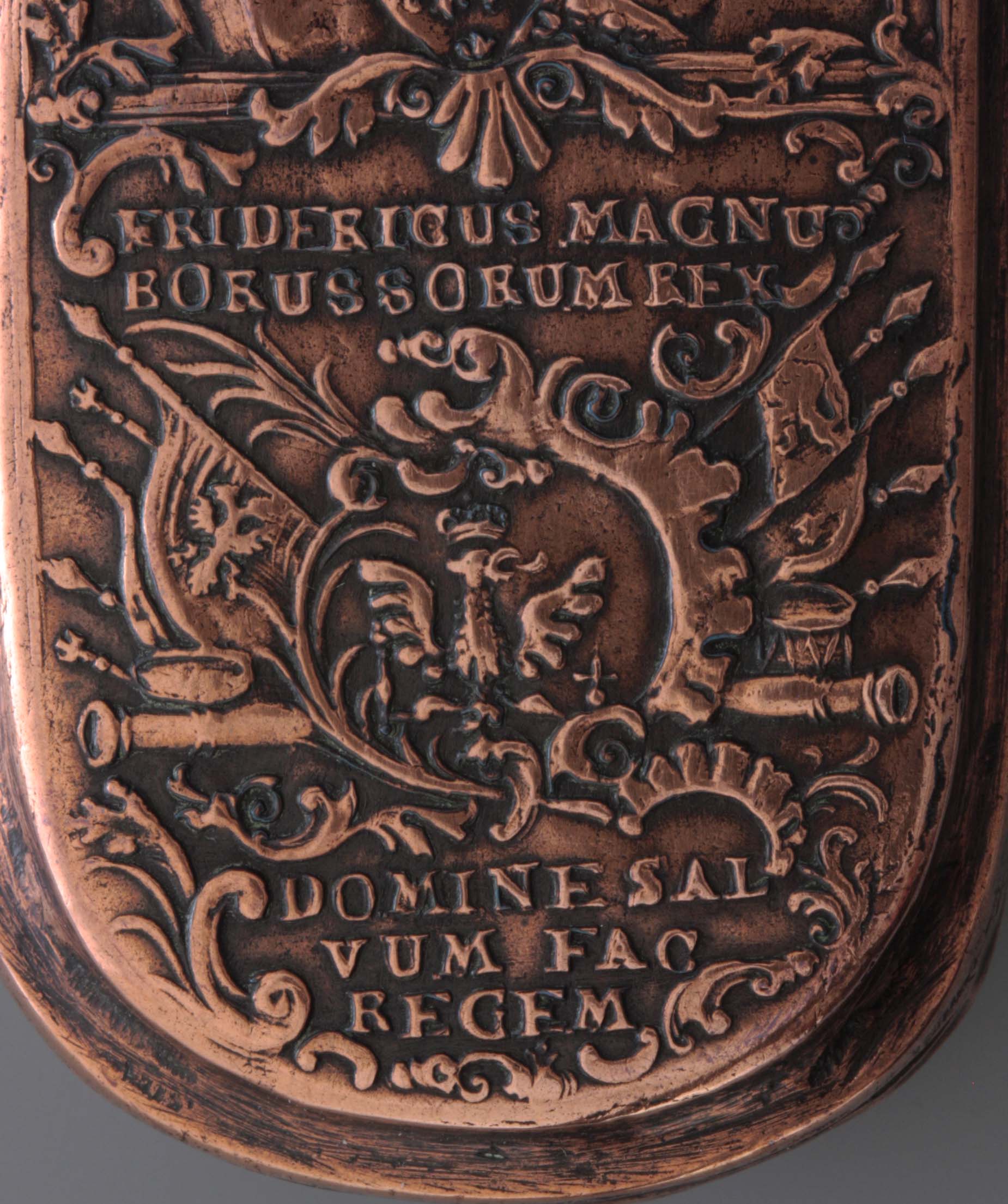
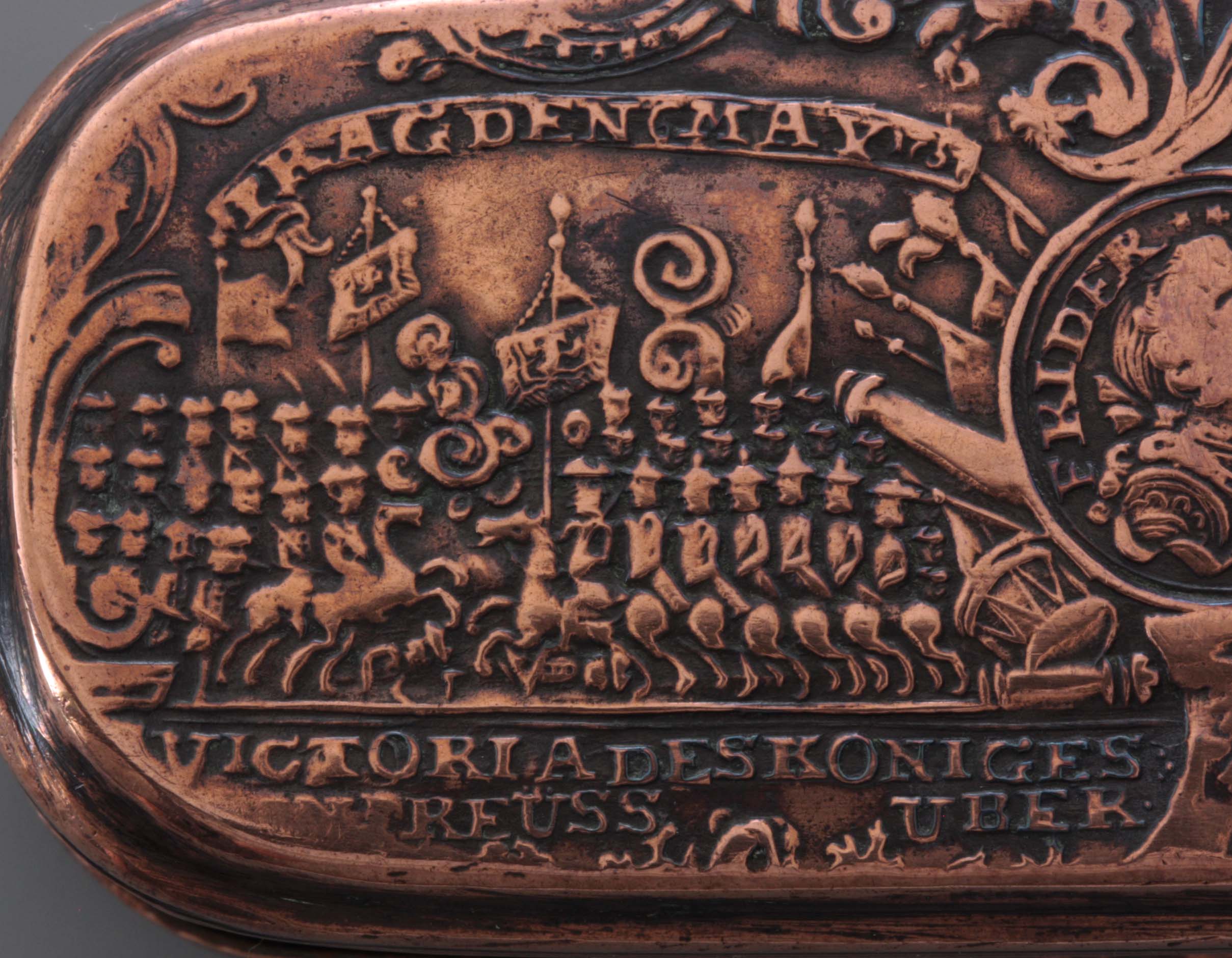
Description: Click here.
Comment: Characteristic of the Iserlohner boxes is that the frost is depicted pontifically on the front and that this is often done vertically. As usual, the bottom of the box is reserved for a scene with battle. As a small compact box, this is an outsider of the Iserlohner industry. The use of copper for lid and bottom is also less common.
Origin: Iserlohn
Date: 1757-1765
Collection: Amsterdam, Pijpenkabinet Collections Pk 20.729
Box 27 Ascension
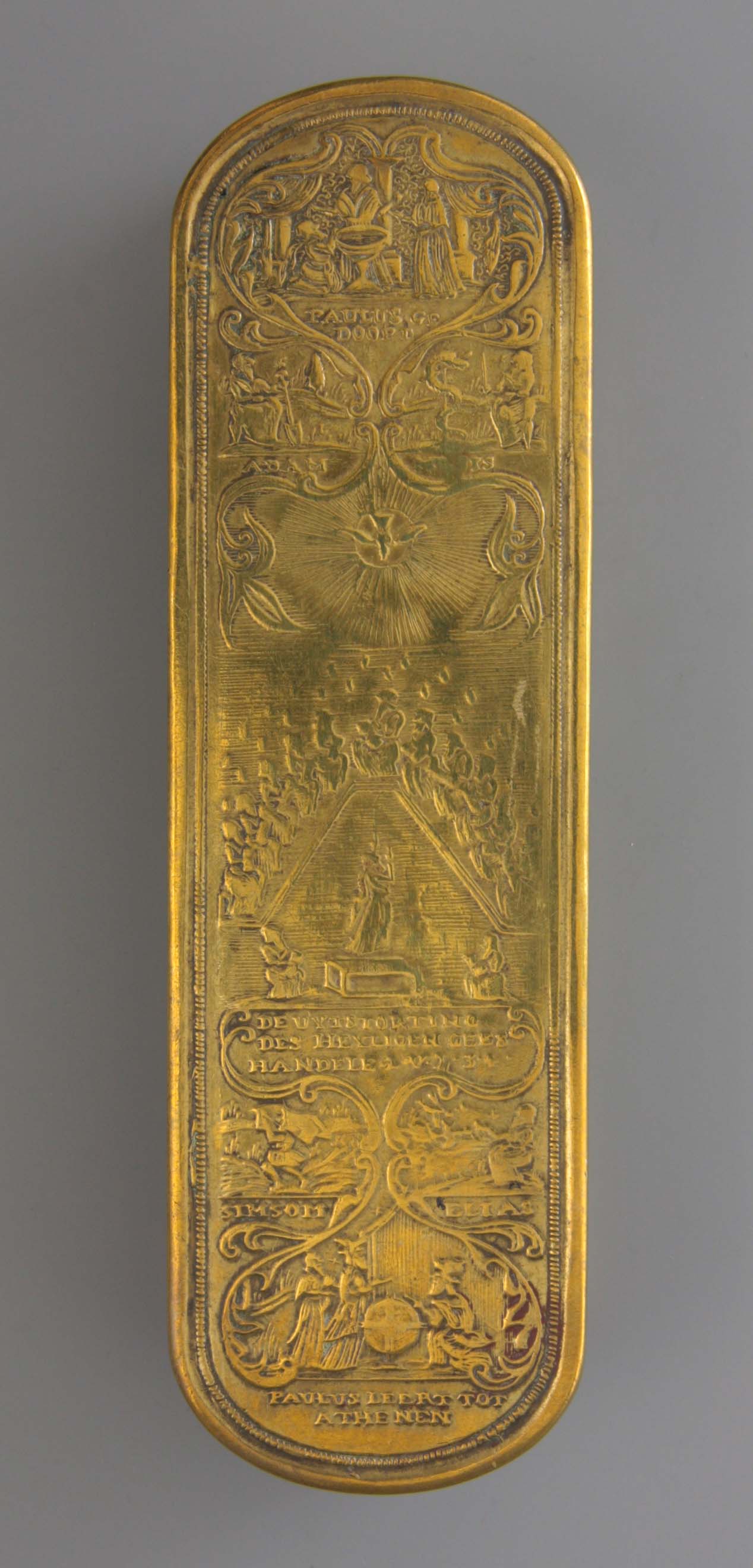
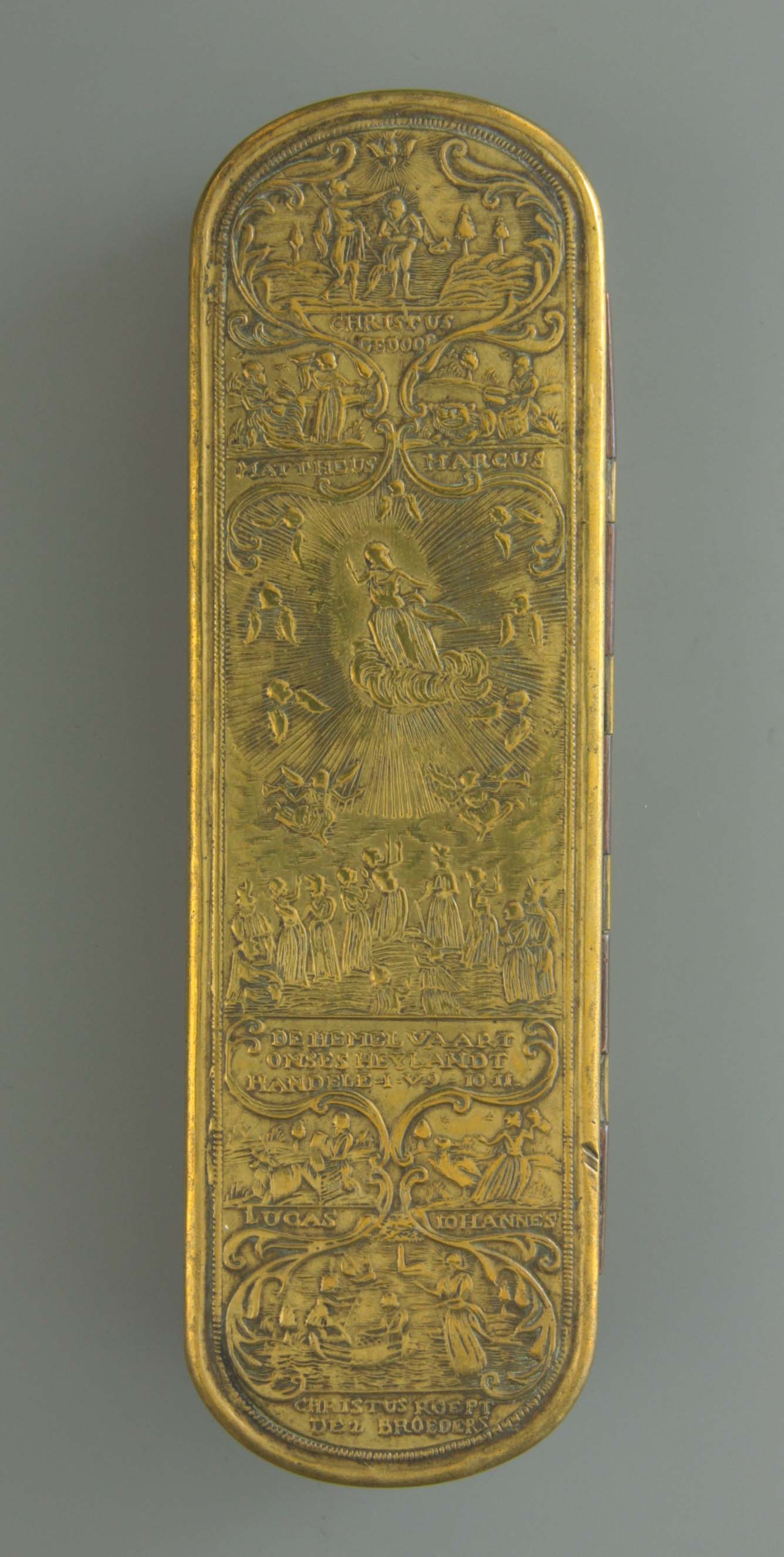
Description: Click here.
Comment: Pictured is the Pentecostal wonder with the four evangelists and scenes from the life of Jesus Christ. Characteristic for the production from Iserlohn. Nevertheless, the perfect spelling of the Dutch text on make on our soil, a German version would contain some spelling mistakes. In addition, the sheet material is lighter than what is known from Iserlohn and that makes the box little wear resistant. Striking is the hinge that is four-ply and alternately consists of long and short sleeves.
Origin: The Netherlands?
Date: 1760-1775
Collection: Amsterdam, Pijpenkabinet Collections Pk 19.892
Box 28 Cityscape and coat of arms of Haarlem
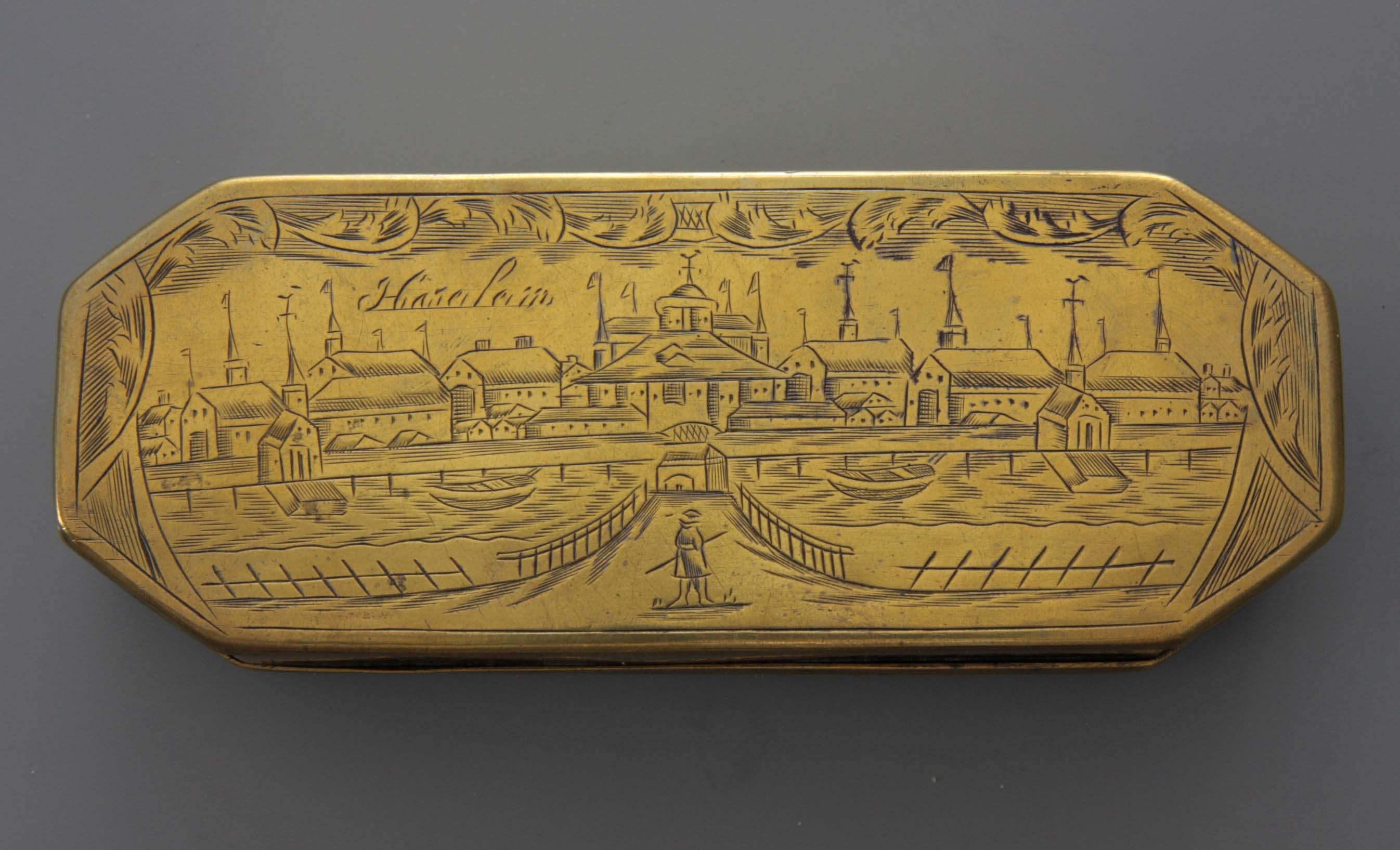
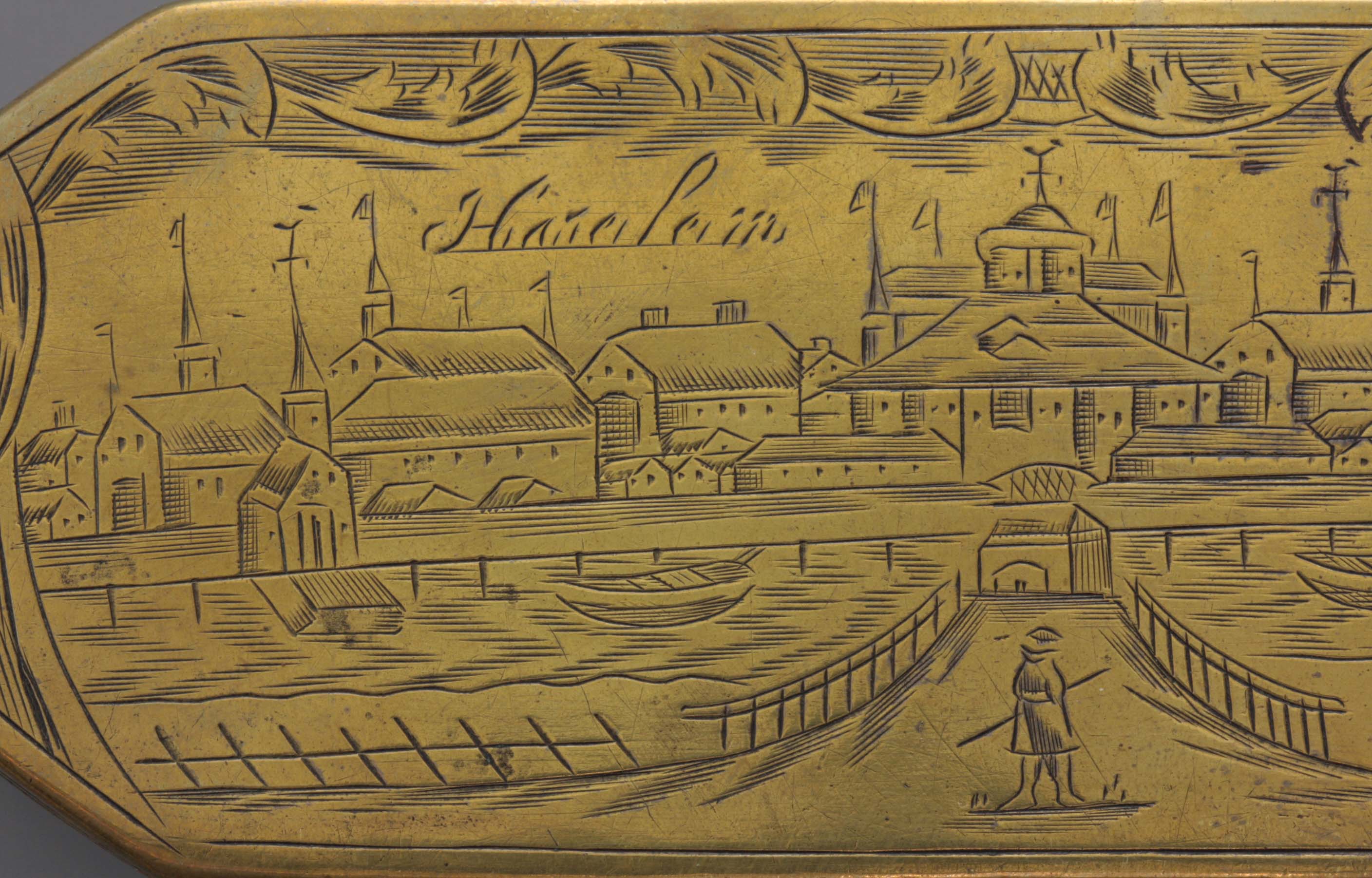
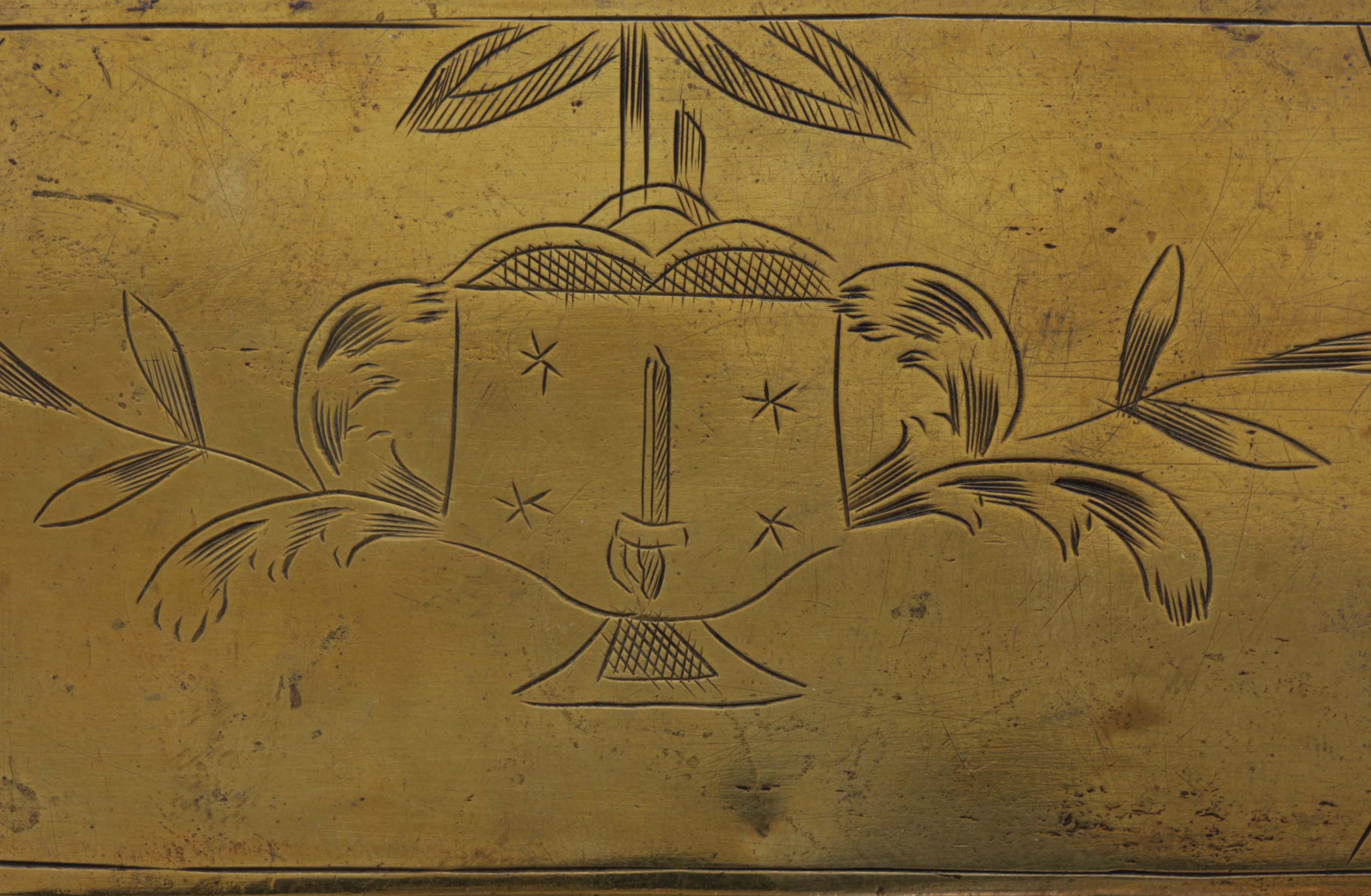
Description: Click here.
Comment: Cover engraved to an existing, already outdated print, the reverse with the coat of arms of the city of Haarlem shows the style of those days related to Louis XVI, in which a simple city coat of arms on an empty field is also designed to save on engraving time. The rosettes on the bottom are not very logical because they are only applied to four of the eight corners. Such rosettes fit better on a rectangular or a pointed tobacco box
Origin: the Netherlands
Date: 1780-1800
Collection: Amsterdam, Pijpenkabinet Collections Pk 20.732
Box 29 Cityscape and coat of arms of Vlissingen
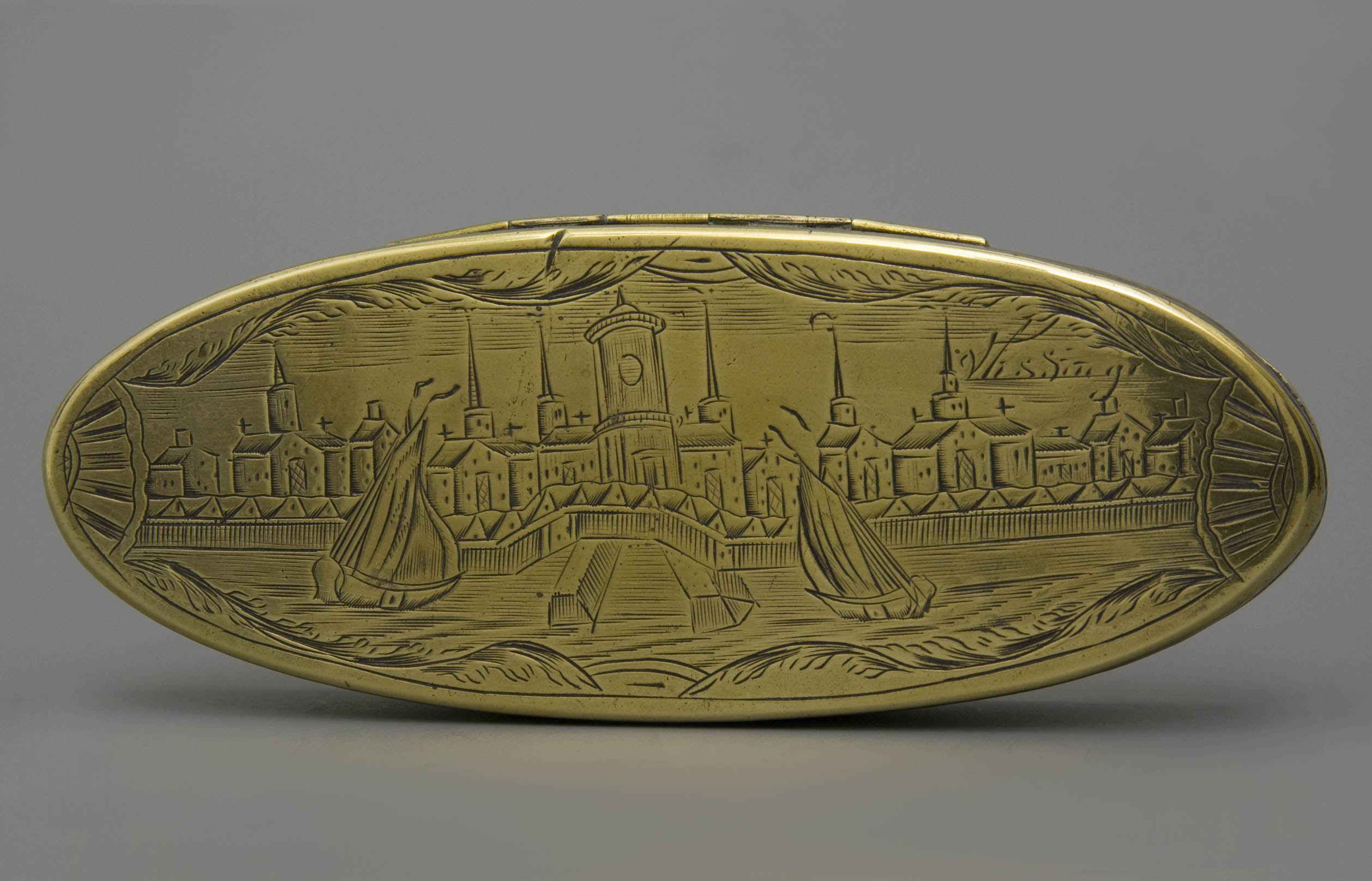
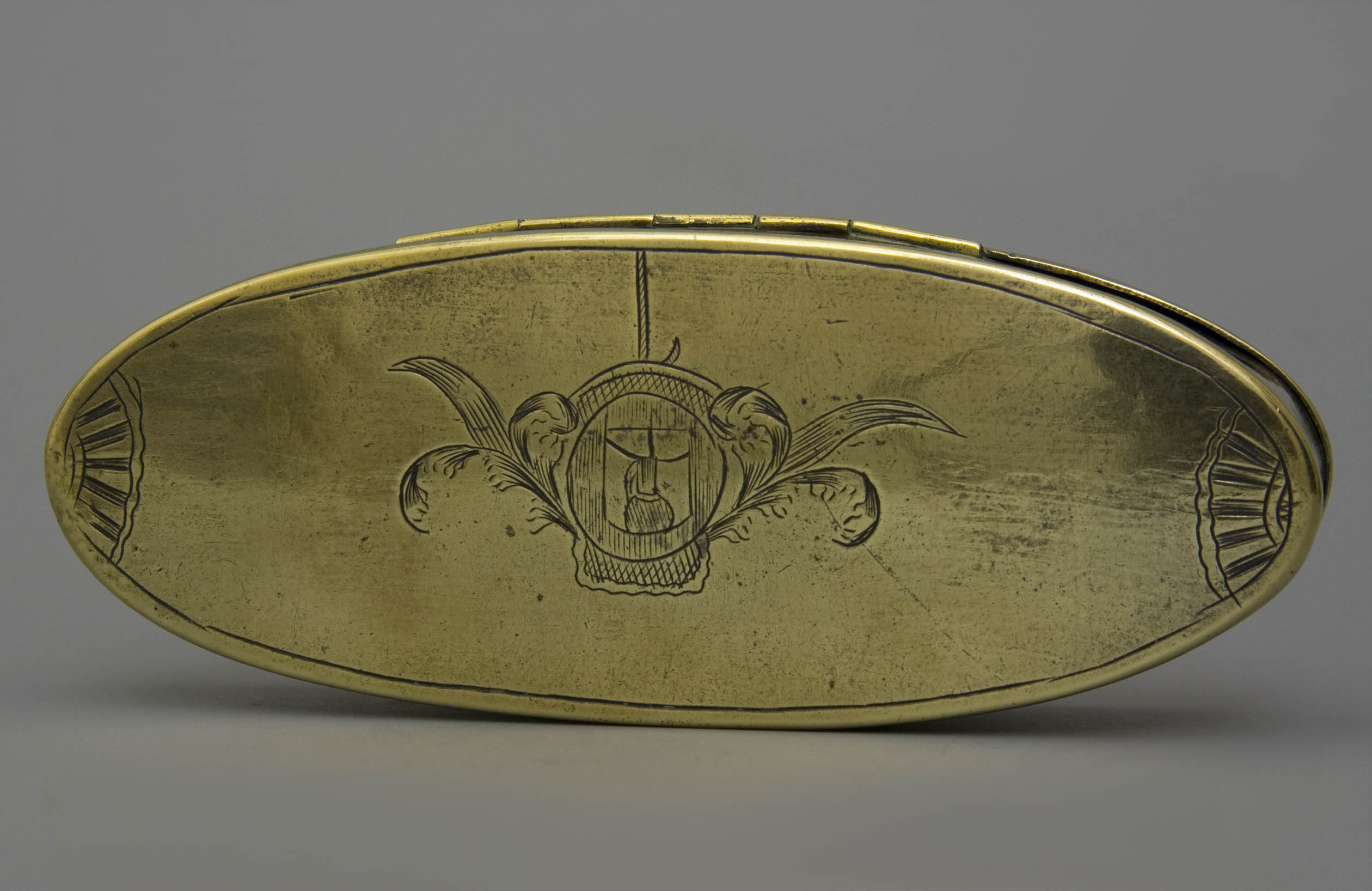
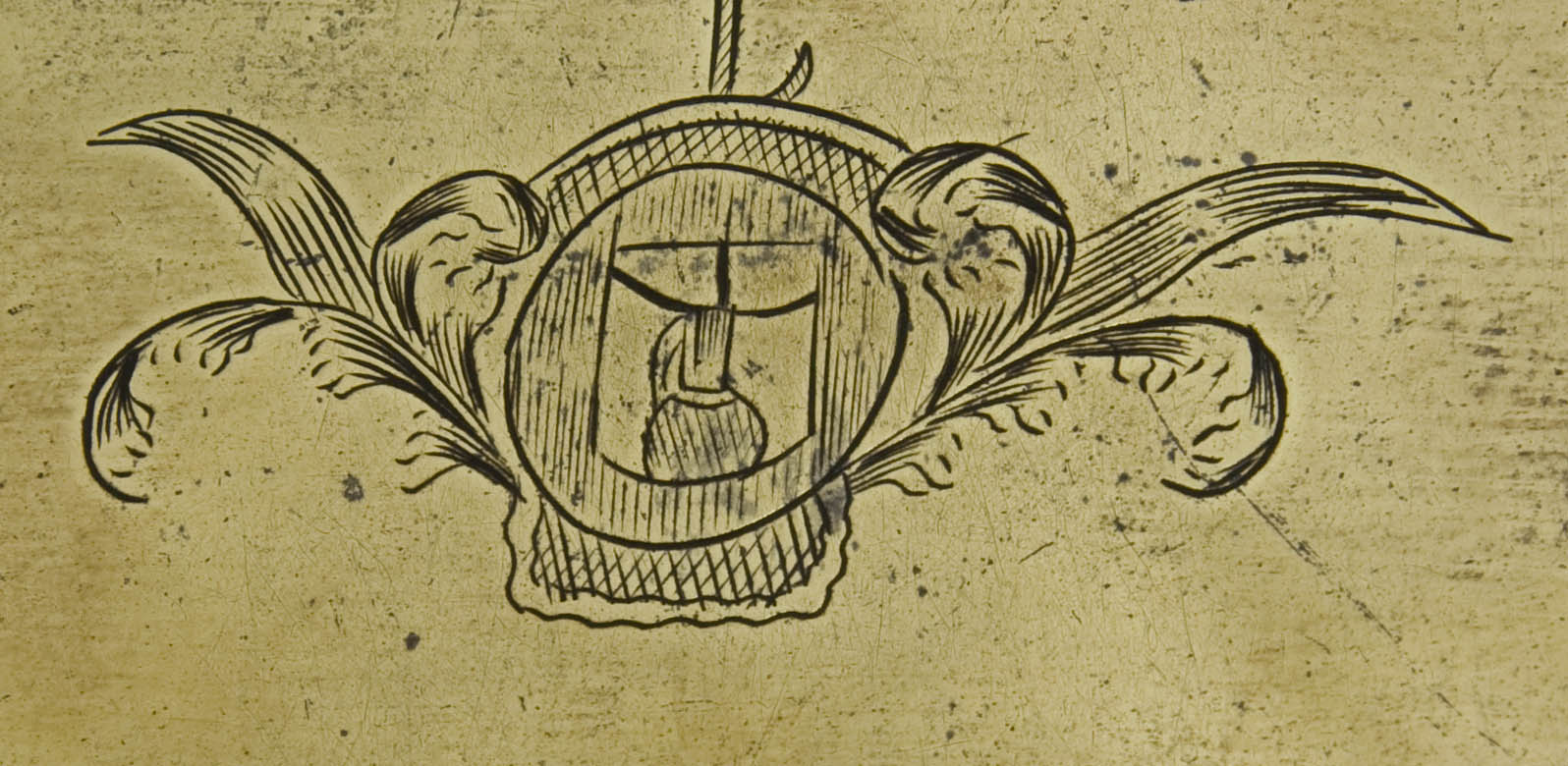
Catalogue 29c. APM 993
Description: Click here.
Comment: The box shape with its pointy ends matches the style of the empire. The performance is presumably engraved in a historical print and will more closely resemble the cityscape from the seventeenth century than that of the time of the birth of the box. Here too it is a series made in series and there are variants known with the cityscapes of, among others, The Hague and Den Bosch. Under the influence of the Louis XVI style, the underside of the box is no longer embellished, but a simple cartouche has been applied to it with the city arms of Vlissingen flanked by a few stylized leaves.
The style characteristics of the late empire make this box a typical time-bound object, although the timeless engraving only moderately complements it.
Origin: the Netherlands
Date: 1800-1820
Collection: Amsterdam, Pijpenkabinet Collections Pk 993
Box 30 Country life
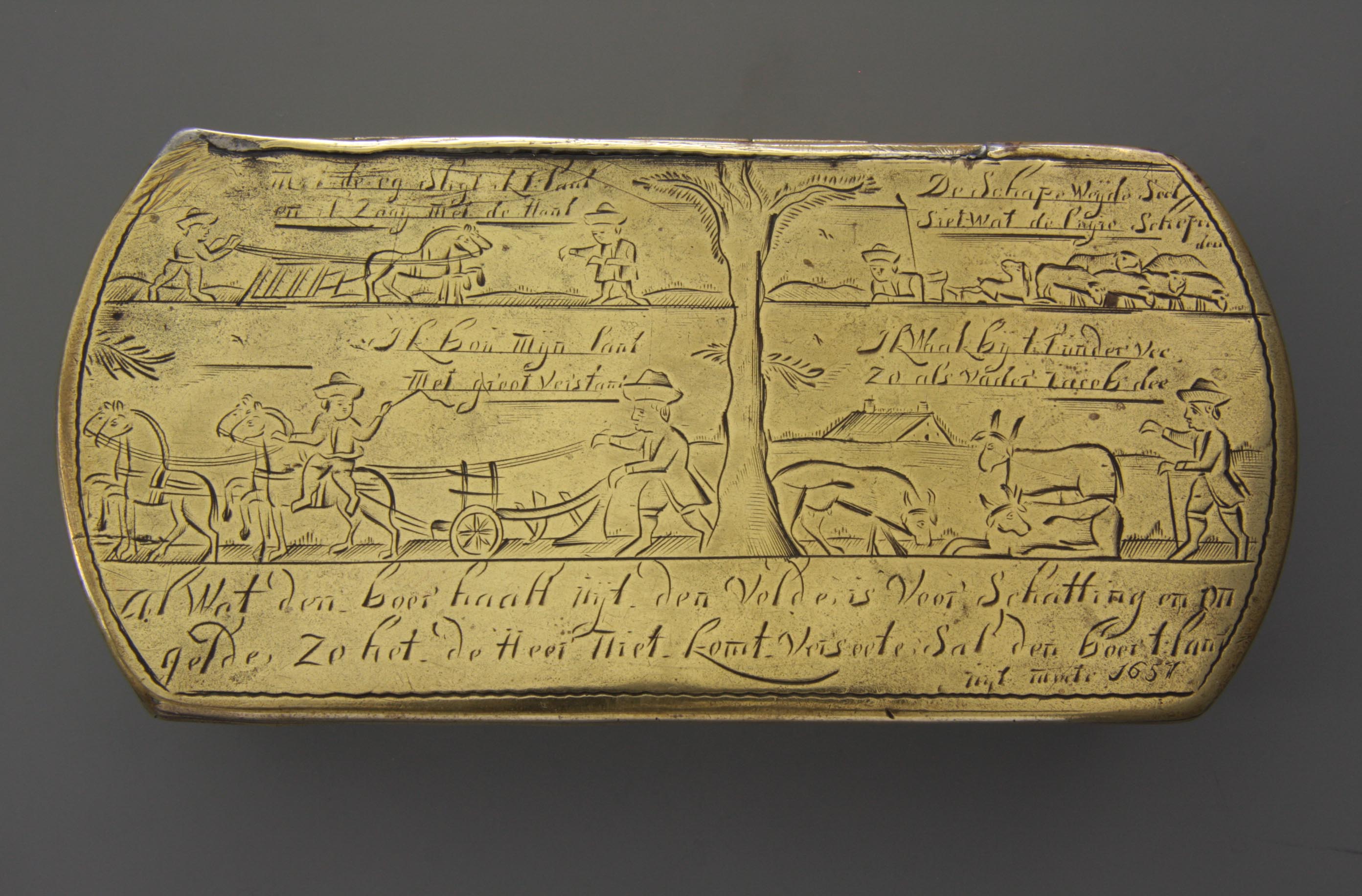
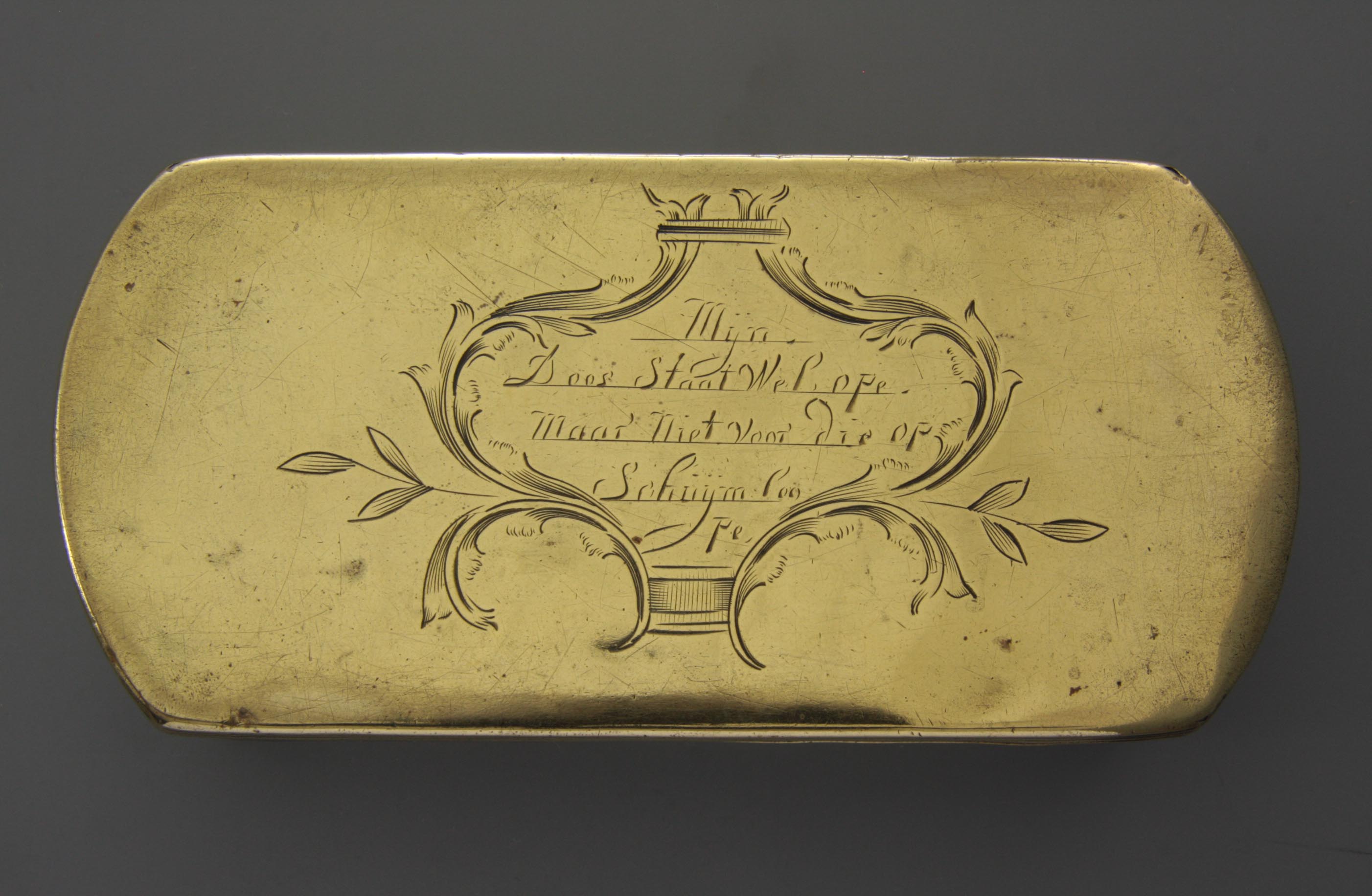
Description: Click here.
Comment: Characteristic of these rectangular boxes with square plates are both the performances and the manner of elaboration. With regard to tAP<he performance, scenes from agriculture and animal husbandry are preferred. Partly because of this, we tend to place such boxes as typical of the old-fashioned rustic. The inscriptions are often somewhat moralizing. The downside of this tobacco box is in line with the fashion that was used during the Louis XVI period, where the busy decoration made way for a single motif, such as a saying that denies clapping people who wanted to put their pipe out of this generous box.
What is nice about this box is that it was later offered by grateful war victims from Kuik and Grave, which is evident from a note in the box. Boxes with notes in it are not a rarity. In the past, people have tried so often to decipher the chicken legs of the engraved texts and to record the moralistic message. This note, however, is a thank you for a generous gift that the supporters received from the Red Cross in 1944 from England, whether or not directly from Alfred Dunhill from London, the last owner of the box.
Origin: the Netherlands
Date: 1780-1820
Collection: Amsterdam, Pijpenkabinet Collections Pk 18.280
Illustrations
- Tobacco box with turtle shields as bottom and lid. Netherlands, 1680-1710.
Amsterdam, Pijpenkabinet collections Pk 20.719 - Tobacco box turtle with polished silver mounting. Netherlands, 1630-1660.
Amsterdam, Pijpenkabinet collections Pk 20.325 - Tobacco box turtle with polished brass mounting. Netherlands, 1660-1690.
Amsterdam, Pijpenkabinet collections Pk 20.716 - Tobacco box polished whale baleen with brass mounting. Netherlands, 1670-1700.
Amsterdam, Pijpenkabinet collections Pk 20.720 - Tobacco box from shell with brass mounting and inscription. North Holland, 1690-1715.
Amsterdam, Pijpenkabinet collections Pk 20.718 - Tobacco box with oval shape in so called Sawasa technique. Japan, 1690-1720.
Amsterdam, Pijpenkabinet collections Pk 1.083 - Tobacco box in turtle with engraved silver mount. Netherlands, 1740-1755.
Amsterdam, Pijpenkabinet collections Pk 20.722 - Tobacco box in turtle with silver mounting. Netherlands, 1750-1780.
Amsterdam, Pijpenkabinet collections Pk 3.561 - Tobacco box whale baleen printed with two smokers sitting at a table. Netherlands, 1750-1780.
Amsterdam, Pijpenkabinet collections Pk 18.446 - Tobacco box in tin with painted surface. Germany, Braunschweig, 1830-1860.
Amsterdam, Pijpenkabinet collections Pk 16.418 - Tobacco box in boxwood with Biblical scene of Jesus' entry into Jerusalem. Netherlands , Zealand, dated 1822.
Amsterdam, Pijpenkabinet collections Pk 20.733 - Tobacco box in carved wood with oval shape with scenes on lid and bottom. Netherlands, Frisia, St. Jacobiparochie, 1850-1870.
Amsterdam, Pijpenkabinet collections Pk 20.734 - Tobacco box in leather. Netherlands, Frisia, 1860-1890.
Amsterdam, Pijpenkabinet collections Pk 20.480
Notes
- O.A. van Kerkwijk, Oud-Hollandsche doozen, Kunstzaal Kleykamp, Den Haag (The Hague), April-May 1912.
- Mark Douma, 'Pieter Holm, zijn zeevaartschool en de tabaksdoos, die zijn naam doet voortleven', Antiekwereld, V-4, 1980, pp. 6-10.
- Wolf-Dieter Könenkamp, Iserlohner Tabaksdozen; Bilder einer Kriegszeit, Warendorf, 1982, p. 14. Ernst Drossmann, Iserhlohn, Iserlohner Tabakdosen erzählen; Ein Einblick in die wirtschaftlichen, gesellschaftlichen, politischen und militärischen verhältnisse und das Aufblühen von Gewerbe, Industrie und Handel, Iserlohn, 1981.
- G.A. Brongers, "Tabaks- en snuifdozen", chapter in: Schans op de grens, Boertanger bodemvondsten 1580-1850, Sellingen, 1993, p. 463. Georg Alfred Brongers, Van Gouwenaar tot bruyèrepijp, Amersfoort, p. 57. Amoret & Christopher Scott, Tobacco and the Collector, London, 1966, p. 68. Mentions a tobacco box dated 1602.
- G.J. Winkel, “Rauchtabaksdosen aus der Zeit Friedrichs der Grossen“, Der Sammler, 1892, pp. 51-55 and pp. 63-67.
- Mattoon Munroe Curtis, The Book of Snuff and Snuffboxes, London, 1935, fig. 77. Octagonal tobacco box described as snuff box. G. Bernard Hughes, English-Snuff-Boxes, London, 1971, photo 16. Lens shaped box described as a table snuff box.
- About the Dutch word kakig are two readings: counting all hinge sleeves or only those sleeves on one side that close in the reverse. In this article the last system has been chosen. A single-pivot hinge therefore has three sleeves or cams, a double-skinned five, three-ply seven, and so on.
- W.R. Juynboll & V. Denis, Winkler Prins van de Kunst, Amsterdam, 1958, p. 401. Damasceren in general for the Muslim world the engraving and especially the protruding and laying in of gold and silver wire. John Fleming & Hugh Honour, The Penguin Dictionary of Decorative Arts, Harmondsworth, 1979, p. 223. Hammering gold and silver in steel that should more correctly be named inlay work.
- Dr. Sabine Fellner, Die Lasterhafte Panazee, 500 Jahre Tabakkultur in Europa, Wien, 1992, pp. 57, I/46. Oval box with flat bottom and lid, dated 1716.
- B.W.G. Wttewaal, Nederlands klein zilver en schepwerk, 1650-1880, Abcoude, 1994, p. 238, ill. 737-738. Silver box with identical shape, dated c. 1690.
- K.A. Citroen a.o., Meesterwerken in zilver, Amsterdams Zilver 1520-1820, Lochem, 1984, p. 125, no. 133. Hendrina den Das, 1748.
- O.A. van Kerkwijk, (Oud-Hollandsche doozen), 1912, no. 10. Silver box dated 1754. Wttewaal, (Nederlands klein zilver), p. 244, ill. 757, dated 1761 but with facetted ends.
- Onno ter Kuile, Koper & Brons, 's-Gravenhage, 1986, p. 267, no. 355. Rectangular box (à surprise) dated first quarter 18th century. P. 268, no. 356, ditto, also first quarter 18th century.
- Ter Kuile, (Koper & Brons), p. 268, no. 357. Oblong box with bevelled corners (open sawn), first quarter 18th century.
- Brongers, (Gouwenaar tot bruyèrepijp), Amerongen, 1978, pag. 60. Box with engraved town view of Leiden.
- E.M.Ch.F. Klijn, "Schildpadpantsers, verwerkt tot doosjes", Antiek, Jrg. 5, no. 9, April 1971, pp. 548-553.
- Claire Le Corbeiller, Alte Tabaksdosen aus Europa, München, 1966, ill. 434. Museo del Palazzo di Venezia, Rome.
- J. Verbeek, Nederlands zilver 1725-1780, Lochem, 1988, p. 35, ill. 34. Accolade box, Amsterdam, Hendrina Das, 1748.
- Herbert Rupp, Snuff Boxes, oder von der Sehnsucht der lüsternen Nase, Wien, 1990, p. 183.
- A. Graafhuis, "De Liberale gifte van 1747", Spiegel der Historie, II-12, December 1967, p. 684. Possibly engraved by Leendert Beekhuijsen in 1748.
- Beatrice Jansen, Catalogus van Haagse zilverwerken, The Hague, p. 82, ill. 154. Full grown rectangular box, The Hague, year hall mark 1789.
- Nora Schadee, Zilverschatten, drie eeuwen Rotterdams zilver, Historisch Museum Rotterdam, 1991, p. 146, Cat. 257. Rectangular box with greep, Abraham Winters, Rotterdam, 1786.
- Detlev Richter, Lackdosen, Müchen,1988. Facory starts in 1763, from 1800 boxes made from Weissblech are common.
- D.H. Duco, Merken en merkenrecht van de pijpenmakers in Gouda, Amsterdam, 2003, p. 101, vignette 111.
- See note 1.
- G.A. Brongers, Achttiende eeuwse tabaksdozen uit Iserlohn, 1964, p. 5, Fig. 3.
- Jan Veenendaal, 'Een tabaksdoos uit Sri Lanka', Aziatische Kunst, 34/1, March 2004, pp. 3-5.
- Don Duco, De tabaksdoos van Tamis Jansz. Witsmeer, Amsterdam, 2011.
- M. de Bruijn, Cradock, Hallebeek, Krijgsman et al., Sawasa, Japanese export art in black and gold, 1650-1800, Amsterdam, 1998.
- Ibidem Richter, (Lackdosen).